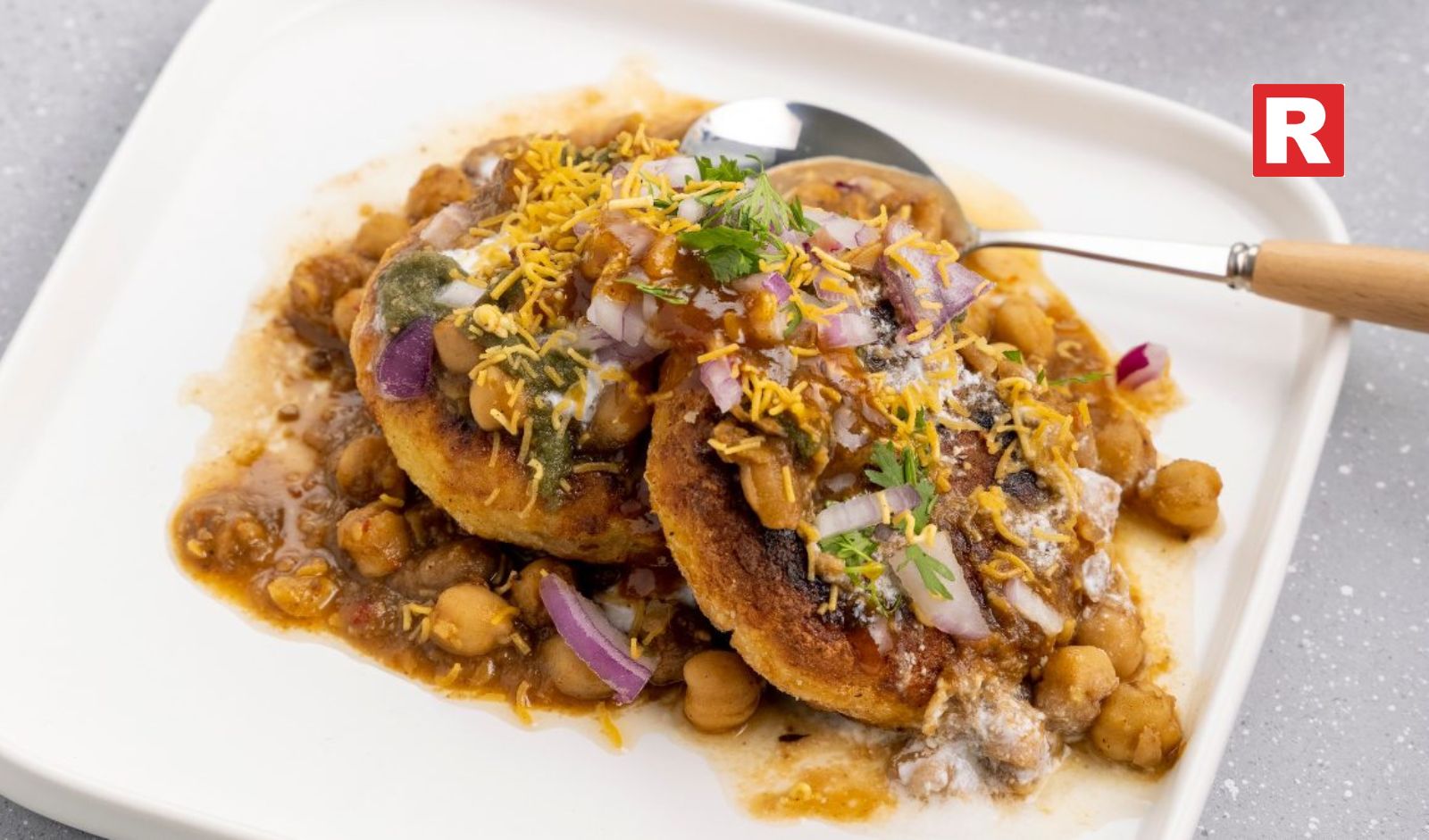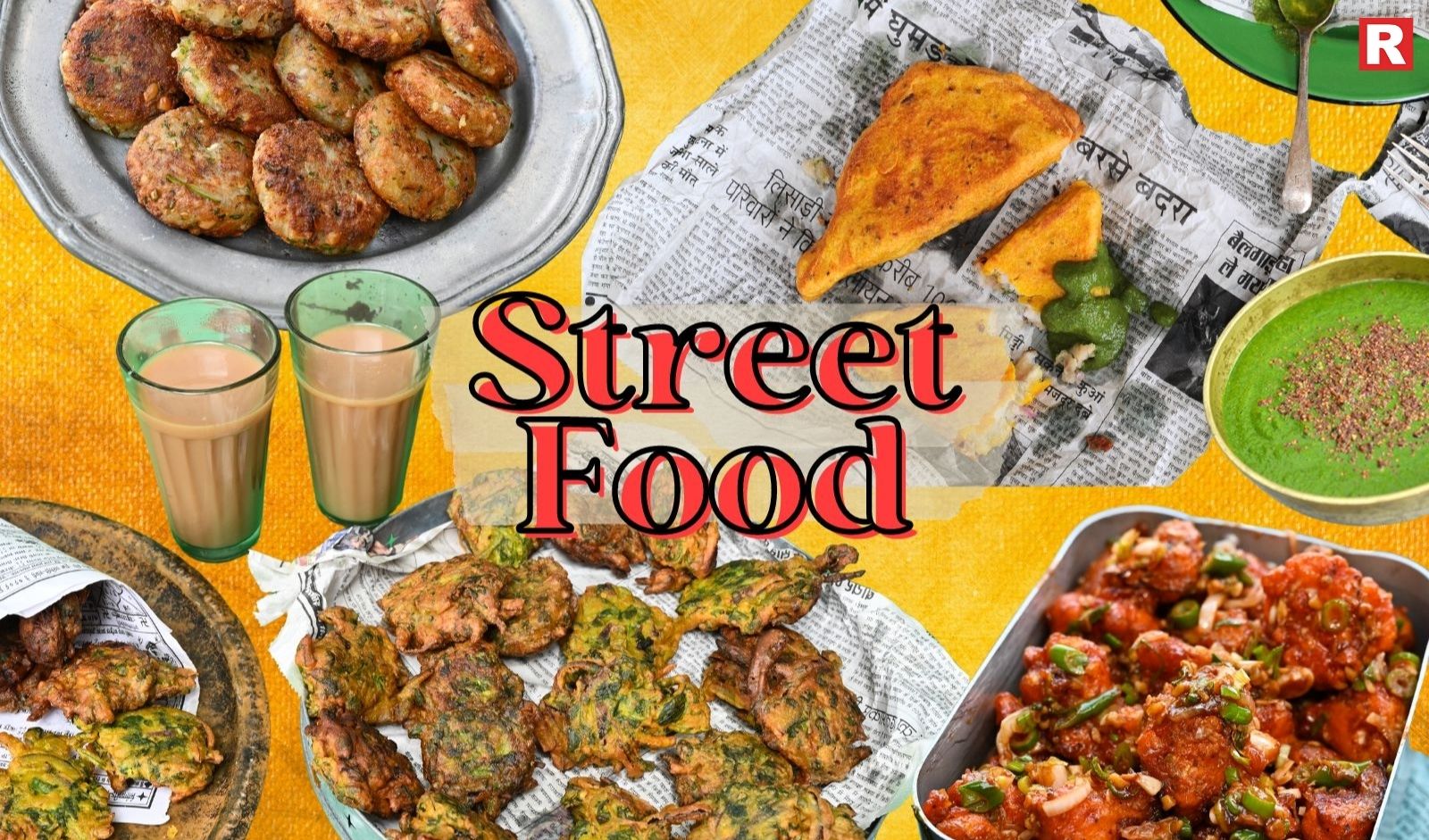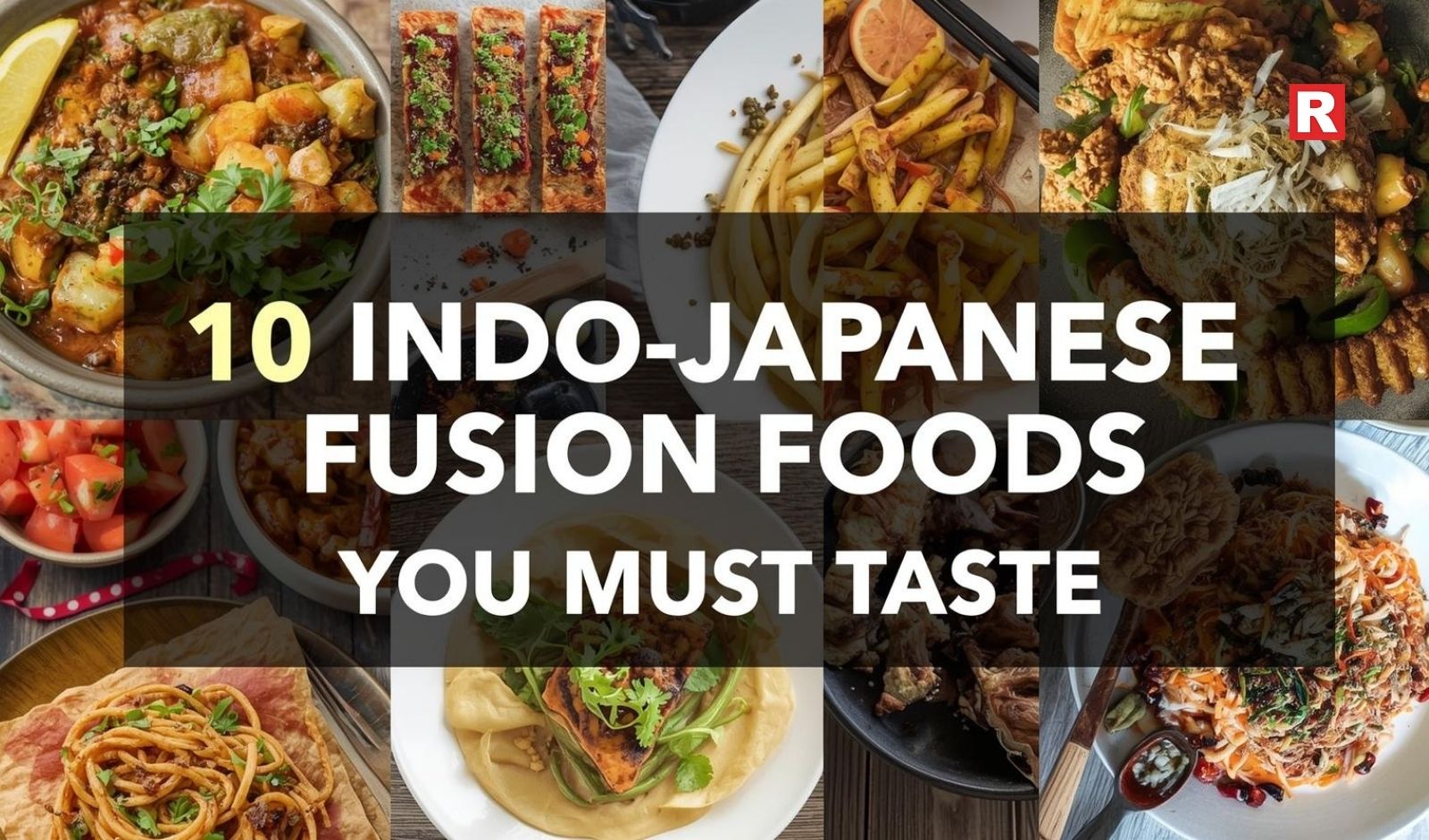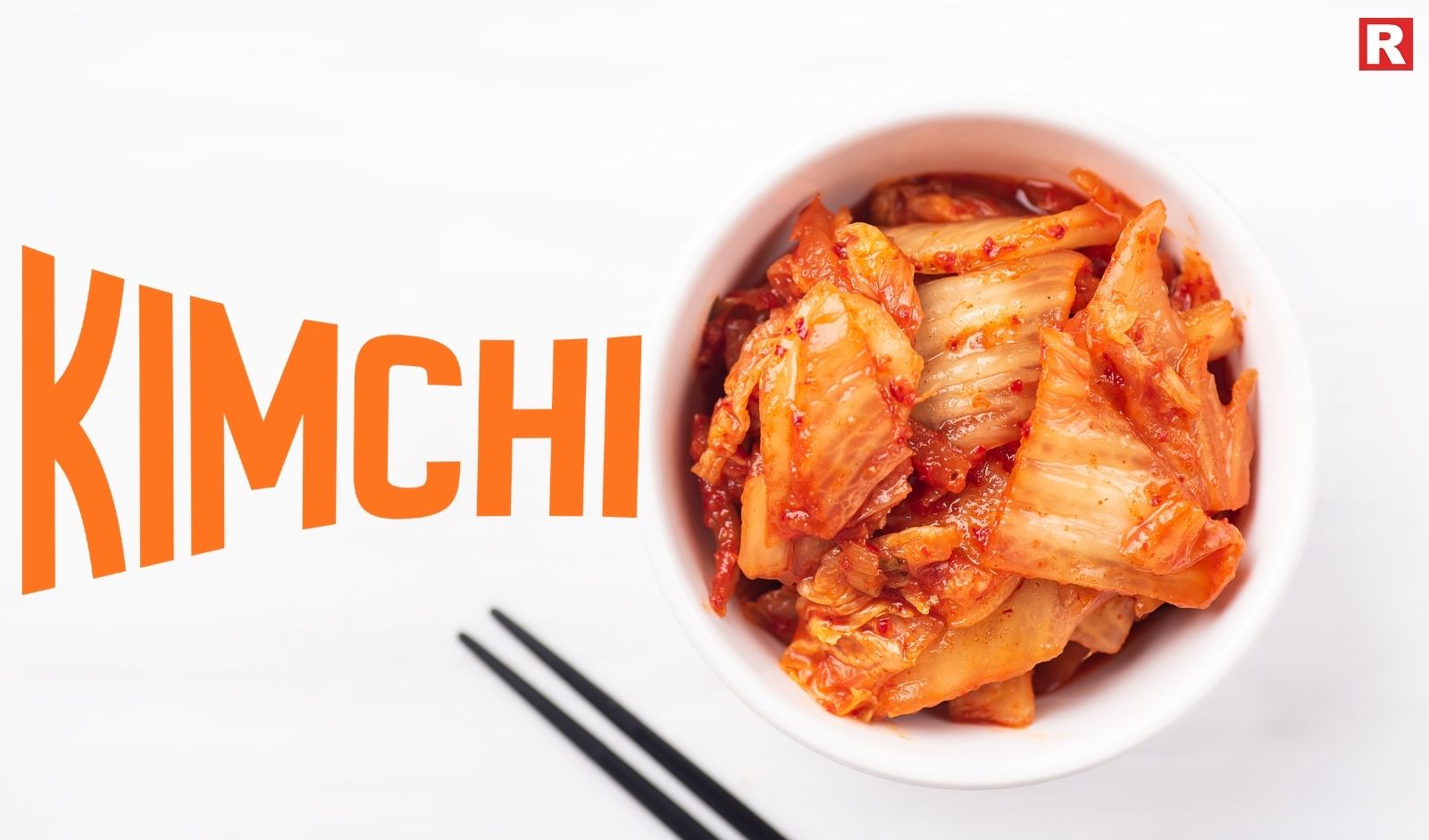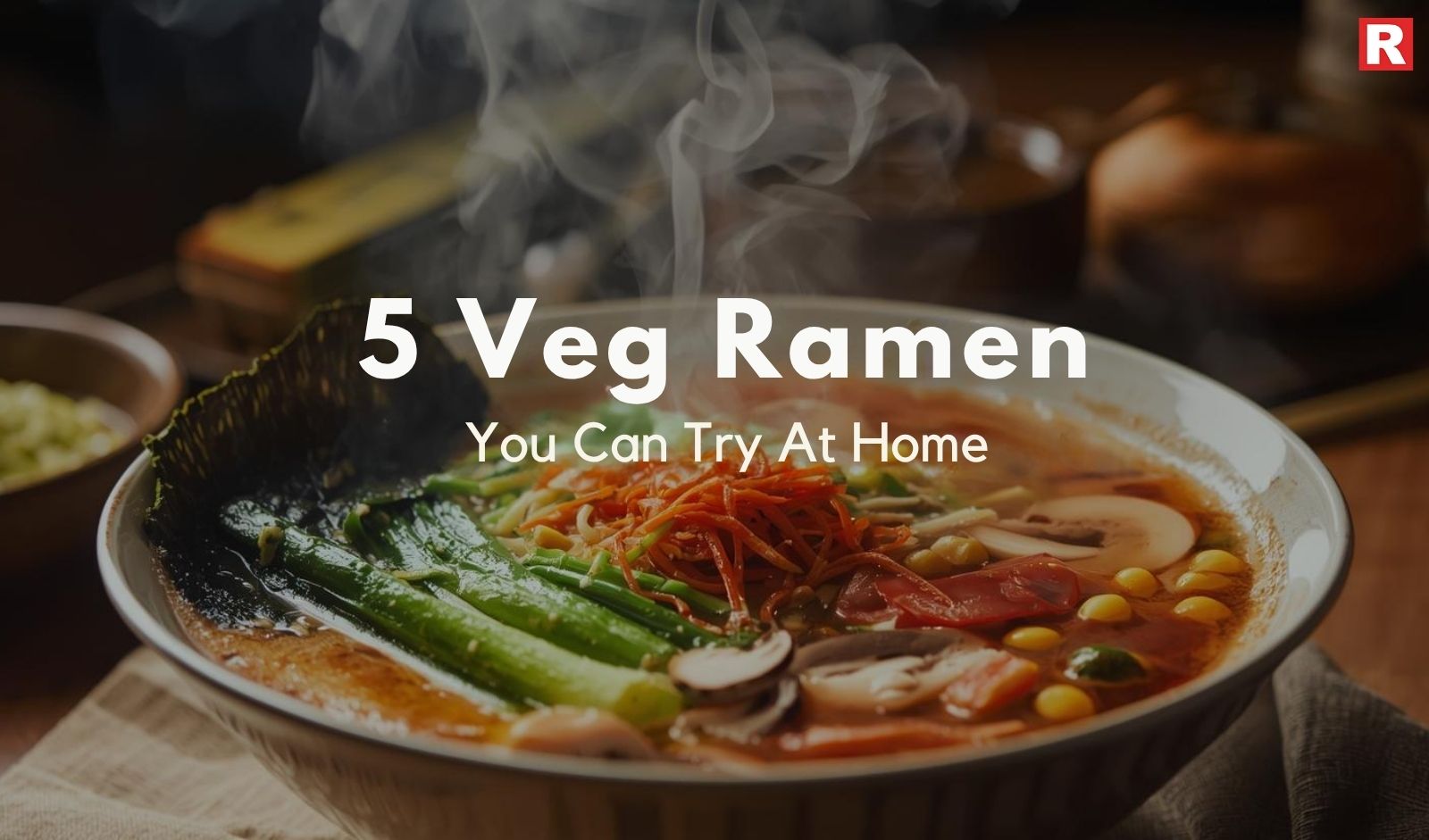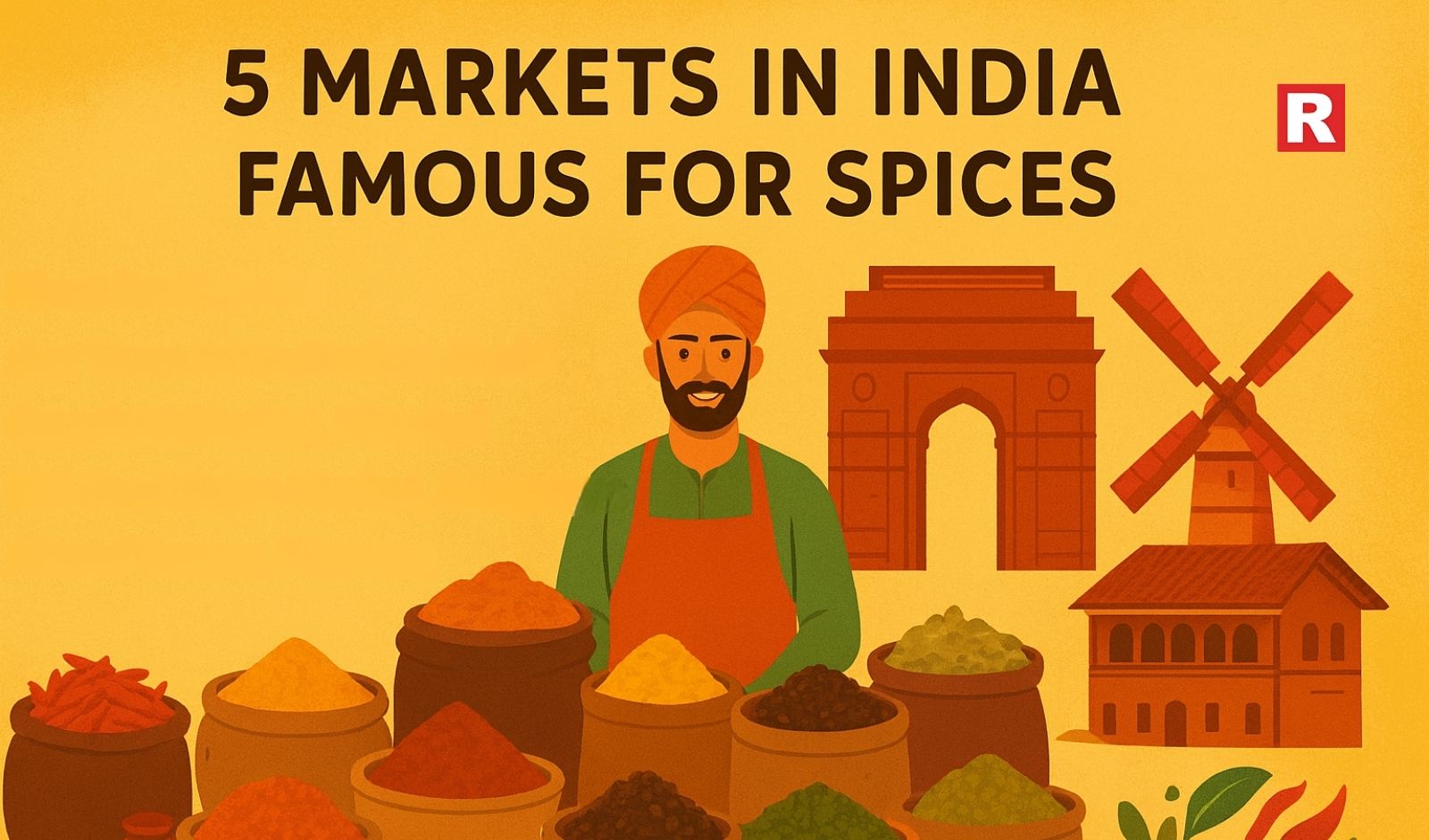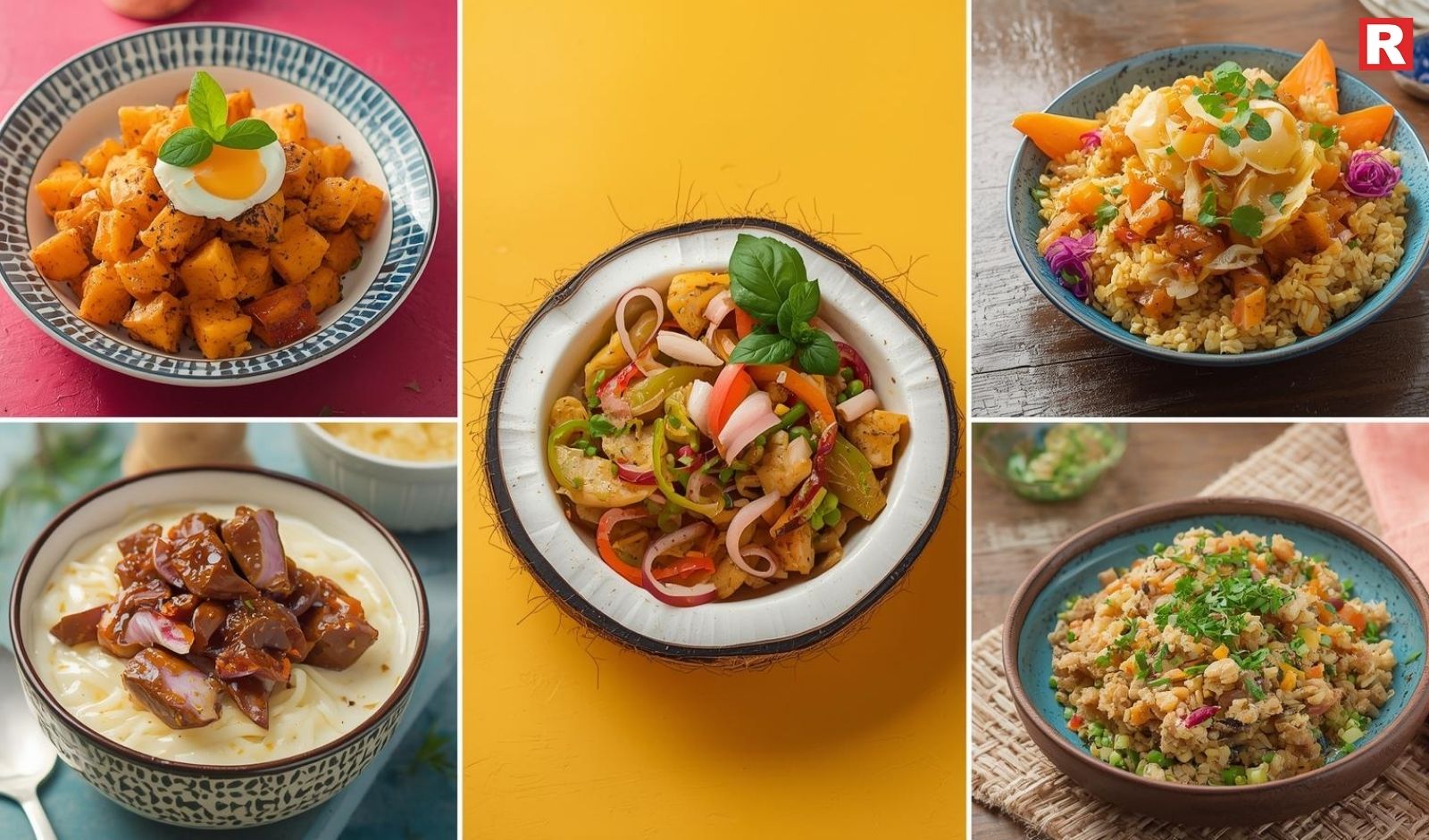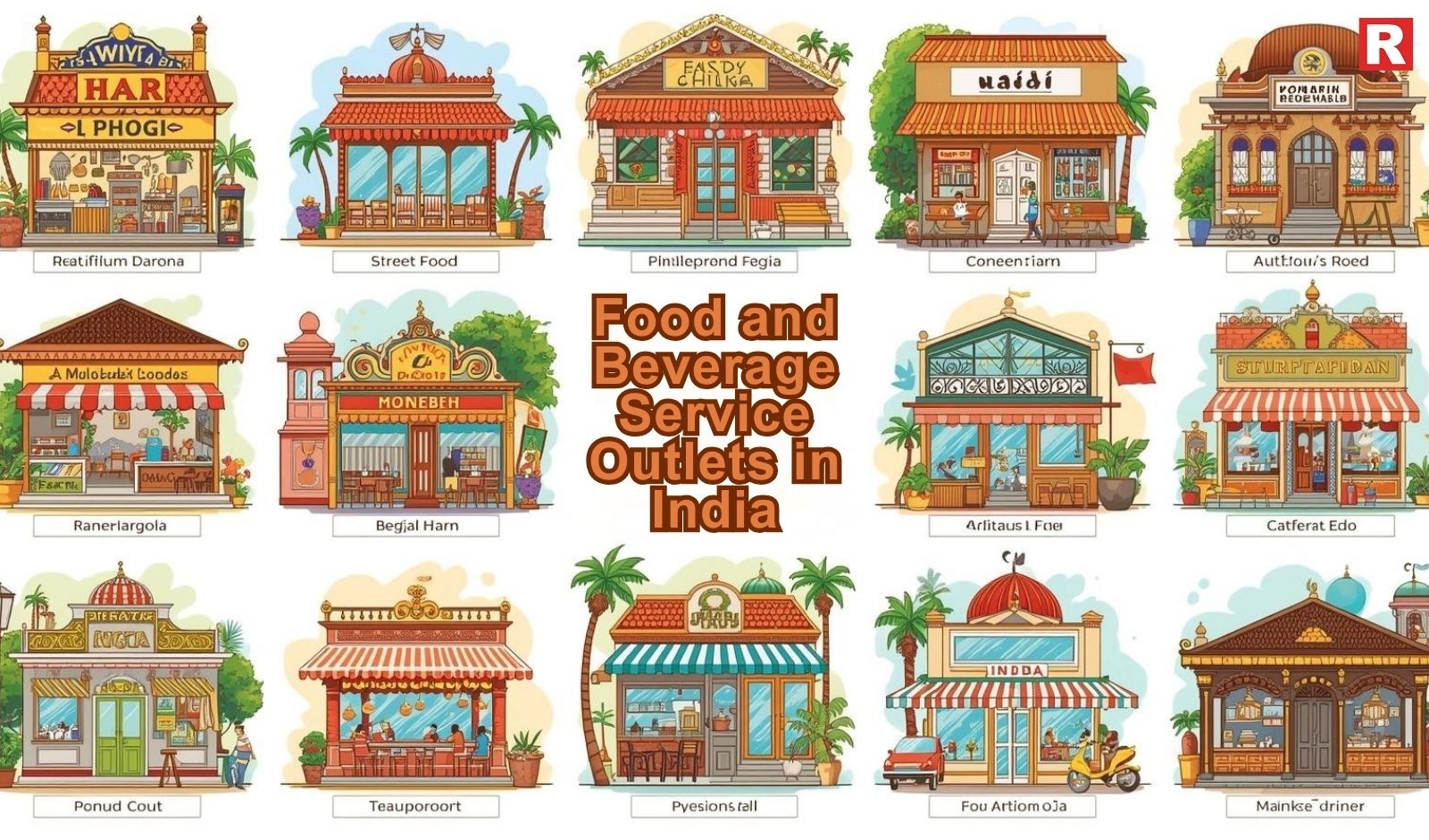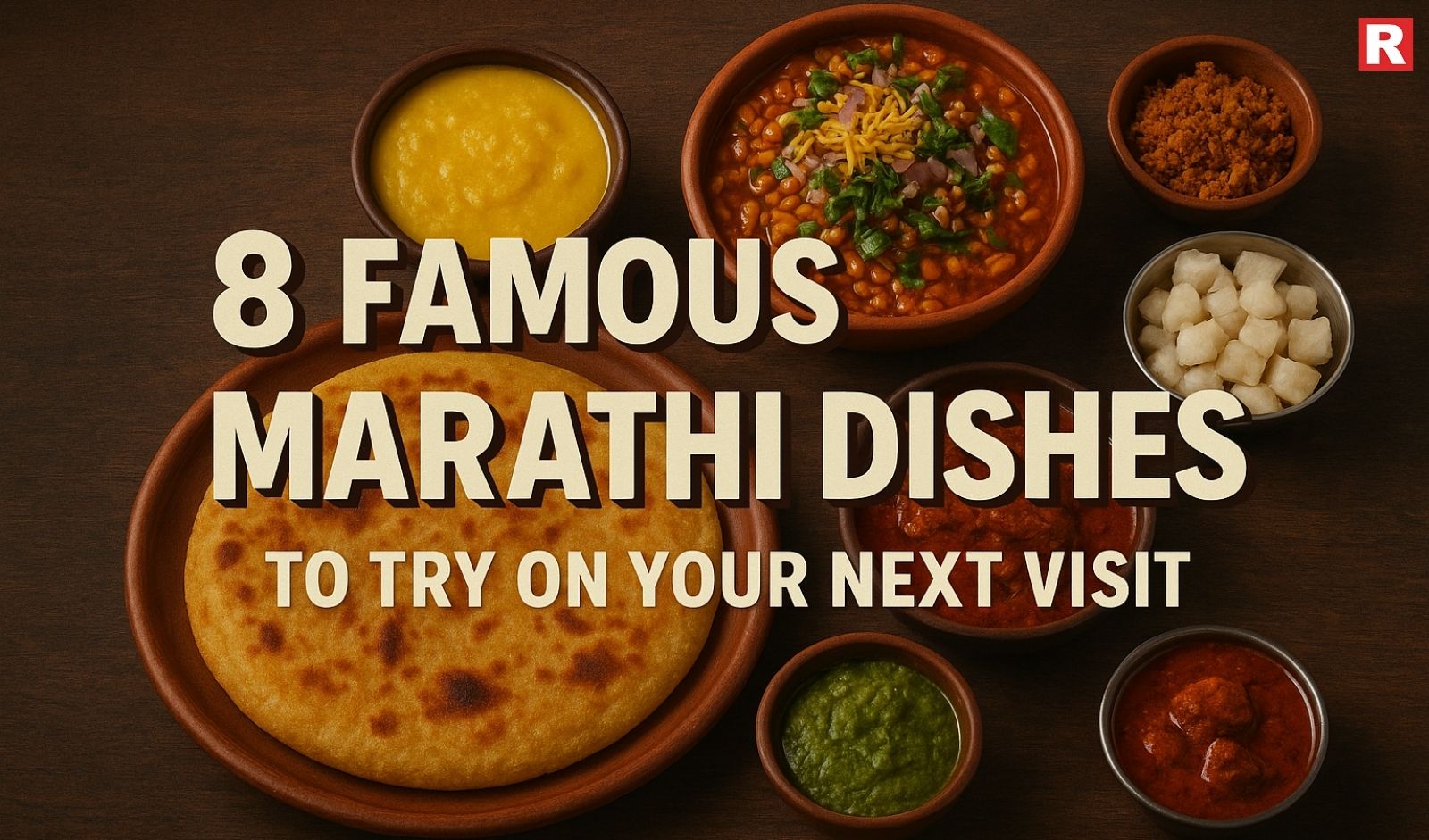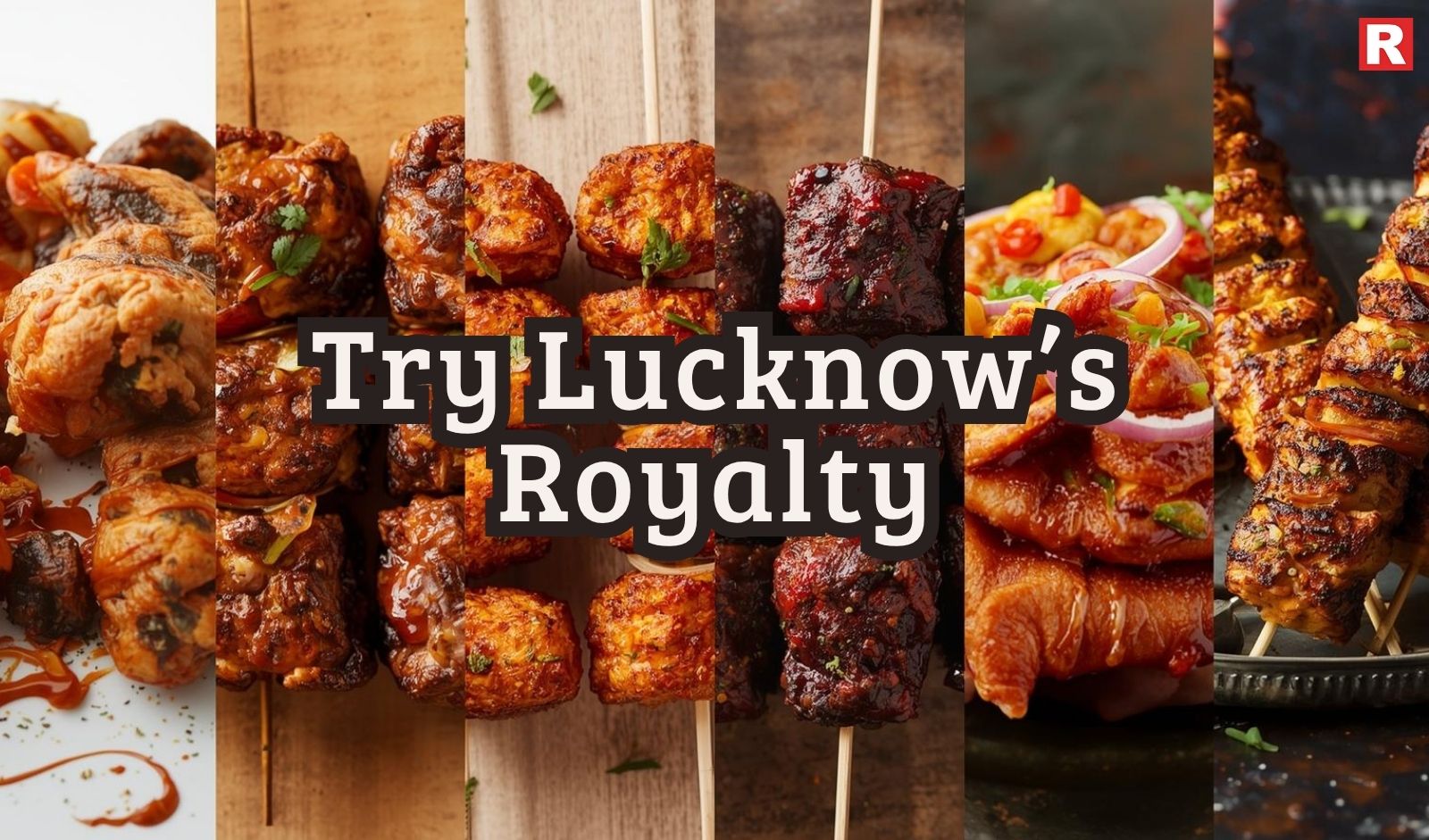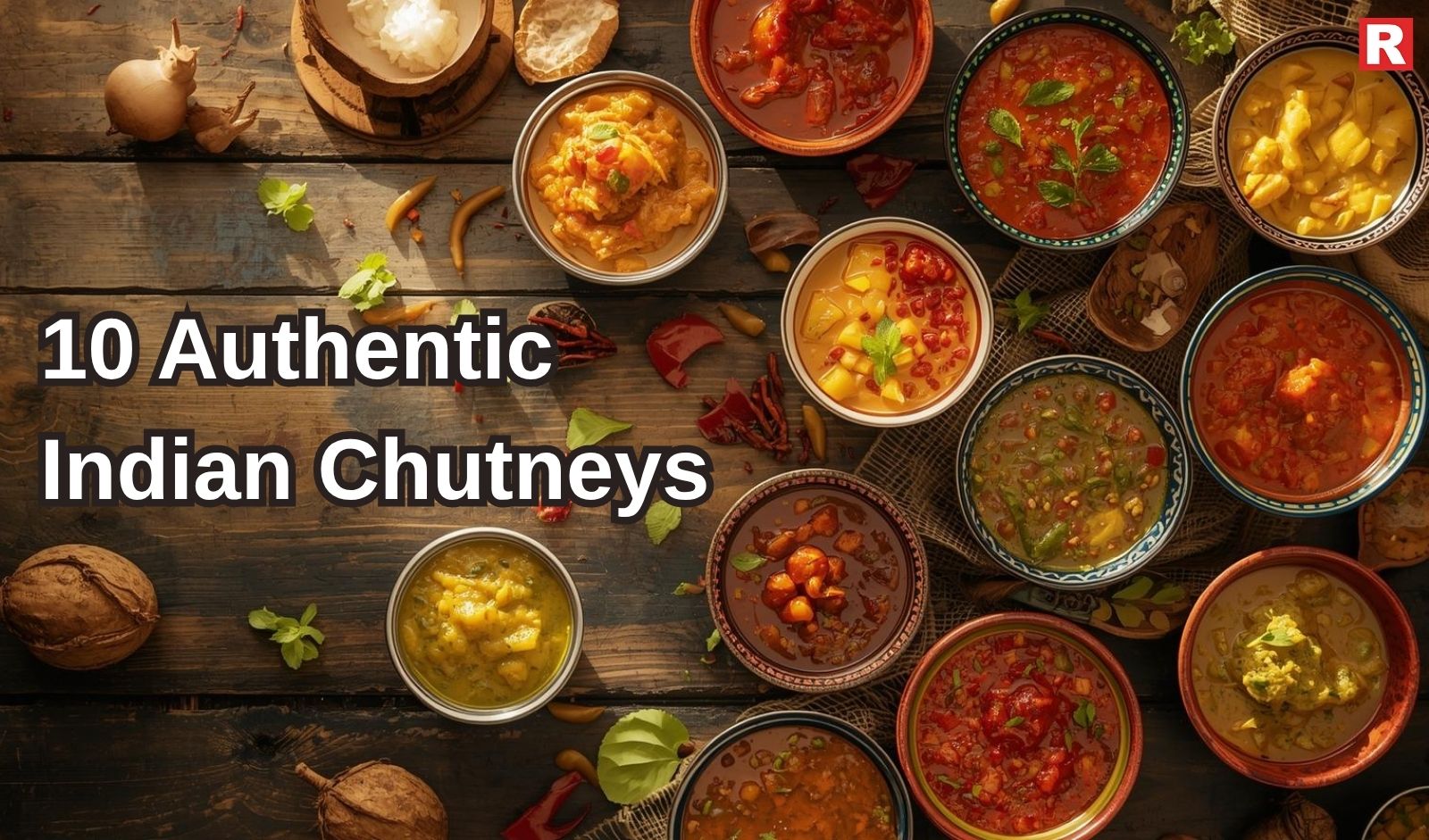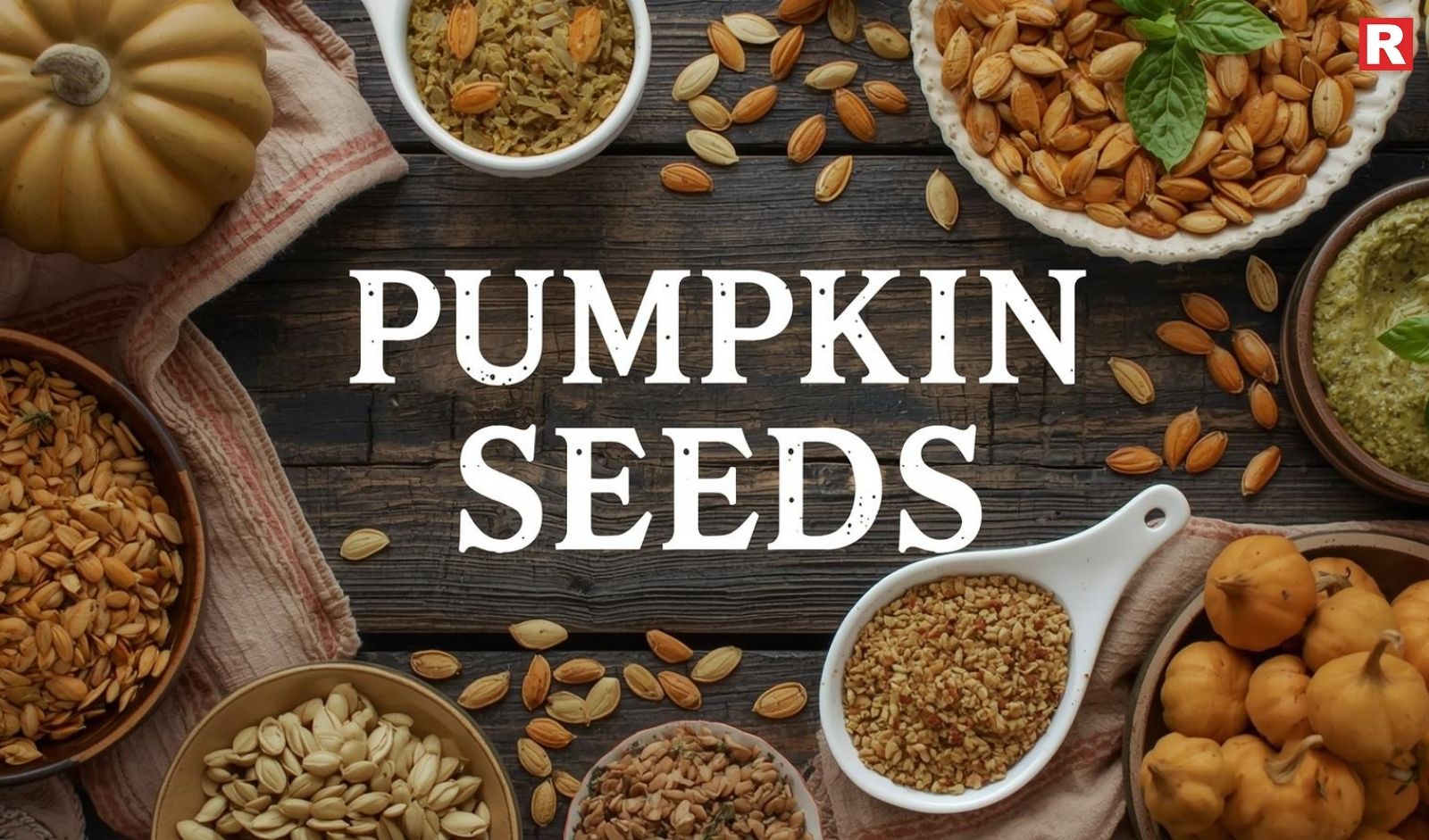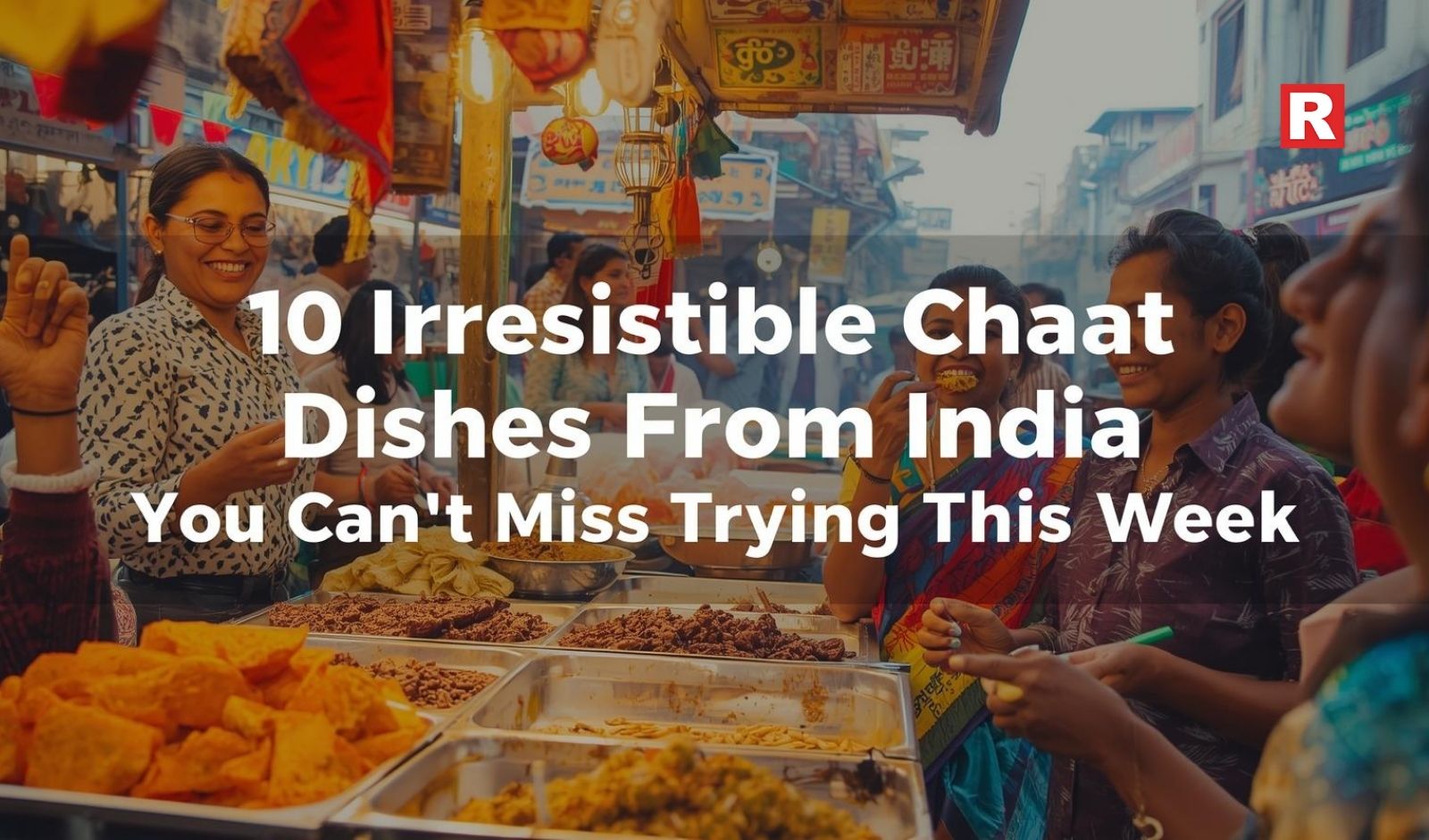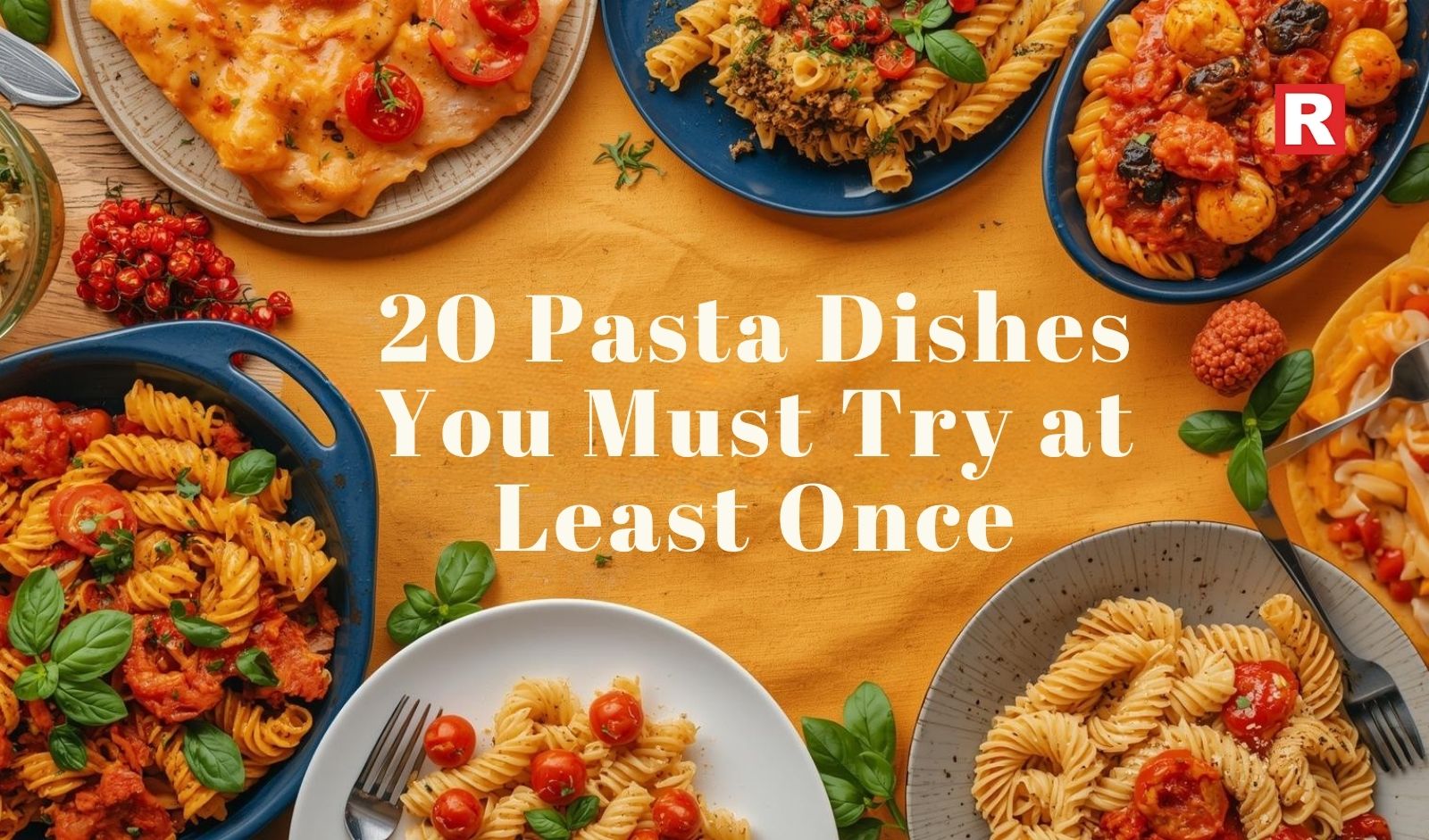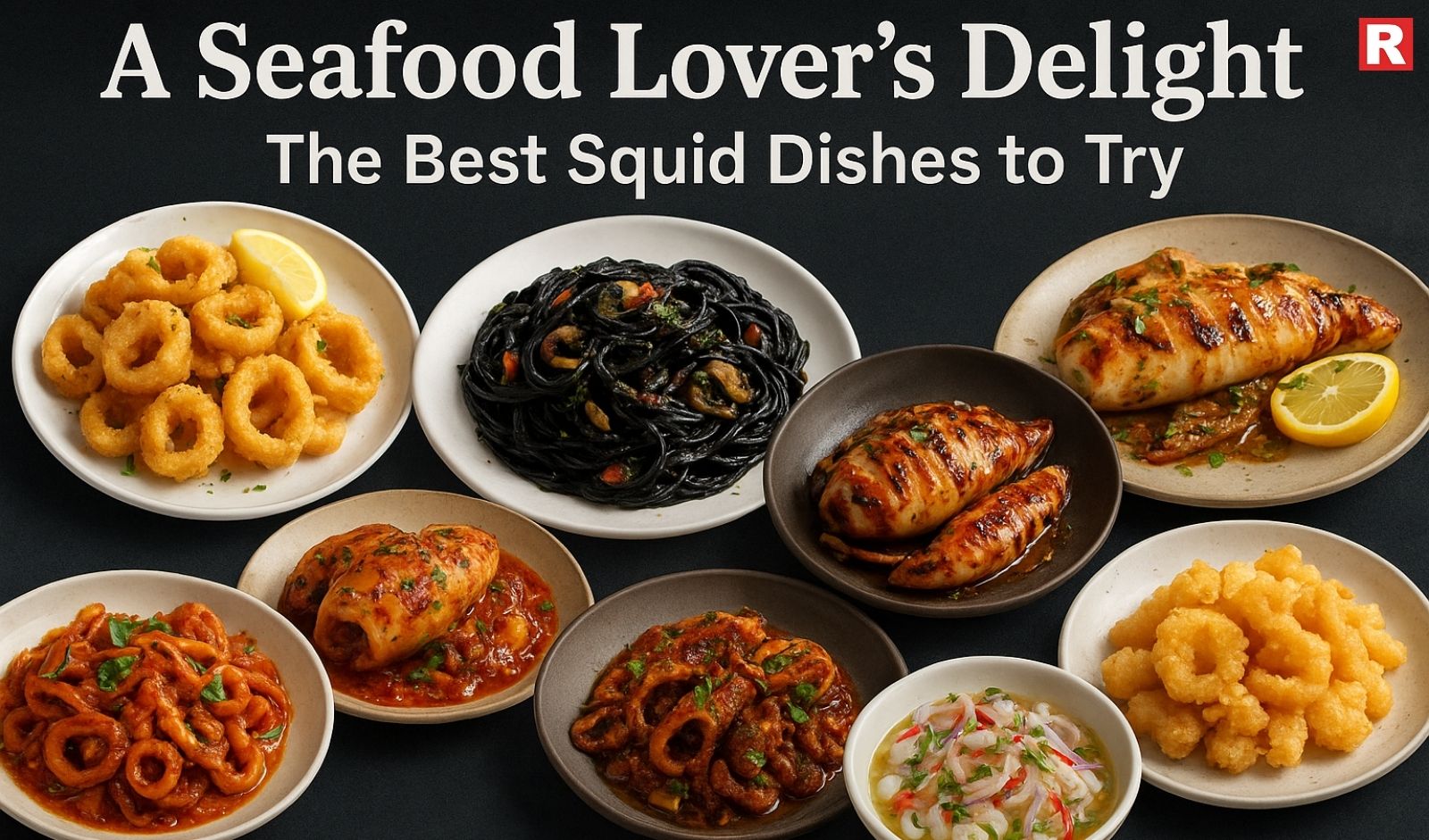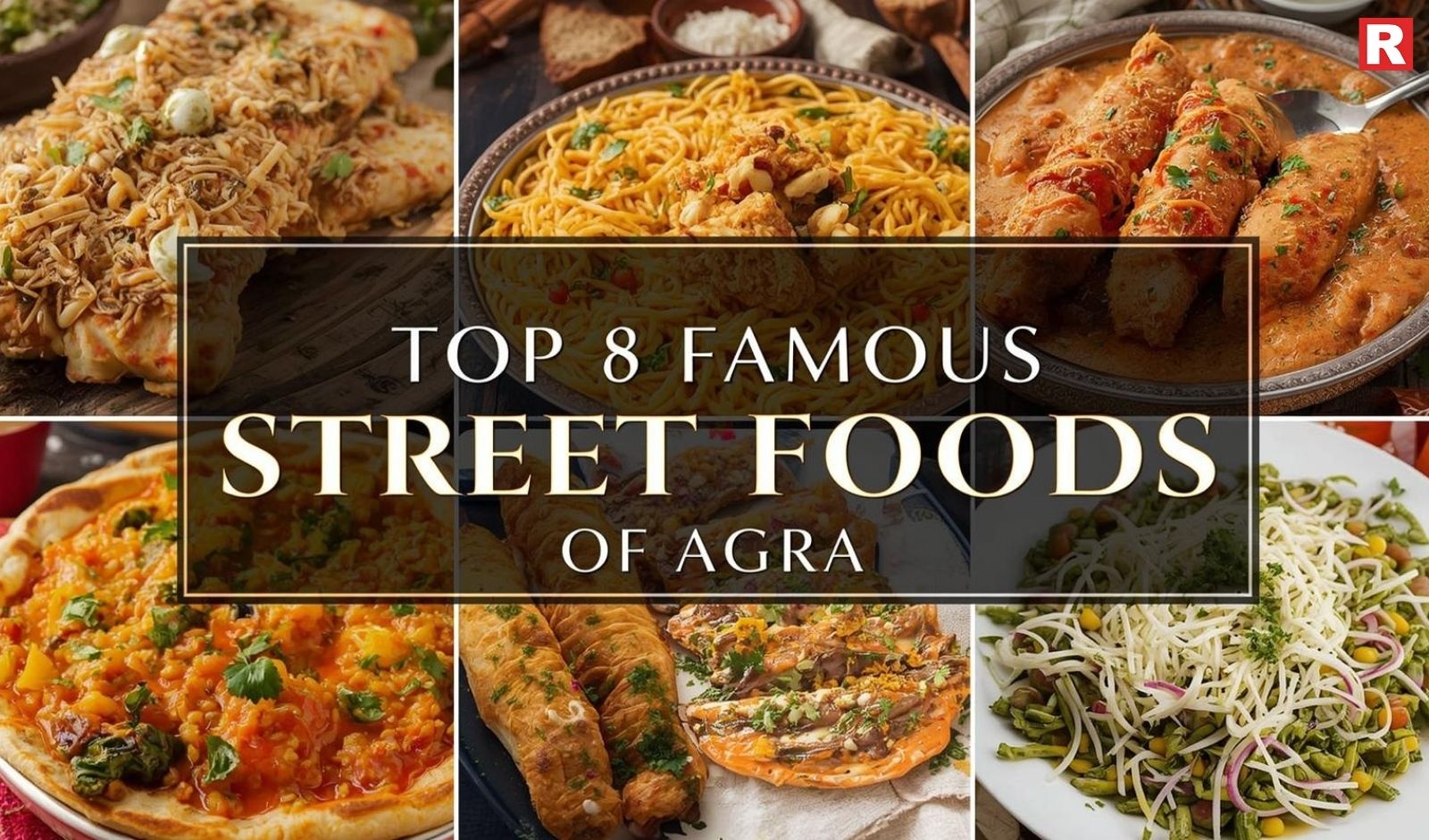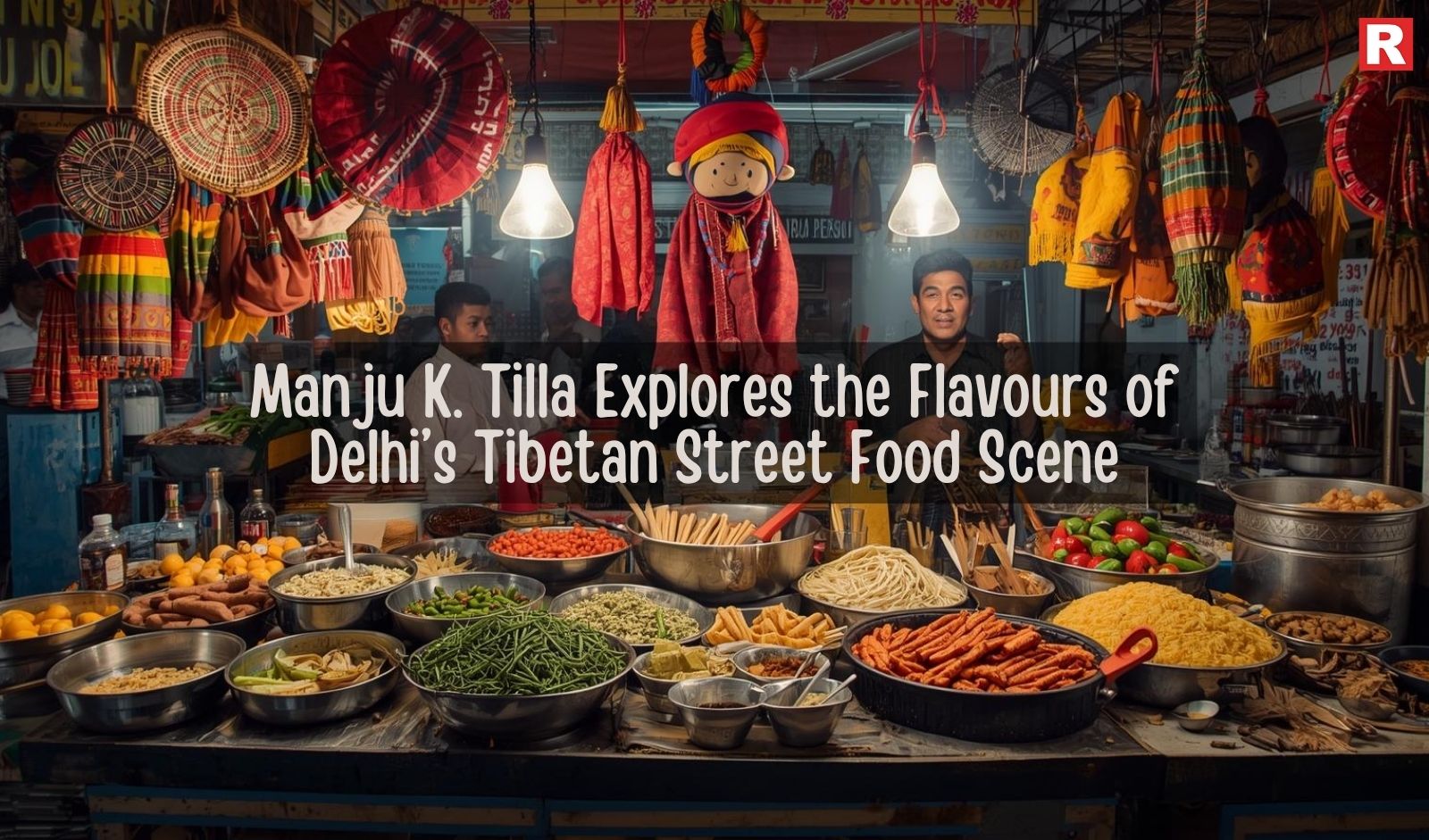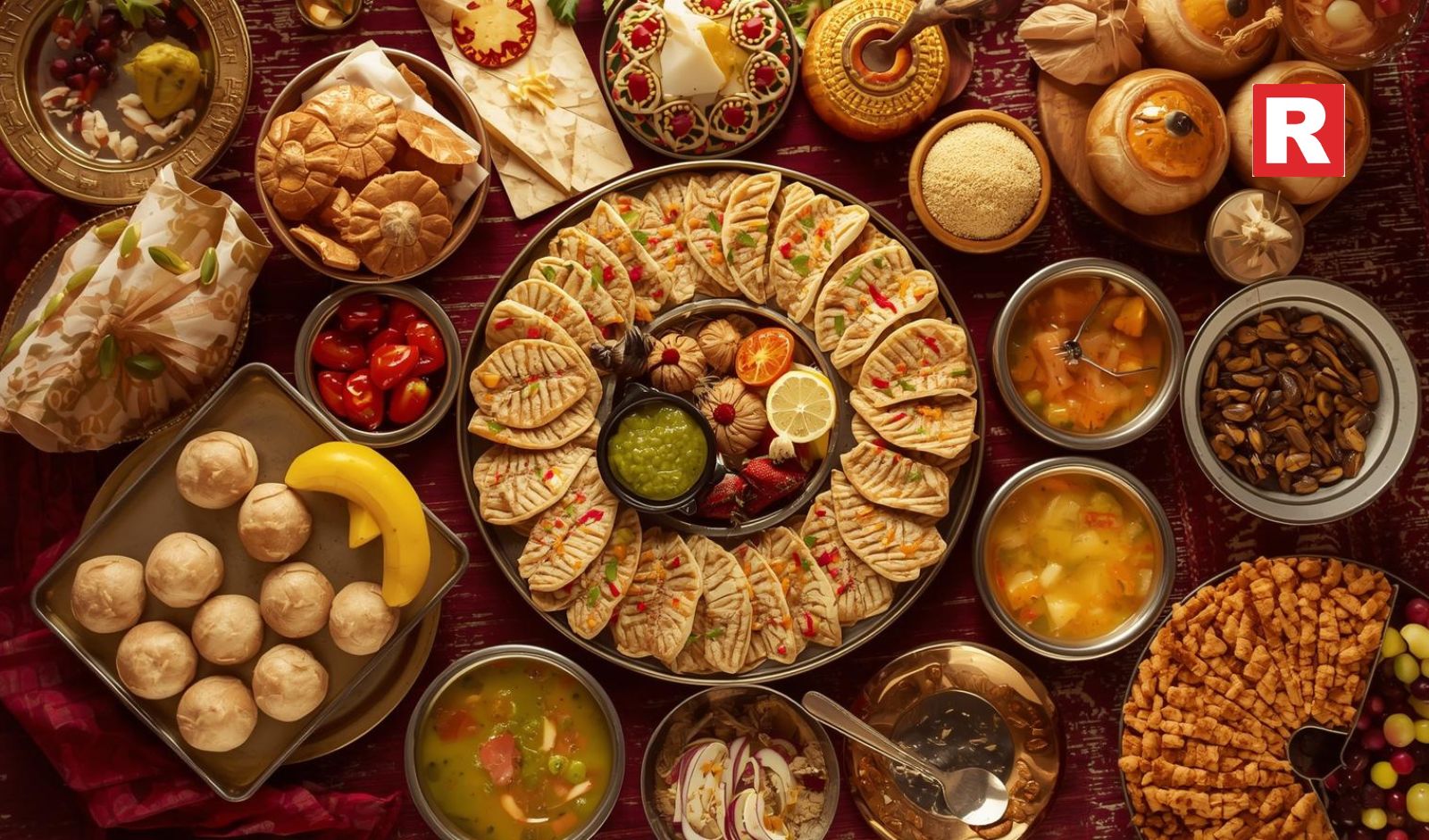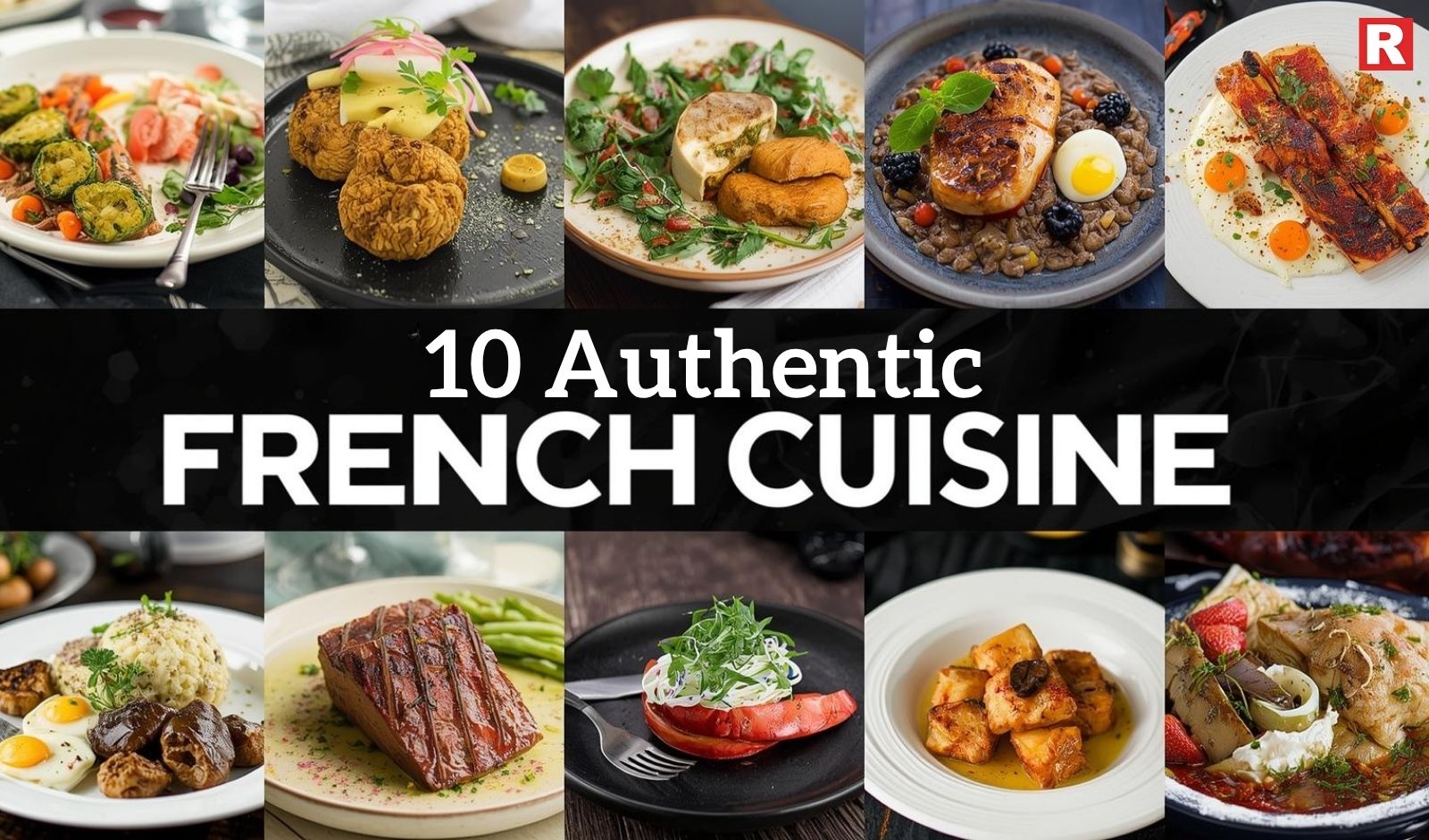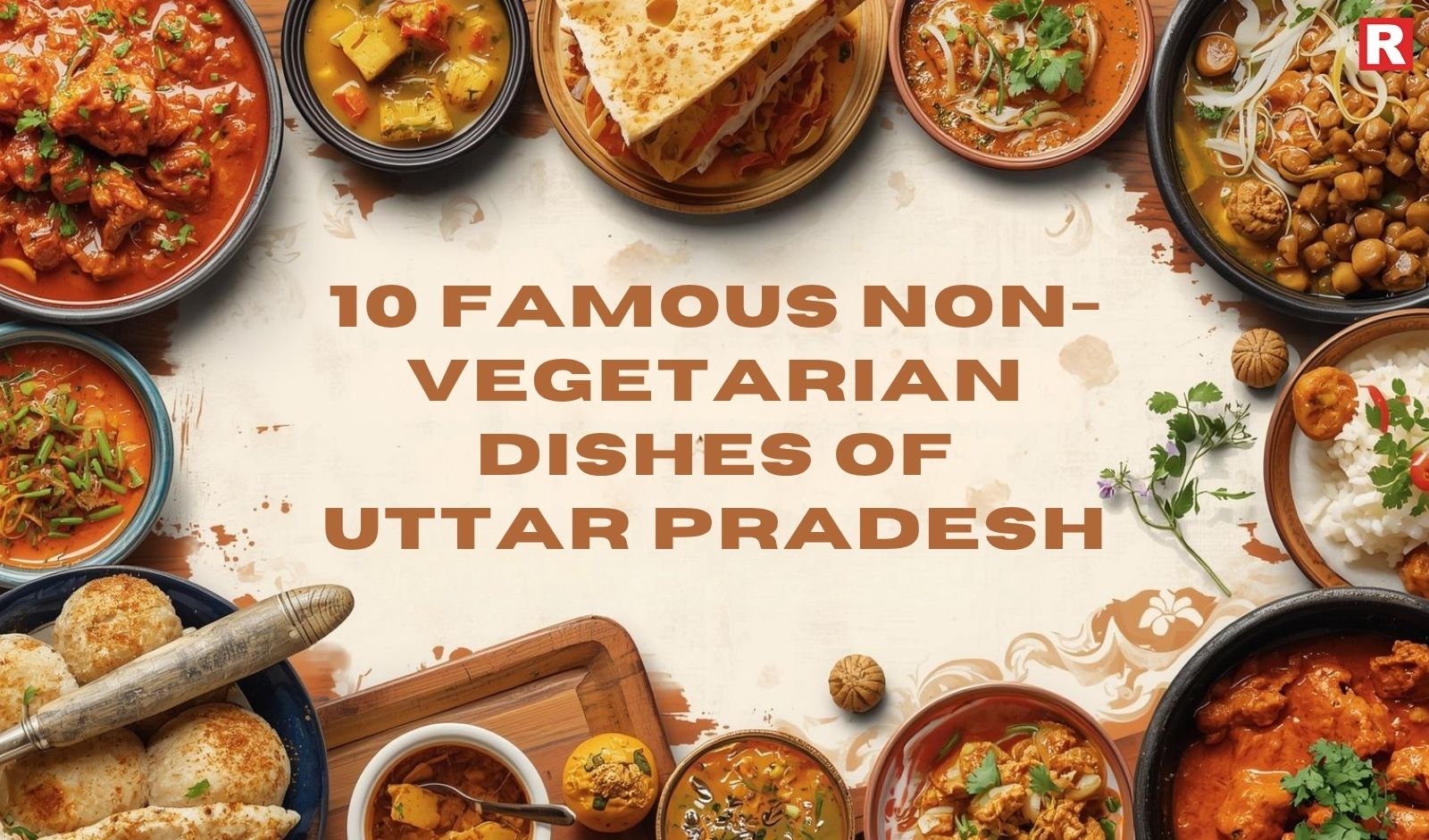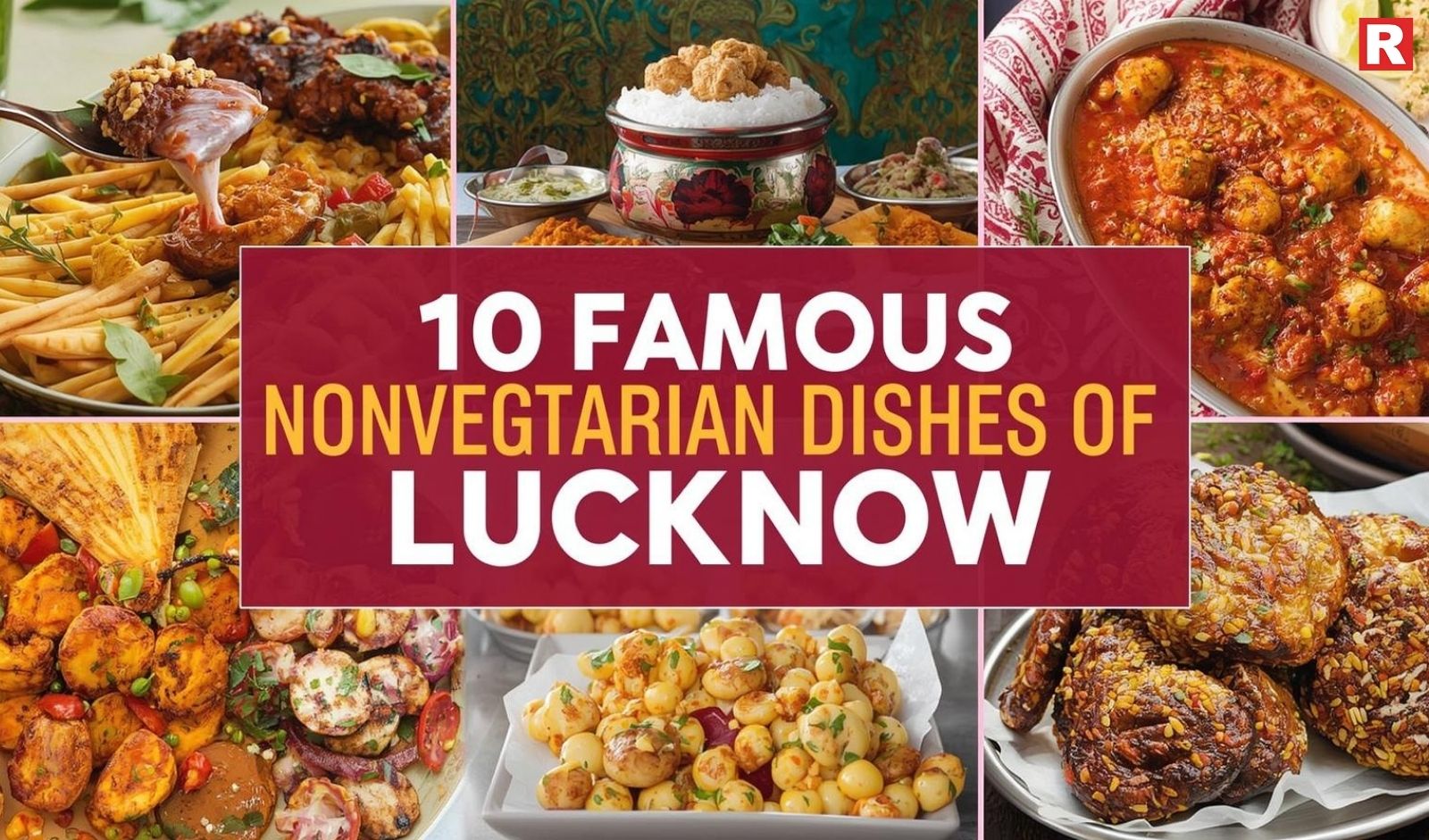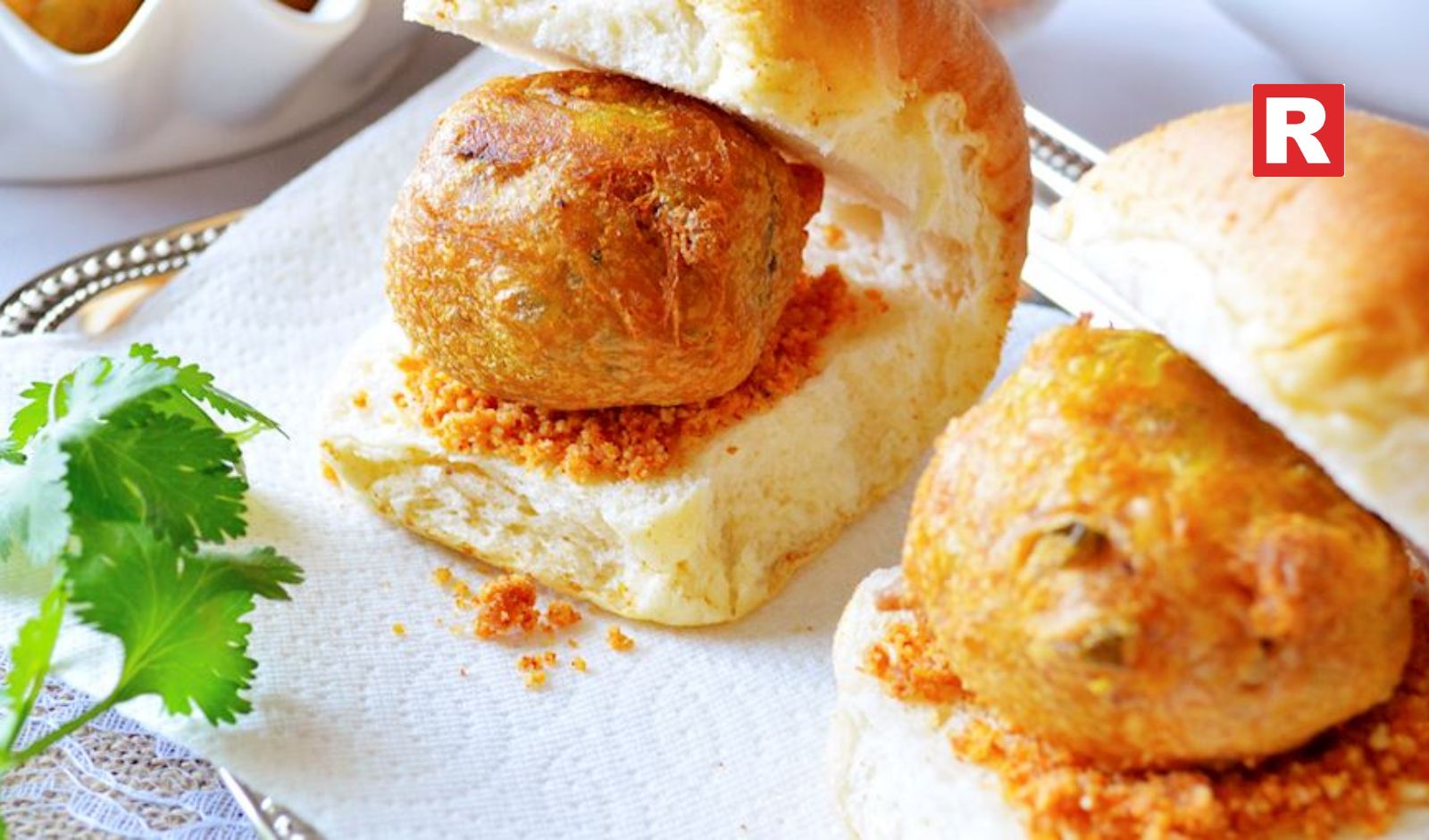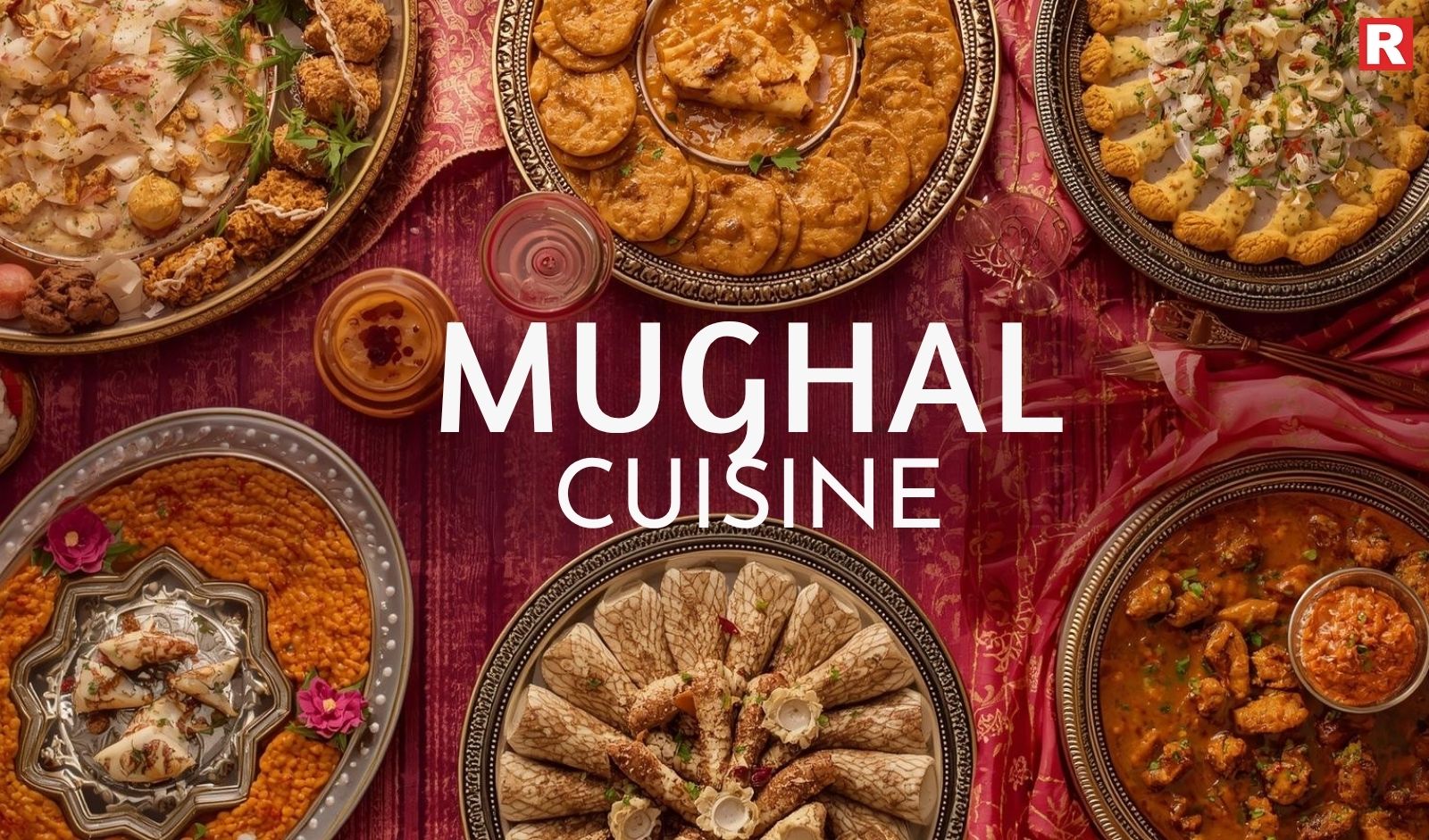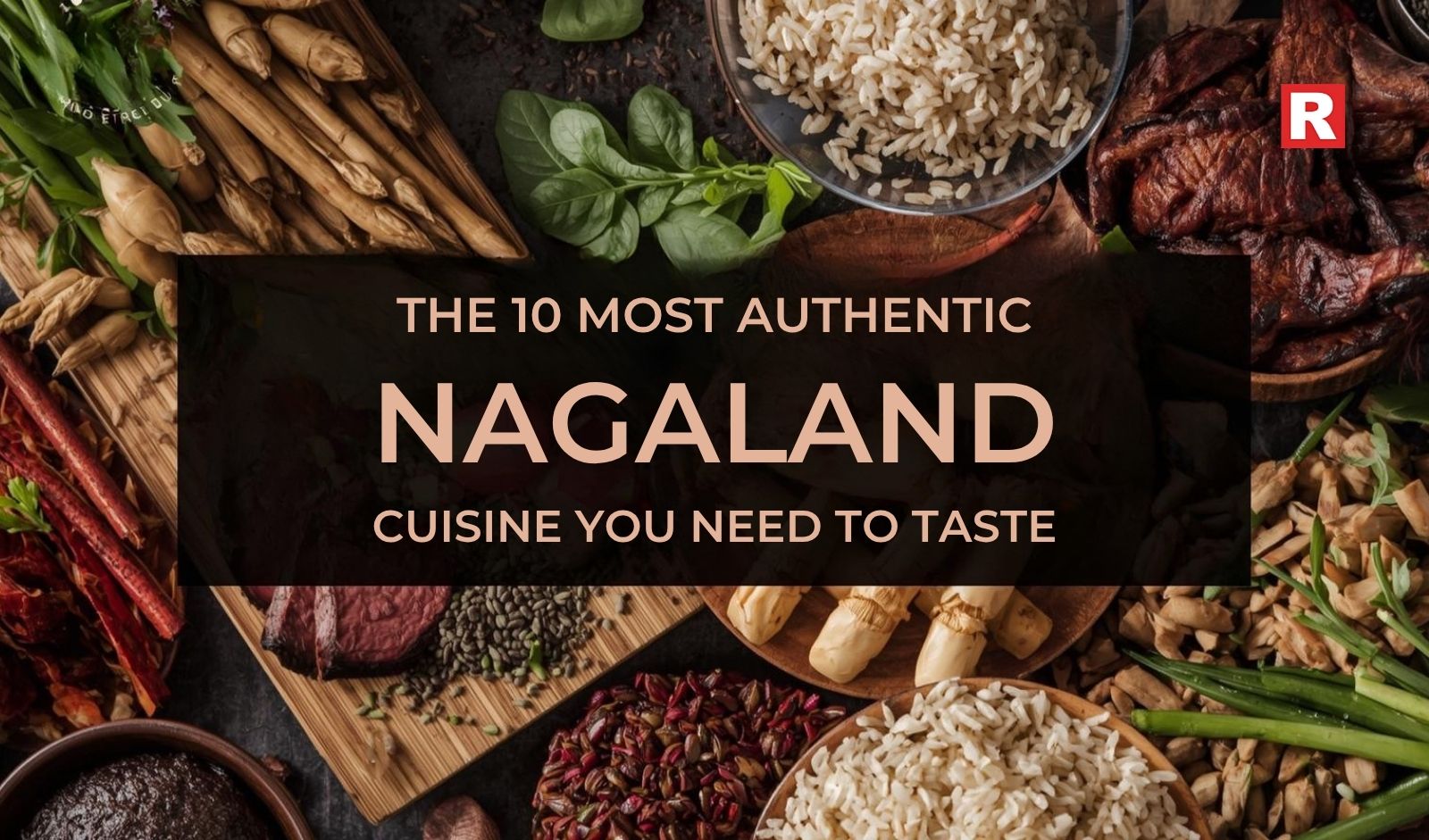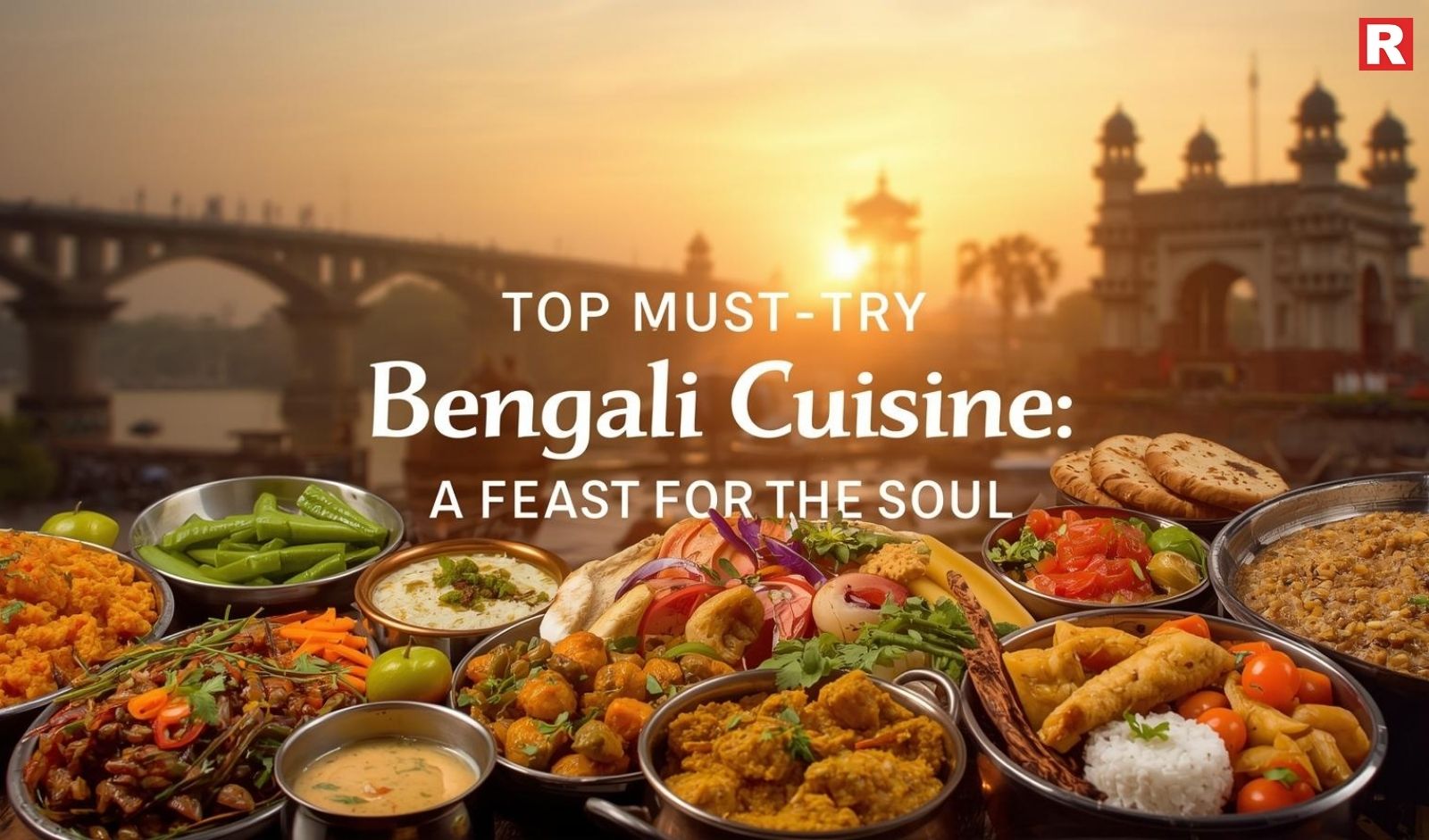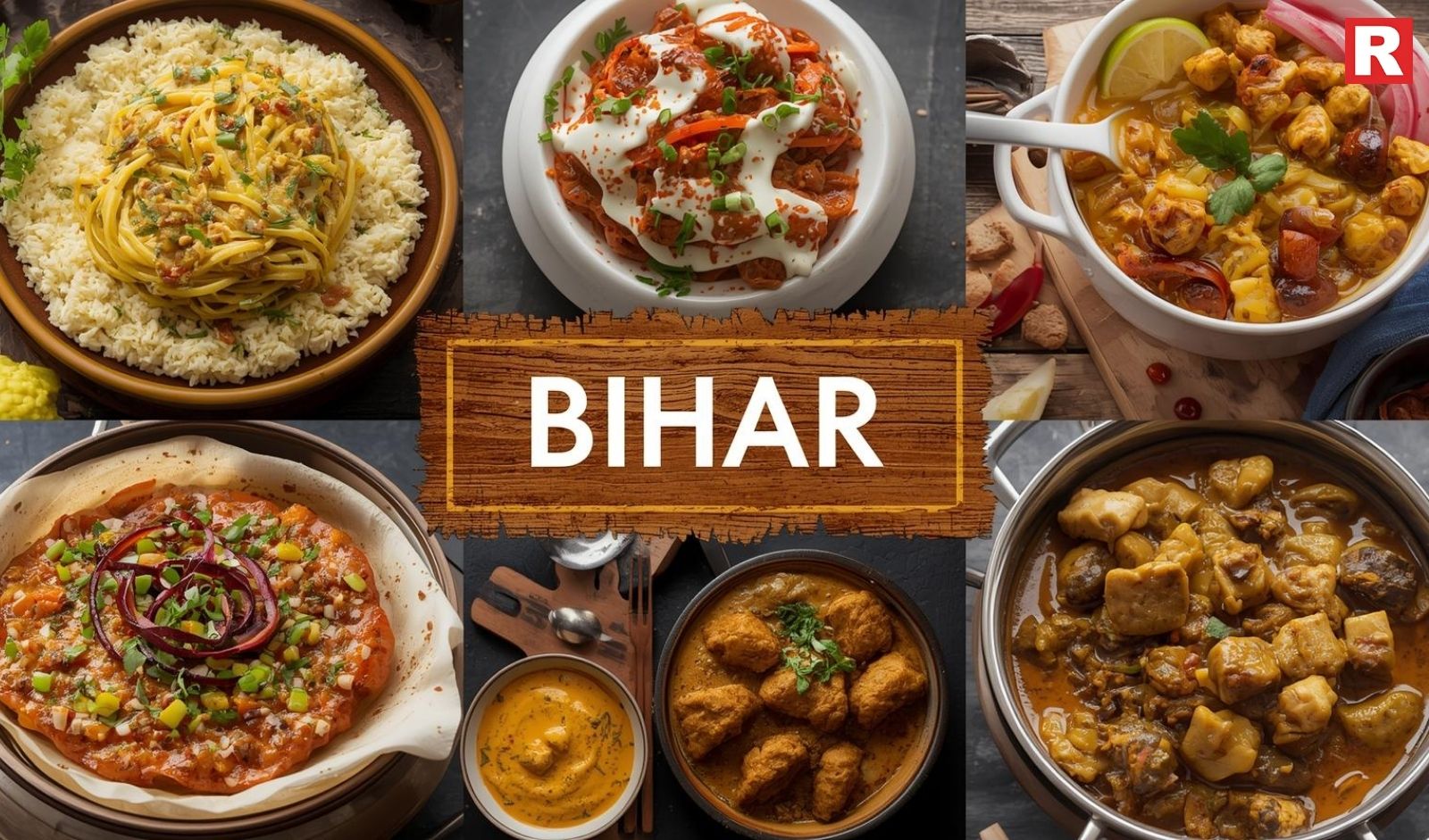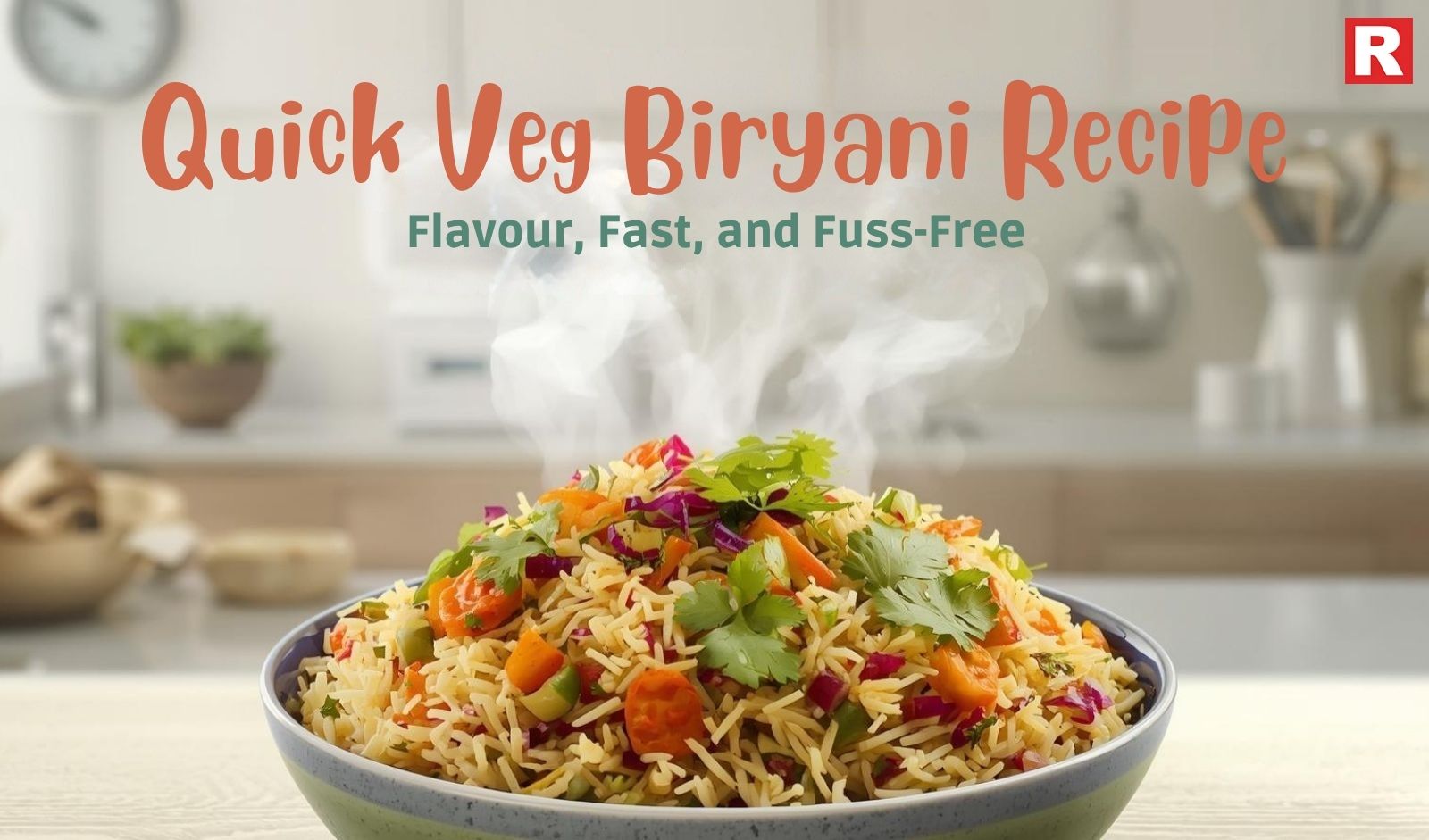
If you think “fried snacks” automatically means greasy pakoras or oily fries, it’s time to let the air fryer change your mind. This little gadget is a game-changer in the kitchen, bringing you all the crunch and flavor of your favorite fried foods, just without all the oil. Whether you’re a college kid craving something at midnight or juggling meetings all day and need a quick bite, or someone who just refuses to give up on taste while eating healthy. Either way, the air fryer’s got your back. Snacks come out faster, cleaner, and honestly, a whole lot healthier.
Indian street food, classic favorites from around the world—whatever you’re in the mood for, these 10 air fryer snacks are quick, easy, and loaded with flavor. So, let’s snack smart and fry even smarter.
Read more: 9 Types of Aloo Tikki Chaat That Rule Lucknow’s Streets
10 Easy Air Fryer Snacks You Can Make at Home
1. Air Fryer French Fries

Nothing beats a plate of crispy fries, and with an air fryer, you get all the goodness without the guilt of carbs and fat. Slice up some potatoes, soak them in cold water for half an hour to get rid of the extra starch, then dry them well. Toss them with just a teaspoon of oil, some salt, and maybe a pinch of paprika or chili powder if you want them spicy. Air fry at 180°C for 15 to 18 minutes, give the basket a good shake halfway through. What you get are golden fries, crunchy outside, fluffy inside. Air-fried fries have about 60% less fat than the deep-fried kind, plus they hang on to more potassium and vitamin C. Honestly, it’s just a smarter way to snack. Swap in sweet potatoes when you want a healthy change. They’re delicious and packed with fiber and antioxidants.
2. Crispy Paneer or Tofu Bites

If you’re looking for a snack that actually fills you up, these paneer or tofu bites won’t let you down. Cube your paneer or tofu, then coat them with curd, gram flour, and a mix of spices like red chili, cumin, and garam masala. Let them marinate, then air fry at 200°C for 10 to 12 minutes. They come out golden, a little charred at the edges, and perfectly soft inside. Dip them in mint chutney or spicy mayo. They are so delicious that they disappear fast. Best part? You still get all that protein from them, but with half the calories. Less oil means they’re easier on your stomach, too. You can marinate them ahead and just toss them in the air fryer whenever you want.
Know more: Top 10 Vegan Street Foods in India Every Indian Loves
3. Air Fryer Samosas
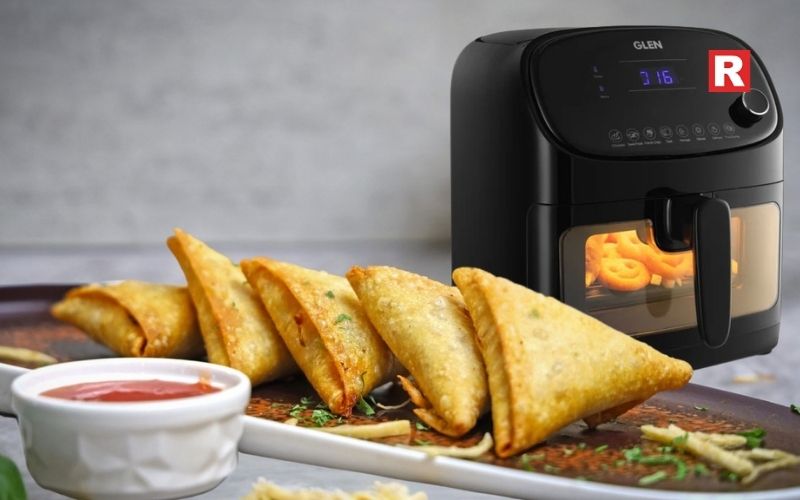
Want to eat samosas without the oily mess? The air fryer can make it happen. Use frozen samosas or make your own with a spicy potato or chicken filling. Brush them lightly with oil and air fry at 190°C for 8 to 10 minutes. They turn out crisp and golden, just like the deep-fried ones you love. Want extra flavor? Brush them with a little ghee before cooking. Serve hot with tangy tamarind or mint chutney. You’ll barely notice they’re lighter on oil. With samosas in the air fryer, you cut nearly 100 calories per piece and avoid a ton of unhealthy fat, but still get to eat a crispy snack.
4. Air Fryer Cheese Balls
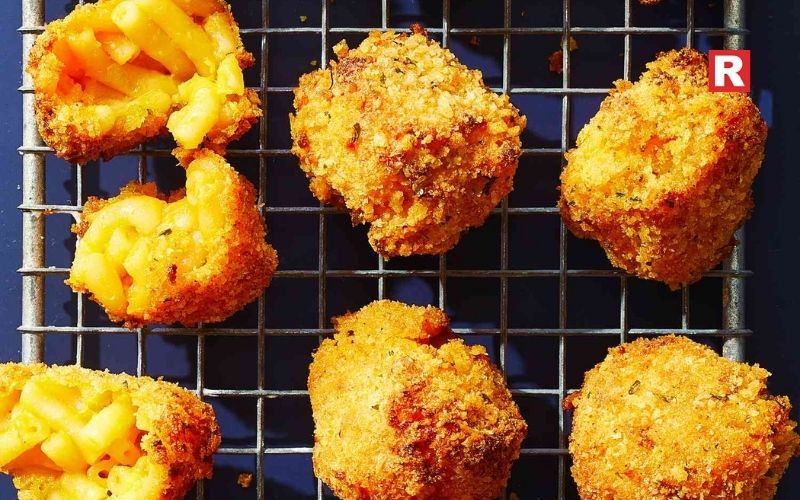
If cheese is your weakness, these cheese balls are pure joy for you. Mash potatoes, mix in cheese and herbs, shape them into balls, then roll in breadcrumbs. Freeze them for about 20 minutes so they hold together, then air fry at 200°C for 8 minutes. They’re crunchy on the outside, drippy and cheesy inside. You can throw in some sweet corn or jalapeños for a fun twist. Serve with your favorite dip, whether it is ketchup, ranch, or spicy mayo. Air-fried cheese balls soak up way less oil, so they’re lighter and easier to digest. You still get all the flavor, just without that heavy feeling.
5. Veg Cutlets

When it comes to cutlets, the air fryer keeps the outside crisp while using 70–80% less oil than deep frying. Mix mashed potatoes, peas, carrots, and spices like coriander, chili powder, and garam masala. Shape into patties, coat with breadcrumbs or even oats for a healthier version. Spray with a bit of oil and air fry at 180°C for 12 to 14 minutes. You get a crispy outside, soft, flavorful inside. They turn out light, full of fiber, and not greasy at all. Making these cutlets perfect with mint chutney or ketchup. Oats add extra texture and fiber, and you won’t even feel that they are not deep-fried.
6. Chicken Popcorn
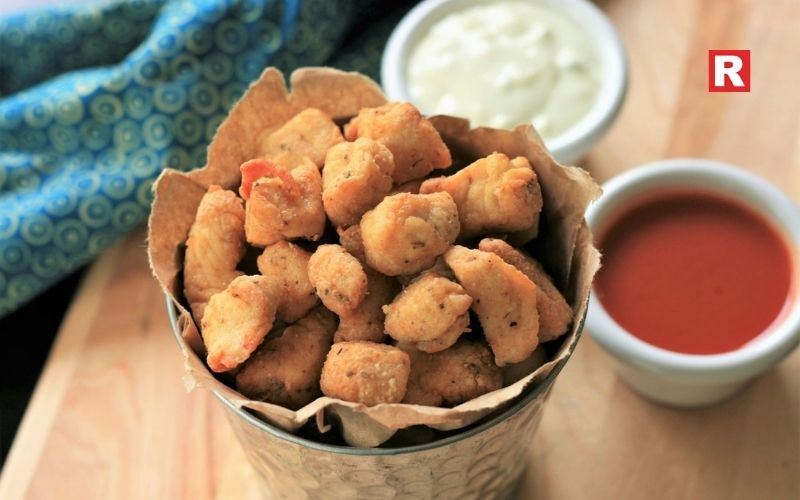
Are you hosting friends or just need something to munch during a movie? Chicken popcorn in the air fryer is the best choice. Marinate chicken pieces in buttermilk, chili powder, and garlic paste for half an hour. Coat with flour, breadcrumbs, and your favorite spices, then air fry at 200°C for 10 to 12 minutes. They come out juicy and crispy, just like restaurant popcorn chicken. Serve with spicy mayo or honey mustard, but don’t be surprised if they disappear before you even sit down. Chicken cooks up tender in the air fryer, with almost 50% fewer calories than deep frying. Therefore, no need to drown it in oil.
What's new: 10 Famous Indian Spices That Transformed Global Trade
7. Air Fryer Spring Rolls

Spring rolls just hit different when you make them in the air fryer. They come out light, crispy, and you don’t have to stand over a pot of hot oil. Grab some store-bought wrappers, fill them up with stir-fried veggies, noodles, or chicken, whatever you like, then seal them up with a bit of flour paste. Brush each roll with a little oil, pop them in the air fryer at 190°C, and let them go for 8 to 10 minutes. That’s it. They come out golden and crunchy, with a piping hot, flavorful filling. You still get that satisfying crunch, but with 80% less oil than deep frying. Light, but totally satisfying. Don’t forget the Schezwan or sweet chili sauce for dipping. This makes the whole thing taste like takeout, sometimes even better.
8. Sweet Potato Chips
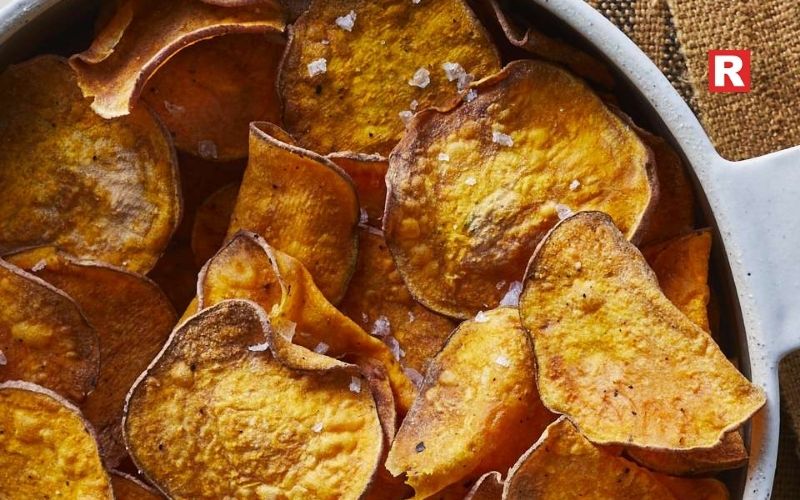
Sweet potato chips in the air fryer are a total game-changer. They’re light, crisp, and you actually taste the sweet potato instead of just oil. Just slice the sweet potatoes super thin. Then toss them with olive oil, salt, and a sprinkle of chili powder. Spread them out in the air fryer basket and cook at 180°C for 6 to 8 minutes. Give the basket a shake now and then so they all get nice and crispy. You end up with chips that have the perfect mix of crunch, sweetness, and a little heat. Air frying keeps those vitamins and antioxidants intact. Deep frying just adds fat and zaps the nutrients.
9. Garlic Bread

Just mix softened butter with minced garlic, chopped parsley, and a pinch of salt. Slather that all over slices of baguette (or any bread you have), throw on some cheese if you want. Air fry at 180°C for about 4 to 5 minutes. The air fryer melts butter evenly and keeps your garlic bread from getting greasy, which is way better than pan-fried or deep-fried versions. The edges come out crisp, the middle’s buttery, and the whole kitchen smells amazing. You get that bakery-style garlic bread without leaving your house. And if you want to make something different, try making it with pav or leftover buns.
Check out: 10 Indo-Japanese Fusion Foods You Must Taste
5 Veg Ramen You Can Try at Home
10. Banana Chips
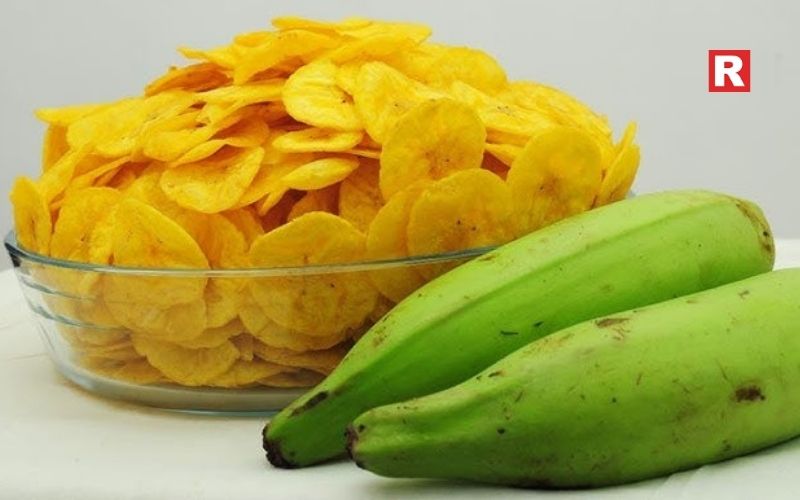
Slice raw bananas nice and thin, toss them with coconut oil and a bit of salt, then lay them out in the basket. Air fry at 180°C for about 10 to 12 minutes, giving them a shake every so often. They turn perfectly golden and crisp, and no deep frying is needed. Once they cool, store them in an airtight jar and they’ll stay crunchy for days. Air frying helps banana chips keep their fiber and potassium, without soaking up all that oil. These chips are addictive and naturally gluten-free and vegan.
Bonus: Healthy Air Fryer Snack Ideas
If you want lighter, protein-rich snacks, try roasted chickpeas with masala, kale chips with olive oil and salt, or apple chips dusted with cinnamon. They’re quick, full of nutrients, and way lower in calories than deep-fried snacks. Making them perfect if you’re following weight-loss, keto, or plant-based diets.
Pro Tips for Great Air Fryer Snacks
- Preheat your air fryer so everything cooks evenly and gets crisp.
- Don’t overcrowd the basket. Let the air move around for even browning.
- Shake or flip your snacks halfway through.
- Use just enough oil to coat lightly.
- Clean it after every use to avoid leftover smells or smoke.
- Mix up your flavors with spices like peri-peri, chaat masala, or Italian herbs.
Learn more: Top 10 Craft Beer Brands in India You Must Try
Snack Smart, Fry Smarter
You don’t have to give up taste to eat healthy. With an air fryer, you can enjoy all your favorite snacks, from paneer bites to banana chips, using way less oil, fewer calories, and more nutrients. These 10 easy recipes prove you can have crispy, golden treats without the guilt.
So, next time you’re hungry, skip the deep fryer and reach for your air fryer. There’s no reason your snacks can’t be crispy, delicious, and better for you, all at once.

Dark chocolate has long carried an air of mystery and charm. It is bold, intense, and layered with flavours that stay on the palate. Many call it an acquired taste, but once someone develops a liking for it, the love rarely fades. In India, dark chocolate is no longer just for the niche or experimental eater. More people are choosing it for its rich taste and health benefits. With higher cocoa content and less sugar, it offers a satisfying balance between indulgence and wellness. From casual snackers to true chocolate enthusiasts, the Indian market today caters to everyone. Affordable options from popular brands sit beside luxurious artisan creations made from single-origin cocoa. Each brand brings something unique — some focus on smooth texture, others on intense flavour or ethical sourcing.
Consumers are also becoming more aware of where their chocolate comes from and what goes into it. This shift has encouraged homegrown and global brands alike to innovate with quality and authenticity. Dark chocolate, once a rare indulgence, has now found its place in India’s everyday dessert culture — rich, elegant, and deeply satisfying.
Why Dark Chocolate Is Gaining Popularity in India
Once dominated by milk chocolate, India’s chocolate market is now evolving. According to recent industry insights, dark chocolate holds around 8% of the total chocolate market in India, and that share is steadily increasing. Urban consumers are becoming more health-conscious and adventurous with flavours. They’re looking for chocolates that are less sugary, more natural, and ethically sourced. This growing awareness has opened the doors for both homegrown artisan brands and global names to innovate in the dark chocolate space.
What sets dark chocolate apart is its high cocoa content — usually above 70%. It has less sugar, more antioxidants, and a complex flavour that ranges from fruity and nutty to roasted and earthy. In short, it’s chocolate for grown-up taste buds.
What Makes a Great Dark Chocolate
Not all dark chocolates are created equal. A great dark chocolate brand focuses on:
- Cocoa quality – Higher percentages (70% and above) mean richer taste.
- Ethical sourcing – Bean-to-bar production and fair trade practices.
- Purity – Minimal ingredients, often just cocoa, cocoa butter, and a hint of sugar.
- Flavour profile – Distinct notes that can be fruity, nutty, or smoky depending on the origin of the beans.
- Packaging and freshness – Keeps the chocolate crisp and melt-in-mouth.
When choosing, look at the cocoa percentage and the ingredients list — fewer additives usually mean better quality.
Best Dark Chocolate Brands in India to Try
1. Amul Dark Chocolate

Amul, one of India’s most trusted dairy brands, has become a popular name in dark chocolate. Its range offers cocoa content from 55% to 90%, giving options for both beginners and seasoned chocolate lovers. The brand focuses on strong flavour and smooth texture while keeping prices affordable. Made using Indian cocoa, Amul’s dark chocolates reflect quality and consistency. It has made premium taste accessible, becoming a favourite for everyday enjoyment across the country.
Why it stands out:
- Widely available across India.
- Affordable pricing starting at ₹45.
- Varieties like single-origin and sugar-free dark chocolate.
Read more: Top Sugar-Free Ice Cream Brands in India: Enjoy Every Scoop, Guilt Free!
What is Kimchi? Top Veg Kimchi You Can Try at Home
2. Mason & Co.
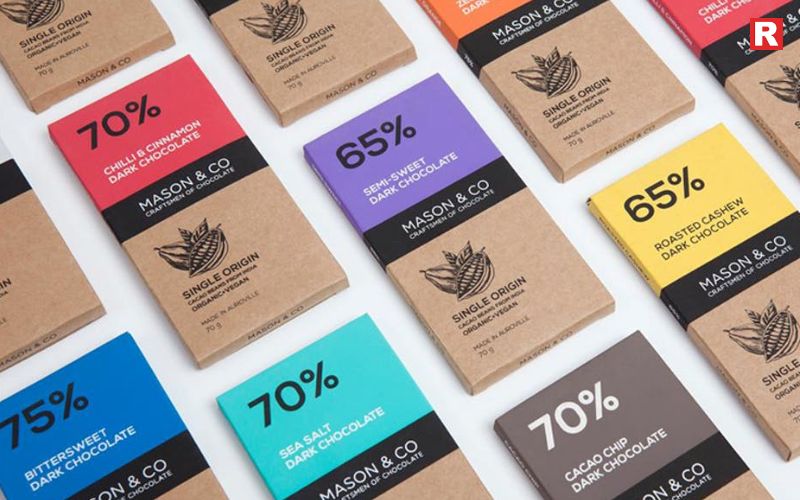
Mason & Co. is a bean-to-bar chocolate brand from Auroville, Tamil Nadu. It was founded by a couple passionate about pure, handmade chocolate. The brand sources cocoa directly from farms in South India, ensuring freshness and fair trade. All its chocolates are organic, vegan, and crafted in small batches. With rich flavours and minimal ingredients, Mason & Co. stands out for its focus on quality and sustainability, appealing to those who value authentic and ethical indulgence.
Why it stands out:
- Certified organic and ethically sourced.
- Available in flavours like 70% Intense Dark, Sea Salt, and Peppermint.
- Uses minimal ingredients, ensuring pure cocoa flavour.
3. Pascati Chocolates

Pascati is India’s first bean-to-bar chocolate brand with USDA Organic and Fairtrade certification. Each bar is made in small batches to maintain high quality and rich flavour. The brand blends international chocolate-making techniques with Indian ingredients and creativity. Known for smooth texture and bold taste, Pascati offers unique flavours like Rose Almond and Blueberry Walnut. It has become a preferred choice for those who enjoy fine, handcrafted chocolates with a touch of luxury and authenticity.
Why it stands out:
- Premium, smooth texture with fruity and nutty notes.
- Unique Indian flavours like Rose Almond and Blueberry Walnut.
- Excellent packaging for gifting.
4. Fabelle by ITC

Fabelle is a luxury chocolate brand by ITC, known for its rich taste and refined presentation. Each chocolate is crafted with care using premium ingredients and skilled techniques. The brand focuses on creating a complete sensory experience with smooth textures and balanced flavours. Fabelle’s range includes single-origin dark chocolates and elegant gift collections. It stands as a symbol of Indian chocolate artistry, offering indulgence and sophistication for those who appreciate fine and thoughtfully made chocolates.
Why it stands out:
- Premium single-origin dark chocolates.
- Available at Fabelle boutiques in ITC hotels and online.
- Ideal for gifting and festive occasions.
Know more: How to Pair Beer with Indian Food: A Desi Guide to Perfect Pints
5. Darkins
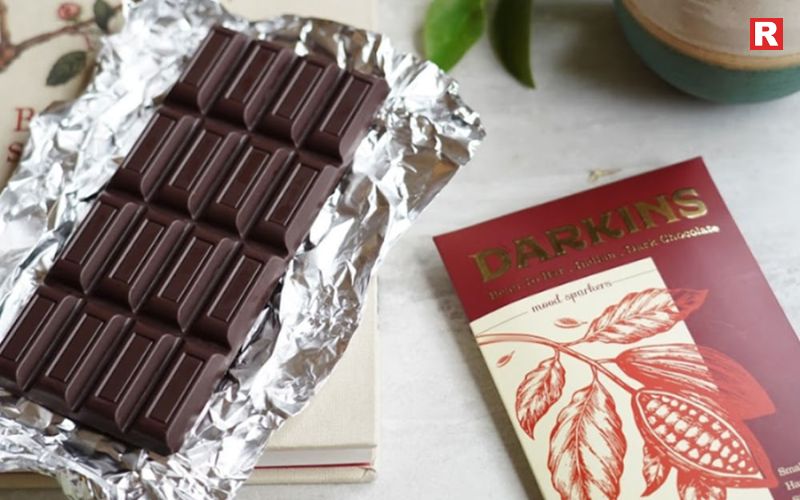
Darkins is a young Indian chocolate brand that has quickly gained attention for its quality and taste. It sources cocoa directly from plantations in Karnataka and Andhra Pradesh, supporting local farmers and promoting Indian cocoa. The brand makes single-origin dark chocolates that are pure, rich, and full of character. With vegan and gluten-free options, Darkins focuses on natural ingredients and honest flavours. It reflects the growing strength of India’s premium, homegrown chocolate industry.
Why it stands out:
- Single-origin chocolates with 70% and 80% cocoa variants.
- Gluten-free, vegan, and made with natural ingredients.
- Locally produced, highlighting the flavours of Indian cocoa.
6. Hershey’s Exotic Dark

Hershey’s is a well-known global chocolate brand that offers dark chocolate bars suited to Indian tastes. Its dark variants combine smooth texture with balanced cocoa flavour, making them enjoyable for both regular and new dark chocolate consumers. The brand’s pricing is affordable and its products are easily available in stores and online. Hershey’s bridges the gap between classic sweetness and bold dark chocolate taste, offering a familiar yet refined experience for everyday chocolate lovers.
Why it stands out:
- Widely available across supermarkets and online.
- Smooth texture with hints of cocoa bitterness.
- Perfect for those transitioning from milk to dark chocolate.
How to Choose and Enjoy Dark Chocolate
If you’re new to dark chocolate, start with bars that have around 60% to 70% cocoa. Anything above 85% will have a stronger, more bitter taste.
Tips for enjoying dark chocolate:
- Let it melt on your tongue instead of chewing it — this helps you savour its complex flavours.
- Pair it with coffee, red wine, or roasted nuts to enhance the experience.
- Store in a cool, dry place away from sunlight.
- Read the ingredients — the best bars have just cocoa mass, cocoa butter, and sugar.
Dark chocolate is also a healthier dessert option when eaten in moderation. It contains antioxidants, magnesium, and flavonoids that support heart health and mood balance.
Also check: 8 Famous Vegetarian Dishes of Uttar Pradesh and Their Timeless Legacy
Top 10 Vegan Street Foods in India Every Indian Loves
10 Awadhi Cuisine Classics You Must Try at Least Once
Final Thoughts
The dark chocolate market in India is expected to grow rapidly as more people explore premium and artisanal products. Homegrown brands are experimenting with unique flavours inspired by Indian ingredients like saffron, chilli, and Himalayan salt. E-commerce platforms and boutique stores are helping consumers access these chocolates easily, while gifting trends around Diwali, Christmas, and Valentine’s Day are driving sales. As Indian cocoa farming gains recognition, more brands are focusing on single-origin chocolates made entirely in India — from bean to bar. This approach not only promotes local agriculture but also supports sustainable livelihoods.
Dark chocolate is no longer a niche luxury — it’s a growing trend in India’s evolving taste landscape. From the affordability of Amul to the sophistication of Pascati and Fabelle, there’s a bar for every kind of chocolate lover. If you’re ready to explore, start small. Try different cocoa percentages, experiment with pairings, and find your personal favourite. Whether it’s a mindful treat after dinner or a thoughtful gift for someone special, India’s dark chocolate brands promise indulgence that’s rich, responsible, and truly satisfying. It’s time to unwrap, savour, and fall in love with the dark side of chocolate.

If you think of street-food in Lucknow, the crisp-edged potato patty slathered in tangy chutneys and creamy yoghurt inevitably comes to mind: the humble yet mighty aloo tikki chaat. The city of Nawabs doesn’t just serve it one way — here you’ll find multiple versions, each a flavour blast in its own right. In this article, we journey through 9 distinct versions of aloo tikki chaat that dominate Lucknow’s chaat stalls, shining a spotlight on how the base remains the same (potato + frying) but the toppings, textures and presentation shift dramatically.
Why Lucknow loves aloo tikki chaat
In the rich culinary landscape of Lucknow — steeped in Awadhi traditions — chaat has found a rightful place. The very idea of combining crispness, spice, sweetness and cooling yoghurt reflects the layered taste-profile often associated with the city’s cuisine. Street-vendors in Lucknow continue to reinvent the format, adapting to local moods, seasons and eater-preferences.
The 9 Aloo Tikki Versions famous in Lucknow
1. Classic “Dahi & Chutney” Aloo Tikki
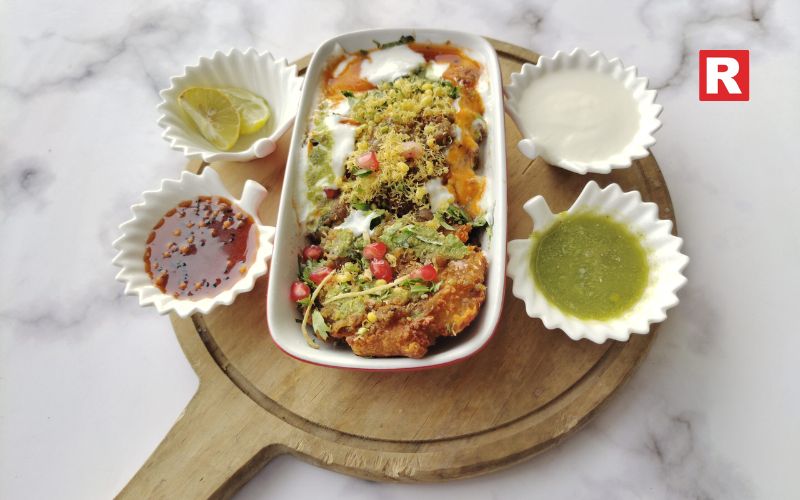
This is your baseline version. Crisp-fried potato patties, topped with chilled yoghurt (dahi), tamarind-sweet chutney (saunth/imli) and green coriander-mint chutney. Finished with sprinkle of chaat-masala and sev for crunch. The richness of the yoghurt and the tang of chutneys make this the default choice for many.
2. Chickpea-Loaded Aloo Tikki Chaat
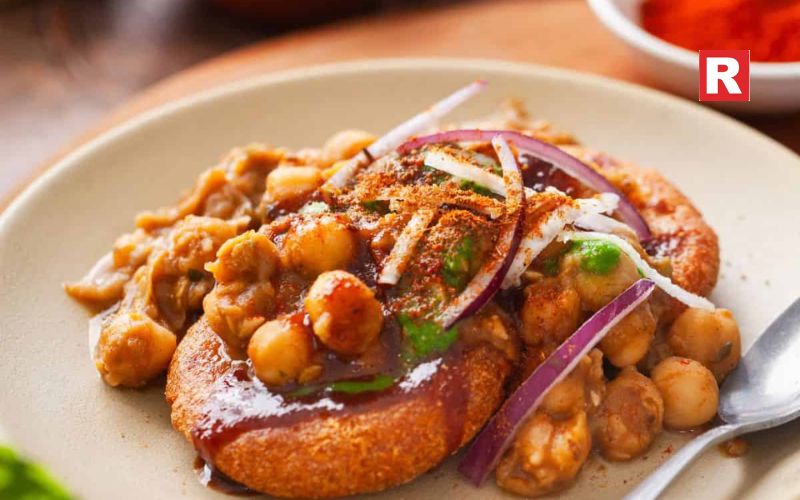
Here the patties are served under a generous topping of boiled chickpeas (chana) or black-chana, adding extra bite and protein. The chickpeas mix in with chutneys and yoghurt making each spoonful heartier. Great choice if you want something more substantial than the classic.
3. Tokri/Basket Aloo Tikki Chaat
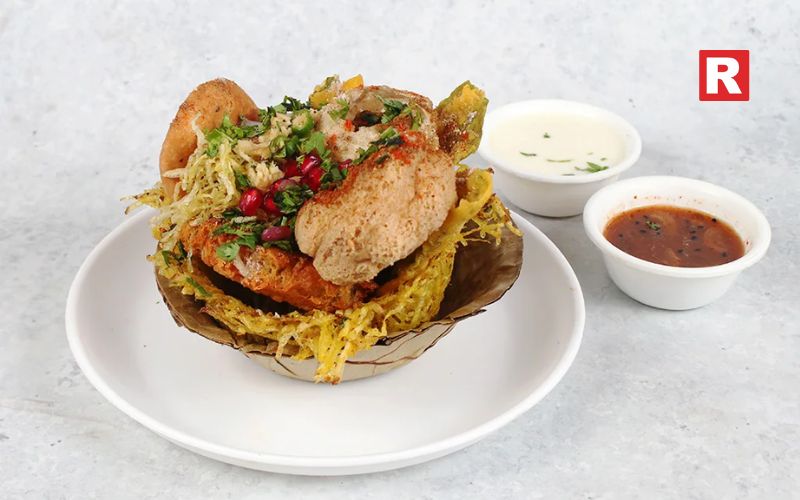
A clever twist: the aloo tikki gets served in a crisp potato basket (or deep-fry potato shell) aka “tokri” which holds the chutneys, yoghurt and toppings. It adds a fun textural layer — you scoop the toppings and the patties together, bite into the basket shell. Mentioned among Lucknow’s iconic chaat forms.
4. Paneer-Stuffed Aloo Tikki

Here the twist comes inside: the potato patty is stuffed with mildly spiced paneer (Indian cottage cheese) or sometimes peas + paneer. Once fried, it’s topped with the usual chutneys and yoghurt. This version gives an extra creamy interior surprise.
5. Sweet-Spicy “Seasonal” Aloo Tikki Chaat
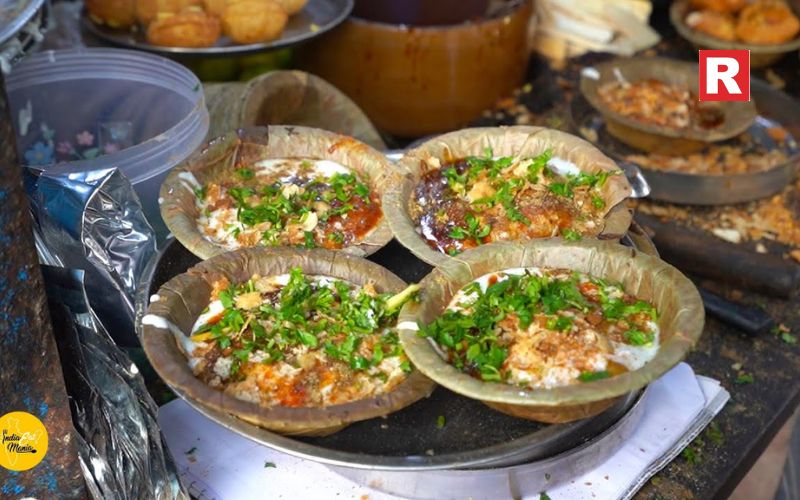
In some stalls you’ll find a version leaning more into the sweet side: the tamarind-jaggery chutney is stronger, the yoghurt lighter, and toppings may include pomegranate seeds, raisins or nuts. It’s a balance of sweet-spice-tang that works especially well in the evening or festive times.
6. Dry “Crushed” Aloo Tikki Chaat

For those who dislike yoghurt or want less mess, this version features the aloo tikki lightly smashed after frying, then sprinkled with chaat spices, onions, coriander, red chilli powder, and limited chutneys (or none). The result: crispier, drier, snack-style. Ideal for walking and munching.
7. Deluxe Tikka Chaat with Sev & Beetroot
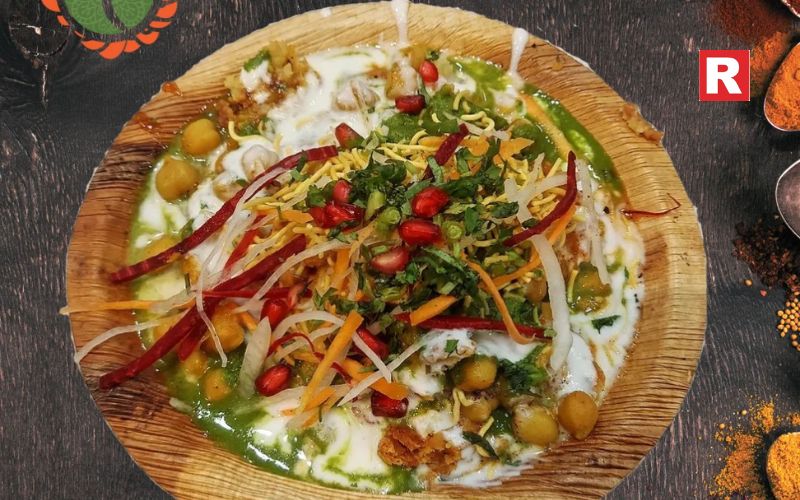
Stepping up the presentation: this version adds generous layers of sev (crispy chickpea flour noodles), finely chopped beetroot (for colour and subtle sweet-earthiness), maybe some pomegranate arils, and extra coriander. The vegetarian “deluxe” feels celebration-ready (think: evening outing after shopping in Hazratganj).
8. Mini Slider Aloo Tikki Chaat
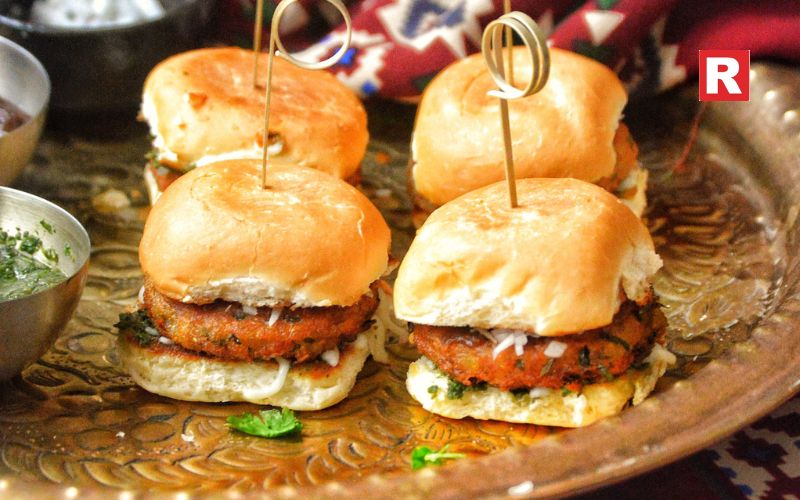
A modern reinterpretation by some street-vendors: teeny aloo tikki patties served between small buns or pav, topped quickly with chutneys and micro-greens. While not traditional, this variant appeals to younger crowds and tourists looking for something Instagram-friendly.
9. Healthy/Baked Aloo Tikki Chaat

Responding to health-conscious demand, some stalls now offer lighter versions: aloo tikki baked or shallow-fried, less yoghurt, more fresh salad-toppings (cucumber, carrot shreds), chutneys kept light. It may still be street-food, but with a nod to mindful eating.
What ties them all together
- The base: spiced, mashed potato formed into a patty and fried or baked.
- The flavour pillars: sweet (tamarind/jaggery), tang (lime, tamarind), cool (yoghurt) and crisp/texture (sev, onions, basket shell).
- The street-service style: quick, often handheld, vibrant in flavour and presentation — a hallmark of the chaat culture in Lucknow.
- Adaptation: each version tweaks one or more elements (stuffing, topping, presentation) while keeping the essence intact.
Best time & places to try
For best experience: visit the street-stalls around Hazratganj or Aminabad in the early evening. The light is golden, the stalls are buzzing, and you’ll spot chaat-sellers flipping tikkis, peeling potatoes, mixing chutneys — all that theatre adds to the flavour. According to food-guides, this is a prime way to experience Lucknow’s chaat culture.
Quick FAQs
Q: Is aloo tikki chaat originally from Lucknow?
A: Not exclusively — the broader dish “aloo tikki” is common across North India. But Lucknow has made the chaat version its own through local toppings, textures and presentation.
Q: Are all the Tikkis Vegetarian only?
Yes — all the versions above are vegetarian. That’s typical for chaat stalls in Lucknow offering aloo tikki.
Q: How much does it cost?
Street-prices vary depending on toppings and location — but you’ll find versions from modest budget to slightly premium. (Always check current cost on site.)
Final take
Whether you keep it classic or try the basket-tokri version, whether you go for stuffed or healthy, the aloo tikki chaat of Lucknow has something for every mood. The magic lies in the balance — crispy potato, warm spice, cool yoghurt, sweet and tangy chutneys, and a dash of crunch. Next time you walk the lanes of Lucknow, make it a mission: pick a stall, choose your version, and savour one of the city’s street-food heroes.

There’s nothing quite like the joy of ice cream. It’s creamy, cold, and comforting. But for many who watch their sugar intake, it often feels like a guilty pleasure. Now, that guilt can finally melt away. As health awareness grows, more Indians are choosing desserts that taste good and support a healthy lifestyle. From diabetics to fitness lovers, everyone is looking for sweet treats that don’t harm their health goals. The good news is that ice cream makers across the country are listening.
Indian brands have begun to reinvent ice cream with sugar-free and low-calorie options. These new versions keep the same creamy texture and rich flavor but skip the added sugar. Many even use natural sweeteners like stevia or erythritol, making them a smarter choice for mindful eaters. Today, enjoying ice cream no longer means giving up on wellness. Whether it’s a classic vanilla or a modern mocha fudge, there’s a sugar-free scoop for every taste. This article explores the top sugar-free ice cream brands in India that blend health and happiness perfectly. Let’s dig in.
Why the Scoop Went Healthier
India’s dessert scene is evolving fast. As more people adopt mindful eating habits, there’s a rising demand for treats that are both delicious and health-friendly. With growing awareness around diabetes, calorie control, and clean ingredients, sugar-free and low-calorie ice creams are gaining popularity across cities.
The Indian frozen dessert market is witnessing a wave of innovation — from plant-based alternatives to natural sweeteners like stevia and erythritol. These ice creams not only reduce sugar but retain the rich, creamy texture that every ice cream lover craves.
What Makes an Ice Cream Truly Guilt-Free
Not all sugar-free ice creams are created equal. Before you reach for that tub, it’s important to know what to look for:
- Understand the label: “Sugar-free” usually means no added sugar, but some natural sugars from milk or fruit may still be present.
- Sweeteners used: Look for natural, safe sweeteners like stevia, erythritol, or xylitol. Avoid products that rely heavily on artificial substitutes.
- Check calories: Sugar-free doesn’t automatically mean low-calorie. Some ice creams use extra cream or fat to balance taste.
- Dairy or plant-based: For those who are lactose-intolerant or vegan, many brands offer coconut or almond milk-based options.
- Taste and texture: The best sugar-free brands manage to keep the creamy consistency and authentic flavor intact.
Remember, moderation is key. Even sugar-free desserts should be enjoyed in sensible portions.
Here’s a list of Top Sugar-Free Ice Cream Brands in India:
1. Amul Sugar-Free Ice Creams
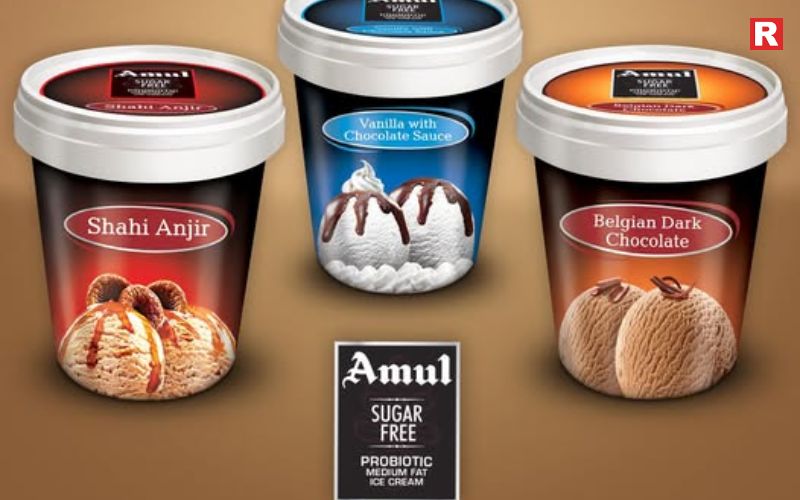
Amul, India’s most loved dairy brand, brings a trusted range of sugar-free ice creams for guilt-free indulgence. Its popular flavors like Vanilla and Shahi Anjeer retain the creamy texture and rich taste Amul is known for. Amul’s sugar-free range shows how a traditional brand can adapt to modern wellness trends without losing its classic flavor.
Why it stands out:
- Affordable and easily available across India.
- Sweetened with safe alternatives such as polydextrose and fructooligosaccharides.
- Ideal for diabetics or anyone looking to reduce sugar intake.
Read more: Top 10 Vegan Street Foods in India Every Indian Loves
What is Kimchi? Top Veg Kimchi You Can Try at Home
2. Go Zero Ice Creams
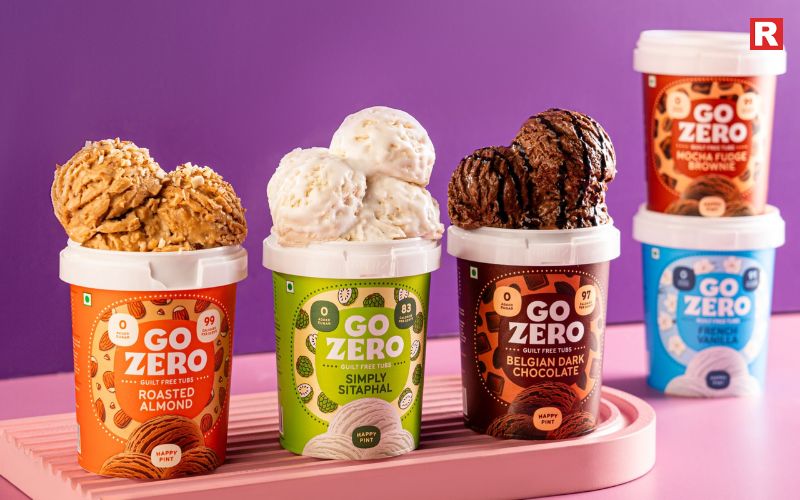
Go Zero has become India’s modern choice for guilt-free indulgence. The brand creates low-calorie, high-protein, and sugar-free ice creams that still taste rich and creamy. It focuses on using quality ingredients to deliver flavor without the extra sugar. Popular among fitness enthusiasts and mindful eaters, Go Zero proves that health and taste can go hand in hand. For anyone who loves desserts but wants a lighter option, Go Zero is the brand to trust.
- Popular flavor: Mocha Fudge Brownie — rich, chocolatey, and satisfying.
Why it stands out:
- Perfect balance of creamy texture and reduced calories.
- Ideal for fitness enthusiasts and calorie-conscious consumers.
- A trendy choice for those who enjoy new-age dessert experiences.
3. Minus 30 Ice Creams

Minus 30 is a premium ice cream brand known for its artisanal touch and clean ingredients. It offers a vegan and sugar-free range that blends health with indulgence. The Coconut Mini Stick and Dark Chocolate flavors are fan favorites for their rich taste and smooth texture. Made with plant-based ingredients, Minus 30 appeals to those who care about wellness and sustainability. It’s the perfect choice for anyone who enjoys guilt-free, eco-friendly desserts with real flavor.
Why it stands out:
- Made from 100% plant-based ingredients.
- Sweetened with natural substitutes.
- Offers gourmet flavors with zero added sugar.
Know more: 8 Famous Vegetarian Dishes of Uttar Pradesh and Their Timeless Legacy
4. Cream Bell Sugar-Free Range

Cream Bell is a well-known ice cream brand loved by families across India. Its sugar-free range offers the same creamy taste with a healthier twist. The brand focuses on creating desserts that are both delicious and mindful. With options like the Sugar-Free Chocolate Cup, it lets people enjoy sweetness without worry. Affordable and widely available, Cream Bell makes guilt-free indulgence easy for everyone. It’s the perfect blend of comfort, taste, and smart eating.
- Popular flavor: Sugar-Free Chocolate Cup — rich, creamy, and full of flavor.
Why it stands out:
- Budget-friendly and widely accessible.
- Great option for smaller cities and towns.
- Offers a satisfying chocolate experience without added sugar.
5. Gelato Vinto Sugar-Free & Vegan Options

Gelato Vinto is known for its premium, Italian-inspired ice creams made with care and quality. The brand offers sugar-free, plant-based gelatos that combine taste with health. Each scoop is crafted using natural ingredients and low-glycemic sweeteners for a balanced dessert experience. With its smooth texture and rich flavors, Gelato Vinto appeals to those who seek luxury without guilt. It perfectly blends Italian artistry with India’s growing love for healthy, mindful desserts.
Why it stands out:
- Purely plant-based and dairy-free.
- Focuses on clean, high-quality ingredients.
- Ideal for vegans, lactose-intolerant individuals, and health-conscious eaters.
Also check: 5 Tasty Coconut Dishes You Can Try at Home
16 Types of Food and Beverage Service Outlets in India
What Sets These Brands Apart
The best sugar-free ice cream brands focus on three major aspects:
- Ingredient Innovation: From natural sweeteners like stevia to low-fat milk and plant-based alternatives, these brands redefine indulgence.
- Taste and Texture: They maintain the rich, creamy experience expected from ice cream — without the sugar crash.
- Transparency and Trust: Leading brands clearly list their ingredients, ensuring consumers know what they’re enjoying.
Consumers today don’t just want desserts — they want “smart indulgence.” That’s exactly what these brands deliver.
Sweeteners and Ingredients to Know
It helps to understand what goes into your sugar-free scoop:
- Stevia: A plant-derived sweetener that has zero calories and a mild sweetness.
- Erythritol: A natural sugar alcohol with low glycemic impact.
- Xylitol: Adds sweetness without the high calorie count.
- Polydextrose and Fructooligosaccharide: Prebiotic fibers often used to balance texture.
- Base Ingredients: Cow’s milk for traditional options or coconut and almond milk for vegan choices.
These ingredients ensure that you can enjoy your favorite treat without affecting your health goals.
How to Choose Your Perfect Scoop
When selecting your ideal sugar-free ice cream, keep these quick tips in mind:
- Read the nutrition label carefully.
- Check the type of sweetener used.
- Pick a flavor that satisfies both your taste and health preferences.
- Try smaller cups first to find what suits your palate best.
Whether you prefer a vegan coconut scoop or a classic chocolate delight, there’s a sugar-free option for everyone today.
Final Scoop
The ice cream market today has changed for the better. People no longer have to choose between health and happiness. With a growing range of sugar-free and low-calorie options, everyone can now enjoy their favorite dessert without worry. Brands like Amul bring classic, trusted flavors in a lighter form, while Go Zero caters to those who want indulgence with balance. Minus 30 adds a premium touch with vegan, plant-based creations made from natural ingredients. Even Gelato Vinto and Cream Bell have joined the shift toward mindful desserts. Each brand offers something unique, from traditional scoops to innovative, health-focused treats. This change reflects how Indian consumers are embracing smarter food choices without giving up joy. So, it’s time to pick your favorite flavor, serve a scoop, and enjoy it guilt free. Ice cream has never felt this good — or this balanced.

Sushi has come a long way from the streets of Japan to become a global favourite. What was once seen as a rare delicacy is now a popular choice for food lovers around the world. In India too, sushi has found its place on the menus of fine dining restaurants, trendy cafés, and home delivery platforms. Cities like Mumbai, Delhi, and Bangalore are leading this change, offering versions that suit both traditional Japanese flavours and Indian preferences.
At its core, sushi is about balance—the perfect mix of rice, vinegar, and fresh ingredients. It is not just food; it is an art form that reflects Japan’s respect for simplicity and detail. From the way it is prepared to the way it is served, every step matters. The rise of vegetarian and fusion sushi in India shows how this global dish continues to evolve while keeping its authenticity. Sushi is more than just a meal; it is a cultural experience that connects people across borders through taste, texture, and craftsmanship.
What is Sushi?
Sushi is often mistaken for raw fish, but that’s not entirely true. The heart of sushi lies in its rice—a unique, vinegared rice called shari that gives sushi its signature taste. It is combined with various ingredients such as seafood, vegetables, or eggs. Some sushi varieties use seaweed (nori) to hold the rolls together, while others are served as pressed rice topped with fish or vegetables. The balance between the slightly tangy rice, fresh ingredients, and condiments like soy sauce and wasabi makes sushi such an extraordinary experience. Every bite offers a perfect blend of taste and texture — light, flavorful, and deeply satisfying.
In India, sushi has become a symbol of modern dining. From luxury restaurants like Wasabi by Morimoto at The Taj Mahal Palace to casual cafés and cloud kitchens, sushi is winning fans across all age groups. Vegetarian versions, especially, have found popularity among Indian diners who prefer lighter, plant-based meals.
The History and Cultural Significance of Sushi
The story of sushi began centuries ago in Japan. Its earliest form, known as narezushi, was actually a preservation method — rice was used to ferment fish and keep it fresh for longer periods. Over time, Japanese chefs refined this process, focusing on taste and presentation.
By the 19th century, sushi evolved into the modern Edo-style version, known as nigiri sushi — hand-pressed rice topped with slices of fresh fish. This became popular as quick, portable street food in Tokyo (then Edo). Sushi’s rise across the world mirrors Japan’s growing cultural influence. Today, it represents Japanese philosophy — harmony, simplicity, and respect for ingredients. Every sushi roll tells a story of craftsmanship, patience, and precision.
Explore 5 Different Types of Sushi You Must Know
Sushi comes in many forms, each with its own flavor, look, and preparation style. Here are five of the most loved types you should try.
1. Nigiri Sushi – The Classic Bite
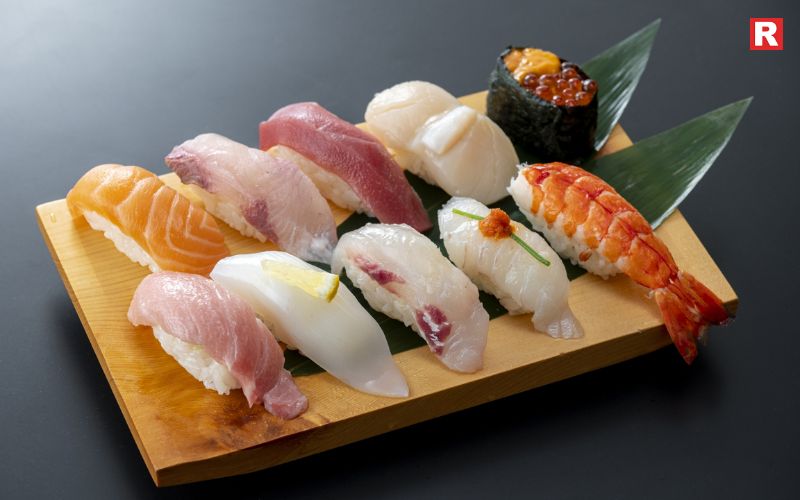
Nigiri is the most traditional form of sushi. It consists of a small, hand-pressed mound of vinegared rice topped with a thin slice of raw or cooked fish, or sometimes vegetables. A hint of wasabi is often added between the rice and the topping. Nigiri is known for its simplicity — no seaweed, no fuss, just clean, balanced flavors. Popular toppings include salmon, tuna, shrimp, and egg omelet. It’s usually enjoyed with a light dip in soy sauce.
Read more: What is Kimchi? Top Veg Kimchi You Can Try at Home
6 Unexpected Benefits of Eating Jackfruit (Kathal) – Nature’s Spiky Surprise!
2. Maki Sushi – The Famous Roll
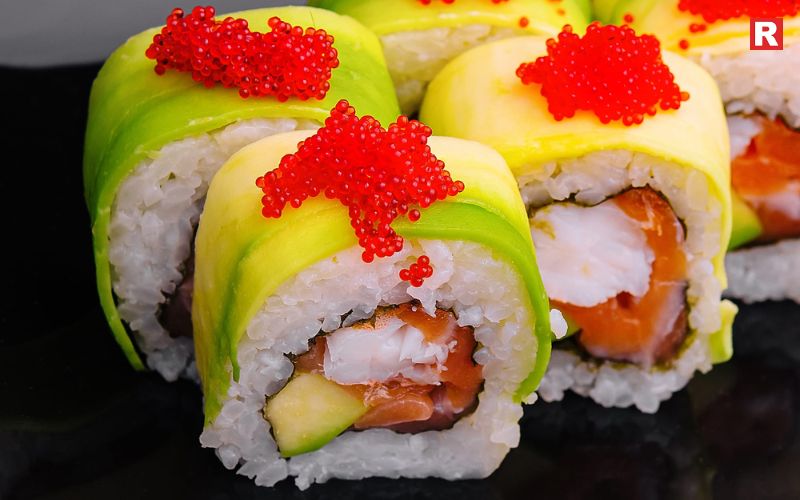
Maki sushi is what most people imagine when they think of sushi rolls. It features a layer of seaweed (nori) on the outside, followed by sushi rice and fillings like cucumber, avocado, crab stick, or tuna. The roll is then sliced into bite-sized pieces. Maki is colorful, photogenic, and perfect for beginners who want to experience different textures in one bite. Many Indian restaurants serve vegetarian maki rolls with fillings like asparagus, carrot, or tempura vegetables.
Know more: Top 10 Vegan Street Foods in India Every Indian Loves
3. Uramaki – The Inside-Out Roll
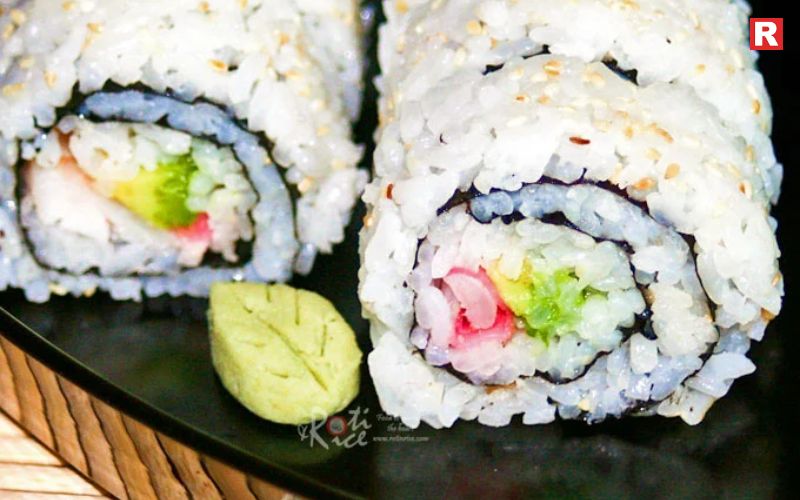
Uramaki, or inside-out roll, is a Western innovation that flipped traditional sushi inside out. Here, the rice is on the outside and the seaweed wraps the filling inside. It is often rolled in sesame seeds or fish roe for added flavor and visual appeal. The famous California Roll is a type of uramaki, filled with crab stick, avocado, and cucumber. It’s creamy, smooth, and very beginner-friendly. In India, fusion versions with ingredients like spicy mayo or paneer tempura are becoming trendy in modern sushi bars.
4. Temaki – The Hand Roll

Temaki looks like a cone made of seaweed, filled with sushi rice, fish, and vegetables. It’s rolled by hand and eaten without chopsticks, making it fun and casual. Each temaki offers a burst of freshness and crunch. Because of its cone shape, every bite gives you a mix of all ingredients. It’s ideal for home sushi nights or casual dining with friends. Vegetarian versions with avocado, tofu, and lettuce are also popular.
5. Sashimi – The Purest Form of Flavor
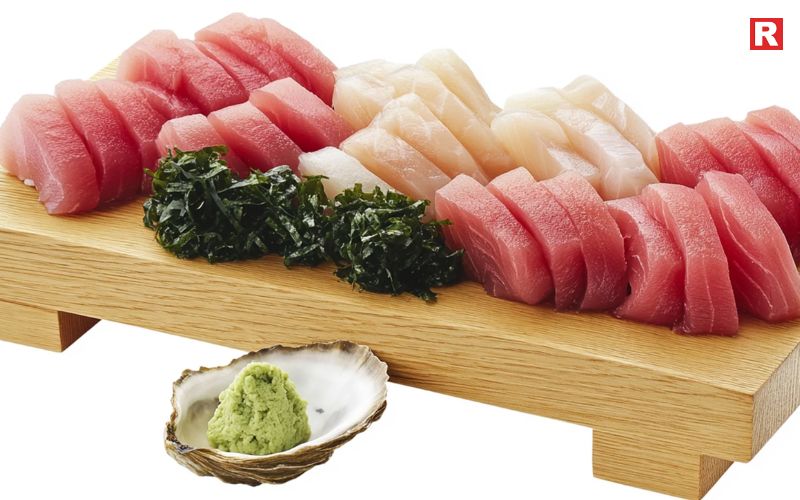
Though technically not sushi (since it doesn’t include rice), sashimi is an essential part of Japanese dining. It consists of thinly sliced raw fish or seafood served with soy sauce and wasabi. Sashimi celebrates freshness — it’s about tasting the ingredient in its purest form. Chefs select the finest cuts of tuna, salmon, or octopus and slice them with precision. For those who enjoy delicate flavors and texture, sashimi is a refined experience.
Vegetarian Sushi Options for Indian Palates
Sushi doesn’t have to include seafood. Vegetarian sushi has become a favourite among Indian diners, offering a fresh and light alternative. Common fillings include cucumber, avocado, tofu, carrot, asparagus, and pickled radish.
Many restaurants in India also experiment with local twists — like paneer tempura rolls or spicy mayo with roasted sesame seeds. The use of ingredients such as cream cheese or mango makes these vegetarian rolls both familiar and exotic. These dishes allow vegetarians to enjoy sushi’s textures and presentation without compromising their food preferences.
Also check: 5 Veg Ramen You Can Try at Home
7 Korean Veg Dishes to Try on Your Next Visit
How to Enjoy Sushi the Right Way
Eating sushi is as much about etiquette as it is about taste. Here are a few simple tips to enhance your experience:
- Eat sushi in one bite to enjoy the full flavor balance.
- Avoid soaking the rice in soy sauce; lightly dip the topping side instead.
- Use chopsticks or your hands — both are acceptable.
- Cleanse your palate with pickled ginger between different types of sushi.
Wasabi adds a sharp kick, but it should be used in moderation. And remember, sushi chefs in Japan spend years perfecting their craft, especially the art of preparing and seasoning the rice. Respecting that effort makes the experience even more meaningful.
Final Thought
From Japan’s traditional kitchens to global restaurants, sushi has become a symbol of cultural exchange. Its appeal lies in the perfect blend of art and simplicity — a dish that looks beautiful, tastes elegant, and celebrates fresh ingredients. In India, sushi is not just a food trend but a culinary experience that connects global flavors with local curiosity. Whether you’re trying your first maki roll or enjoying a delicate piece of nigiri, sushi invites you to slow down, appreciate balance, and taste craftsmanship in every bite. Sushi is more than just a meal; it’s a story of tradition, innovation, and creativity. The next time you sit down to enjoy sushi, notice the texture of the rice, the freshness of the filling, and the precision in every roll. It’s a reminder that great food isn’t just eaten — it’s experienced.

India’s history is soaked in spice. For ages, people have called it the “Land of Spices,” and honestly, that’s no exaggeration. From the bustling ports of Kerala to the lavish kitchens in Delhi, Indian spices have done more than just flavor food; they’ve changed the world. Explorers risked everything, like crossing wild oceans for them. Empires fought and fell over them. Trade boomed and the world got a little smaller, all thanks to these tiny, powerful ingredients.
Let’s take a quick trip back in time and check out the 10 classic Indian spices that didn’t just shake up global trade, but changed the world. They still bring excitement to our kitchens today.
India: The World’s Spice Capital
India’s thing for spices goes way back in history. Ancient texts like the Atharva Veda and Charaka Samhita talk about tossing spices into food, medicine, and even rituals. By 2000 BCE, Indian traders were shipping spices to Mesopotamia, Egypt, and China.
After that, Arab merchants took over, hauling spices west. Then came the Europeans like Vasco da Gama, Columbus, and the rest, obsessed with finding a direct way to India for one reason: to get their hands on these spices.
These little seeds, roots, and pods didn’t just make food tastier. They colored history, flipped economies, and built empires.
Read more: 5 Markets in India Famous for Spices
The Spice Trade: The Engine of World History
The Indian spice trade wasn’t just about cooking; it was the heart of ancient world business.
- Indian ports like Calicut, Cochin, and Goa sat at the crossroads, linking India with Arabia, Africa, and Europe by sea.
- In Rome, spices kept meat fresh and turned dinners into feasts for the rich.
- When the Ottomans blocked the old land routes to Asia, Europeans started to find new ones by sea, and ended up stumbling onto entirely new continents.
- The Portuguese, Dutch, and British fought hard to control every inch of India’s spice-rich soil.
Bottom line: Spices were more than flavor; they were money, power, and status.
10 Indian Spices That Changed the World
1. Black Pepper – “The Black Gold”
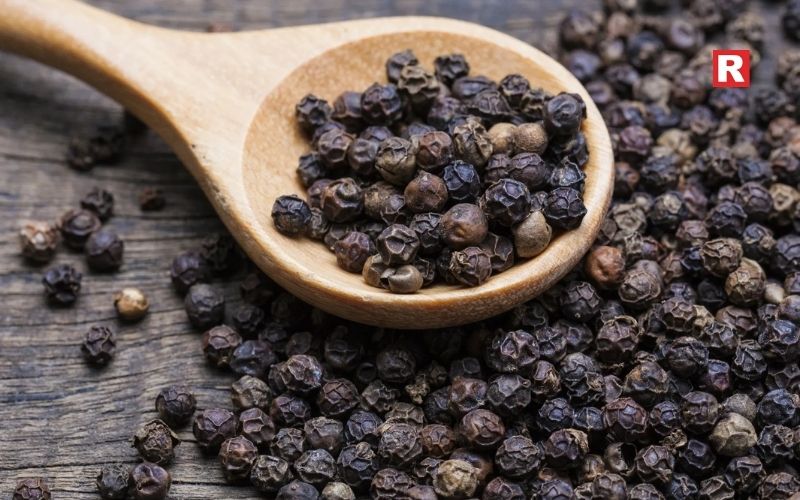
Originating from the Malabar Coast, Kerala, Europeans once called Black Pepper “black gold.” You could literally pay your rent with pepper. Pepper kept the Roman-Indian trade busy and brought the Portuguese to India in 1498. India still ships pepper everywhere in the world. People love it for its spice and its health perks.
Fun fact: Back in the Middle Ages, a sack of black pepper was as valuable as a chest of gold.
2. Cardamom – “The Queen of Spices”
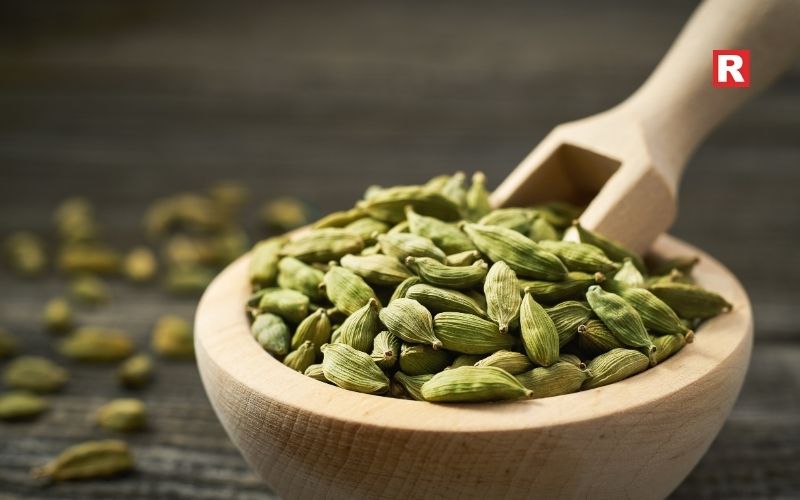
Originating from the Western Ghats in Kerala and Karnataka, Cardamom was second to black pepper in terms of popularity. Arabs traded it, Romans adored its sweet smell. People used it to make perfume, food, medicine, and many other things. India still grows and sells tons of cardamom, especially to the Middle East and Europe.
Fun fact: Ancient Greeks used cardamom in perfume and thought of it as a symbol of luxury and love.
3. Cinnamon – The Sweet Secret
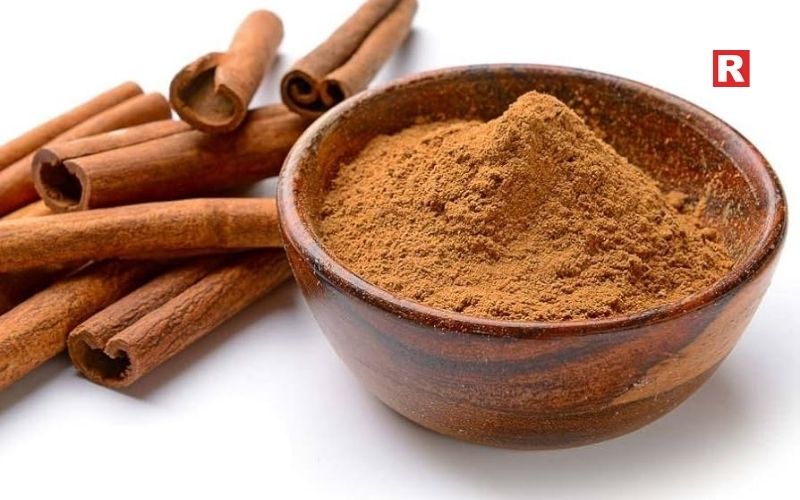
Cinnamon is native to Sri Lanka, but Indian ports moved it everywhere. Egyptians used it to embalm mummies. In fact, medieval Europe went nuts for the taste and smell of cinnamon. It was brought by Arabs into India and then sent on to the West. Even now, cinnamon is widely used in Indian desserts, chai, and spice mixes.
Fun fact: For centuries, traders lied about where cinnamon came from to keep prices sky-high.
Know more: The Secret Spice Box: Most Common Spices Chefs Can’t Live Without
4. Cloves – The Empire’s Spice
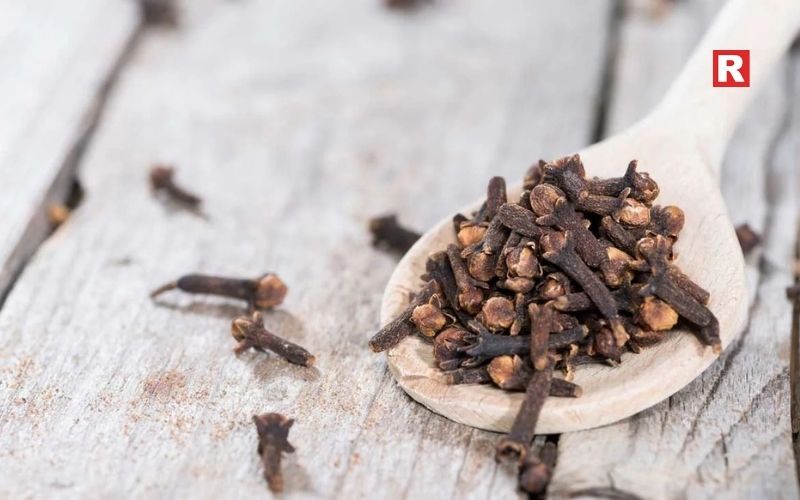
Native to the Spice Islands, Indonesia, the British spread cloves to India. It was used for many things, like keeping food fresh, and was used in medicine. Cloves helped spark European colonization in Asia. Now it is grown in Tamil Nadu and Kerala, and thrown into garam masala, biryani, and tea.
Fun fact: A handful of cloves could buy you a goat in 15th-century Europe.
5. Turmeric – The Golden Healer
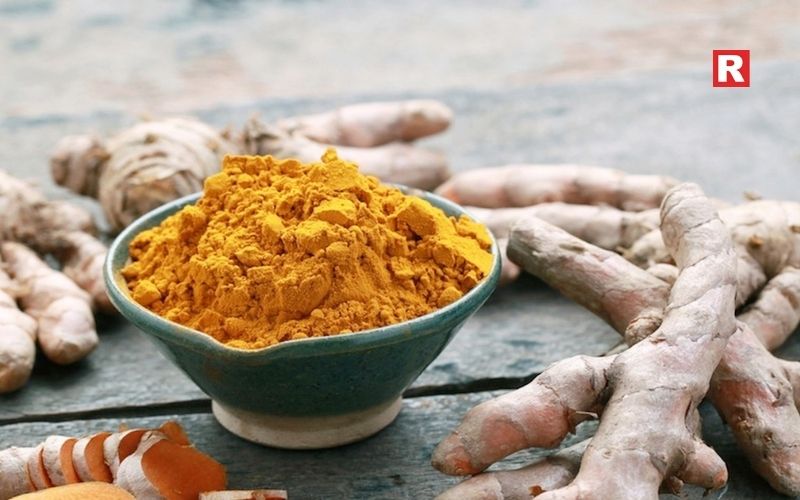
Native to India, Turmeric has been farmed for more than 4,000 years. It is used in medicine, food, and rituals. It was traded by Arab merchants in the past. It became a symbol of India’s healing power in the world. Even now, turmeric is a global superstar. It is used in lattes, supplements, and many more things.
Fun fact: India’s turmeric trade is worth billions, and the world still can’t get enough.
6. Ginger – The Ancient Traveler
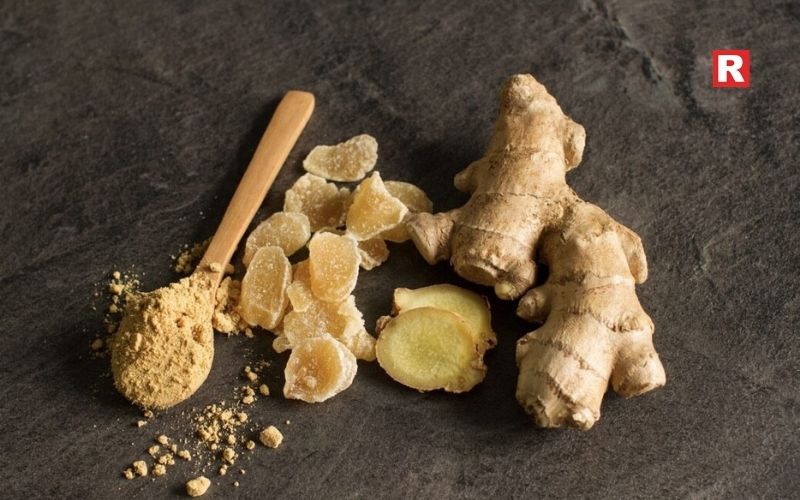
Originating from Southern India and Southeast Asia, ginger is widely used in tea and medicine nowadays. It was one of the first spices to make it big in global trade. Greeks and Romans used it for medicine. It was shipped to Europe as early as the 1st century AD. Now it’s everywhere, in food, teas, and even in wellness shots.
Fun fact: Queen Elizabeth I adored gingerbread so much that she made it a royal trend in England.
7. Nutmeg – The Spice That Caused Wars
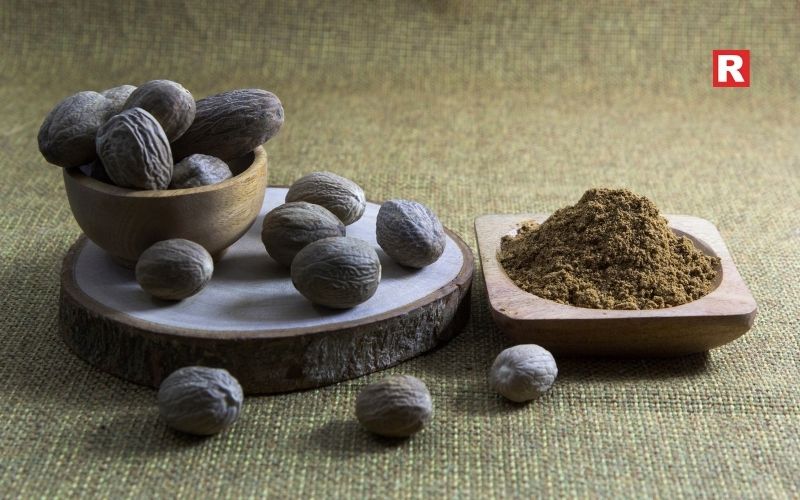
It was founded in the Banda Islands (Indonesia), but it passed through India on its way west. Europeans literally fought wars for control over the nutmeg islands in the past. It was so sought after that the Anglo-Dutch Treaty was created. And the Dutch traded New York for a nutmeg island. Now India grows nutmeg in Kerala, mixing it into desserts and spice blends.
Fun fact: In medieval times, nutmeg was so precious, people went to war for it.
What's new: Indian Spice Blends from Restaurant Chefs: Recipes, Techniques & Regional Masalas
8. Cumin – The Ancient Spice of Civilization
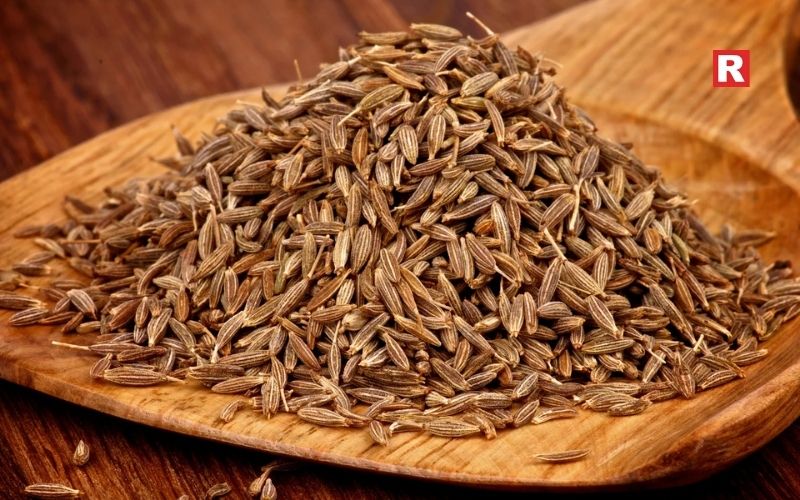
Cumin was founded in North India, and you’ll find it mentioned in old Vedic and Egyptian writings. People used it for everything from cooking, medicine, and even in the process of mummification. Traders moved cumin all over, especially through the Arab-Indian routes into Europe. These days, you’ll taste it in Indian curries, but it shows up in Mexican, Mediterranean, and Middle Eastern dishes too.
Fun fact: India now grows about 70% of the world’s cumin.
9. Fenugreek – The Humble Powerhouse

Fenugreek comes from the Mediterranean, but North India took a real liking to it and started growing tons. Ancient Egyptians and Greeks prized it for both its health benefits and its strong aroma. Over time, fenugreek became a staple in the spice trade, valued for food and herbal remedies. Today, it’s a must in Indian curries, pickles, and spice mixes.
Fun fact: “Methi” seeds are still used as a natural cure for digestive and diabetic ailments.
10. Saffron – The Red Gold of India
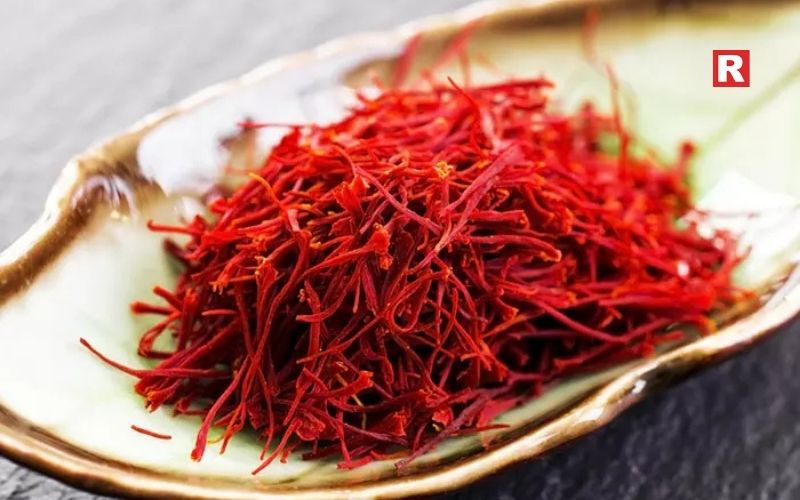
Saffron originally came to India from Persia and grows mainly in Kashmir. It’s famous as the world’s most expensive spice, mostly because harvesting it is such grueling work. Saffron was always a symbol of royalty and spirituality, and people traded it as far as Rome and Arabia. Now, you’ll find it in desserts, biryanis, perfumes, and traditional medicine.
Fun fact: It takes around 75,000 saffron flowers to produce just one pound of the spice!
Check out: 5 Indian Spices You Should Never Skip in Daily Cooking
Top 10 Vegan Street Foods in India Every Indian Loves
Economic and Cultural Impact of the Spice Trade
- Spices weren’t just things to buy and sell; they changed the world. They helped in the exchange of cultures, ideas, and economies.
- They made India incredibly rich in ancient times and set off the Age of Exploration, drawing Europeans to India’s shores.
- Indian spices turned up everywhere: pepper in Italian pasta, cinnamon in Arabian coffee, turmeric in wellness drinks worldwide.
- Cities like Calicut and Cochin became buzzing hubs where goods, cultures, and ideas collided.
- Spices even served as royal gifts, dowries, and tribute to conquerors.
- Today, India still leads, exporting over 45% of the world’s spices — a legacy thousands of years in the making.
Modern Spice Trade: India’s Continuing Legacy
India still tops the charts in growing, eating, and exporting spices.
- Top Producers: Kerala is famous for its pepper and cardamom, Rajasthan for cumin and coriander, and Kashmir for saffron.
- Key Export Markets: The biggest markets for spices are the U.S., Germany, Saudi Arabia, and the U.K
- Export Value: Spice exports bring in over $4 billion every year.
- Emerging Trends: These days, people want organic and sustainably sourced spices.
India’s traditional spice-growing regions are protecting their specialties with GI tags like Malabar Pepper and Alleppey Turmeric, keeping their heritage real and recognized.
Fascinating Facts About Indian Spices
- Spices were worth as much as gold or land in the past. Pepper and nutmeg were traded like currency.
- The word “spice” actually comes from the Latin for “special merchandise.”
- Indian blends like garam masala inspired all kinds of global seasoning mixes.
- For centuries, Arab traders kept the origins of these spices secret to keep their monopoly.
- The Portuguese colonized Goa mainly to corner the spice market.
Learn more: 10 Indo-Japanese Fusion Foods You Must Taste
From Ancient Bazaars to Global Markets
The story of Indian spices is really the story of how food and culture grew up together. From ancient trade routes to today’s kitchens, India’s spices have shaped the way the world eats. They aren’t just ingredients; they’re pieces of history and adventure. Every pinch of pepper, every strand of saffron, every burst of cardamom carries a story that started long ago in India’s fields. And the aroma still travels around the globe.

India’s connection with food runs deep. Every corner of the country tells a story through its street food — full of flavours, colours, and traditions. The aroma of spices, the sizzle of pans, and the buzz of local stalls capture the true spirit of Indian culture. Indian street food is truly special because of its natural inclination towards vegan ingredients. Most snacks are prepared with vegetables, grains, lentils, and spices, making them both wholesome and cruelty-free. From the spicy tang of chaats in Delhi to the crisp dosas in Chennai, every region offers a unique vegan experience.
Vendors across India have perfected the art of balancing taste and texture. Simple ingredients come together to create dishes that are affordable, nutritious, and bursting with local flavour. For those following a plant-based lifestyle, India is a paradise. Its street food scene proves that vegan meals can be rich, vibrant, and deeply satisfying. Whether it’s a quick snack or a hearty meal, India’s vegan street foods promise an authentic taste of the country — one bite at a time.
India’s Street Food—A Vegan Paradise
Indian cuisine has always been rooted in vegetables, grains, lentils, and spices — making it inherently plant-based. Many dishes that people enjoy daily are already vegan or can be easily made so by skipping dairy-based chutneys or ghee.
From the coconut-laced dishes of Kerala to the tangy chaats of Mumbai, vegan food isn’t a modern import — it’s been a part of Indian kitchens for generations. With the rise of conscious eating, street vendors are now adapting to vegan preferences by using oil instead of butter and curd-free chutneys, keeping the traditional flavours intact.
Explore Top 10 Vegan Street Foods in India
1. Pani Puri (Across India)
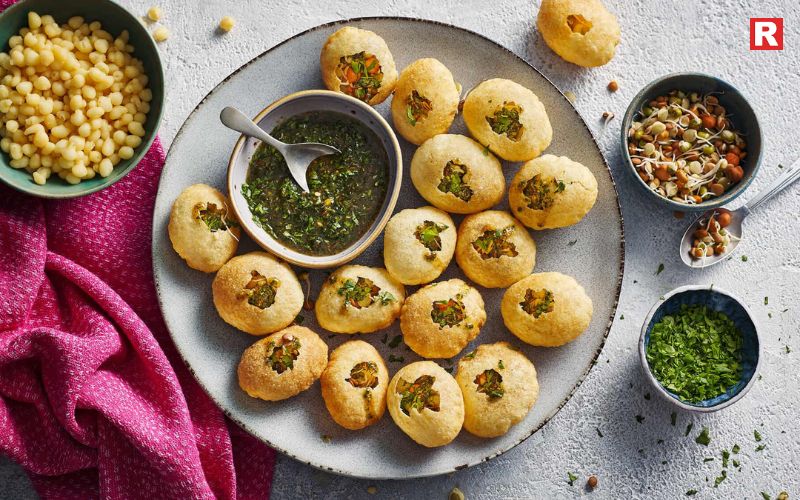
Crispy, hollow puris filled with spiced potato mash and tangy water — Pani Puri (also called Golgappa or Phuchka) is India’s most loved street snack. It’s light, spicy, and totally plant-based. Vendors across cities prepare different versions — Kolkata’s phuchkas use tamarind and black salt, while Mumbai’s Pani Puri has a hint of sweetness. Just ensure the puri water is made without hing (asafoetida with wheat) if you’re strictly vegan.
2. Vada Pav (Mumbai)
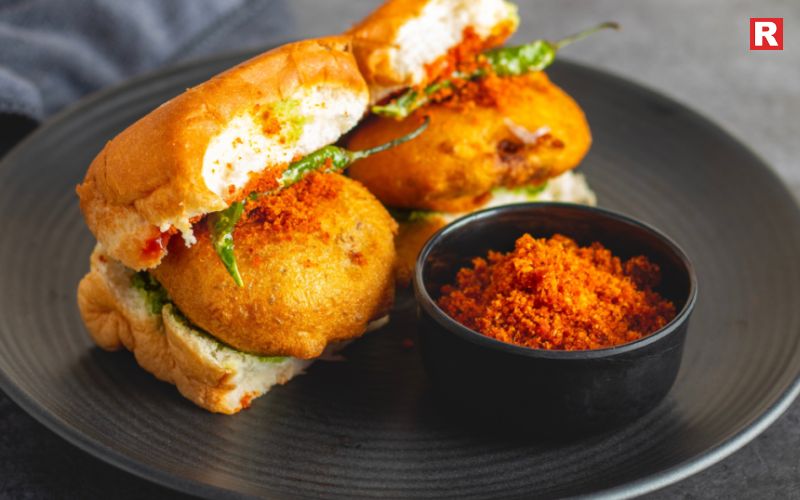
Known as Mumbai’s answer to the burger, Vada Pav is a spicy potato fritter tucked inside a pav (bun), served with chutneys and fried chillies. It’s simple, filling, and naturally vegan when made without butter on the bun. The street stalls outside Dadar and CST stations serve some of the city’s most authentic vada pavs — a perfect blend of crunch, spice, and warmth.
Read more: 8 Famous Vegetarian Dishes of Uttar Pradesh and Their Timeless Legacy
5 Cities That Serve the Best Non-Vegetarian Street Food
3. Chole Kulche (Delhi & Punjab)

A North Indian staple, Chole Kulche is a protein-rich vegan dish made with spicy chickpeas and soft flatbreads. It’s often topped with onions, coriander, and lemon juice for extra zest. Street vendors in Delhi’s Chandni Chowk or Amritsar’s Hall Bazaar are known for their signature recipes that use pure plant-based ingredients. It’s wholesome, hearty, and bursting with Punjabi flavours.
4. Dabeli (Gujarat)
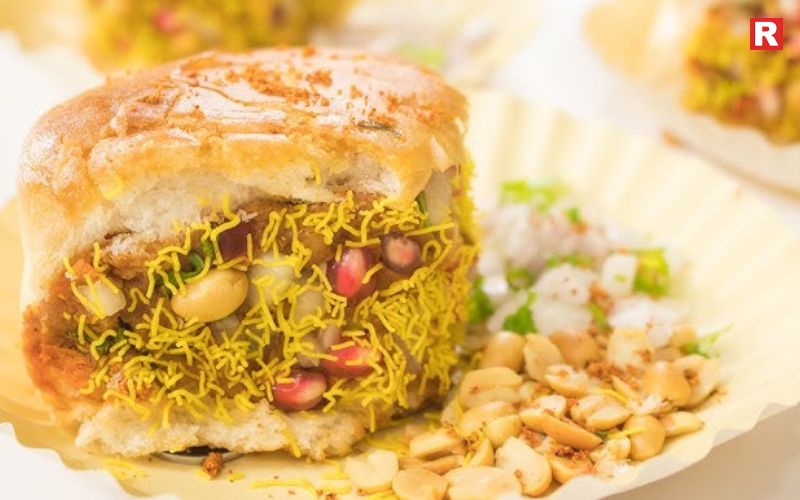
Originating from Kutch, Dabeli is a flavour-packed street snack made with spiced potato mash, peanuts, chutneys, and pomegranate seeds stuffed inside a soft pav. The sweet and spicy balance makes it unique. It’s completely vegan and a must-try when visiting Ahmedabad or Surat. Vendors prepare it on hot tavas, toasting the buns with oil instead of butter for that perfect crisp.
5. Masala Dosa (South India)

Masala Dosa is one of India’s most famous vegan-friendly dishes. Made from a fermented batter of rice and lentils, it’s filled with a spiced potato masala and served with coconut chutney and sambar. This South Indian classic is not only delicious but also healthy and gluten-free. Bengaluru, Chennai, and Kochi offer some of the best dosas — crisp, golden, and fragrant with curry leaves.
Know more: Pani Puri Has Different Names in Different Indian States—Know Them All
6. Bhel Puri (Mumbai)
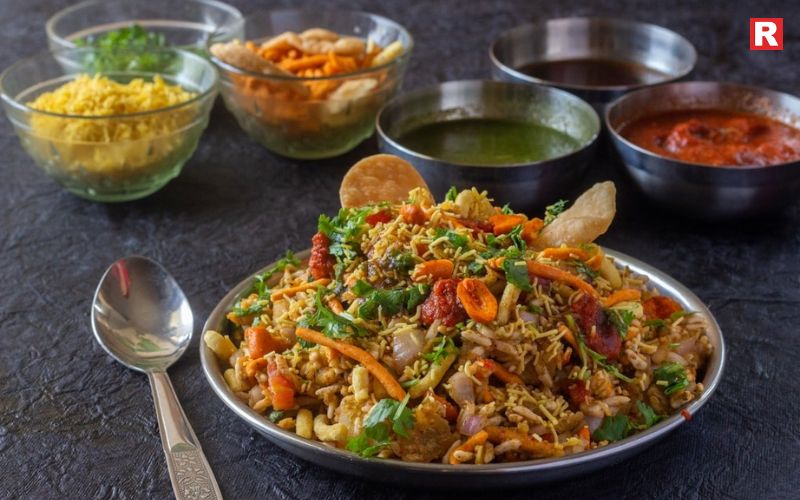
Light, tangy, and crunchy — Bhel Puri is the ultimate Indian street snack. Made from puffed rice, chutneys, onions, tomatoes, and sev, it’s a burst of flavours in every bite. It’s completely vegan and easy to find at every beachside stall in Mumbai. The best part is that it’s low in oil, making it a guilt-free indulgence for plant-based eaters.
7. Aloo Tikki Chaat (North India)
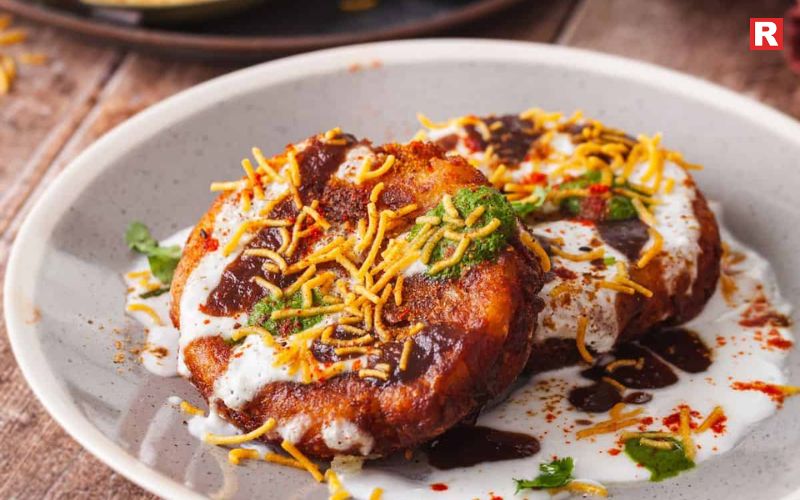
Aloo Tikki Chaat is a North Indian favourite that combines crisp potato patties with chickpeas, tangy chutneys, and spices. It’s rich in texture and flavour — spicy, sweet, and slightly sour. In Delhi, Lucknow, and Kanpur, you’ll find vendors who add pomegranate seeds and coriander for freshness. Just request the vendor to skip curd and ghee, and you have a completely vegan treat.
Also check: 5 Foods to Avoid for Better Cholesterol
8. Idli with Sambar (South India)
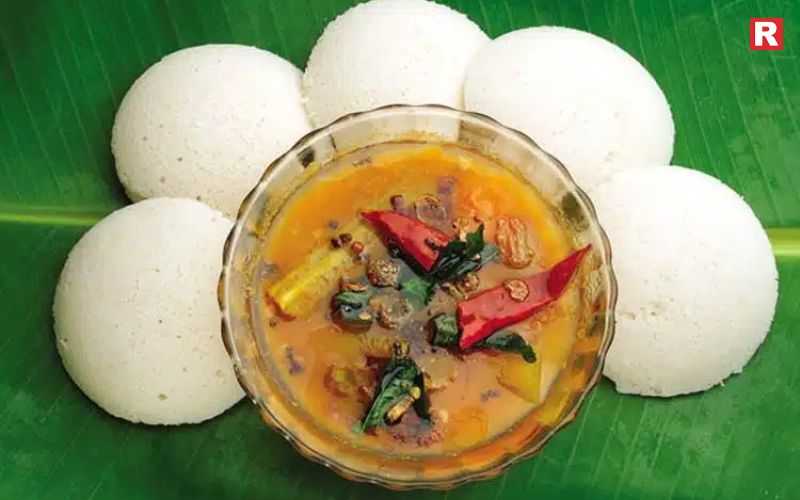
Soft, steamed rice cakes known as idlis are a breakfast staple in South India. When paired with spicy lentil sambar and coconut chutney, it’s a wholesome, protein-rich vegan meal. It’s light yet filling, and you’ll find it on almost every street corner in Tamil Nadu and Karnataka. Most authentic stalls use coconut oil and plant-based ingredients, keeping it perfectly vegan.
9. Momos (Delhi, Sikkim, Darjeeling)
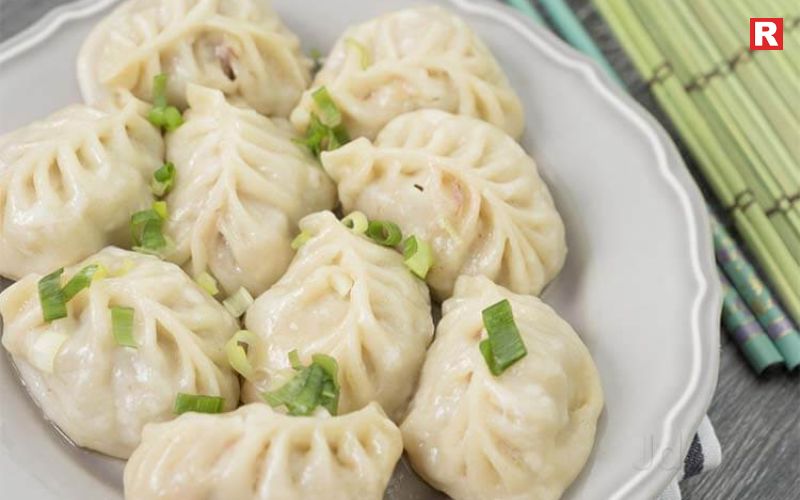
A Tibetan influence on Indian street food, momos are small steamed dumplings that have taken over Indian cities. The vegetable version, stuffed with cabbage, carrot, and onions, is entirely vegan. Just make sure to skip mayonnaise-based dips. In Delhi, the Tibetan colony at Majnu ka Tilla serves some of the best vegan momos with spicy red chutneys.
10. Poha (Maharashtra & Madhya Pradesh)
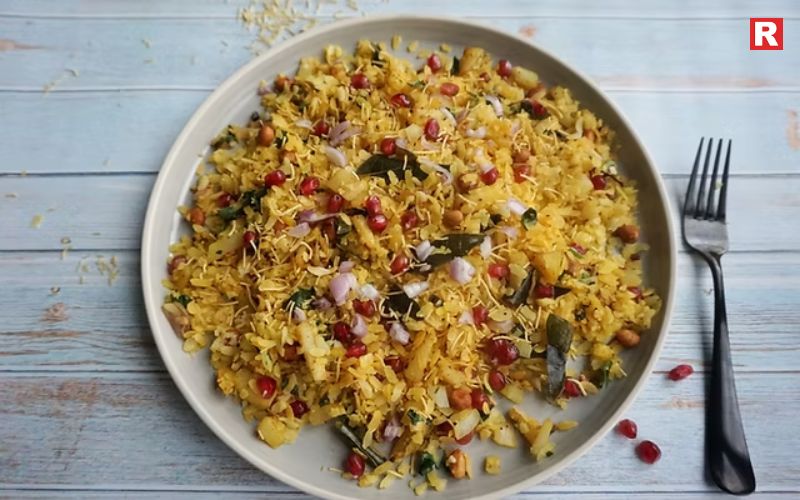
Poha is a light, comforting dish made from flattened rice, turmeric, mustard seeds, curry leaves, and peanuts. It’s often garnished with lemon and coriander. Found widely across Indore and Pune, Poha is both nutritious and vegan. It’s commonly served for breakfast or as a quick snack and pairs perfectly with hot masala chai made with plant-based milk.
Why Indian Street Food is Perfect for Vegans
Indian street food has always celebrated vegetables, grains, and pulses — making it ideal for those following a plant-based lifestyle. According to recent reports, India’s vegan and plant-based food market is projected to cross USD 100 million by 2026, showing how fast people are embracing conscious eating.
Street vendors have also started adapting by using refined oil instead of ghee, avoiding curd in chutneys, and replacing butter with vegan-friendly options. In cities like Mumbai and Bengaluru, vegan food trucks and plant-based pop-ups are becoming popular, introducing sustainable street eating experiences.
Tips to Eat Vegan on Indian Streets
- Ask before you order: Some vendors might use butter or curd — always request plant-based substitutes.
- Choose coconut-based chutneys: They’re naturally vegan and add authentic flavour.
- Avoid creamy teas or lassi: Go for coconut water, lemon soda, or black tea instead.
- Carry reusable cutlery: It’s eco-friendly and aligns with the vegan philosophy of sustainability.
Check more: Top 5 States With the Spiciest Food in India
10 Different Types of South Indian Rice Dishes
5 Tasty Coconut Dishes You Can Try at Home
India’s Vegan Street Food Revolution
The charm of Indian street food lies in its honesty and simplicity. Many of these dishes are already plant-based, making them perfect for a growing vegan community. Across India, street food reflects the flavours of each region. The tangy chaats of Delhi, the coconut-rich snacks of Chennai, and the spicy treats of Mumbai show how plant-based eating is part of everyday life. Vendors rely on age-old recipes, passed down through generations, proving that good food doesn’t need meat or dairy to be delicious. Every bite carries tradition, creativity, and heart. As veganism rises, India’s street food culture stands ready to inspire the world. It reminds everyone that great taste comes from simple ingredients, skill, and the perfect touch of spice — not from excess, but from authenticity.

Indo-Japanese fusion is a wild experience in the best way. It’s one of those food trends that feels like it wouldn’t work, but once you try it, you get hooked. Think of bold Indian spices hanging out with delicate, umami-packed Japanese flavors. The result is dishes that are gutsy, balanced, and full of surprises. Like sushi with tandoori in the middle. Naan slathered in miso butter. This is what happens when two food worlds crash together and create something entirely different.
This trend is exploding in Tier-1 cities like Mumbai, Delhi, and Bengaluru. Chefs there are just going for it, mixing, matching, and inventing dishes that stay true to both roots but taste totally new. If you like eating something unique, here are ten Indo-Japanese fusion dishes you’ve got to try.
Read more: Top 6 Japanese Dishes to Try for an Authentic Taste of Japan
A Brief History of Indo-Japanese Fusion: When Masala Met Miso
Indo-Japanese fusion came to life when curious chefs and food lovers started mixing things up through travel, trade, and just plain love for trying new flavors. Indian cooks took a liking to Japan’s minimalist style but didn’t hold back on the spices. Meanwhile, Japanese chefs got bold, folding Indian curry flavors into their own dishes. As food scenes exploded in places like Mumbai, Tokyo, and Singapore, fusion dining took off. People everywhere wanted to taste something new. Funny thing is, Indian and Japanese food aren’t as different as they seem. Both care deeply about balance, freshness, and being thoughtful in the kitchen. What started as a wild experiment is now a tasty bridge between the two cultures. You get a little bit of artistry from both sides, all on one plate.
Ten Dishes With The Best Umami Flavor
1. Tandoori Sushi Rolls
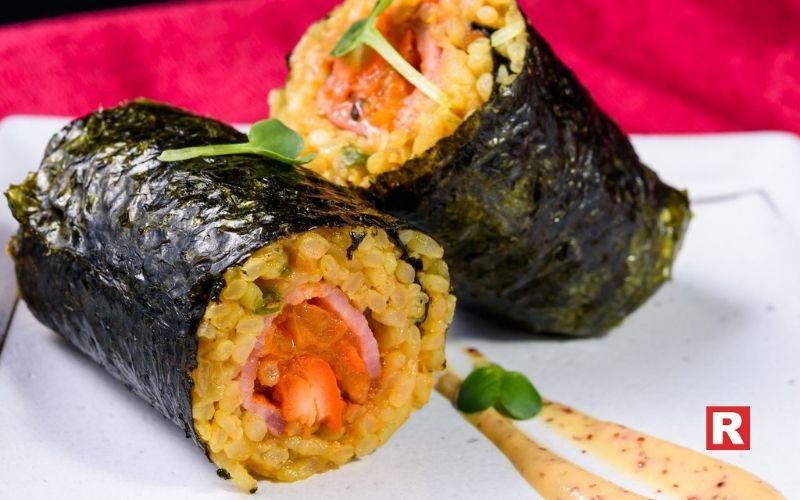
Sushi’s all about careful technique and subtle flavors. But add in some Indian flavors, and suddenly it gets a lot more exciting. Tandoori Sushi Rolls swap out the usual raw fish for things like paneer tikka, chicken straight from the tandoor, or veggies cooked with Indian spices. The rice isn’t just plain either: it’s got hints of cumin or saffron. And forget soy sauce; you’re dipping these in mint chutney. Every bite is this mix of soft rice, smoky fillings, and a punch of flavor. It’s Japan’s cool elegance meeting India’s fire.
Know more: Inja: A Marriage of Indian and Japanese Flavors
2. Miso Butter Naan

Naan is already a crowd-pleaser, but add miso to the mix and you take it up a notch. Miso Butter Naan is exactly what it sounds like: classic naan, but brushed with a combo of butter, garlic, and white miso paste before it hits the tandoor. What you get is a bread that’s crisp outside, pillowy inside, and packed with savory, earthy flavor. Pair it with a mild curry or some yakitori skewers. Either way, you’ll want to have a second plate, surely. Want to try it at home? Just stir a teaspoon of miso paste into your melted butter before brushing it on the naan. Easy, right?
3. Curry Ramen Bowl
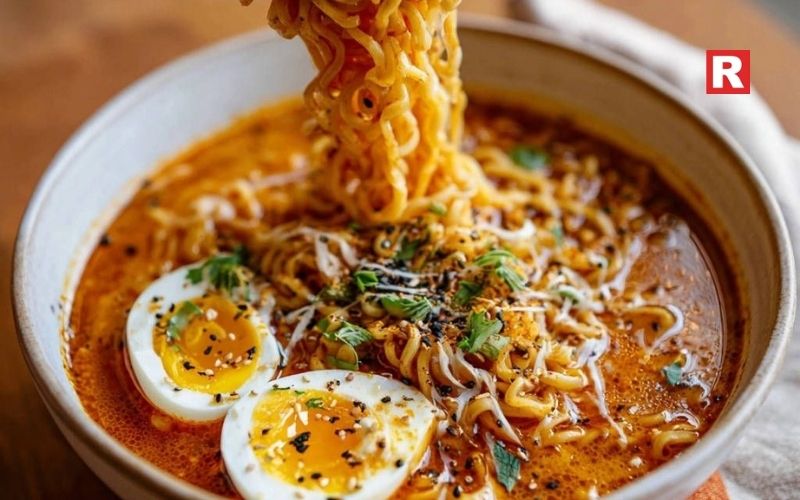
This dish is a hug in a bowl. Curry Ramen is what happens when Indian comfort food meets Japanese noodles. Instead of a clear broth, the soup is thick and spiced up with turmeric, cumin, and coriander. You know, all the good curry ingredients. Add in noodles, boiled eggs, and sautéed veggies, and you’ve got a bowl that’s rich and filling but still slurpable. Some spots even make veggie versions with coconut milk or paneer. It’s the perfect dinner for a chilly night.
4. Wasabi Samosas

Here’s a fusion you can eat with your hands. Wasabi Samosas seem like a classic Indian street snack, but then the addition of wasabi shakes things up. The potato filling gets a blast of wasabi, plus edamame and spring onions. So you bite in, and it’s hot, aromatic, and just a little wild. Dip them in soy-tamarind sauce for that spicy-tangy-salty trilogy. Why does it work? Wasabi’s heat hits like Indian chili; it's just a different kind of heat.
5. Teriyaki Paneer Skewers
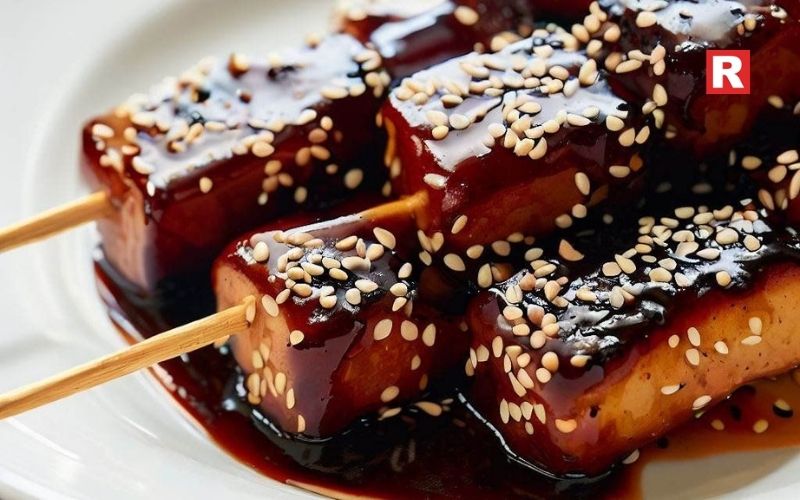
If you’re into grilling, then this dish is for you. Take paneer, marinate it in a glaze made from soy sauce, ginger, garlic, honey, and sesame, then grill it until it’s charred and sweet. Add peppers, mushrooms, and spring onions for crunch, and finish with a sprinkle of sesame seeds. Serve with a miso chutney or spicy mayo. This will make it a total flavor bomb.
6. Masala Onigiri
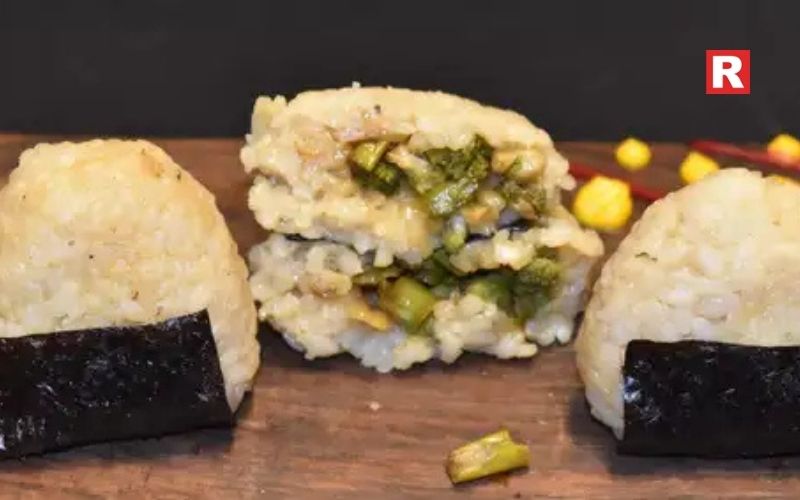
Onigiri is classic Japanese comfort food, but let’s give it an Indian remix. Fill these rice balls with spicy paneer bhurji, chicken keema, or aloo masala, then wrap them in nori. You get soft rice and the warmth of Indian spices. Each bite is soft, flavorful, and balanced. If you want to take it to another level, then mix a little garam masala into the rice or dip it in mint chutney. Here’s your Indo-Japanese style comfort food.
What's new: What is Kimchi? Top Veg Kimchi You Can Try at Home
7. Sushi Dosa
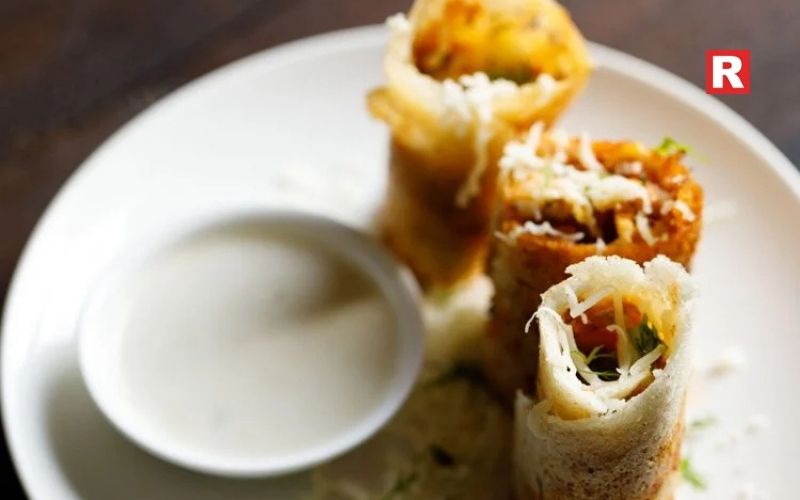
Sushi Dosa uses the simple South Indian dosa and changes it into something you never saw coming: a Japanese-inspired treat that’s as fun to look at as it is to eat. Imagine this: thin, crispy dosa rolled up around tangy pickled veggies, creamy avocado, wasabi mayo, maybe some tofu. Cut them up just like sushi, then dip them in soy sauce or even sambar. It’s light, fun to eat, and honestly, kind of irresistible. Making it perfect for brunch with friends or for showing off on Instagram. Why does it work? Both dosas and sushi use fermented batters and rice, so blending the two doesn’t feel illegal.
8. Tempura Pakoras
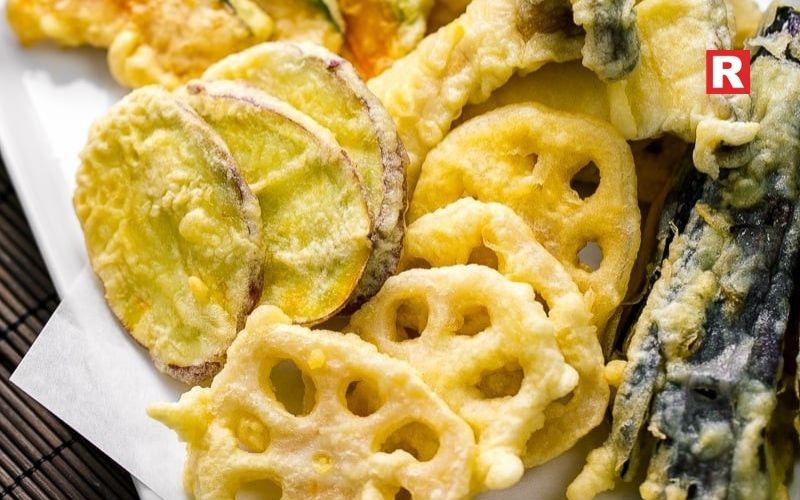
If you love pakoras and tempura, then this one’s for you. Tempura Pakoras swap the usual gram flour for tempura batter, turning classic Indian veggies like onion, spinach, and paneer into lighter, crispier bites. Serve them up with a soy-tamarind dip or a punchy wasabi chutney. One bite and you get this golden crunch that somehow manages to taste both familiar and brand new. To get the best taste, keep the batter ice-cold. That’s the Japanese trick for getting that airy, signature crisp.
9. Green Tea Kheer
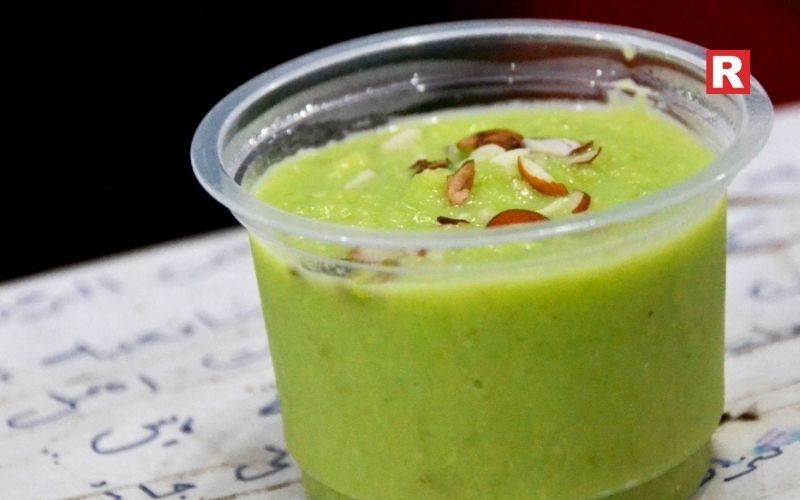
Desserts in this fusion game tend to be subtle and elegant, and Green Tea Kheer is the poster child for this. Take the classic Indian rice pudding, add some matcha powder, and you get something silky and a little earthy-sweet that stands out as a masterpiece. The matcha’s mild bitterness balances out the rich condensed milk and cardamom, making every spoonful feel both cozy and a little mysterious. If you want to make it extra special, then sprinkle some toasted almonds or sesame seeds on top for that nutty Japanese vibe.
Check out: 5 Veg Ramen You Can Try at Home
7 Korean Veg Dishes to Try on Your Next Visit
10. Wasabi Chaat
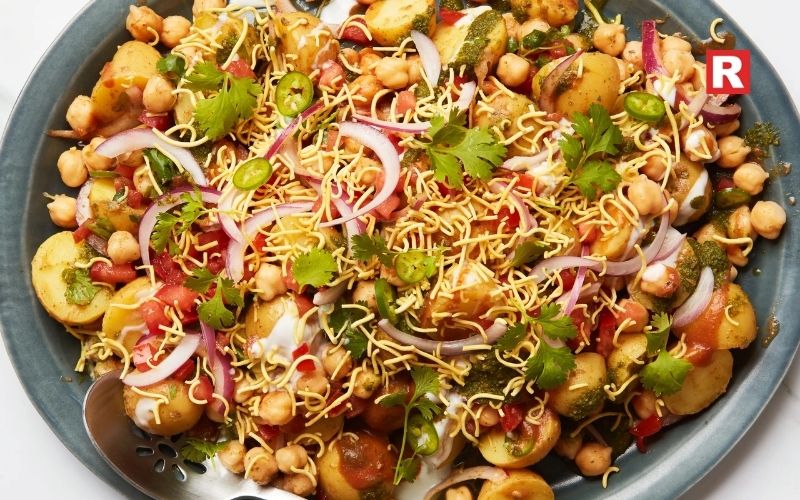
Wasabi Chaat is where Indian street food gets a wild, upscale twist. Think of all the usual chaat ingredients like aloo, bhel, and tangy chutneys, but now add wasabi peas, soy-glazed peanuts, and a dusting of seaweed flakes. The wasabi smacks you awake, the crunch keeps things interesting, and suddenly, you’re eating something you’ve never tasted before. It’s fiery, bold, and honestly, pretty unforgettable. If you’re in Delhi or Pune during a food festival, keep an eye out for fusion cafes that love to get creative.
Signature Ingredients That Make Indo-Japanese Fusion Work
The magic of Indo-Japanese fusion comes from clever pairings that just click.
- Garam Masala + Miso Paste: Deep, umami warmth.
- Paneer + Tofu: Soft, protein-rich goodness.
- Basmati Rice + Sushi Rice: Fragrant meets sticky.
- Ghee + Sesame Oil: Nutty, aromatic base.
- Tamarind + Soy Sauce: Sweet, salty, and tangy all at once.
Create Your Own Indo-Japanese Fusion at Home
- It all starts with balancing the ingredients. Blend strong Indian flavors with the gentle textures of Japanese cooking.
- Swap in your ingredients, try paneer instead of tofu, use soy sauce instead of salt, or give wasabi a chance where you’d usually go for green chili.
- Mix Indian classics like naan, curry, or samosas with a bit of Japanese flair. Like miso, tempura batter, or even sushi rice.
- Keep your plating simple and clean, just like the Japanese do. Let those colors and fresh ingredients stand out.
- For example, you can make a quick Miso Masala Stir-Fry, a Wasabi Paneer Wrap, or a Curry Ramen Bowl. These are easy, fun, and definitely not boring recipes.
Why Indo-Japanese Fusion Just Works
At first, Indian and Japanese food seem like total opposites: one’s all about bold flavors and layers, the other’s subtle and elegant. But if we take a closer look, they both share three big ideas.
- Respect for Ingredients: First, there’s huge respect for ingredients. Fresh veggies, spices, you name it; they both care deeply about quality.
- Balance of Flavors: Indian masalas and Japanese miso or soy all chase harmony and balance in flavor.
- Ritual and Mindfulness: Whether it’s a Japanese tea ceremony or an Indian thali, food is treated as an art, something to be savored and respected.
When these ideas come together, you get a fusion that actually makes sense. Meaning dishes that are new but still feel true to where they came from.
Learn more: 5 Markets in India Famous for Spices
The Magic of Fusion
Indo-Japanese fusion is more than just a food trend. It’s a story of two cultures sharing ideas and creativity. It proves that totally different flavors can actually work together, as long as you balance them with care.
Whether it’s tandoori sushi or green tea kheer, every dish mixes contrast with harmony, spice with subtlety, heat with umami, and old traditions with fresh ideas.
So next time you’re in the kitchen or out at a new spot, don’t be afraid to mix miso and masala. Sometimes, the best flavors happen when boundaries disappear.

This traditional dish has been made for centuries and continues to hold a special place in Korean homes. Over time, it has travelled beyond borders and reached kitchens around the world — including India, where people are discovering its rich taste and health benefits. Made by fermenting vegetables with salt, chili flakes, garlic, and ginger, kimchi delivers a unique mix of spicy, tangy, and umami flavors. The fermentation process not only enhances its taste but also makes it rich in probiotics, which are good for digestion and immunity.
Traditionally, kimchi includes fish sauce or shrimp paste for depth of flavor. However, with changing food preferences, vegetarian and vegan versions are becoming widely popular. These plant-based varieties use soy sauce, seaweed stock, or miso paste instead of seafood. For those who enjoy bold and refreshing flavors, vegetarian kimchi offers the perfect balance of taste and health. It brings a touch of Korea’s culinary spirit into every bite and is easy to make and enjoy at home.
What is Kimchi?
Kimchi is a traditional Korean fermented dish made by salting vegetables and seasoning them with chili flakes, garlic, ginger, and spring onions. The most common base is napa cabbage or radish, which ferments over several days to create a deeply flavorful dish. The fermentation process is what makes kimchi special. When vegetables are salted and stored in airtight containers, natural bacteria called lactobacillus begin to break down sugars into lactic acid. This gives kimchi its signature tangy and slightly sour taste while also making it rich in probiotics — the same friendly bacteria found in yogurt.
In Korean households, making kimchi is more than cooking — it’s a ritual called Kimjang, where families gather in late autumn to prepare large batches together. This tradition represents community, togetherness, and the importance of sharing food that lasts through the cold months.
Health Benefits of Kimchi
Beyond its amazing taste, kimchi is a powerhouse of nutrition. It is low in calories and packed with fiber, vitamins, and antioxidants. Some key benefits include:
- Boosts gut health: Kimchi is probiotic-rich, which helps in maintaining healthy digestion and improving metabolism.
- Enhances immunity: The combination of garlic, ginger, and chili provides natural immune-boosting properties.
- Improves heart health: Regular consumption can help lower cholesterol levels due to its high fiber and low-fat content.
- Good for skin: Probiotics can help clear skin and reduce inflammation.
Adding a small portion of kimchi to your daily meals can do wonders for both taste and health.
Why Veg Kimchi is Gaining Popularity
In Korea, most traditional kimchi varieties include fish sauce, anchovy paste, or shrimp brine for flavor. However, with the growing demand for vegetarian and vegan diets across the world — especially in India — plant-based versions have become extremely popular. Vegetarian kimchi substitutes these animal-based ingredients with natural alternatives like soy sauce, seaweed stock, or miso paste. These add the same depth of flavor and umami richness without using any seafood.
Veg kimchi retains all the essential qualities of traditional kimchi — it’s crunchy, spicy, slightly sour, and full of probiotics. It’s also versatile and goes well with Indian meals like rice, noodles, parathas, or even sandwiches. For Indians who prefer vegetarian food but still want to explore authentic global dishes, veg kimchi offers the perfect fusion of Korean tradition and plant-based living.
Read more: 7 Korean Veg Dishes to Try on Your Next Visit
5 Cities That Serve the Best Non-Vegetarian Street Food
Find Top Veg Kimchi You Can Try at Home
1. Napa Cabbage Kimchi (Baechu Kimchi)
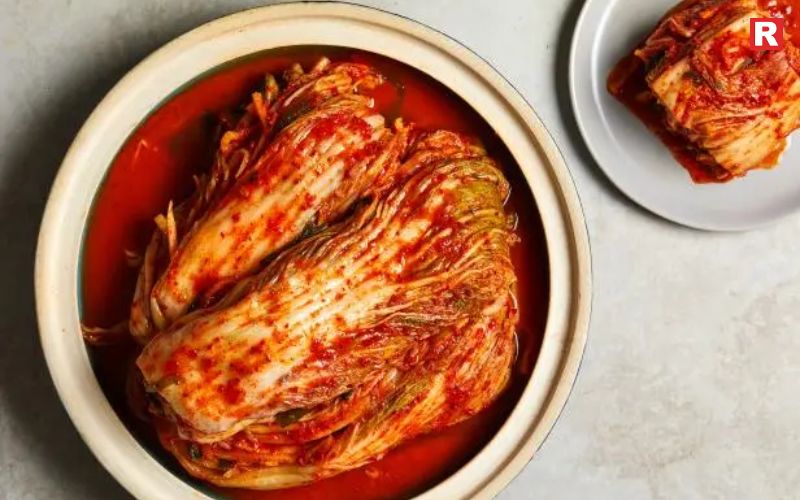
This is the most popular and widely eaten type of kimchi. It uses napa cabbage leaves coated in a spicy paste made from chili powder, garlic, ginger, and soy sauce. The cabbage softens as it ferments, creating a delicious balance of crunch and tang. It’s perfect as a side dish or mixed with fried rice.
2. Radish Kimchi (Kkakdugi)

Cubed radish kimchi is crisp, juicy, and refreshing. The radish absorbs the spice paste beautifully and gives a sharp, peppery bite. It pairs well with soups, porridge, or rice dishes. This variety ferments faster and is ideal for those who prefer less sour flavors.
3. Cucumber Kimchi (Oi Sobagi)
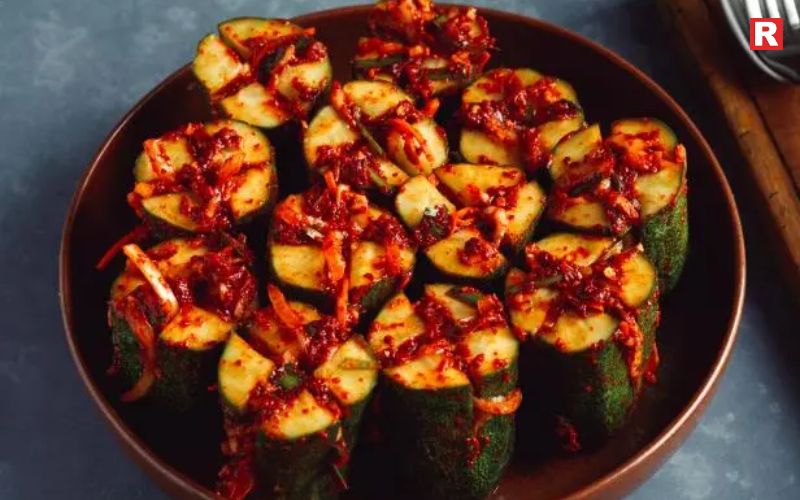
Cucumber kimchi is a favorite during the summer months. The cucumbers are sliced and stuffed with a spicy-sweet filling made of chili flakes, garlic, and scallions. It’s cooling, light, and ready to eat within a day or two — a great option for beginners.
Know more: 5 Veg Ramen You Can Try at Home
4. Green Onion Kimchi (Pa Kimchi)
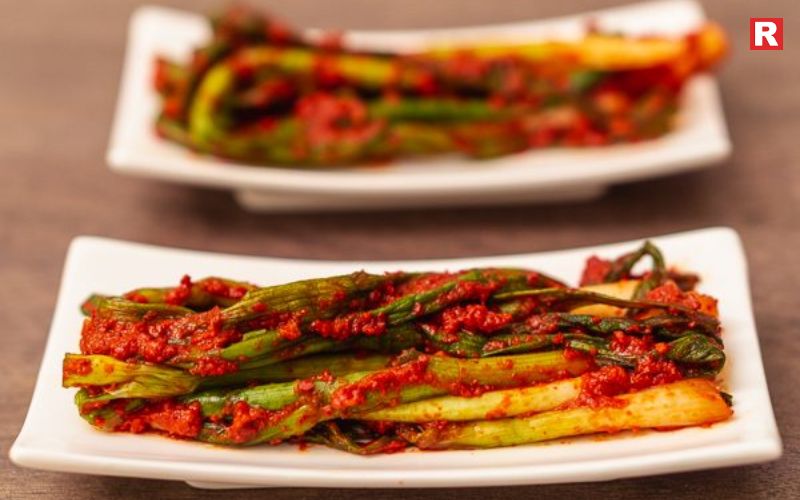
This kimchi uses whole green onions seasoned with chili paste, soy sauce, and sesame seeds. It has a bold, aromatic flavor that enhances savory dishes like Korean pancakes or rice bowls. It’s slightly spicy and adds a punch of flavor to any meal.
5. Carrot and Cabbage Kimchi
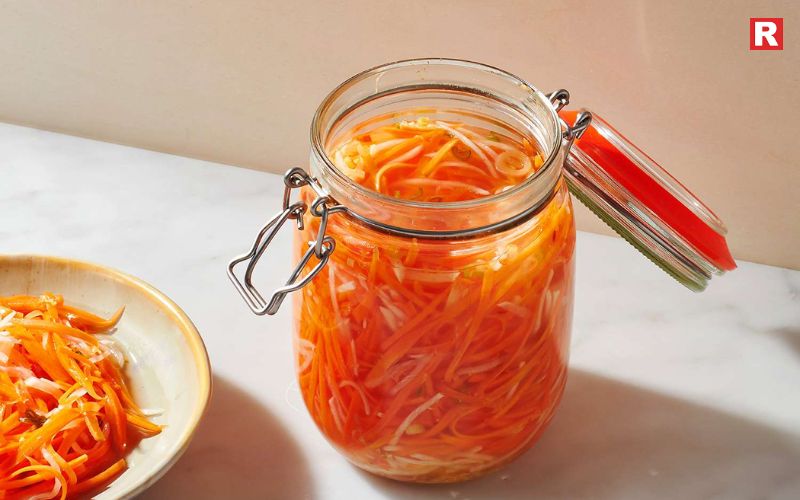
For those new to kimchi, this version is mild and easy to make. It combines shredded carrots and cabbage with a light chili-garlic paste. The texture stays crunchy, and the flavor is less pungent, making it a great fit for Indian taste buds.
6. Beetroot Kimchi
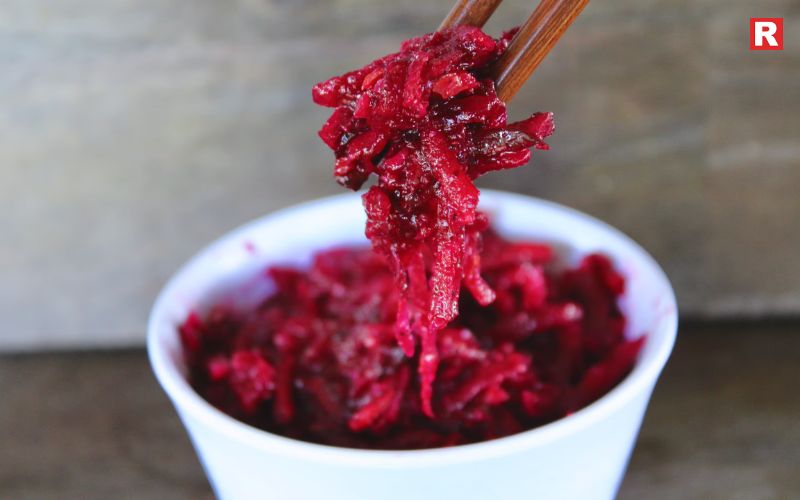
If you like experimenting, beetroot kimchi is a must-try. It’s visually striking, earthy, and slightly sweet. The beetroot’s natural sugars enhance fermentation, giving the kimchi a vibrant pink hue and a delicious tang.
Tips to Make Kimchi at Home
If you’re planning to make veg kimchi at home, keep these simple tips in mind for the best results:
- Use non-iodized salt: Iodine can interfere with fermentation, so always use sea salt or rock salt.
- Use clean glass jars: Fermentation works best in airtight, sterilized glass containers.
- Ferment at room temperature: Leave your kimchi at room temperature for 1–3 days before refrigerating it.
- Taste daily: The longer it ferments, the tangier it becomes. You can stop the process once you reach your preferred flavor.
- Avoid contamination: Always use clean, dry utensils to scoop kimchi. This prevents spoilage.
Once refrigerated, kimchi can last for several weeks or even months. The flavor continues to develop, becoming deeper and more complex over time.
How to Enjoy Veg Kimchi
Kimchi is incredibly versatile. You can eat it as a side dish, mix it into recipes, or use it as a flavor enhancer. Here are a few ways to include it in your meals:
- As a side dish: Serve it alongside rice, noodles, or curries to add a tangy contrast.
- In fried rice or ramen: Mix chopped kimchi into your stir-fried rice or noodles for a spicy twist.
- In wraps or sandwiches: Use kimchi as a filling for wraps, tacos, or grilled sandwiches.
- With Indian dishes: Pair it with parathas, khichdi, or dal-chawal for an exciting fusion meal.
- In soups and stews: Add kimchi to broth-based soups for a rich, sour depth of flavor.
The possibilities are endless, and once you start using kimchi regularly, it can easily become a staple condiment in your kitchen.
Also check: 8 Famous Vegetarian Dishes of Uttar Pradesh and Their Timeless Legacy
Your Veg Treat!
Kimchi is not just a dish; it’s an experience that connects you to Korean heritage while offering remarkable health benefits. Its spicy, tangy, and aromatic notes make it one of the most exciting foods to experiment with at home. For Indians exploring vegetarian and vegan diets, veg kimchi brings together the best of both worlds — global flavor and plant-based goodness. Whether you try the classic napa cabbage version or go creative with beetroot or cucumber, each type offers a refreshing burst of taste and nutrition. So the next time you crave something different yet healthy, try making your own batch of vegetarian kimchi. It’s simple, delicious, and a flavorful way to add a Korean twist to your everyday meals.

There’s something magical about a hot bowl of ramen. The slurp of noodles, the warmth of broth, and the mix of flavors make it one of the world’s most comforting dishes. Once known mainly for its meat-based broths, ramen has now found a vegetarian identity that’s equally rich and satisfying. In India, vegetarian ramen has become a popular comfort food among those who love Asian cuisine. Many home cooks are trying their hands at creating their own versions using local ingredients and simple techniques. The idea is to capture the same warmth and flavor of traditional ramen, without using meat.
The best part is that making ramen at home is easier than it looks. With the right noodles, vegetables, and spices, anyone can prepare a wholesome bowl of veg ramen. From a creamy miso broth to spicy garlic or coconut curry bases, there are endless ways to customize it. Here are five delicious vegetarian ramen recipes that combine taste, comfort, and nutrition — perfect for anyone looking to enjoy an authentic ramen experience right at home.
Here're 5 Veg Ramen dishes You Can Try at Home
1. Classic Miso Veg Ramen

The heart of Japanese comfort food, miso ramen is all about depth and balance. This version replaces the meat-based broth with a flavorful mix of miso paste and vegetables, resulting in a creamy, umami-rich base. Start by sautéing garlic and ginger in sesame oil. Add vegetable broth and miso paste, stirring until it blends smoothly. Add mushrooms, tofu, and your favorite veggies. Simmer gently to let the flavors come together. Cook the noodles separately, then combine them with the broth. Top with spring onions and nori for that authentic Japanese touch. The creamy miso base makes this ramen deeply satisfying. It’s nourishing, warm, and perfect for cozy evenings when you crave something hearty yet light.
Ingredients:
- Miso paste (preferably a mix of red and white)
- Tofu cubes
- Shiitake or button mushrooms
- Spring onions
- Noodles (ramen or whole wheat)
- Seaweed (optional)
2. Spicy Garlic Ramen with Tofu

For those who love bold, fiery flavors, spicy garlic ramen is a must-try. This recipe takes inspiration from Japanese street-style ramen and adds an Indian touch with spice and aroma. Infuse sesame oil with minced garlic and chili flakes to create a spicy base. Add soy sauce and vegetable broth, then toss in tofu cubes and noodles. Adjust the spice level to your liking. Garnish with spring onions for freshness. Prepare your own chili oil by slowly heating chili flakes, garlic, and sesame seeds in oil. This adds a deep, smoky flavor to your ramen. Every bite is full of warmth, spice, and texture. It’s an energizing bowl that pairs perfectly with cold evenings or rainy afternoons.
Ingredients:
- Garlic (lots of it!)
- Chili oil
- Soy sauce
- Sesame oil
- Tofu cubes
- Noodles
- Spring onions
Read more: 7 Korean Veg Dishes to Try on Your Next Visit
5 Tasty Coconut Dishes You Can Try at Home
3. Coconut Curry Veg Ramen
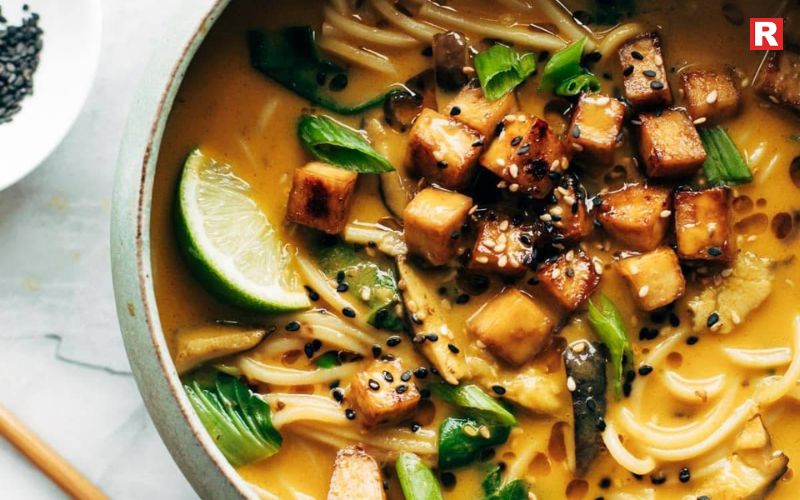
This fusion ramen brings together the comfort of Japanese noodles and the spice of Indian curries. The coconut milk adds a creamy, tropical flavor that feels both familiar and exotic. Start by heating curry paste in oil until aromatic. Add coconut milk and vegetable broth. Toss in the vegetables and let them cook until tender. Add noodles and season with soy sauce and lime juice. Use freshly squeezed lime juice before serving — it balances the richness of the coconut milk beautifully. Creamy, spicy, and loaded with veggies — this ramen feels like a trip through Southeast Asia, all from your kitchen.
Ingredients:
- Coconut milk
- Thai red curry paste
- Bell peppers, carrots, and broccoli
- Noodles (preferably rice noodles)
- Soy sauce and lime juice
4. Shoyu Ramen with Mixed Veggies
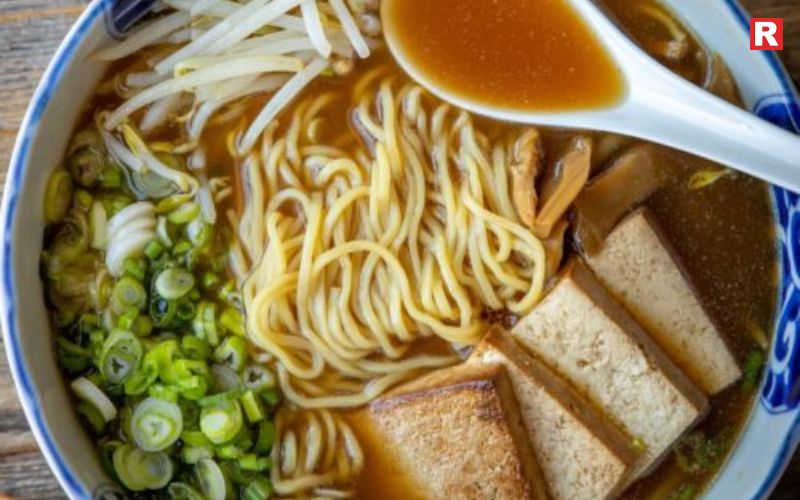
Shoyu ramen is one of the most popular types in Japan. It has a light soy sauce-based broth that’s simple yet incredibly flavorful. Sauté ginger and garlic, then add soy sauce and broth. Bring it to a gentle simmer. Add vegetables and noodles. Garnish with tofu slices, spinach leaves, and a drizzle of sesame oil. To enhance the umami, add a dash of rice vinegar or a pinch of brown sugar. It’s clean, light, and incredibly aromatic. Perfect for anyone who enjoys a classic, well-balanced ramen without heavy spices.
Ingredients:
- Soy sauce
- Vegetable broth
- Ginger and garlic
- Spinach, corn, and carrots
- Tofu or soft-boiled egg (optional)
- Noodles
Know more: 8 Famous Vegetarian Dishes of Uttar Pradesh and Their Timeless Legacy
5. Sesame & Mushroom Ramen
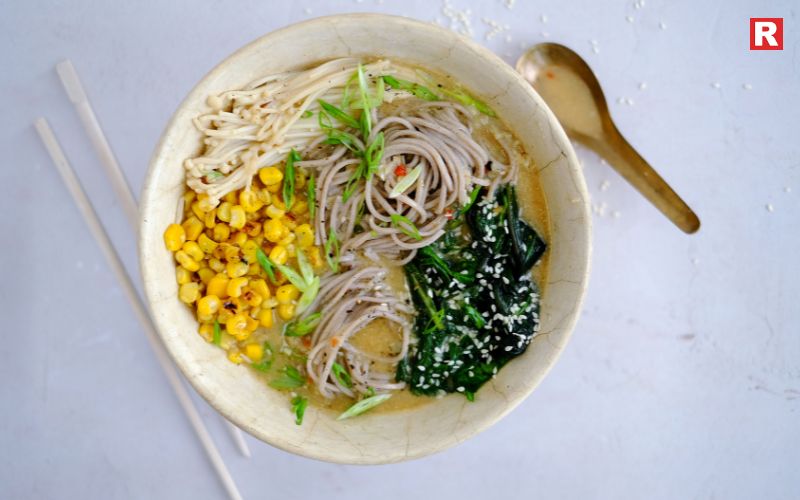
This ramen is earthy, nutty, and deeply comforting — perfect for mushroom lovers. The combination of sesame and mushrooms creates a luxurious, silky broth that feels indulgent without being heavy. Toast sesame seeds and grind them into a paste, or use tahini. Sauté mushrooms in sesame oil until golden. Add soy sauce, broth, and the sesame paste. Add noodles and greens, then simmer for a few minutes. Toasting sesame seeds before blending enhances their nutty flavor. It’s rich yet balanced, with a beautiful blend of textures and aromas. The sesame adds creaminess while mushrooms give depth — a perfect harmony in every bite.
Ingredients:
- Mushrooms (shiitake, oyster, or button)
- Sesame paste (or tahini)
- Soy sauce
- Bok choy or spinach
- Noodles
How to Make Ramen Healthier at Home
Homemade ramen doesn’t have to be indulgent. You can make it healthier with a few smart swaps:
- Use whole wheat or millet noodles instead of refined ones.
- Choose fresh vegetables like spinach, bell peppers, and broccoli for natural fiber.
- Skip instant seasoning packets — make your own broth using ginger, garlic, and miso.
- Add tofu or paneer for protein instead of fried toppings.
- Reduce sodium by using low-salt soy sauce or homemade vegetable stock.
With these small changes, your ramen becomes a nourishing, well-balanced meal.
Ramen Essentials to Keep in Your Pantry
If you’re planning to make ramen regularly, stock up on these essentials:
- Miso paste: The heart of umami flavor.
- Soy sauce: Adds saltiness and depth.
- Sesame oil: Brings aroma and richness.
- Chili oil: Perfect for adding heat.
- Nori or seaweed: Adds authentic Japanese touch.
- Good-quality noodles: Choose ramen, soba, or even whole wheat spaghetti as substitutes.
Having these ingredients handy allows you to create endless ramen variations anytime you crave something soulful.
Also check: Pani Puri Has Different Names in Different Indian States—Know Them All
Top 5 States With the Spiciest Food in India
5 Foods to Avoid for Better Cholesterol
Bring Comfort Home with Every Bowl
Ramen is more than just a dish—it’s a feeling of comfort and care in every bite. Whether you love the earthy miso version, crave the heat of garlic chili, or prefer the tropical twist of coconut curry, there’s a ramen bowl for every mood. These five veg ramen recipes prove that you don’t need meat or restaurant kitchens to create something extraordinary. With simple ingredients and a little creativity, your kitchen can become your favorite ramen bar. So the next time you’re in the mood for something warm and delicious, skip the takeout and cook your own bowl of happiness — one slurp at a time.

Korean food has become a global favourite in recent years. From K-dramas showing mouth-watering dishes to Korean cafés opening across Indian cities, its influence is hard to miss. People everywhere are drawn to its bold flavours, vibrant colours, and balance of taste and health.
Although Korean cuisine is often known for barbecue and seafood, it has a rich vegetarian side that deserves equal attention. Korean vegetarian food is light, wholesome, and filled with natural flavours. It combines spice, freshness, and comfort in every bite, making it perfect for Indian taste buds. These dishes' speciality is their harmony — soft rice, crunchy vegetables, and sauces that bring everything together beautifully. Each recipe celebrates the simplicity of ingredients while offering deep, satisfying flavours. For Indian diners who enjoy colourful, healthy, and spicy meals, Korean vegetarian dishes offer something truly unique.
Here are seven Korean vegetarian dishes
1. Bibimbap (Mixed Rice Bowl)

Bibimbap is one of the most loved Korean dishes across the world. The word literally means “mixed rice,” and it perfectly represents the idea of balance and harmony in a bowl. It is made with steamed rice topped with sautéed vegetables such as carrots, mushrooms, spinach, and zucchini. A tofu can be added on top of the place of a fried egg, and the dish is completed with a spoonful of gochujang—a spicy-sweet red chili paste that brings all the flavours together. What makes bibimbap special is its mix of textures and flavours — soft rice, crunchy veggies, and the rich, spicy sauce. In Korea, it is often eaten as a one-bowl meal, making it ideal for those who enjoy healthy comfort food. For Indian vegetarians, it feels familiar yet new — like a spicier, more colourful version of our mixed rice bowls.
2. Japchae (Glass Noodle Stir-Fry)
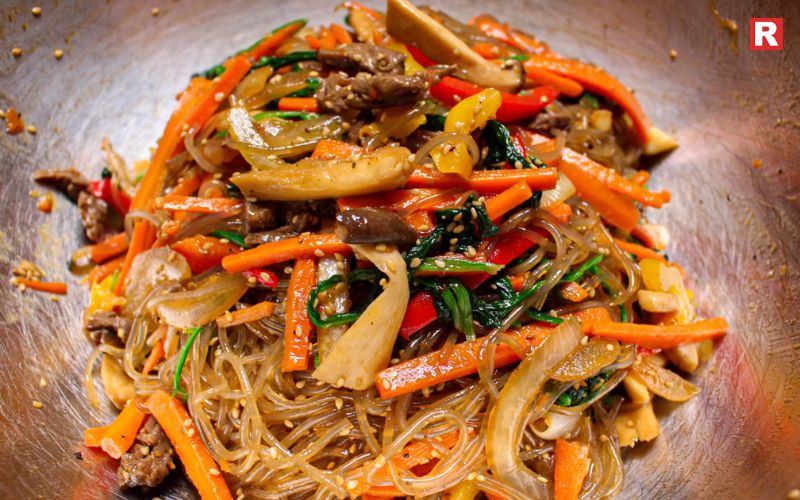
Japchae is a festive dish that brings joy to any Korean meal. It features glass noodles made from sweet potato starch, giving them a naturally chewy and glossy texture. These noodles are stir-fried with a variety of vegetables such as bell peppers, spinach, onions, and carrots, all tossed in a savoury-sweet soy and sesame sauce. Traditionally served during celebrations, Japchae is both light and filling. It stands out for its perfect balance of flavours — mildly sweet, savoury, and full of umami. For Indian palates, it feels similar to a noodle stir-fry but with a deeper, more aromatic touch from sesame oil. Japchae is a must-try if you enjoy subtle yet delicious vegetarian dishes.
Read more: 12 Delicious High-Protein Foods to Eat Daily for a Healthier You
8 Famous Vegetarian Dishes of Uttar Pradesh and Their Timeless Legacy
3. Kimchi (Fermented Vegetables)
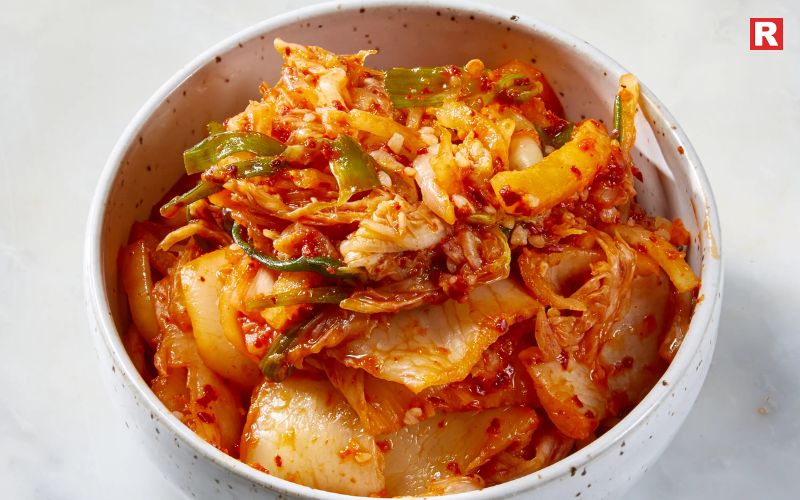
No Korean meal is complete without kimchi. It is a spicy, tangy, and crunchy side dish made by fermenting cabbage, radish, or other vegetables with chili, garlic, ginger, and salt. Traditionally, fish sauce is added, but vegan versions replace it with soy sauce or seaweed broth — making it perfect for vegetarians. Kimchi is more than just food in Korea; it’s a cultural symbol and a daily essential. Its strong, punchy flavour adds excitement to any meal, and it’s also rich in probiotics that support gut health. For those who enjoy Indian pickles, kimchi feels instantly relatable — fiery, tangy, and deeply satisfying.
4. Pajeon (Korean Scallion Pancake)

If you love Indian monsoon snacks, you’ll instantly fall for Pajeon. It’s a crispy pancake made with scallions (spring onions), carrots, and other vegetables mixed in a light flour batter. The pancake is pan-fried until golden and served with a soy dipping sauce that adds just the right amount of saltiness. Pajeon is Korea’s version of comfort food on a rainy day — very much like our pakoras or dosas. It’s crunchy on the outside and soft inside, with the fresh flavour of green onions shining through. For vegetarians, this dish is a simple yet delicious way to enjoy authentic Korean street-style food.
Know more: 10 Awadhi Cuisine Classics You Must Try at Least Once
5. Tteokbokki (Spicy Rice Cakes)

Tteokbokki is one of the most popular Korean street foods, loved for its fiery sauce and chewy texture. It features cylindrical rice cakes cooked in a thick gochujang-based sauce. The result is a spicy, sweet, and slightly smoky dish that keeps you coming back for more. While the traditional version often includes fish cakes, many modern and vegetarian-friendly versions replace them with tofu, mushrooms, or extra vegetables. For Indians who enjoy spicy snacks like chaat or chilli paneer, Tteokbokki delivers a similar thrill — chewy, saucy, and bursting with flavour.
6. Gimbap (Korean Veg Sushi Roll)
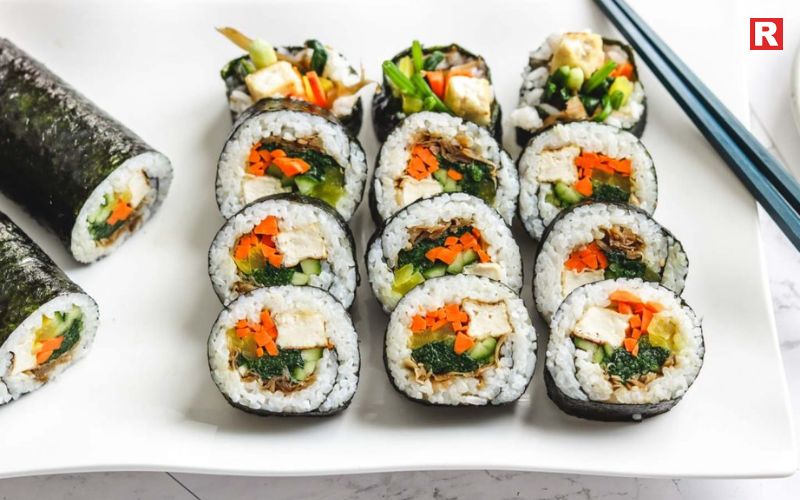
Gimbap, also known as Korean sushi roll, looks similar to Japanese sushi but has its own distinct character. It’s made with steamed rice, seasoned with sesame oil, and wrapped in seaweed sheets along with fillings like carrots, spinach, cucumber, and tofu. Unlike sushi, it doesn’t use raw fish and is served at room temperature, making it ideal for vegetarians. Gimbap is a popular lunch option in Korea and is often packed for picnics or travel. The rolls are colourful, fresh, and easy to eat on the go. If you’re an Indian who enjoys light, wholesome snacks like vegetable rolls or wraps, Gimbap will feel like a Korean cousin — clean, tasty, and satisfying.
Also check: 7 Chinese Dishes That Can Be a Healthy Option for Your Diet
7. Doenjang Jjigae (Soybean Paste Stew)
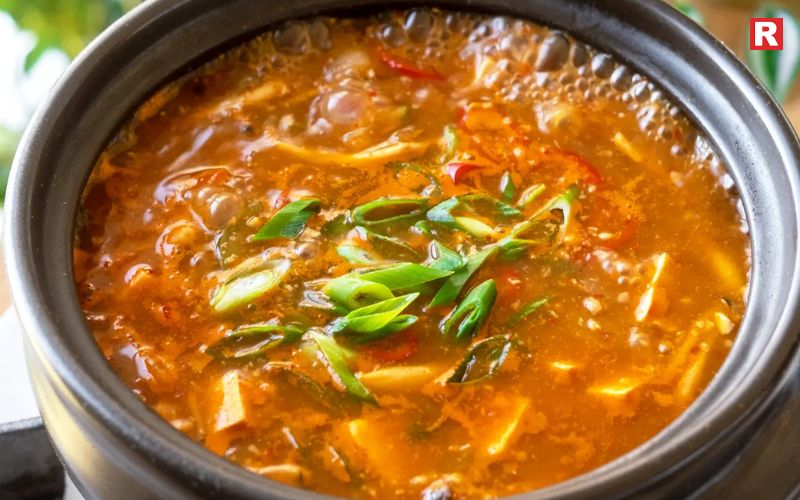
Doenjang Jjigae is Korea’s answer to comfort food. It’s a rich and hearty stew made from fermented soybean paste (doenjang), tofu, mushrooms, and vegetables like zucchini and potatoes. The flavour is deep, earthy, and full of umami. This stew is often served with steamed rice, making it a complete and nourishing meal. It’s similar to Indian dal in its warmth and simplicity — a dish that feels like home. For vegetarians, Doenjang Jjigae offers a perfect mix of nutrition and comfort, ideal for cooler days or when you need a wholesome meal.
Where to Try Korean Veg Dishes in India
Korean vegetarian food has found a strong place in India’s growing food culture. With the rising love for Korean dramas, music, and lifestyle, more people are eager to try authentic Korean flavours. Many restaurants across major Indian cities now serve vegetarian and vegan Korean dishes that suit local preferences without losing traditional taste.
Here are a few popular spots to explore:
- Mumbai: Cafés like Heng Bok and The Himalayan serve a range of vegetarian-friendly Korean meals. Their menus feature dishes like Bibimbap, Kimchi Fried Rice, and Veg Japchae.
- Delhi: Restaurants such as Gung The Palace and Kori’s have gained loyal customers for their authentic flavours and cosy atmosphere. They also offer vegan options prepared with locally sourced ingredients.
- Bangalore: Korean cafés like Arirang and Soo Ra Sang are known for their homely, comforting meals and warm hospitality.
Across these cities, diners can enjoy a true taste of Korea — simple, flavourful, and perfectly suited for vegetarian palates.
Check more: 10 Steamed Indian Dishes Beyond Idli & Dhokla
6 Easy Pumpkin Seed Recipes with Surprising Health Benefits
Top 6 Fireless Food Dishes for Your Quick Meals
Final Thought!
Korean cuisine goes far beyond barbecue or seafood. It celebrates creativity, balance, and a deep respect for fresh ingredients. The vegetarian side of Korean food shows that rich flavours do not always need meat or fish. Each dish carries its own charm and tradition. The fiery taste of Tteokbokki, the colourful mix of Bibimbap, and the warm comfort of Doenjang Jjigae reveal how simple ingredients can create bold flavours. Korean vegetarian food is wholesome, nourishing, and full of life. It connects culture, health, and taste in every bite. For those exploring global cuisines, Korean vegetarian dishes offer a new experience that feels both exciting and familiar. Every meal tells a story — one of tradition, patience, and care. On a visit to a Korean restaurant, choosing these vegetarian dishes allows diners to discover the true soul of Korea — honest, hearty, and beautifully balanced.

India’s been called the Land of Spices for centuries, and honestly, it has earned this name. The country’s flavors, from the cardamom fields of Kerala to the blazing chilies of Andhra Pradesh, have changed the way the world eats. These spices didn’t just add taste to the food; they shaped cultures, sparked trade wars, and built empires. Even now, India’s spice legacy lives on, especially in the chaos and color of its markets.
Walk through an Indian spice bazaar and you’ll understand it right away. The smell of cinnamon, cloves, turmeric, and pepper hits you first. The smell is thick in the air, making it impossible to ignore. These places aren’t just about buying and selling; they’re living museums, keeping old traditions alive. So let’s dive into five of India’s most iconic spice markets, where centuries of culinary history still exist in every corner.
The Legacy of Indian Spice Markets
India’s spice trade isn’t some new story. It goes back over 4,000 years, long before anyone from Europe ever set foot here. Ancient sailors from Arabia, China, and Rome crossed dangerous waters just to get their hands on things like pepper, cardamom, and cinnamon. There was a time when black pepper was so precious, people called it “black gold.” The spices didn’t just move goods; they changed food across continents.
Today, India’s still at the top, one of the world’s biggest spice producers and exporters. Its markets, whether old or new, carry this legacy forward. Each one feels like a patchwork of local pride, family secrets, and the kind of hand-ground masalas you just can’t fake.
1. Khari Baoli, Delhi – Asia’s Biggest Spice Market
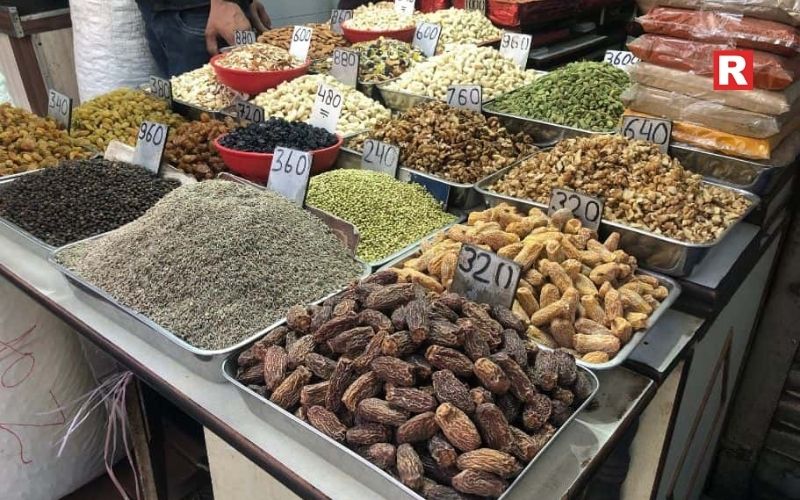
Right in the middle of Old Delhi, not far from the Red Fort and the madness of Chandni Chowk, you’ll stumble into Khari Baoli, Asia’s largest wholesale spice market. This place has been around since the 1600s, which makes it a Mughal-era survivor bursting with the color of spices and the noise of vendors.
The lanes are so narrow you can barely squeeze through, and every shop looks like it’s been there forever. Spices? Stacked to the ceiling. Turmeric, cumin, fennel, dry fruits, herbs, and tea leaves. The scent of pepper and cardamom hangs heavy. Most traders come from families who’ve done this business for generations.
Khari Baoli isn’t just a market; it’s a show of India’s rich spice history. The shouting, the little metal weights clanking on scales, the whiff of someone roasting masalas nearby, it all hits you at once. Whether you’re a chef hunting for the perfect ingredient or just a visitor looking for gifts, this place delivers a genuine taste of Delhi’s spice story.
Know more: Indian Spice Blends from Restaurant Chefs: Recipes, Techniques & Regional Masalas
2. Jew Town Spice Market, Kochi – Kerala’s Fragrant Heart

You can’t talk about Indian spices without talking about Kerala. Kochi’s Jew Town, tucked near the old Paradesi Synagogue and Mattancherry, has a spice market which is one of the most atmospheric spice markets you’ll ever walk through.
This market has history. Back in the day, it was the main center of Kerala’s spice trade with the rest of the world. Today, its old warehouses are packed with black pepper, cinnamon, nutmeg, cloves, and green cardamom, all fresh from the hills of Wayanad and Idukki.
Wander the cobblestone lanes, breathe in the mix of scents, and watch traders sorting spices by hand. Nothing is automated here. The old buildings, the laid-back vibe, the backwaters just a stone’s throw away, this place is pure Kerala, and a must for anyone interested in the story of India’s spice route.
3. Crawford Market, Mumbai – Colonial-Era Culinary Playground
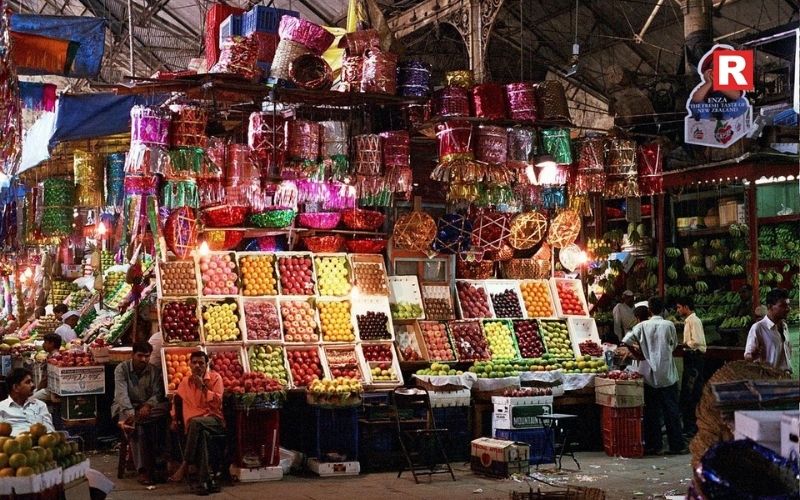
Crawford Market is officially called Mahatma Jyotiba Phule Market, but everyone still calls it Crawford. Since 1869, this market’s been the city’s go-to for everything from fresh fruit to dry fruits and, of course, spices.
Unlike most old-school spice markets, Crawford mixes things up. You’ll find classic Indian masalas like Malvani blends, Kashmiri saffron, right next to Italian herbs and Middle Eastern spices. All under one roof.
What sets Crawford apart is the vibe. It’s the meetup of old and new, tradition and global. Vendors know their stuff and love helping you pick out the right blend for your cooking. Plus, if you want to bring home spices or tea as souvenirs, this is the place to get them. The spices will be beautifully packed and ready to go.
Crawford Market is Mumbai in a nutshell: a mash-up of flavors, cultures, and creativity, all buzzing together under one massive roof.
What's new: 5 Indian Spices You Should Never Skip in Daily Cooking
4. MG Road Spice Market, Bengaluru – Where Tradition Meets the Present
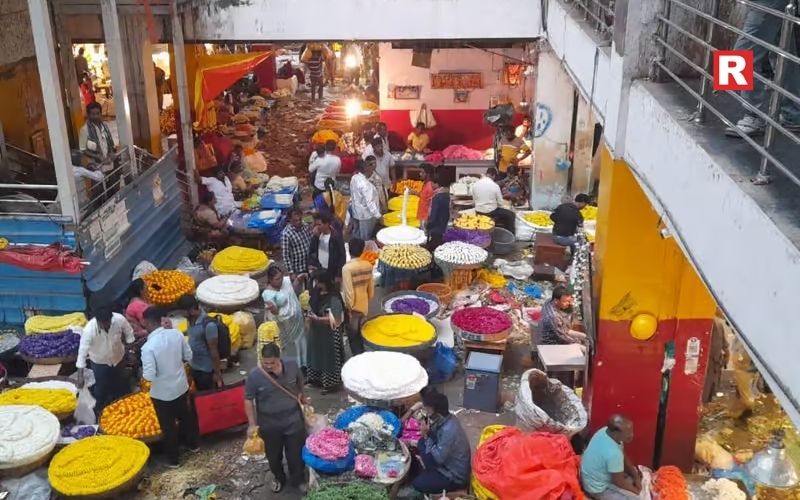
MG Road Spice Market buzzes with life right in the middle of Bengaluru. It’s where old-school charm rubs shoulders with the city’s modern energy. Bengaluru may be famous for its tech scene, but these markets still keep the city’s food traditions alive.
Walk through the lanes and you’ll spot everything from whole peppercorns, dried red chilies, organic spice mixes, and even essential oils. Some stalls are proud of their local treasures like Coorg pepper, Malnad cardamom, Byadgi chilies, all brought in straight from Karnataka’s hills and plantations.
What makes this place special? You’ll stumble on trendy stores selling artisanal masalas and fancy spice-infused oils, too. MG Road shows off just how India’s spice story keeps growing, mixing old heritage with a dash of something new.
5. Aizawl Bazaar, Mizoram – The Northeast’s Hidden Flavor Gem

Way up in Mizoram, far from the southern spice trails, Aizawl Bazaar opens the door to the bold, earthy flavors of the Northeast. The market brims with wild herbs, unique chilies like the fiery Bird’s Eye (locals call it Mizo Vaihmarcha Rawt), and spices that people gather from the forest.
Here, vendors lay out fresh turmeric, bamboo shoots, sesame seeds, and all sorts of fermented goodies that define Mizo cooking. The difference? Aizawl’s market is all about what’s fresh, local, and usually grown right in people’s gardens or small farms, not the mass-produced stuff you find elsewhere.
Spend time here and you get a real taste of a spice culture that’s simple, rooted, and close to nature. If you love food and want something off the usual track, this market is worth the trip.
Check out: 16 Types of Food and Beverage Service Outlets in India
10 Iconic Mahabaleshwar Foods That Capture Every Foodie's Heart
Bonus: Mapusa Market, Goa – The Coastal Spice Carnival
Goa isn’t the first place people think of for spices, but Mapusa Market in the north changes that picture. Every Friday, it turns into a pack of colors and smells like Goan curry powders, kokum, dried chilies, and cashews, all packed into overcrowded stalls.
Women in bright Goan saris sell homemade spice pastes and tangy vinegars, the secrets behind dishes like Xacuti and Vindaloo. The whole place feels laid-back and welcoming, with a salty breeze in the air. If you want to see a completely different side of India’s spice scene, Mapusa Market is a joy to wander through.
What Makes India’s Spice Markets Unique
These markets don’t just sell spices, they tell stories. Walk through any one of them, and you’re stepping into India’s regional traits and culinary know-how. Here’s what sets them apart:
- Farm-Fresh Authenticity: Most spices come straight from local growers and plantations.
- All Kinds of Flavors: Every region has its own special thing, Kerala shines with pepper and Cardamom, Delhi is the home of blended masalas, and Karnataka loves its chili powders.
- Handmade Blends: Forget about the factory spices. Here, spices get ground by hand, so they’re fresher, more aromatic, and just taste better.
- Living Heritage: The buildings, the bustle, the people; all of it is tied to India’s long spice history.
When you shop here, you’re not just picking up ingredients. You’re getting a slice of India’s centuries-old spice economy.
Tips for Visiting Spice Markets
Thinking about visiting one of these markets? You might want to know a few tips to make the experience smoother:
- Go Early: Mornings mean fresher stock and fewer crowds.
- Bring Cash: Most vendors only deal in cash.
- Bargain (Nicely): Haggling isn’t rude if done nicely and politely.
- Buy What You Need: Spices fade if they sit too long, so grab small amounts and restock often.
- Check for the Real Thing: Look for organic or GI-tagged items like Malabar pepper or Alleppey turmeric.
- Ask How to Store Them: The right container and a cool, dry spot keep spices fresh longer.
Learn more: 10 Best Ginger Beer Brands in India
A Journey Through Flavor
Walking through India’s spice markets isn’t just a shopping trip. It’s a deep dive into history, culture, and a world of flavor. From the packed alleys of Delhi’s Khari Baoli to the spice-filled godowns of Kochi’s Jew Town, every market has its own story to tell.
These aren’t just places to buy spices, they’re living, breathing museums. Every scoop of spice holds a bit of the past. Food lovers, home cooks, even people who just like the smell of fresh pepper, there’s something here for everyone.
So next time you’re after real flavor, skip the supermarket. Go through India’s spice markets and let the scents, sounds, and stories spark your senses. That’s how you taste the real India.

Coconut has always been a favourite ingredient in Indian kitchens. It is simple, pure, and full of flavour. From the spicy curries of Kerala to the rich seafood of Goa, coconut adds a creamy texture and a pleasant aroma that makes every dish special. It blends beautifully with Indian spices and brings a mild sweetness that balances strong flavours.
Across India, people use coconut in many forms — grated, ground, or as milk and oil. It can thicken curries, enrich desserts, and even add softness to rice dishes. Its natural richness makes food comforting and satisfying. Coconut is also valued for its health benefits. It is rich in good fats, vitamins, and nutrients that give energy and keep the body healthy. No wonder it has been part of Indian cooking for centuries. For anyone who enjoys home cooking, coconut opens endless possibilities. It can turn everyday meals into something extraordinary. Here are five coconut-based dishes that are easy to make, delicious, and perfect for anyone who wants to bring coastal flavours and comfort to their dining table.
Here’s a guide to 5 Tasty Coconut Dishes
1. Kerala-Style Coconut Fish Curry
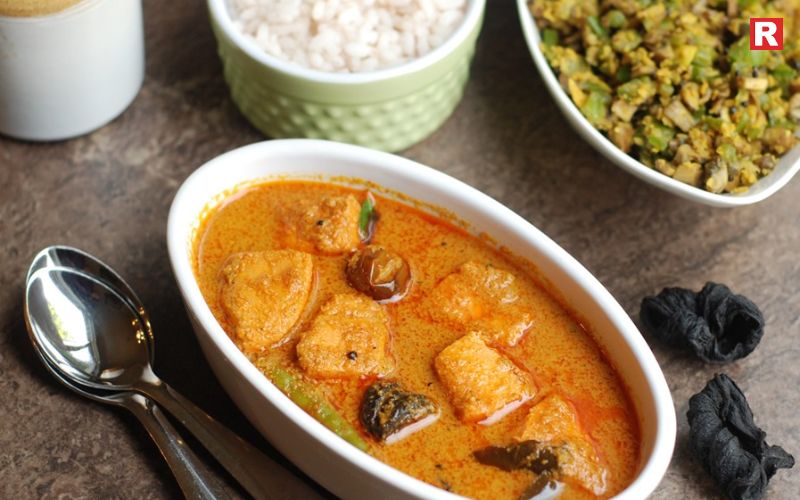
- Origin: Kerala
- Flavor Profile: Spicy, creamy, and tangy
Kerala’s coastal cuisine is incomplete without its signature coconut fish curry. This dish brings together the richness of coconut milk, the tanginess of tamarind, and the punch of traditional Kerala spices. To prepare, marinate pieces of fish (like seer or pomfret) with turmeric, salt, and chilli powder. Sauté onions, curry leaves, and ginger-garlic paste in coconut oil, then add the marinated fish. Pour in thick coconut milk and simmer gently. The result is a velvety curry that pairs beautifully with steamed rice or appams. It’s wholesome, full of authentic coastal flavours, and the coconut milk gives it a unique creaminess that perfectly balances the spice.
2. Goan Prawn Curry with Coconut Milk
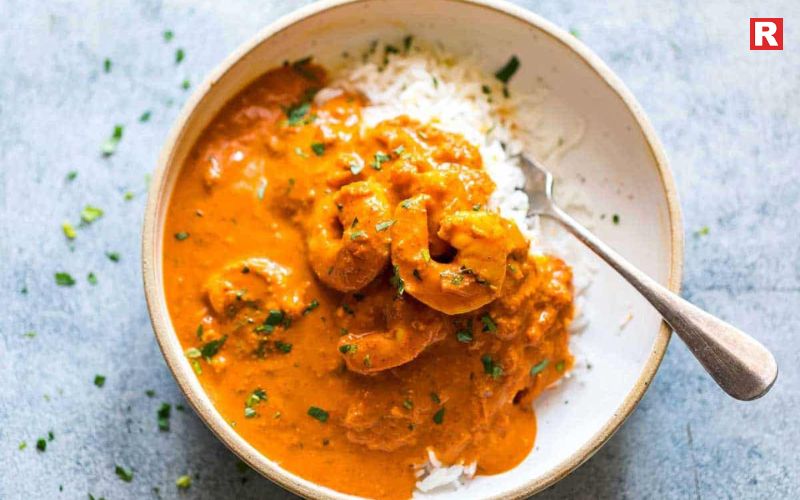
- Origin: Goa
- Flavor Profile: Tangy, mildly spicy, and aromatic
This Goan delicacy is a celebration of the sea. Fresh prawns swim in a luscious gravy made of coconut milk, tamarind, and roasted spices. The dish reflects Goa’s Portuguese influence and love for seafood. To make it at home, blend grated coconut, coriander seeds, red chillies, cumin, and garlic into a smooth paste. Cook this masala in a little oil, add prawns, tamarind pulp, and coconut milk. Simmer until the prawns are tender and the curry thickens. The sweetness of coconut milk complements the delicate flavour of prawns, creating a comforting, coastal-inspired meal that tastes best with steamed rice or pav.
Read more: 8 Famous Vegetarian Dishes of Uttar Pradesh and Their Timeless Legacy
Pani Puri Has Different Names in Different Indian States—Know Them All
3. Coconut Ladoo
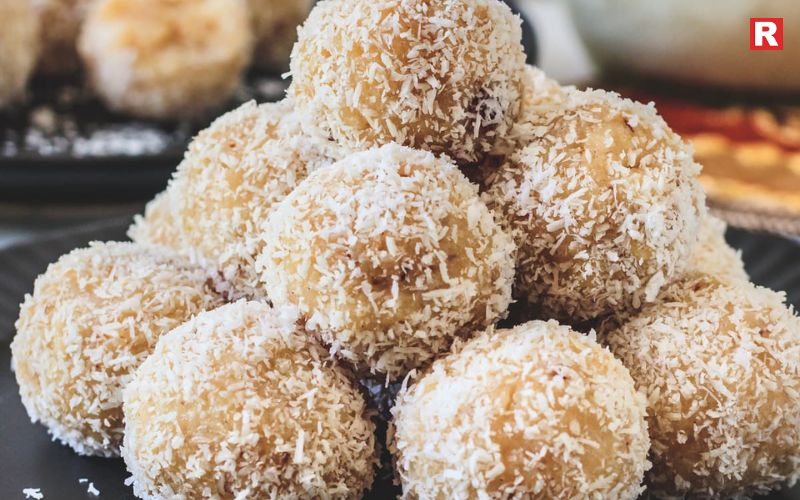
- Origin: Pan-Indian festive sweet
- Flavor Profile: Sweet, soft, and nutty
Coconut ladoos are among India’s simplest and most loved sweets. They require only a few ingredients—grated coconut, condensed milk (or jaggery), and cardamom. For preparation, heat the grated coconut with condensed milk until it thickens. Add a hint of cardamom and roll into small, round ladoos. You can garnish with chopped dry fruits for extra richness. For a healthier twist, use jaggery instead of sugar and roast the coconut lightly for a deeper flavour. These ladoos are quick, festive, and perfect for satisfying sweet cravings. Plus, they stay fresh for days, making them great for gifting or snacking.
4. Thengai Chutney (South Indian Coconut Chutney)
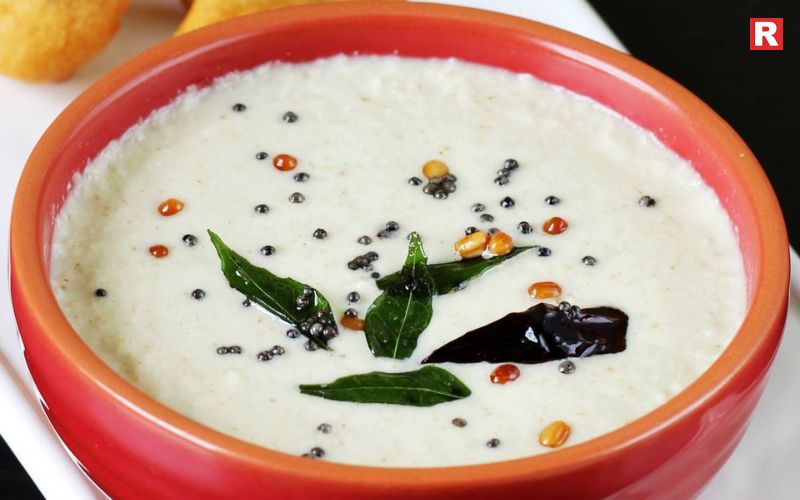
- Origin: Tamil Nadu
- Flavor Profile: Mild, nutty, and refreshing
No South Indian meal is complete without coconut chutney. Served alongside idlis, dosas, or vadas, this simple side dish balances spicy and tangy flavours perfectly. To make it, blend grated coconut, roasted chana dal, green chillies, and ginger into a smooth paste with a little water. For tempering, heat coconut oil, add mustard seeds, curry leaves, and urad dal, and pour it over the chutney. It’s the ultimate comfort dip for any South Indian breakfast. The freshness of coconut gives it a light, cooling taste that complements spicy dishes beautifully.
Know more: Top 5 States With the Spiciest Food in India
5. Nariyal Pulao (Coconut Rice)
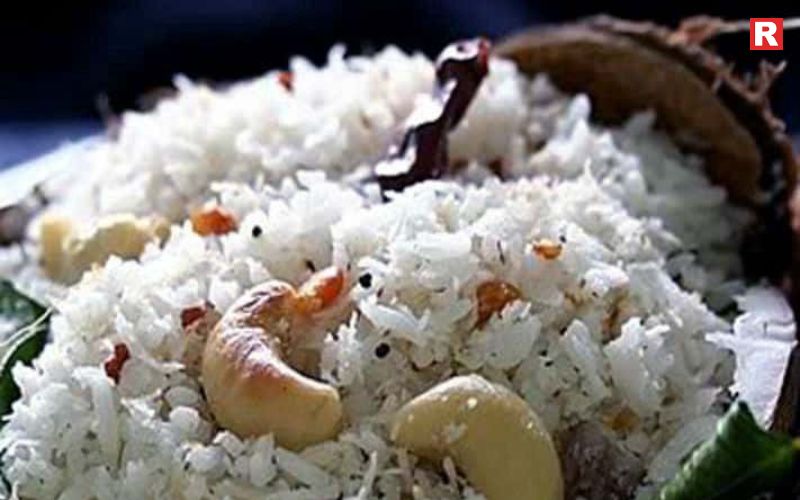
- Origin: South India
- Flavor Profile: Light, aromatic, and mildly spiced
Coconut rice, also known as Nariyal Pulao, is a fragrant and easy dish perfect for busy weekdays. It’s often made as part of temple offerings or festive spreads in South India. To make it, cook rice and let it cool. In a pan, heat coconut oil, add mustard seeds, curry leaves, green chillies, and grated coconut. Mix in the cooked rice and toss gently. You can add roasted cashews for crunch and a few drops of lemon juice for freshness. It’s a light yet flavour-packed meal that goes well with pickles, papad, or vegetable curry. It’s also ideal for tiffin or quick lunches.
Why Coconut is a Super Ingredient
Coconut is not just delicious — it’s highly nutritious. It’s rich in healthy fats that help improve heart health and energy levels. Coconut milk and oil are also packed with antioxidants and vitamins like B-complex and E.
Apart from its nutritional benefits, coconut adds a creamy texture and a natural sweetness that can’t be replicated. It’s an ingredient that fits perfectly into both traditional and modern recipes — from curries and sweets to smoothies and baked goods.
Also check: 10 Different Types of South Indian Rice Dishes
10 Must-Try Gujarati Dishes That Will Delight Your Taste Buds
10 Awadhi Cuisine Classics You Must Try at Least Once
Tips for Cooking with Coconut
- Use Fresh Coconut: Freshly grated coconut gives the best flavour. If you’re using frozen coconut, thaw it completely before use.
- Make Your Own Coconut Milk: Blend grated coconut with warm water and strain it through a muslin cloth for pure, thick coconut milk.
- Store It Right: Keep grated coconut in an airtight container in the freezer to retain freshness for up to a month.
- Choose the Right Form: Use desiccated coconut for desserts, coconut milk for curries, and coconut oil for frying or sautéing.
Bringing Coconut to Your Table
Coconut connects India’s diverse regional kitchens — from Kerala’s seafood curries to Tamil Nadu’s chutneys and Maharashtra’s sweets. Its versatility allows it to blend seamlessly into every meal, offering richness without heaviness. Cooking with coconut is also about comfort and nostalgia. The smell of fresh coconut oil, the sweetness of a ladoo, or the warmth of coconut rice instantly brings a sense of home. Whether you’re a beginner in the kitchen or an experienced cook, these five recipes are a great way to explore the magic of coconut. So, the next time you buy a coconut, think beyond the usual chutney — experiment with these dishes and discover why this humble ingredient holds such a special place in Indian cuisine.

India’s food and beverage industry reflects the country’s diversity and changing lifestyle. From small tea stalls on busy streets to elegant restaurants in five-star hotels, every outlet adds to India’s dynamic dining culture. The sector serves millions daily, offering food for every taste, budget, and mood. Over the years, eating out has become more than just a meal — it’s an experience shaped by tradition, innovation, and community.
Each type of food outlet has its own purpose and personality. Street food stalls bring local flavors to life, while fine dining restaurants focus on luxury and detail. Cafés create cozy corners for conversations, and quick service restaurants meet the pace of modern life. Food courts in malls, cloud kitchens delivering meals at home, and bakeries filling cities with aroma — all form part of this vibrant network. India’s F&B landscape continues to expand with new trends, global influences, and digital innovation. Whether it’s a family dinner, a coffee break, or a late-night snack, food connects people across cultures and cities. The industry truly represents how India eats, celebrates, and evolves.
Explore 16 Types of Food and Beverage Service Outlets
1. Fine Dining Restaurants

Fine dining restaurants represent the highest standard of culinary excellence. They are known for elegant interiors, professional service, and premium ingredients. These restaurants usually offer multi-course meals with detailed plating and international presentation. The staff are formally trained, and the atmosphere is refined. In India, restaurants like ITC Bukhara in Delhi and The Table in Mumbai set benchmarks for luxury dining. Fine dining is ideal for formal events, celebrations, or business dinners where the focus is on quality and experience.
2. Casual Dining Restaurants

Casual dining outlets combine comfort with great food at mid-range prices. They are perfect for families, friends, and corporate groups looking for a relaxed dining experience. The menus are diverse, ranging from Indian and continental to fusion cuisines. Examples include Barbeque Nation, Mainland China, and Olive Bistro. These restaurants focus on ambience and friendly service without the formality of fine dining.
Read more: 8 Famous Vegetarian Dishes of Uttar Pradesh and Their Timeless Legacy
10 Awadhi Cuisine Classics You Must Try at Least Once
3. Quick Service Restaurants (QSRs)

Quick Service Restaurants are designed for speed and convenience. They cater to people who prefer quick, affordable, and hygienic meals. The service is fast, often self-serve or takeaway-based. Popular QSR chains in India include McDonald’s, Burger King, and Wow! Momo. The rise of delivery apps like Zomato and Swiggy has further boosted this segment, especially among working professionals and students.
4. Cafés and Coffeehouses

Cafés have become an essential part of India’s urban culture. They serve coffee, tea, sandwiches, and desserts in a casual and cozy environment. These outlets are ideal for work meetings, study sessions, or casual hangouts. Popular Indian cafés include Blue Tokai, Third Wave Coffee, and Café Coffee Day. Many cafés also double as creative spaces, hosting music nights and community events.
5. Pubs and Bars

Pubs and bars are social spaces where people come to unwind with drinks, snacks, and good music. They focus on beverages—especially cocktails, craft beers, and spirits—served with light food options. Outlets like The Beer Café, Social, and Toit have popularized the pub culture in cities like Bengaluru, Mumbai, and Pune. They attract young professionals looking for casual evening entertainment.
6. Lounges

Lounges are more sophisticated than pubs, offering premium cocktails, soft lighting, and comfortable seating. They cater to those seeking an upscale experience with music and gourmet food. Lounges like Aer in Mumbai or PVR Home in Delhi blend fine drinks with a luxurious atmosphere. They are often part of hotels or standalone premium establishments.
Know more: Top 5 States With the Spiciest Food in India
7. Buffets and Multi-Cuisine Restaurants

These outlets offer a wide variety of cuisines in a single location. Customers can try multiple dishes at one fixed price. Restaurants like Sigree Global Grill and Barbeque Nation have made buffet dining a favorite among families. The variety, unlimited servings, and value-for-money approach make them popular for group outings and celebrations.
8. Cloud Kitchens

Cloud kitchens are delivery-only outlets that operate without a dine-in space. Orders are placed online through food delivery platforms. This model minimizes costs while allowing brands to expand quickly. Companies like Rebel Foods (Faasos), EatSure, and Biryani By Kilo have revolutionized the Indian food delivery space. With growing digital adoption, cloud kitchens are expected to dominate the future of food service in India.
9. Food Courts

Food courts are commonly found in malls, airports, and large commercial complexes. They house multiple food brands under one roof, allowing customers to choose from a range of cuisines. Each outlet has a counter service format. Examples include food courts in Inorbit Mall, Phoenix Marketcity, and DLF Mall of India. They are convenient for groups with varied preferences.
Also read: 8 Different Types of Kebabs from Lucknow and Why They’re Famous
10. Street Food Stalls

Street food is the soul of India’s culinary culture. Affordable, flavorful, and quick, these stalls serve everything from pani puri and vada pav to chaat and kebabs. Cities like Delhi’s Chandni Chowk, Mumbai’s Khau Galli, and Kolkata’s Park Street are famous for their street food culture. These outlets highlight India’s diversity and authenticity, offering local specialties that define regional cuisines.
11. Bakeries and Confectioneries

Bakeries focus on baked goods like bread, cakes, pastries, and cookies. Many now also serve beverages and snacks. Brands like Theobroma, Monginis, and L’Opéra are popular for their quality desserts and European-inspired offerings. Bakeries are often a go-to for celebrations, gifting, and quick bites.
12. Canteens and Messes

Canteens and messes provide affordable, home-style meals in offices, schools, colleges, and factories. They focus on nutritious and simple food at minimal cost. Examples include IIT campus messes, railway canteens, and ISRO canteens. These outlets are vital for daily meal needs, especially in institutional setups.
13. Food Trucks and Pop-Ups

Food trucks have become trendy in Indian metros, offering freshly prepared food on wheels. They are flexible, mobile, and perfect for experimental cuisines. Brands like The Rolling Kitchen and Frugurpop are examples. Pop-up restaurants, on the other hand, are temporary setups that introduce new food concepts and experiences for limited periods.
Check more: Spice Up Your Meals with These 10 Authentic Indian Chutneys That Add a Burst
5 Cities That Serve the Best Non-Vegetarian Street Food
8 Famous Street Foods of Agra You Can’t Miss
14. Specialty Restaurants
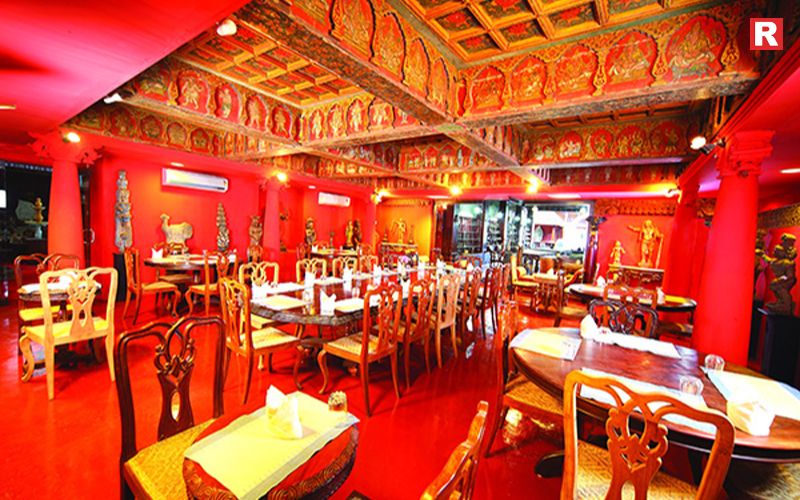
Specialty restaurants focus on a single cuisine or a niche dining concept. They bring authenticity and expertise to their menus. Examples include Mainland China for Chinese cuisine, Saravana Bhavan for South Indian food, and Punjab Grill for North Indian delicacies. These outlets often highlight regional or global culinary traditions.
15. Theme Restaurants

Theme restaurants combine food with a storytelling experience. They are designed around unique interiors, music, and menu concepts. For instance, Village – The Soul of India recreates the feel of a rural setting, while Rainforest Café offers a jungle-inspired atmosphere. These restaurants attract families and tourists seeking immersive experiences.
16. Clubs and Resort Dining

Exclusive clubs and resorts offer premium dining as part of their leisure and hospitality services. Members and guests enjoy gourmet food, curated menus, and scenic settings. Examples include Taj Fort Aguada Resort & Spa in Goa and Bombay Gymkhana Club. These outlets combine recreation, luxury, and dining in one experience.
The Evolution of India’s F&B Industry
India’s dining culture has evolved rapidly in the past decade. Rising disposable income, urban lifestyles, and exposure to global cuisines have changed how people eat out. According to industry reports, the Indian food service market is valued at over ₹5 lakh crore and continues to grow at a steady pace. The expansion of delivery platforms, digital payments, and health-conscious dining has reshaped the F&B ecosystem.
Several factors are fueling this transformation:
- Increased urbanization and working professionals
- Growth of organized retail and mall culture
- Influence of social media and food blogging
- The convenience of online ordering and delivery apps
- Shift toward experiential dining and local sourcing
The Road Ahead!
The next phase of the Indian F&B industry will focus on sustainability, technology, and personalization. Consumers are becoming more conscious of ingredients, waste, and eco-friendly operations. Plant-based menus, contactless dining, and regional Indian cuisines are gaining popularity. The industry is expected to blend tradition with innovation while offering diverse, inclusive dining formats. From luxury dining rooms to vibrant street stalls, India’s food and beverage outlets reflect its cultural and economic diversity. Each type of outlet serves a unique purpose—some focus on speed and convenience, while others create memorable culinary journeys. Together, they form an ecosystem that celebrates India’s love for food, community, and innovation.

Maharashtra is known for its rich traditions, warm hospitality, and soulful food. Marathi cuisine reflects the heart of the state — simple, bold, and full of flavour. Every dish tells a story of its land, people, and culture. From the fiery curries of Kolhapur to the sweet Modaks of Konkan, each bite offers a taste of heritage. The food here is rooted in balance—spicy, tangy, and slightly sweet. Locally grown ingredients like coconut, peanuts, jaggery, and tamarind give Marathi food its distinct identity. Homemade masalas, slow cooking, and traditional techniques add depth and warmth to every meal.
Whether it’s a comforting plate of Poha for breakfast or a festive Puran Poli shared with family, Marathi food brings people together. The cuisine varies beautifully across regions — coastal areas lean towards coconut-based curries, while inland regions love hearty grain-based meals. Visitors often find that every city, from Pune to Nagpur, offers a new flavour to discover. For anyone exploring Maharashtra, trying its traditional dishes isn’t just a culinary experience — it’s a journey through the state’s culture, tradition, and timeless love for food.
The Heart of Marathi Cuisine
Marathi cuisine is truly special because of its simplicity and balance. It is neither overly rich nor bland — just the right blend of spice, sweetness, and tang. Ingredients like peanuts, coconut, jaggery, and goda masala define its unique identity. The food varies across regions: coastal Konkan offers seafood and coconut-based dishes, while Vidarbha and Kolhapur are known for their spicy curries. Vegetarian or non-vegetarian, every dish carries the essence of home-cooked love.
Find 8 Famous Marathi Dishes
1. Puran Poli – The Taste of Festivals
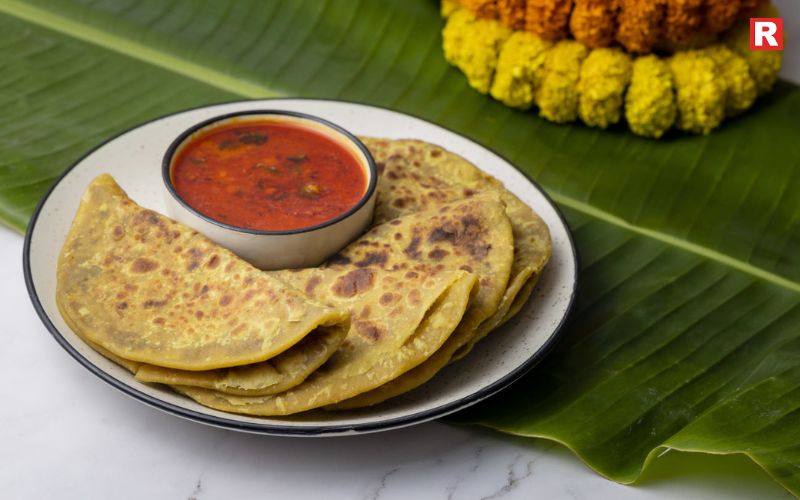
Puran Poli is more than just a dish; it is a celebration on a plate. This sweet flatbread, stuffed with a mixture of jaggery and chana dal, is a traditional delicacy made during festivals like Holi, Ganesh Chaturthi, and Diwali. It is cooked with ghee on a hot tawa until golden brown. The soft, sweet filling melts in your mouth, offering a perfect balance of taste and comfort. In most Marathi households, Puran Poli symbolizes warmth, family, and togetherness. A glass of milk or a dollop of ghee on the side makes it even more satisfying.
2. Misal Pav – The Spicy Street Star
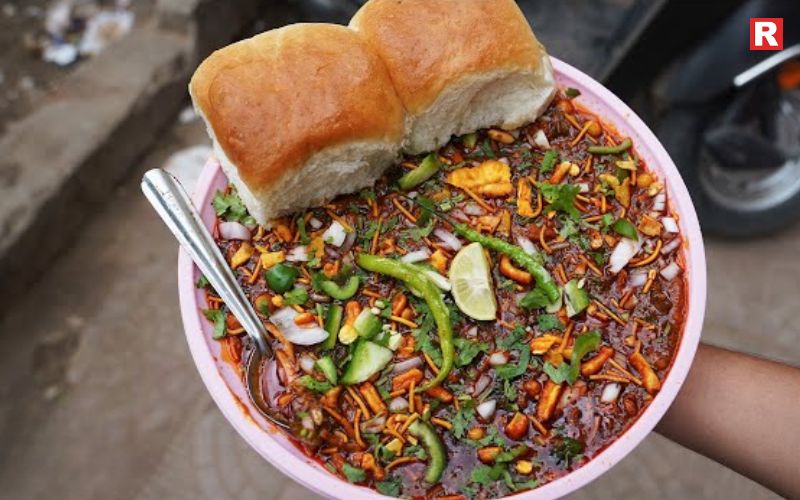
Misal Pav is one of Maharashtra’s most loved breakfast and snack dishes. Originating from Pune and Nashik, this spicy sprouted curry is served with pav (bread) and topped with farsan, onions, and lemon. The star ingredient is the kat — a fiery, flavorful gravy made with goda masala and red chili powder. Each region adds its own twist, from the mild Mumbai version to the famous Kolhapuri Misal that sets your taste buds on fire. Misal Pav is not just food; it’s an experience that defines Marathi street culture. Pair it with buttermilk for the perfect balance.
Read more: 8 Different Types of Kebabs from Lucknow and Why They’re Famous
8 Famous Vegetarian Dishes of Uttar Pradesh and Their Timeless Legacy
3. Poha – Light, Simple, and Loved by All
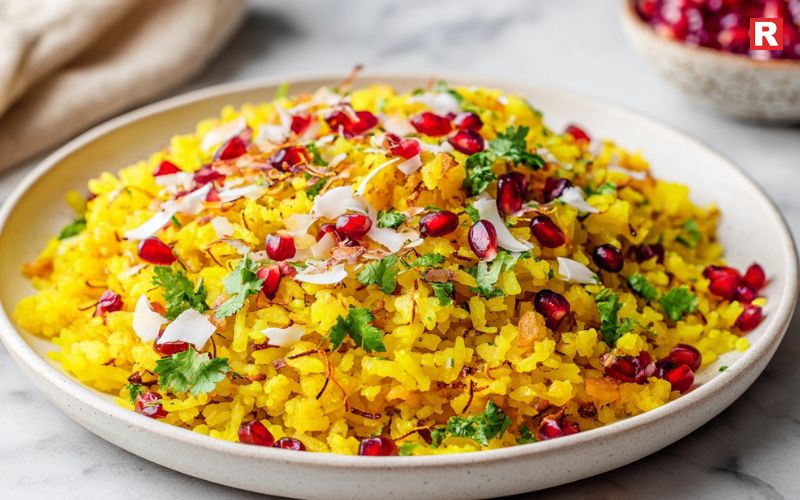
Poha is one of the simplest yet most comforting Marathi dishes. Made with flattened rice, onions, turmeric, green chilies, and peanuts, it’s a breakfast staple across Maharashtra. The dish is light on the stomach but rich in flavor and nutrition. It’s often garnished with fresh coriander, grated coconut, and a squeeze of lemon. Whether enjoyed in a small local café or a home kitchen, Poha offers a taste of everyday Marathi life. The Kanda Poha (onion poha) version is especially popular in Pune and Mumbai, where it’s enjoyed with a cup of hot tea in the morning.
4. Sabudana Khichdi – The Fasting Favorite
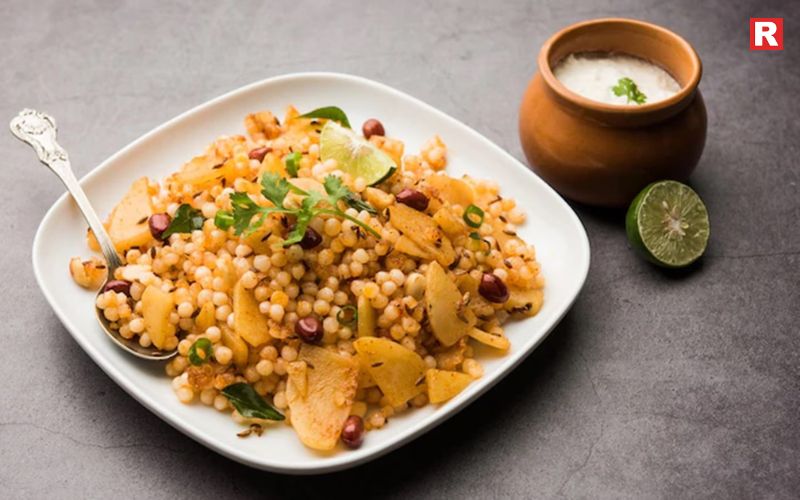
Sabudana Khichdi is a dish that proves fasting doesn’t mean giving up on flavor. Made with soaked tapioca pearls, potatoes, peanuts, and mild spices, this dish is traditionally prepared during fasting days like Ekadashi. The combination of soft sabudana and crunchy peanuts creates a perfect texture. It’s light, non-greasy, and full of energy. A squeeze of lemon and a touch of ghee take it to another level. You’ll find Sabudana Khichdi served in homes, temples, and restaurants alike. It’s one of the most loved comfort foods across Maharashtra.
Know more: 10 Awadhi Cuisine Classics You Must Try at Least Once
5. Bharli Vangi – A Royal Brinjal Curry
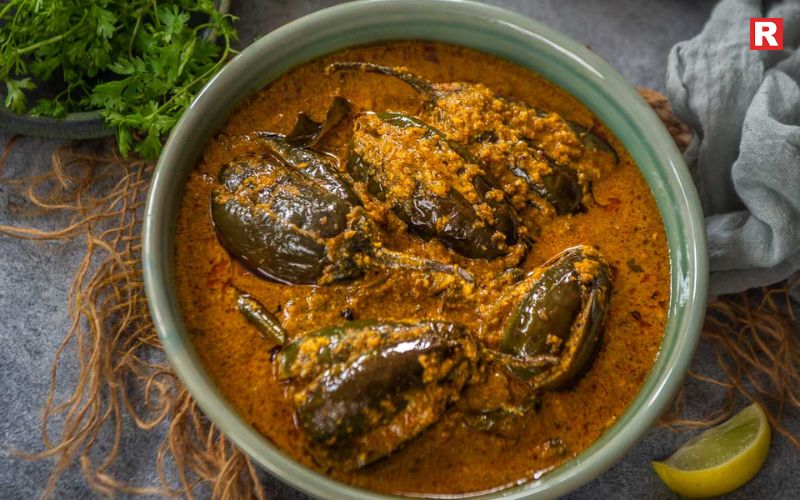
Bharli Vangi, or stuffed brinjal curry, is a dish that showcases the art of Marathi cooking. Small brinjals are stuffed with a flavorful mix of coconut, peanuts, sesame seeds, and aromatic spices, then cooked slowly in oil until tender. The thick, rich gravy pairs beautifully with bhakri (millet bread) or steamed rice. Popular in rural areas and festive meals, Bharli Vangi offers a unique blend of sweet, spicy, and nutty flavors. It’s a must-try for anyone who appreciates traditional vegetarian dishes made with love and patience.
6. Kolhapuri Tambada Rassa – Bold and Fiery Flavors
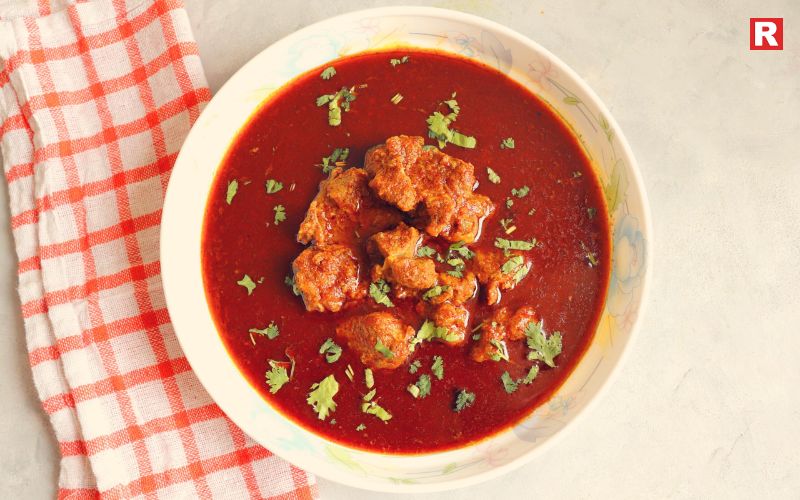
Kolhapuri cuisine is known for its bold spices and deep flavors, and Tambada Rassa is its pride. This red curry, made with mutton or chicken, gets its color and spice from the famous Kolhapuri masala. The masala includes a mix of dry coconut, red chilies, garlic, and other strong spices. It’s fiery, aromatic, and incredibly satisfying. Usually served with rice or bhakri, Tambada Rassa reflects the rustic essence of Kolhapur. For those who enjoy spice and heat, this dish is a true Marathi classic worth traveling for.
7. Modak – Sweetness of Tradition

Modak holds a special place in every Marathi household, especially during Ganesh Chaturthi. Known as Lord Ganesha’s favorite sweet, it is made from rice flour filled with coconut and jaggery. The dumplings are then steamed or fried. The steamed version, called Ukadiche Modak, is soft, delicate, and aromatic with the flavor of cardamom and ghee. Every bite feels festive and sacred. Making modak is often a family activity, with generations coming together to prepare them during festivals. It beautifully represents the cultural and emotional bond that Marathi cuisine shares with tradition.
Also check: Top 5 States With the Spiciest Food in India
10 Different Types of South Indian Rice Dishes
10 Must-Try Gujarati Dishes That Will Delight Your Taste Buds
8. Thalipeeth – The Multigrain Powerhouse
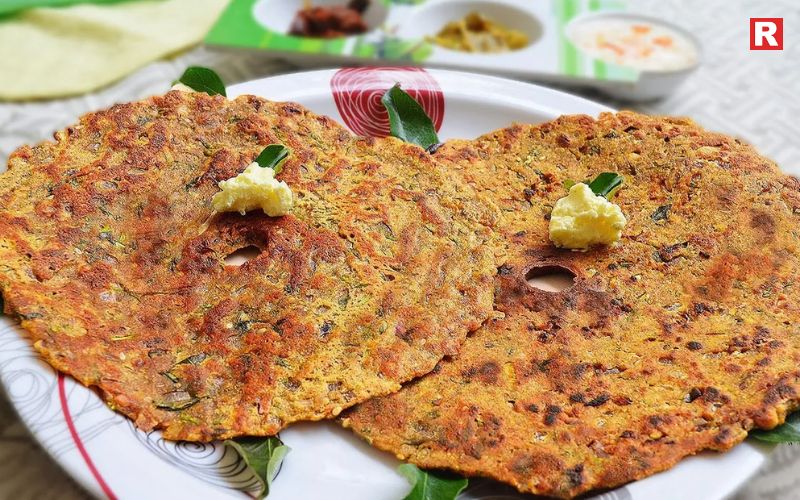
Thalipeeth is a savory multigrain pancake made from a mix of flours like jowar, bajra, rice, and gram, combined with spices, onions, and herbs. It is cooked on a griddle until crisp on the outside and soft inside. This wholesome dish is a breakfast favorite in rural Maharashtra and is often served with butter, curd, or thecha (spicy chutney). Thalipeeth is not only delicious but also nutritious, packed with fiber and protein. It’s a perfect example of how traditional Marathi food balances taste and health naturally.
Where to Try Authentic Marathi Food
To experience authentic Marathi flavours, travellers don’t have to look far. Maharashtra’s cities and towns are filled with places that serve home-style traditional meals. Each city has its own charm and speciality.
- Mumbai: Aaswad is known for its iconic Misal Pav, while Prakash Shakahari Upahaar Kendra is loved for soft and sweet Puran Poli.
- Pune: Bedekar Tea Stall serves one of the best Poha plates in town, and Shree Krishna Veg is famous for its comforting Bharli Vangi.
- Kolhapur: Local dhabas in and around the city serve fiery and flavourful Tambada Rassa, a must-try for spice lovers.
- Nashik: Small eateries offer a mix of spicy snacks and wholesome thalis that highlight the local palate.
Across Maharashtra, homestays and countryside kitchens serve fresh Thalipeeth and Modak, giving visitors a warm taste of Marathi hospitality that feels both traditional and homely.
Taste of Maharashtra
Marathi cuisine is deeply connected to Maharashtra’s roots and traditions. It is simple yet rich, spicy yet balanced, and always full of heart. Every dish, from a humble Poha to a royal Kolhapuri curry, carries the essence of the region and its people. The food reflects the diversity of Maharashtra — its culture, festivals, and family bonds. Traditional recipes have been passed down for generations, keeping the original taste alive. Dishes like Puran Poli and Modak bring sweetness to celebrations, while fiery curries like Tambada Rassa show the state’s bold side. Marathi food is more than just a meal; it’s a story told through flavours, aromas, and love. For travellers, exploring Marathi cuisine means discovering the true spirit of the land. Every bite brings warmth, comfort, and a connection to the traditions that make Maharashtra so unique and unforgettable.

India’s food culture is as diverse and colourful as its people. Every corner of the country has its own flavours, ingredients, and cooking traditions. From the royal kitchens of the north to the spice gardens of the south, each region tells a story through its food. The creamy gravies of Punjab, the slow-cooked curries of Lucknow, and the coconut-rich dishes of Kerala show how geography shapes taste. In the west, Rajasthan’s dry yet rich meals reflect the desert’s resilience, while Bengal’s love for fish and sweets celebrates its rivers and farmlands. Indian cuisine is not only about spices; it is about balance, tradition, and comfort. Each recipe has been passed down through generations, carrying family secrets and memories. Food brings people together during festivals, prayers, and celebrations. For any food lover, exploring India’s traditional cuisines is like travelling through time. Every meal tells a story of culture, love, and connection.
Here’s a look at 10 Indian Traditional Cuisines
1. Punjabi Cuisine – The Land of Bold Flavours

Punjab is known for food that’s rich, hearty, and full of life. Every meal feels like a celebration. Butter chicken, dal makhani, and tandoori roti are iconic dishes loved across India. The smoky aroma from the tandoor and the creamy texture of gravies define Punjabi food. Sarson da saag with makki di roti and a glass of lassi bring the true taste of Punjab’s farmlands to the table. The cuisine reflects the hardworking spirit of its people and their deep love for wholesome, filling meals.
2. Rajasthani Cuisine – Royal and Rustic
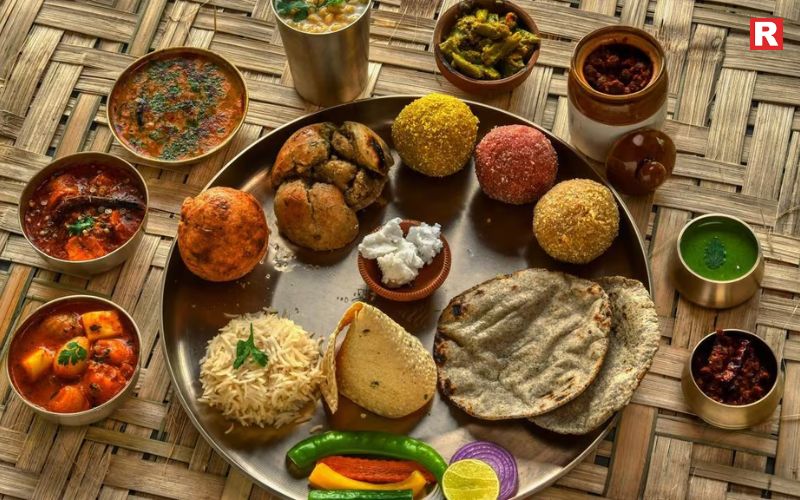
Rajasthan’s cuisine tells a story of desert living and royal indulgence. Dal baati churma, gatte ki sabzi, and laal maas are among its most famous dishes. Due to the scarcity of water and vegetables, Rajasthani food is prepared with minimal ingredients but full of flavour. The generous use of ghee, dry spices, and grains makes it both rich and earthy. Dishes like ker sangri and papad ki sabzi show how creativity turns simplicity into culinary excellence. Every bite connects to the state’s royal kitchens and vibrant culture.
Read more: 8 Famous Vegetarian Dishes of Uttar Pradesh and Their Timeless Legacy
5 Cities That Serve the Best Non-Vegetarian Street Food
3. Bengali Cuisine – A Symphony of Sweet and Savoury
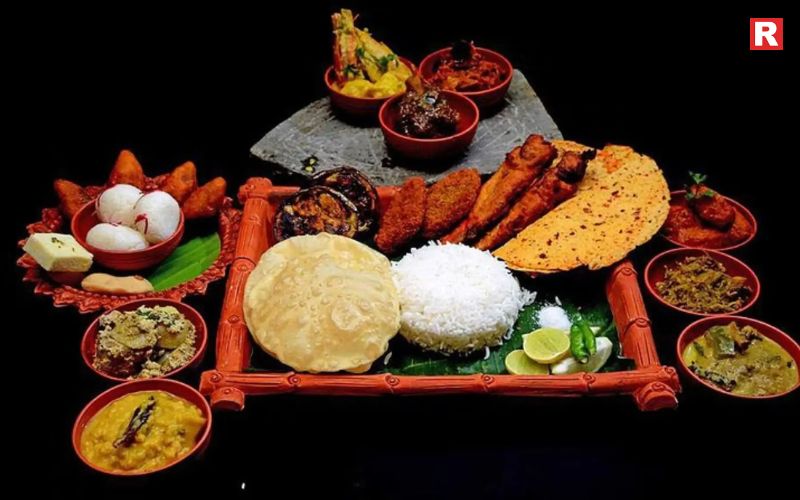
Bengal’s food culture is deeply emotional. It balances spices and sweetness beautifully. Fish is central to Bengali meals — dishes like macher jhol and shorshe ilish are local favourites. Mustard oil and panch phoron (a five-spice blend) give the cuisine its distinct aroma. No Bengali meal is complete without sweets. From rasgulla to mishti doi and sandesh, desserts play a big role in every celebration. Bengali food captures warmth, nostalgia, and the joy of comfort food.
4. South Indian Cuisine – The Balance of Spice and Simplicity

South India offers a perfect mix of nutrition and flavour. Each state — Tamil Nadu, Kerala, Karnataka, Andhra Pradesh, and Telangana — brings something unique. Idli, dosa, vada, and sambhar are staples that are now popular worldwide. The use of coconut, curry leaves, tamarind, and rice defines the region’s cooking style. Kerala’s appam with stew and Andhra’s spicy gongura chutney are perfect examples of how regional variations make South Indian cuisine so diverse. It’s light, wholesome, and packed with natural ingredients.
5. Gujarati Cuisine – Sweet, Spicy, and Soulful
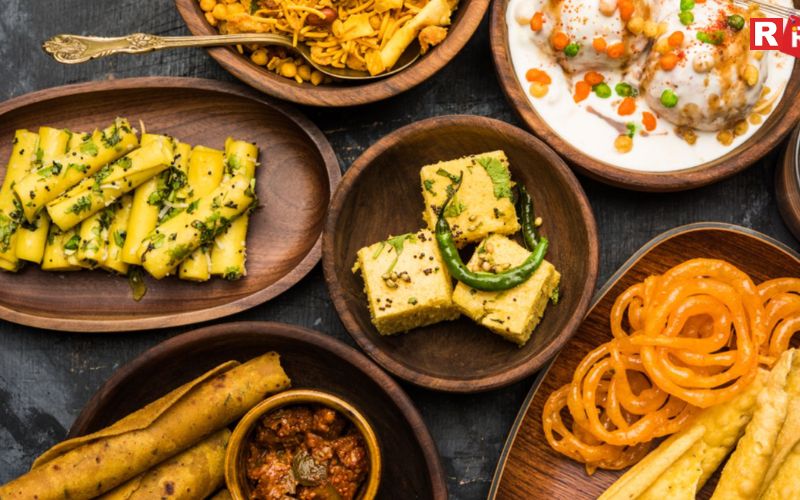
Gujarati food is full of variety and balance. Every dish has a blend of sweet, tangy, and spicy notes. Dhokla, thepla, undhiyu, and kadhi are favourites in homes and thalis. The cuisine uses ingredients like gram flour, yogurt, and lentils to create nutritious, flavourful dishes. Influenced by Jain and Vaishnav traditions, Gujarati cuisine often avoids onion and garlic, focusing on purity and simplicity. Whether it’s the festive fafda-jalebi or a humble khichdi, every meal feels like home.
Know more: 10 Awadhi Cuisine Classics You Must Try at Least Once
6. Kashmiri Cuisine – The Flavour of the Valley

Kashmiri food is known for its rich aroma, use of saffron, and slow-cooked gravies. Dishes like Rogan Josh, Yakhni, Gushtaba, and Dum Aloo are part of the famous Wazwan — a traditional multi-course Kashmiri feast. The cuisine reflects Persian and Central Asian influences, yet remains deeply rooted in local traditions. Dry fruits, curd-based gravies, and the warmth of spices like cardamom and cinnamon make every dish comforting. Kashmiri cuisine truly represents elegance, patience, and artistry on a plate.
7. Goan Cuisine – The Taste of the Coast
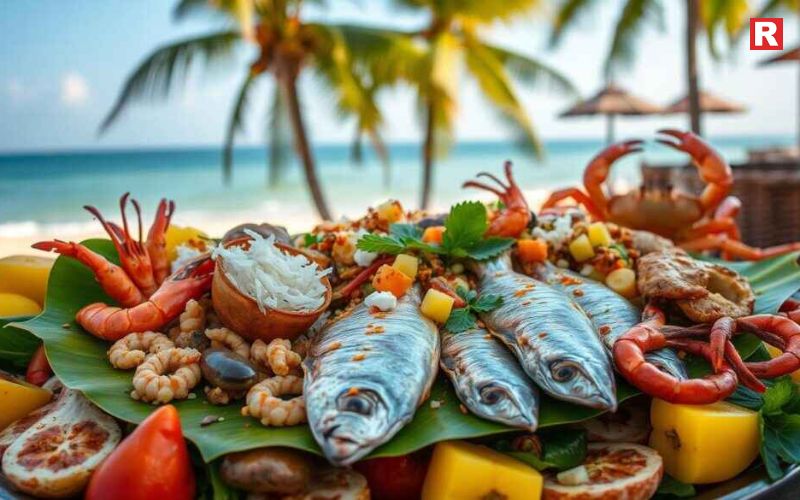
Goan cuisine blends Indian and Portuguese influences beautifully. Known for its seafood, coconut milk, and vinegar-based curries, the food here bursts with tropical flavours. Goan fish curry, prawn balchão, and vindaloo are popular dishes that reflect the state’s coastal identity. The sweet dish bebinca, made with coconut milk and jaggery, is a must-try. Spices like kokum and tamarind add a tangy twist to Goan food. Every meal feels like a vacation by the sea — refreshing, bold, and unforgettable.
8. Maharashtrian Cuisine – A Burst of Regional Variety
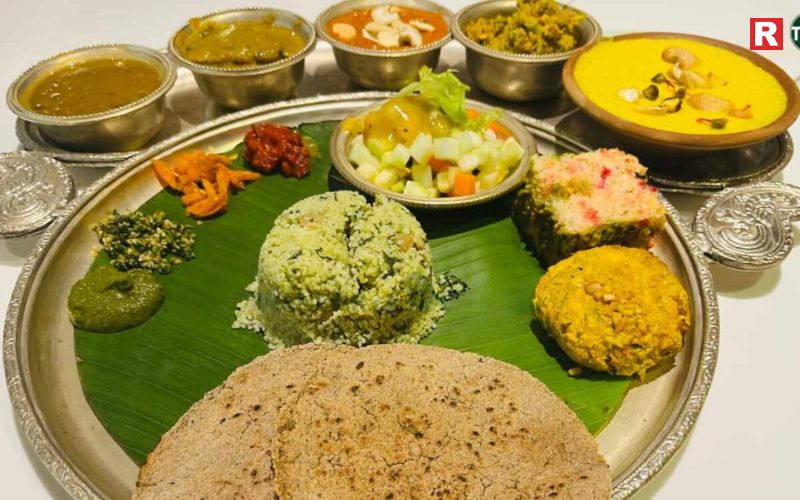
Maharashtra’s cuisine changes with every region. In western Maharashtra, Kolhapuri dishes are fiery and rich. Coastal Konkan food uses coconut, kokum, and seafood. Central regions offer comfort foods like varan bhaat (dal and rice) and poha. Mumbai adds its own street-style magic with pav bhaji, vada pav, and misal pav. Each dish carries a story — from local farms to bustling city streets. Maharashtrian food is a blend of spice, tang, and everyday comfort.
Also check: Top 5 States With the Spiciest Food in India
9. Awadhi Cuisine – The Nawabi Indulgence
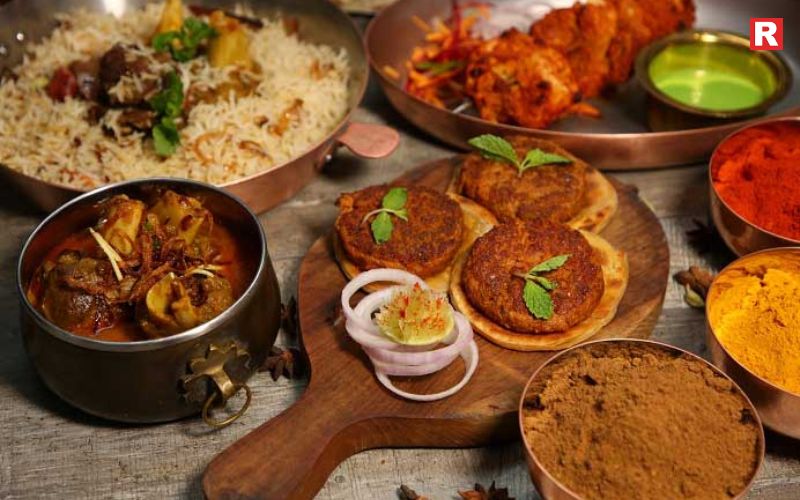
Lucknow’s Awadhi cuisine is a royal affair. Known for its biryanis, kebabs, kormas, and koftas, it represents slow-cooked perfection. The dum pukht technique — cooking in sealed pots over a low flame — was developed in Awadh’s royal kitchens. Dishes like galouti kebab, nihari, and shahi tukda are loved across India. Every preparation reflects patience, precision, and grandeur. Awadhi food celebrates the Nawabi era’s luxurious approach to taste and texture.
10. Assamese Cuisine – The Flavours of the East

Assamese food is subtle, aromatic, and connected to nature. The cuisine focuses on fresh herbs, bamboo shoots, mustard, and fermented ingredients. Fish tenga (a tangy fish curry) and khar (a traditional alkaline dish) are unique to the region. Meals are simple yet deeply satisfying, often accompanied by rice and green vegetables. The influence of tribal and neighbouring cuisines adds depth to Assamese dishes. It’s a cuisine that respects both simplicity and sustainability.
Why Indian Traditional Cuisines Stand Out
Indian cuisines are built on fresh, local ingredients and age-old techniques. From tandoor grilling to steaming and fermenting, the cooking styles vary widely. Each region adapts its food to climate and culture — using millets in dry areas, rice in coastal zones, and spices suited to local produce. The use of ghee, turmeric, herbs, and lentils also makes Indian food nutritious and healing. Every cuisine carries generations of wisdom, passed down through family recipes.
Food in India goes beyond taste — it connects to religion, festivals, and emotions. Dishes like pongal, modak, and puran poli are tied to celebrations. Fasting meals such as sabudana khichdi and thalipeeth have spiritual meanings. Even daily meals are shaped by culture and geography. Traditional Indian cuisines unite people through shared meals, traditions, and memories. They preserve India’s culinary heritage in the most delicious way possible.
Check more: 10 Must-Try Gujarati Dishes That Will Delight Your Taste Buds
Top 7 Regional Indian Thali Platters That Showcase Culinary Diversity
10 Different Types of South Indian Rice Dishes
Taste of India
Exploring India’s traditional cuisines is like taking a journey through time and taste. Each dish tells a story — one that belongs to farmers, royal families, and generations of home cooks. From the bold, buttery flavours of Punjab to the gentle, coconut-rich meals of Kerala, every region adds its own charm to India’s food culture. The spices, ingredients, and cooking styles change with geography, but the love for good food remains the same. Every bite reflects history, tradition, and warmth. For every food lover, India is more than just a destination — it’s a never-ending table of flavours, stories, and emotions. From royal feasts to humble thalis, Indian cuisine celebrates diversity on every plate. It connects people through shared memories, festive meals, and the joy of eating together. In every dish, India serves a piece of its heart and heritage.

Lucknow, often called the City of Nawabs, is known for its royal charm, refined manners, and deep food traditions. The city’s cuisine reflects its rich history, blending Persian, Mughal, and Indian influences. Among its many delicacies, kebabs hold a place of pride. They are not just food; they are a part of Lucknow’s identity. Each kebab tells a story — of the royal courts, skilled chefs, and secret spice blends passed down through generations. The art of making kebabs in Lucknow is rooted in patience and perfection. Every step, from marination to slow cooking, is done with care.
What makes these kebabs special is their unique aroma and texture. Some melt in the mouth, while others are crisp and smoky. From the legendary Galouti Kebab of Tunday Kababi to the rich Kakori and tender Seekh, each variety brings a taste of history. Lucknow’s kebabs are more than just a meal; they are a legacy of flavor, tradition, and craftsmanship that continues to charm food lovers from across the world.
Why Lucknow’s Kebabs Are Famous
Lucknow’s kebabs are famous because they represent centuries of refinement and culinary craftsmanship. The Nawabi kitchens of the 18th and 19th centuries were known for their patience and perfection. Every dish was cooked slowly, allowing the meat to absorb each spice. The chefs, known as “rakabdars,” mastered the art of balancing flavors. Instead of relying on strong heat or excess spice, they focused on subtlety. The use of ingredients like raw papaya for tenderness, saffron for aroma, and ghee for richness set these kebabs apart.
The city’s kebabs also carry a sense of history. Each recipe has been passed down through generations, preserving its original essence. Today, whether at a centuries-old shop in Chowk or a modern restaurant, the tradition remains alive. Lucknow’s kebabs also reflect a cultural blend. Persian, Mughal, and Indian influences come together to create flavors that are unique and unforgettable. It is this blend of artistry, tradition, and passion that has made Lucknow the kebab capital of India.
Find 8 Different Types of Kebabs from Lucknow
1. Tunday Kababi (Galouti Kebab)
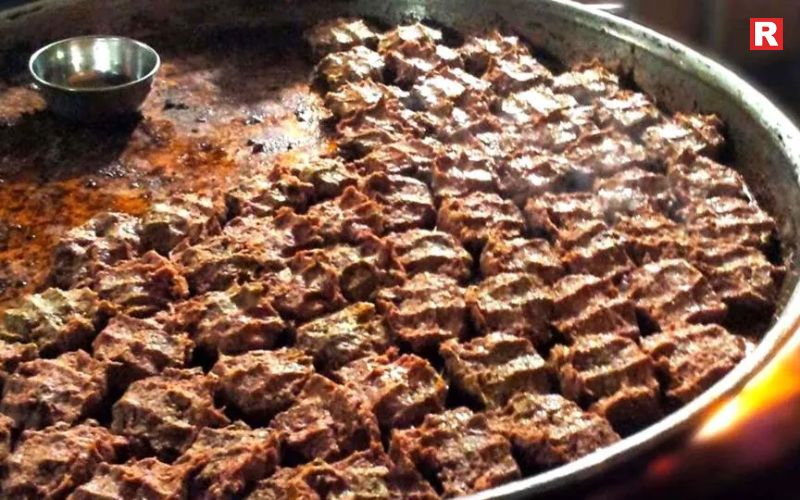
No talk about Lucknow’s food can begin without mentioning Tunday Kababi. This legendary kebab was born in the royal kitchens centuries ago. History says it was created for a Nawab who lost his teeth but not his love for meat. To please him, a one-armed chef, known as “Tunday,” made this kebab so soft that it melted instantly in the mouth. Made from finely minced meat, raw papaya, and more than 100 aromatic spices, Galouti Kebab is a masterpiece of texture and flavor. It is fried on a flat griddle with pure ghee, giving it a rich taste that stays unforgettable. Today, Tunday Kababi in Aminabad and Chowk are must-visit spots for anyone visiting Lucknow.
2. Seekh Kebab
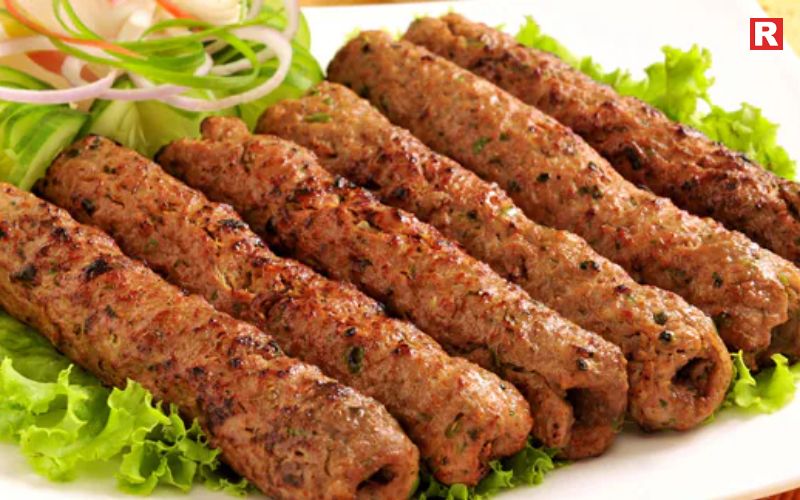
Seekh Kebabs reflect the simplicity and elegance of Awadhi cooking. Minced meat is mixed with herbs, onions, and spices, then shaped around skewers and grilled on charcoal. The slow cooking brings out a smoky flavor that is hard to resist. Unlike other kebabs, Seekh Kebabs are known for their juiciness and charred edges. They are usually served with rumali roti, mint chutney, and sliced onions. Whether eaten in a street-side stall or at a fine-dining restaurant, Seekh Kebabs never fail to impress with their soft texture and earthy aroma.
Read more: 8 Famous Vegetarian Dishes of Uttar Pradesh and Their Timeless Legacy
10 Awadhi Cuisine Classics You Must Try at Least Once
3. Kakori Kebab
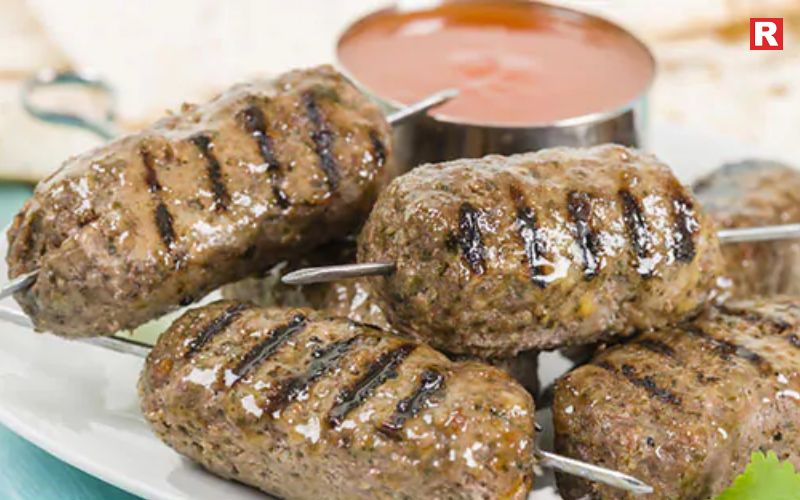
The Kakori Kebab has its roots in the small town of Kakori, near Lucknow. It was created in the 19th century for a nobleman who wanted to serve something more delicate and refined to his British guests. The result was this smooth, melt-in-the-mouth kebab that became a royal favorite. Made with finely minced mutton, raw papaya, saffron, kewra, and a blend of fine spices, Kakori Kebabs are known for their silky texture. The meat is so tender that it almost feels like a paste. The rich aroma and delicate flavor make it one of Lucknow’s most luxurious kebabs.
4. Boti Kebab
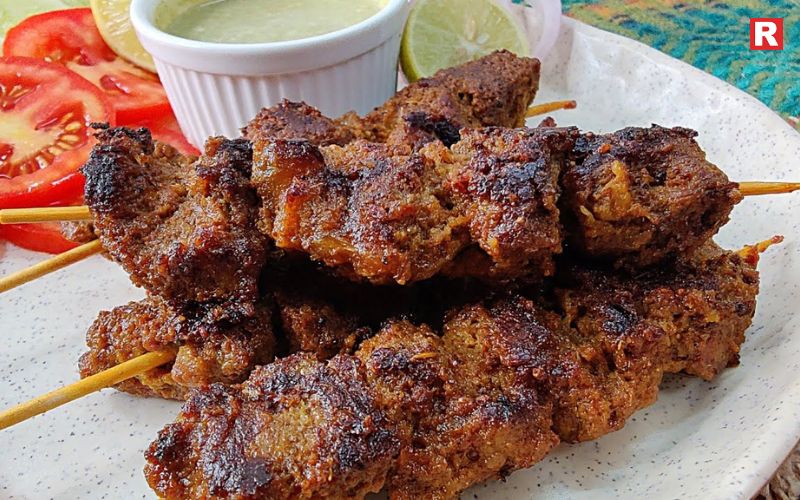
Boti Kebab is one of the most traditional forms of grilled meat in Lucknow. Here, the meat is cut into small cubes, marinated in curd, lemon juice, and spices, and then grilled on skewers. The pieces are juicy on the inside and slightly crisp on the outside. Boti Kebab is its balanced taste — spicy yet not overpowering. It is usually served with fresh lemon wedges and onion rings. Many old eateries in Lucknow still use traditional coal grills to make these kebabs, giving them a rustic flavor that modern cooking cannot match.
Know more: Top 7 Regional Indian Thali Platters That Showcase Culinary Diversity
5. Shami Kebab
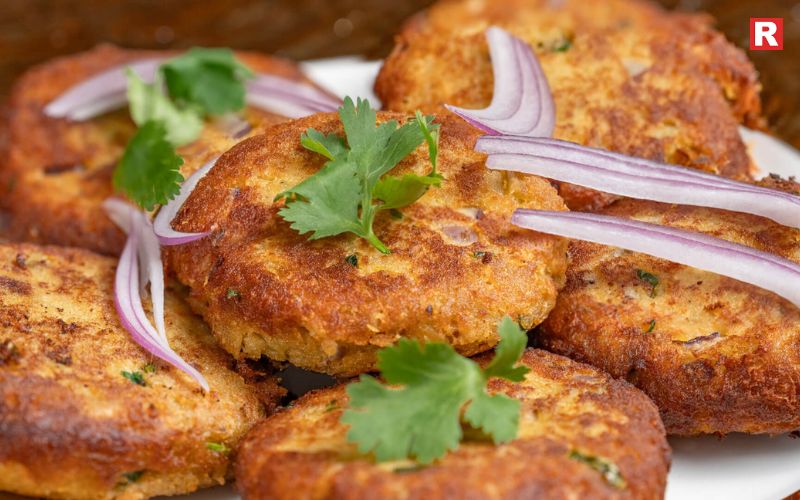
Shami Kebab is a classic that has found its way into homes and festivals alike. It is made from minced meat, chana dal, and a mix of spices that are boiled together, ground, and then shallow-fried into round patties. The result is a kebab that is crispy on the outside and soft inside. Shami Kebabs are often served during Eid or special occasions in Lucknow. They are also popular as tea-time snacks. Their lightness, rich aroma, and melt-in-the-mouth feel make them one of the most loved dishes across North India.
6. Patili Kebab
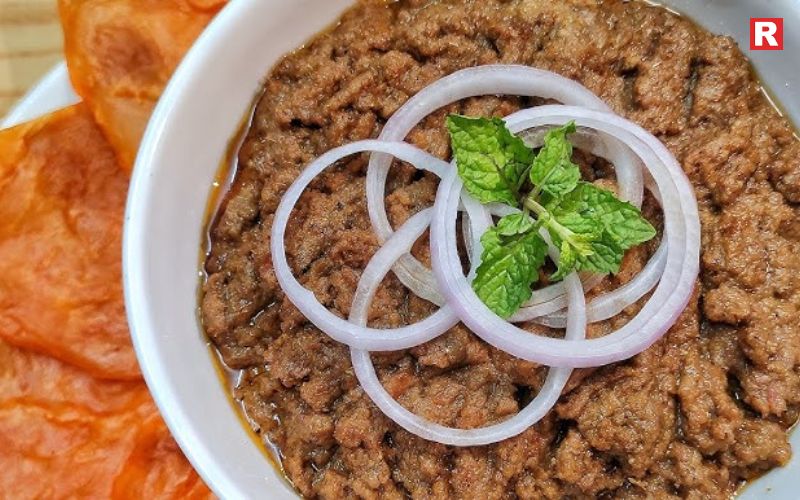
Patili Kebab is a lesser-known but equally delicious specialty of Lucknow. Unlike grilled kebabs, this one is cooked slowly in a deep pan, or “patili,” using ghee and delicate spices. The meat is simmered till it becomes tender and absorbs all the flavors. The result is a juicy and flavorful kebab that feels more like a home-cooked delicacy than a restaurant dish. It is often made with beef or mutton and served with parathas. Patili Kebabs represent the home-style side of Nawabi cuisine — rich, soulful, and comforting.
7. Ghilaafi Kebab
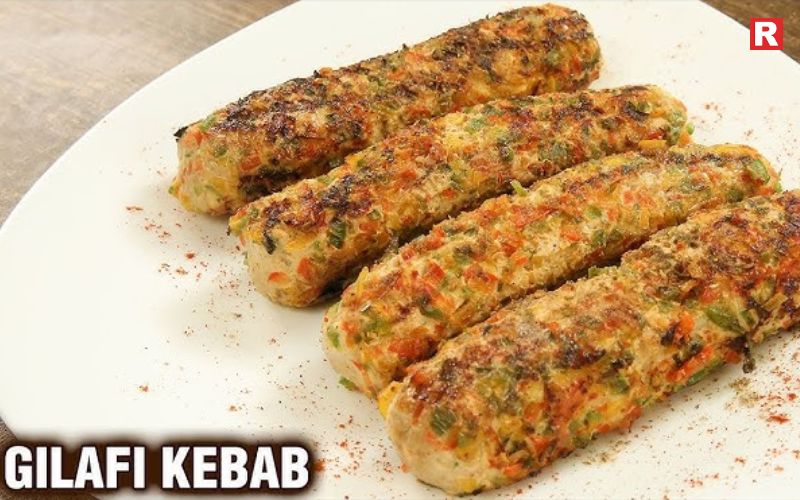
Ghilaafi Kebabs are a modern take on the traditional Awadhi kebabs. The word “Ghilaaf” means covering, and in this dish, the kebab is coated with a mix of egg and spices before grilling. This gives it a crisp outer layer while keeping the inside moist and tender. These kebabs are slightly spicy and full of flavor. The coating locks in the juices, ensuring every bite is soft and rich. Ghilaafi Kebabs are now a favorite in Lucknow’s fine-dining restaurants and are often served with mint chutney and salad. They showcase how the city continues to innovate while preserving its heritage.
8. Chapli Kebab (Lucknowi Version)
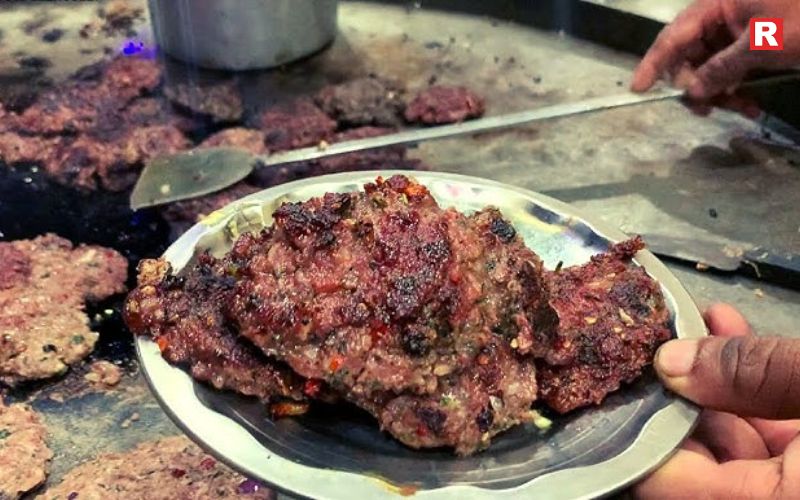
Though originally from Peshawar, the Chapli Kebab has found a home in Lucknow’s kitchens. The Lucknowi version is round, flat, and fried in ghee. It is made with minced meat, tomatoes, onions, green chilies, and crushed pomegranate seeds, giving it a tangy twist. Chapli Kebabs are crisp, flavorful, and slightly spicy. They make a perfect snack on a cold evening or a hearty meal when paired with naan. This kebab reflects Lucknow’s openness to adapting flavors while maintaining its signature finesse and richness.
Also check: Spice Up Your Meals with These 10 Authentic Indian Chutneys That Add a Burst
6 Odisha Cuisine: Where Simplicity Meets Soulful Flavour
A Bite of Banaras: 8 Iconic Street Foods You Can’t Miss in Varanasi
Taste the Nawab’s Favourite!
Lucknow’s kebabs are not just dishes; they are living pieces of history. They tell tales of royalty, tradition, and craftsmanship. From the melt-in-the-mouth Galouti to the smoky Seekh and the royal Kakori, every kebab has its own charm. The streets of Lucknow still carry the aroma of these timeless creations. At places like Aminabad, Chowk, and Hazratganj, the sizzle of kebabs fills the air every evening. For locals and travelers alike, tasting these kebabs is an experience—one that connects them to the city’s heart and heritage. In every bite, Lucknow’s kebabs remind us that great food is not just about taste, but about patience, passion, and history served on a plate.

India’s love affair with chutneys dates back centuries. In every Indian home, there’s one secret that turns a simple meal into a feast—chutney. These vibrant condiments are not just sides; they are flavour-packed companions that bring life to every dish. From the fiery red chilli chutneys of Andhra to the creamy coconut blends of Kerala, chutneys carry the taste of India’s diverse regions, each with its own identity and story.
Indian chutneys are made with fresh ingredients, often hand-ground using stone mortars or mixers, balancing spice, tang, and sweetness in every spoonful. Whether you enjoy them with dosa, samosa, rice, or even sandwiches, chutneys can elevate your everyday meals into something memorable. Let’s take a journey through India and explore ten authentic chutneys that define the essence of Indian cuisine.
Discover These 10 Authentic Indian Chutneys
1. Coconut Chutney (South India)
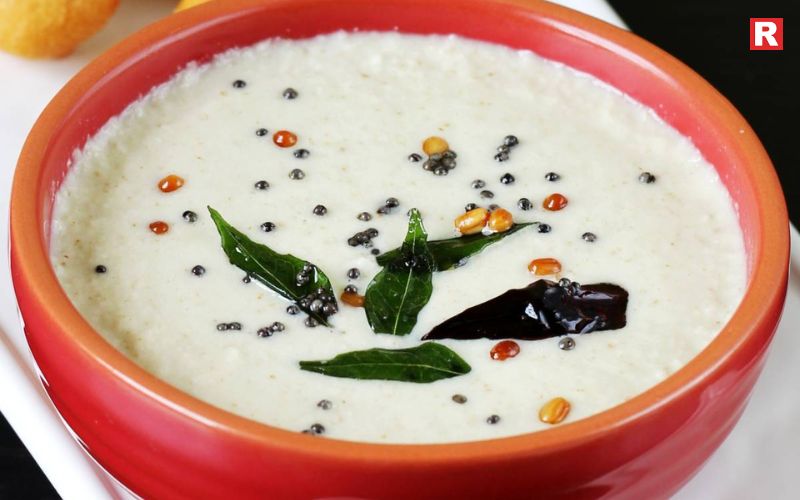
Coconut chutney is a classic South Indian favourite. Made with grated coconut, roasted chana dal, and tempered with mustard seeds, curry leaves, and dry chillies, it offers a mild yet refreshing flavour. The creamy texture and subtle sweetness of coconut pair beautifully with the crispness of dosa or the softness of idli and vada. In traditional homes, fresh coconuts are grated daily to make this chutney. Some regions add green chillies or raw mango for a tangy twist. This chutney cools the palate and balances spicy curries, making it a staple across South Indian breakfasts.
2. Mint-Coriander Chutney (North India)

One of India’s most refreshing chutneys, this vibrant green mix is made with fresh mint leaves, coriander, green chillies, lemon juice, and a hint of salt and cumin. It is tangy, spicy, and cooling—perfect for kebabs, chaats, or sandwiches. Street food vendors across Delhi and Mumbai never serve snacks without a spoonful of this chutney. It not only enhances flavour but also aids digestion. The freshness of herbs gives it a natural zing that makes every bite feel light and balanced.
Read more: 8 Famous Vegetarian Dishes of Uttar Pradesh and Their Timeless Legacy
5 Cities That Serve the Best Non-Vegetarian Street Food
3. Tamarind Chutney (Across India)
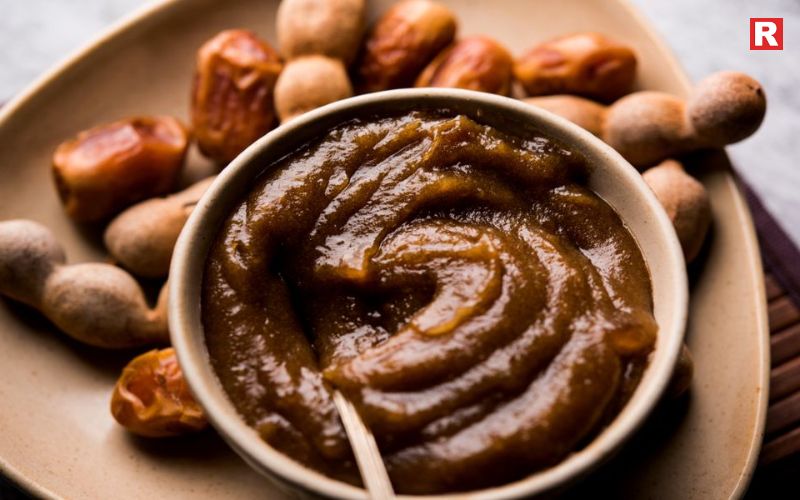
Known as imli ki chutney, this sweet and tangy blend is the heart of Indian street food. Made from tamarind pulp, jaggery, and roasted spices, it offers a beautiful balance between sour and sweet flavours. You’ll find this chutney served with samosas, pakoras, dahi puri, and bhel puri. Its smooth texture and dark brown colour make it instantly recognisable. Tamarind chutney brings harmony to spicy dishes, creating that perfect contrast Indians love.
4. Tomato Chutney (Andhra Pradesh)
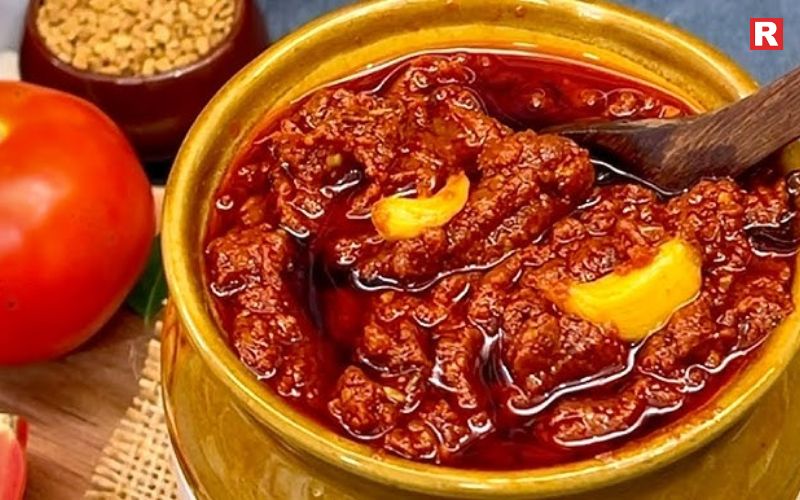
Tomato chutney is a bold and spicy option from the southern state of Andhra Pradesh, known for its love of chilli. It’s made with ripe tomatoes, garlic, dry red chillies, and mustard seeds, giving it a sharp and tangy taste. Served with dosas, upma, or steamed rice, it’s often made fresh each morning in South Indian kitchens. The aroma of tomatoes roasted with garlic gives a homely comfort, making this chutney a breakfast essential.
5. Peanut Chutney (Telangana)
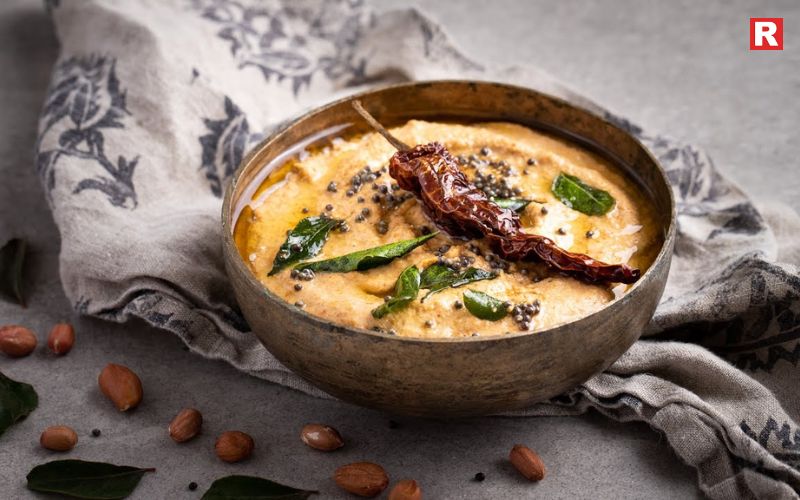
A rich and nutty chutney made from roasted peanuts, garlic, and tamarind, this Telangana specialty offers a creamy texture with a slightly tangy finish. It’s a great source of protein and adds a hearty feel to meals. Peanut chutney goes best with idlis and dosas, especially when drizzled with hot ghee. Some versions even include red chillies for a spicier punch. Its versatility and long shelf life make it a favourite across South India.
Also check: 10 Awadhi Cuisine Classics You Must Try at Least Once
6. Onion Chutney (Tamil Nadu)
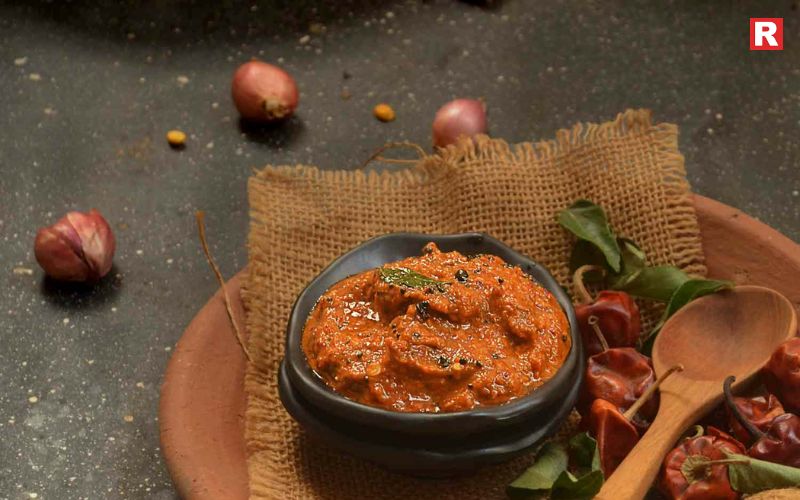
This chutney offers a perfect blend of sweet and spicy flavours. Made with caramelised onions, red chillies, tamarind, and a touch of jaggery, it’s slightly smoky and deeply savoury. Commonly served with ghee-laden dosas or rice, onion chutney adds warmth and depth to simple dishes. It’s also popular in rural households, where it is freshly ground using traditional methods to retain its authentic flavour.
7. Garlic Chutney (Maharashtra & Rajasthan)
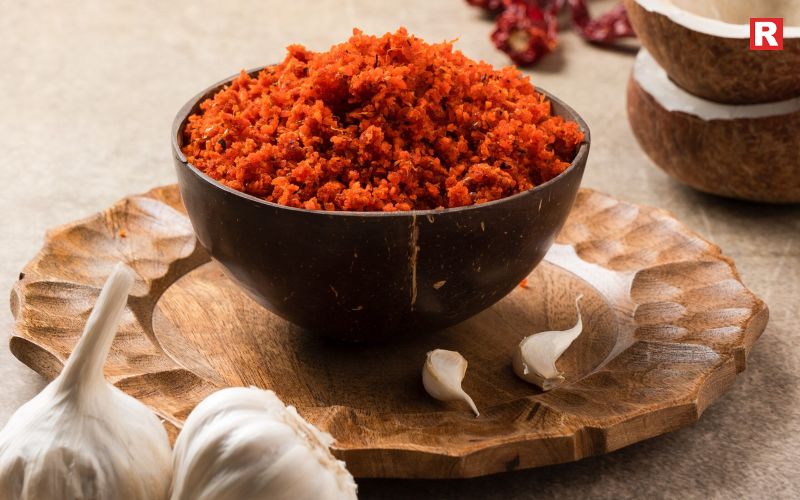
Garlic chutney is fiery, bold, and aromatic. It’s prepared with dry red chillies, garlic cloves, peanuts, and salt. The result is a coarse, spicy powder or paste that instantly livens up any dish. In Maharashtra, this chutney is an essential part of the iconic vada pav. In Rajasthan, it pairs beautifully with millet rotis or bhakri. It not only enhances the taste but also helps keep the body warm — ideal for colder regions.
8. Mango Chutney (Pan-India)
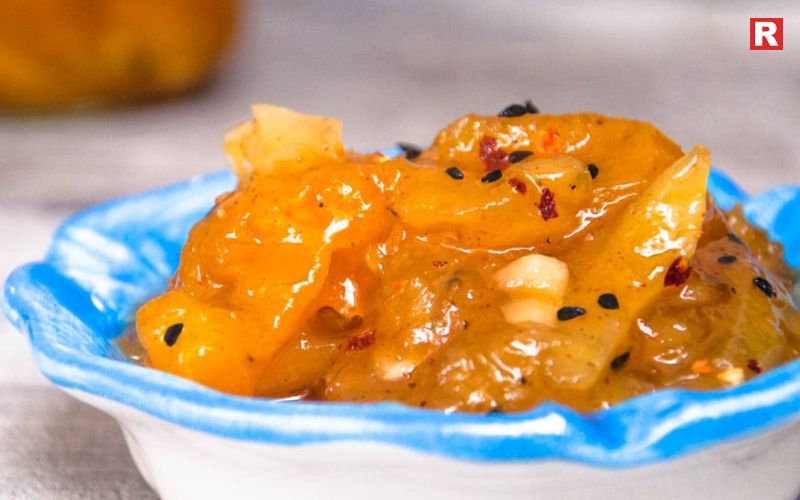
Known as aam ki launji in North India, mango chutney is a seasonal treat made from raw mangoes, sugar, and aromatic spices. It delivers a perfect mix of sweet, tangy, and spicy flavours. Every household has its own version — some like it syrupy, while others prefer a thicker texture. It’s commonly enjoyed with rice, parathas, or even as a spread. Mango chutney celebrates the Indian summer, making it a nostalgic favourite.
Know more: 6 Easy Pumpkin Seed Recipes with Surprising Health Benefits
9. Coconut-Pineapple Chutney (Goa & Coastal India)
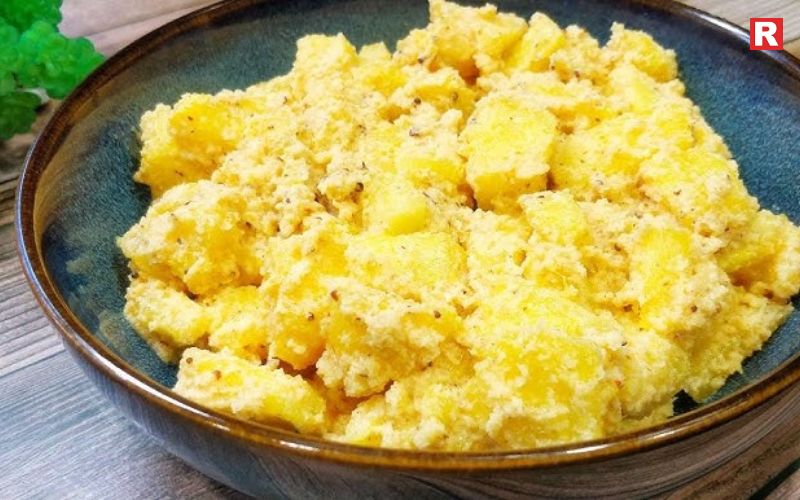
This tropical chutney from Goa brings a refreshing twist to traditional coconut chutney. It combines grated coconut, crushed pineapple, mustard seeds, and a hint of green chilli. The result is a sweet and tangy flavour that pairs beautifully with Goan seafood dishes and curries. Influenced by Portuguese cuisine, this chutney adds a fruity freshness to coastal meals. Its balance of sweetness and spice reflects the laid-back, sunny charm of Goan kitchens.
10. Curry Leaf Chutney (Karnataka)
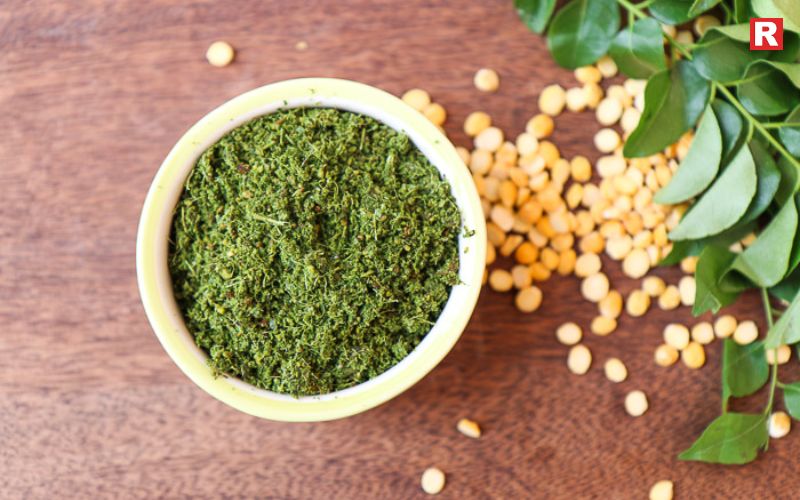
Made from fresh curry leaves, urad dal, and tamarind, this chutney is earthy, aromatic, and packed with nutrients. Curry leaves are known for their rich iron content and medicinal properties. The chutney has a distinctive flavour that complements rice, dosa, or chapati. In Karnataka households, it is often prepared as a health booster — light, herbal, and comforting.
Health Benefits of Indian Chutneys
Indian chutneys aren’t just tasty; they’re healthy too. Ingredients like mint, coriander, garlic, and Tamarind and other natural ingredients in Indian chutneys aid digestion and support gut health. They are rich in antioxidants, vitamins, and minerals that help the body stay healthy. When made at home, these chutneys are free from chemicals and preservatives, making them a pure and wholesome part of daily meals.
Including a small portion of chutney in everyday food can enhance both flavour and nutrition. Fresh herbs like mint, coriander, and curry leaves not only add taste but also provide essential nutrients that help in cleansing the system.
Key Benefits:
- Helps in digestion and boosts gut health
- Provides natural antioxidants and vitamins
- Made from fresh, preservative-free ingredients
- Enhances the taste of meals naturally
- Supports overall health when eaten regularly
Homemade chutneys are a simple, tasty, and healthy way to balance meals every day.
Also check: 6 Odisha Cuisine: Where Simplicity Meets Soulful Flavour
8 Famous Street Foods of Agra You Can’t Miss
Top 5 States With the Spiciest Food in India
Final Thought!
No Indian meal is complete without chutney. It’s the element that ties the entire plate together — adding spice, balance, and character. Whether it’s a dollop of mint chutney on samosas or coconut chutney beside steaming idlis, these condiments bring warmth and nostalgia to every bite.
Indian chutneys showcase the country’s culinary diversity, passed down from one generation to another. So, the next time you cook, try adding a touch of these authentic chutneys to your meal. Because in India, chutney isn’t just a side — it’s the soul that binds the flavours of the meal together.

Small but mighty — pumpkin seeds are among the healthiest foods you can add to your diet. These tiny green seeds, also known as pepitas, are packed with nutrients that support your heart, hair, skin, and overall well-being. Whether you sprinkle them over your salad, blend them into a smoothie, or roast them for a quick snack, pumpkin seeds can transform your meals in minutes.
In India, people are becoming more health-conscious and are constantly looking for simple, natural ingredients that offer multiple benefits. Pumpkin seeds perfectly fit this trend. They are rich in magnesium, zinc, protein, healthy fats, and antioxidants — all essential for maintaining energy and immunity. In this article, we’ll explore six easy and delicious pumpkin seed recipes that are not just wholesome but also surprisingly simple to make.
Why Pumpkin Seeds Deserve a Place in Your Diet
Pumpkin seeds may be small, but their nutritional value is impressive. A single handful contains enough nutrients to boost your energy, improve your mood, and even help you sleep better. They are an excellent source of plant-based protein, healthy fats, and essential minerals like magnesium, iron, and zinc.
Key Health Benefits:
- Improves heart health: Healthy fats and antioxidants help reduce bad cholesterol and support cardiovascular function.
- Promotes better sleep: Pumpkin seeds contain magnesium and tryptophan, which naturally improve sleep quality.
- Supports immunity: Zinc helps build resistance against infections.
- Enhances hair and skin health: The combination of vitamin E, zinc, and antioxidants keeps skin glowing and hair strong.
- Aids digestion: Their fiber content supports gut health.
6 Easy Pumpkin Seed Recipes to Try at Home
1. Pumpkin Seed Chutney
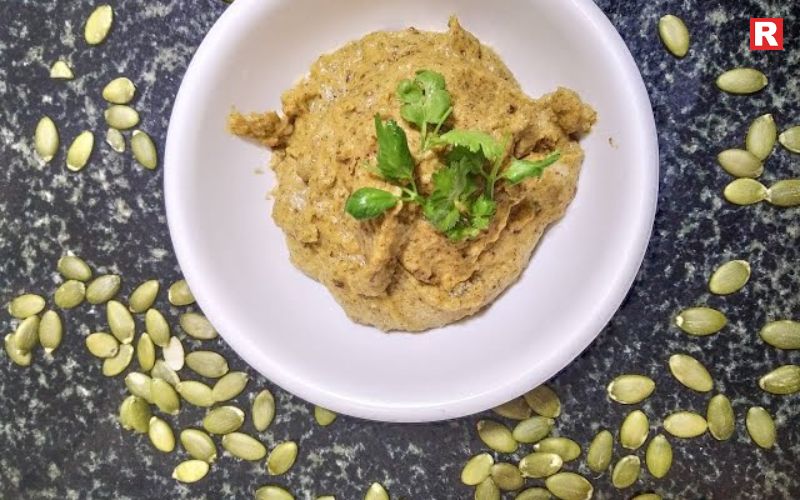
Pumpkin Seed Chutney is a South Indian-style condiment that adds both flavour and nutrition to any meal. It is made using roasted pumpkin seeds blended with garlic, green chillies, tamarind, and roasted chana dal. The chutney has a nutty taste with a slight tang, making it a perfect side dish for idlis, dosas, or parathas. It can be prepared quickly and stored for a few days in the refrigerator. The texture is smooth, and the flavour is bold yet balanced. Pumpkin seeds add a rich source of protein, magnesium, and zinc, which support overall health. This chutney offers a healthy alternative to traditional coconut or peanut chutneys while bringing a delicious twist to everyday Indian meals.
- Ingredients: Pumpkin seeds, roasted chana dal, garlic, green chilies, tamarind, salt, and water.
- Method: Dry roast pumpkin seeds until they puff slightly. Blend with other ingredients until smooth. Serve with idlis, dosas, or parathas.
- Health highlight: Rich in protein and zinc, this chutney adds a nutritious boost to your morning meal.
2. Honey-Roasted Pumpkin Seeds

Honey-Roasted Pumpkin Seeds are a quick and healthy snack loved for their sweet and crunchy taste. The seeds are mixed with honey, a pinch of cinnamon, and a little salt before roasting. Once baked, they turn golden and crisp with a caramel-like coating. This snack is light, satisfying, and perfect for mid-day cravings. It can be stored in an airtight jar and enjoyed anytime. The combination of honey and pumpkin seeds gives natural sweetness and a dose of energy. These seeds are rich in magnesium and antioxidants, which support heart health and immunity. Honey-Roasted Pumpkin Seeds make a wholesome option for those who prefer guilt-free snacking with a balance of taste and nutrition in every bite.
- Ingredients: Pumpkin seeds, honey, a pinch of cinnamon, and sea salt.
- Method: Coat seeds with honey and cinnamon, spread on a tray, and roast at 180°C for 10–12 minutes. Let them cool before storing.
- Health highlight: Perfect for mid-day snacking, these seeds help curb sugar cravings while stabilizing blood sugar levels.
Read more: 8 Famous Vegetarian Dishes of Uttar Pradesh and Their Timeless Legacy
5 Cities That Serve the Best Non-Vegetarian Street Food
3. Pumpkin Seed & Yogurt Smoothie

The Pumpkin Seed & Yogurt Smoothie is a creamy and nutritious drink that works well for breakfast or after exercise. It is made by blending pumpkin seeds with yogurt, banana, honey, and a little milk until smooth. The smoothie has a rich texture and a mild, nutty flavor. It provides a good amount of protein and healthy fats, making it filling and energizing. The banana adds natural sweetness, while the yogurt makes it light and easy to digest. This drink can be prepared in just a few minutes. It supports digestion, boosts energy, and helps with muscle recovery. The addition of pumpkin seeds also adds magnesium and zinc, making it a healthy choice for daily nutrition.
- Ingredients: Pumpkin seeds, yogurt, banana, honey, and a splash of milk.
- Method: Blend all ingredients until smooth. Serve chilled.
- Health highlight: This smoothie improves gut health and provides lasting energy. It’s also a great alternative to heavy protein shakes.
4. Pumpkin Seed Trail Mix
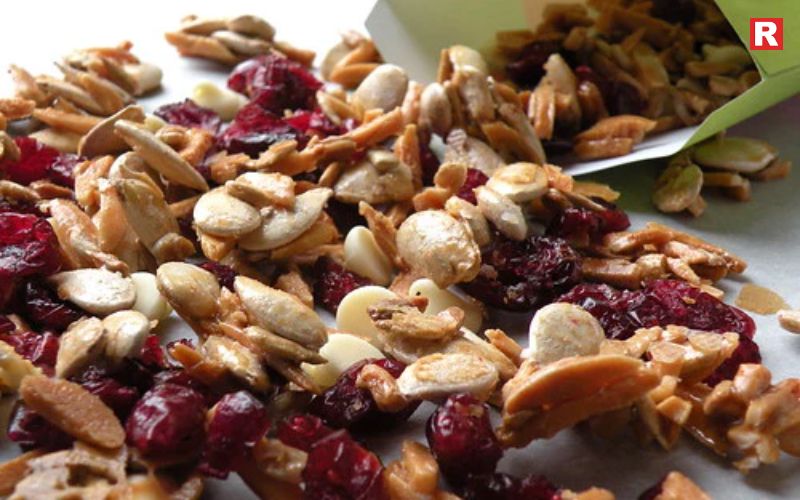
Pumpkin Seed Trail Mix is a simple and healthy snack that can be carried anywhere. It is made by mixing roasted pumpkin seeds with almonds, raisins, cranberries, and a pinch of salt. The combination gives a crunchy, sweet, and slightly salty taste that is very satisfying. It does not require cooking and can be stored in an airtight container for several days. This mix is rich in protein, fiber, and healthy fats, making it a great choice for quick energy. It is ideal for office breaks, travel, or after a workout. The pumpkin seeds add magnesium and zinc, while the nuts provide extra protein. Pumpkin Seed Trail Mix is a convenient snack that is both tasty and nutritious.
- Ingredients: Roasted pumpkin seeds, almonds, cranberries, raisins, and a pinch of salt.
- Method: Mix all ingredients in a bowl and store in an airtight jar.
- Health highlight: Packed with fiber, protein, and iron, this trail mix is a great travel or office snack that keeps you energized throughout the day.
Know more: 10 Authentic Korean Rice Dishes One Must Try On Your Next Visit To Korea
5. Pumpkin Seed Pesto
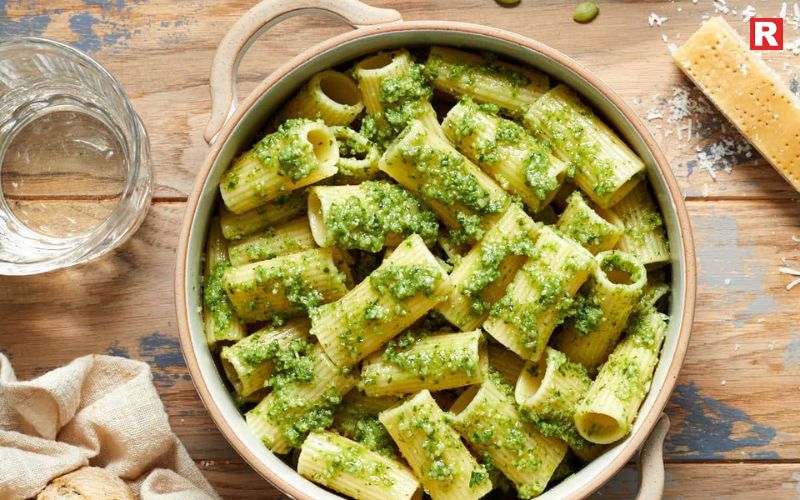
Pumpkin Seed Pesto is a simple and flavorful variation of the classic Italian sauce. It is made by blending roasted pumpkin seeds with fresh basil leaves, garlic, olive oil, and lemon juice. Parmesan cheese can be added for extra taste, but it is optional. The pesto has a nutty and earthy flavor with a fresh aroma from the basil. It can be used as a sauce for pasta, a spread on bread, or a dip for vegetables. Pumpkin seeds add protein, magnesium, and antioxidants, making the pesto nutritious as well as tasty. This easy recipe can be prepared in minutes and stored in the refrigerator. Pumpkin Seed Pesto brings a healthy twist to everyday meals.
- Ingredients: Pumpkin seeds, basil leaves, garlic, olive oil, lemon juice, and Parmesan cheese (optional).
- Method: Blend all ingredients until smooth. Use as a pasta sauce, dip, or spread.
- Health highlight: Rich in antioxidants and healthy fats, this pesto supports heart health and adds a gourmet touch to simple dishes.
6. Pumpkin Seed Energy Bars
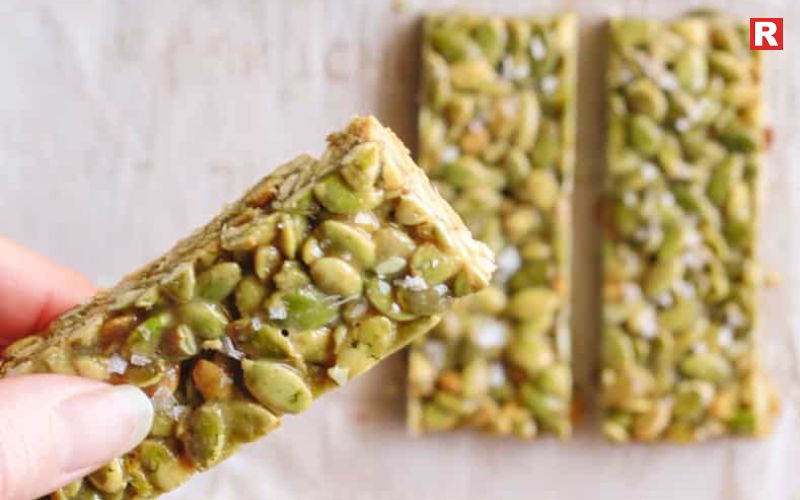
Pumpkin Seed Energy Bars are a simple and healthy snack that requires no baking. They are made by mixing pumpkin seeds with oats, dates, honey, and peanut butter. The ingredients are blended together and pressed into a tray. After chilling for an hour, the mixture is cut into bars. These bars are chewy, slightly sweet, and full of energy. They are perfect for breakfast, post-workout snacks, or a quick bite during the day. Pumpkin seeds provide protein, magnesium, and healthy fats, while oats and dates add fiber and natural sweetness. The bars can be stored in the refrigerator for several days. Pumpkin Seed Energy Bars are easy to make and a convenient way to enjoy a nutritious snack anytime.
- Ingredients: Pumpkin seeds, oats, dates, honey, and peanut butter.
- Method: Blend dates until smooth, mix with other ingredients, and press into a tray. Chill for an hour, then cut into bars.
- Health highlight: These bars provide a natural energy boost, perfect for workouts or busy mornings.
Know more: 10 Awadhi Cuisine Classics You Must Try at Least Once
How to Add Pumpkin Seeds to Your Everyday Diet
You don’t always need to follow a recipe to enjoy the benefits of pumpkin seeds. Here are a few simple ways to include them in your meals:
- Sprinkle over salads, soups, or stir-fries for a nutty crunch.
- Add to breakfast cereals, granola, or yogurt.
- Blend into smoothies or homemade dips for added creaminess.
- Use as a crust or topping for fish, chicken, or tofu.
- Mix into doughs and batters for extra texture and nutrition.
Adding just two tablespoons of pumpkin seeds daily can help maintain a healthy balance of nutrients in your diet.
Surprising Health Benefits You Didn’t Know
Pumpkin seeds go beyond basic nutrition. They have unique compounds that benefit both physical and mental health.
1. Better Sleep: They are one of the few plant sources of tryptophan, an amino acid that helps promote deep, restful sleep. When combined with magnesium, it can naturally improve your sleep cycle.
2. Hormonal Balance: Pumpkin seeds help regulate hormonal changes, especially in women. They are a great addition for maintaining reproductive health due to their zinc and omega-3 fatty acids.
3. Heart Support: The antioxidants in pumpkin seeds help reduce inflammation and improve circulation, lowering the risk of heart disease.
4. Glowing Skin: Vitamin E and natural oils in the seeds protect skin from oxidative stress, giving it a healthy, youthful glow.
5. Hair Growth: High zinc and iron content support strong hair follicles and reduce hair fall, making these seeds a natural supplement for healthy hair.
Also check: 8 Famous Street Foods of Agra You Can’t Miss
10 Different Types of South Indian Rice Dishes
5 Main Types of French Wine You Must Know
Final Thought!
Pumpkin seeds are truly one of nature’s hidden treasures. They combine health, taste, and versatility in every handful. Whether you make a spicy chutney, a smooth pesto, or an energy bar, these seeds add a wholesome touch to your meals. Their rich nutritional value supports better sleep, glowing skin, strong hair, and overall vitality. Adding them to your daily diet is simple and rewarding — proof that sometimes, the smallest ingredients make the biggest difference. Try these six easy pumpkin seed recipes and see how these tiny seeds can transform your food and health. Start small, stay consistent, and enjoy the long-term benefits of this powerful superfood.

When it comes to street food, India doesn’t just play the game; it has pretty much invented its own league. You won’t find chaat that wild, colorful, and absolutely packed with flavor anywhere besides India. When we talk about chaat, we’re talking tangy tamarind chutney, spicy masalas, cool yogurt, and that unforgettable crunch. And chaat isn’t just a bite on the go. It’s a whole vibe, a swirl of tradition, chaos, and joy.
Chaat originated on the bustling streets of North India, and the name says it all. “Chaat” literally means “to lick,” and if you’ve ever eaten it, you know why. One bite and you’re hit with sweet, spicy, sour, and salty, all at once. Over time, chaat has taken on a life of its own. Delhi loves its creamy Dahi Bhalla, Mumbai is known for its Bhel Puri, and in Kolkata, Puchkas bring the heat. Every city seems to have its own take, and honestly, that’s only half the fun.
Every region brings something different to the table, so every chaat you eat will have a flavor of its own. Here’s a list of the top 10 chaat dishes you absolutely need to try. Each one is totally its own thing, impossible to resist, and worth seeking out right now.
Read more: Fast Food: 7 Most Fiery Street Foods in India
1. Pani Puri / Golgappa / Puchka
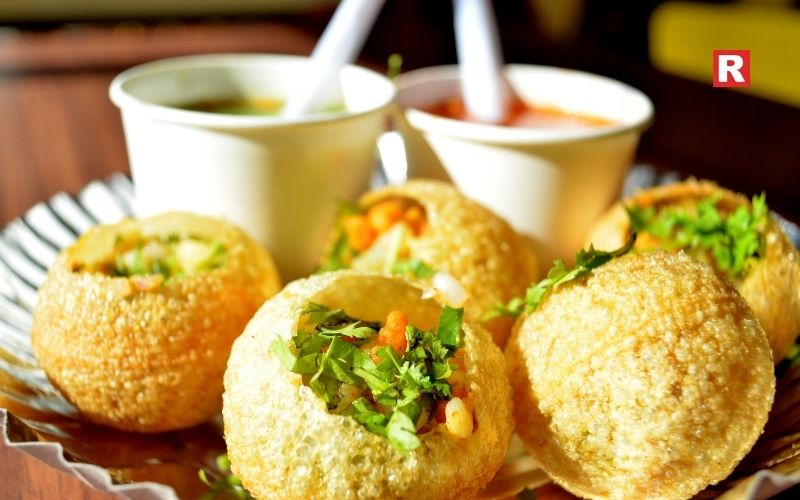
You can start a full-blown argument over what to call it, Pani Puri in Mumbai, Golgappa in Delhi, Puchka in Kolkata, but everyone agrees it’s the boss of Indian street food. Tiny, crispy puris get stuffed with spicy-tangy water, mashed potatoes, chickpeas, and secret spice blends. Delhi likes theirs sweet and a little sour, Mumbai keeps it tangy, and Kolkata’s version has a sharp mustard kick. You eat the whole thing in one shot, and the flavors just explode. It's total bliss for chaat lovers.
2. Aloo Tikki Chaat
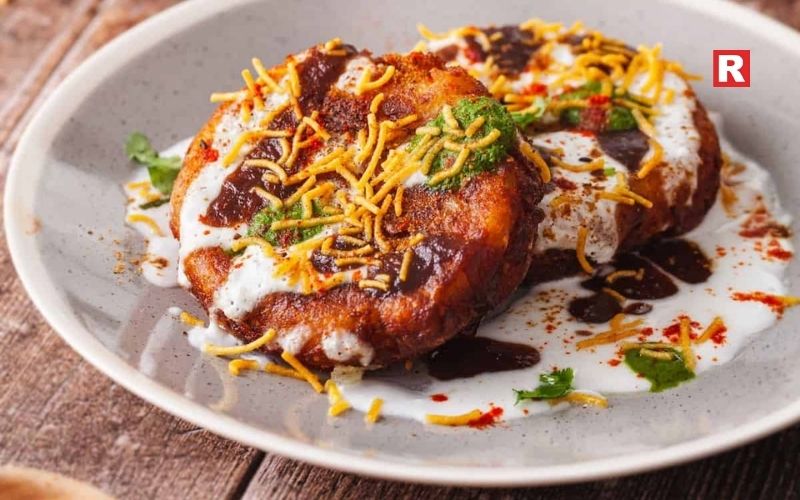
This is North India’s comfort food, especially in Delhi and Lucknow. Start with plating golden, crispy potato patties on a plate. Then pile on yogurt, sweet and minty chutneys, fresh onions, and crunchy sev. You get hot and cold, crispy and creamy, sweet, spicy, and tangy, all in one plate. Delhi’s crowded alleyways or the old-school markets in Lucknow are the best spots to find a good plate of aloo tikki.
3. Dahi Bhalla / Dahi Vada
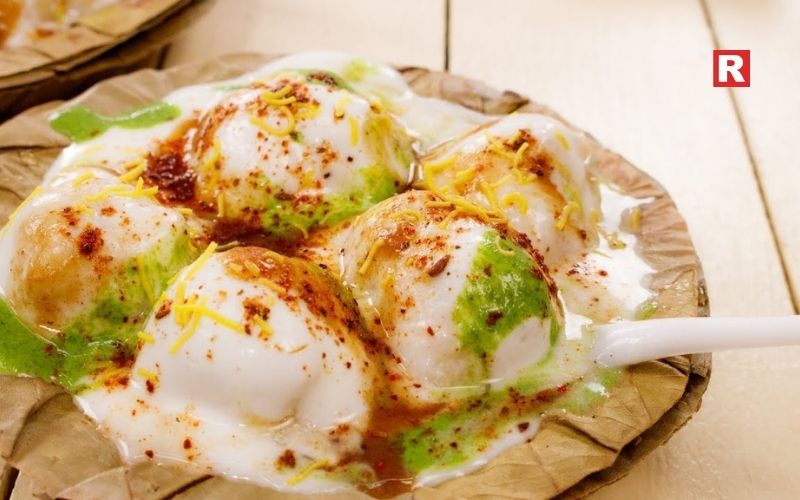
Dahi Bhalla is the best way to feel the cool breeze of chaat. Soft, pillowy lentil dumplings (vadas) made from urad dal get dipped in silky yogurt and topped with tamarind and mint chutneys, cumin, and chili powder. Everything chills together, so it’s creamy, just a little sweet, and perfectly tangy. This is the perfect chaat to eat on a hot summer day.
Know more: 10 Leading Burger Chains With the Most Outlets in India
4. Papdi Chaat

This is where simple ingredients turn into something magical. Papdi Chaat is all about layers: crisp fried wafers, boiled potatoes, chickpeas, yogurt, chutneys, a sprinkle of sev, and chaat masala. Crunchy, creamy, tangy makes it feel part snack, part dessert. In Delhi, you’ll spot it at every street stall, and honestly, one plate is never enough.
5. Bhel Puri
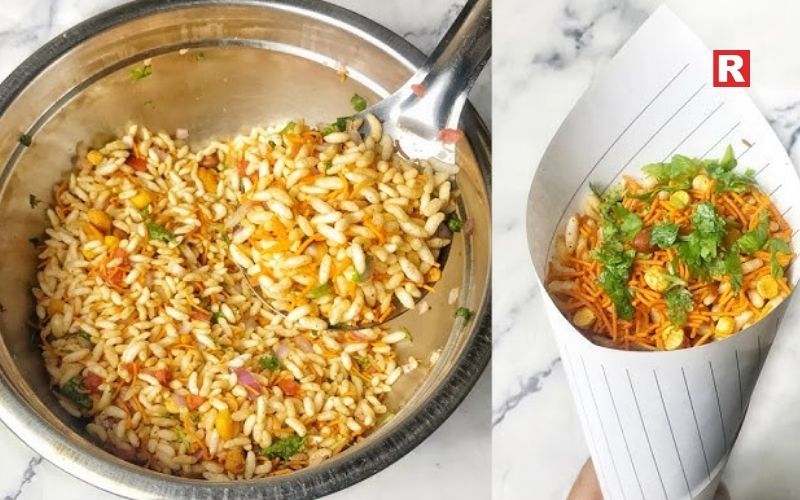
Bhel Puri is a chaat that defines Mumbai. It’s light, tangy, and crunchy with every bite. Made with puffed rice, onions, tomatoes, and coriander, all tossed with chutneys and sev. Vendors whip it up right in front of you and alter the spice to your taste. This mix of crispy rice and juicy veggies is addictive. Take a stroll down Marine Drive or Juhu Beach, and you’ll know the powerful flavor of such a simple snack.
6. Sev Puri
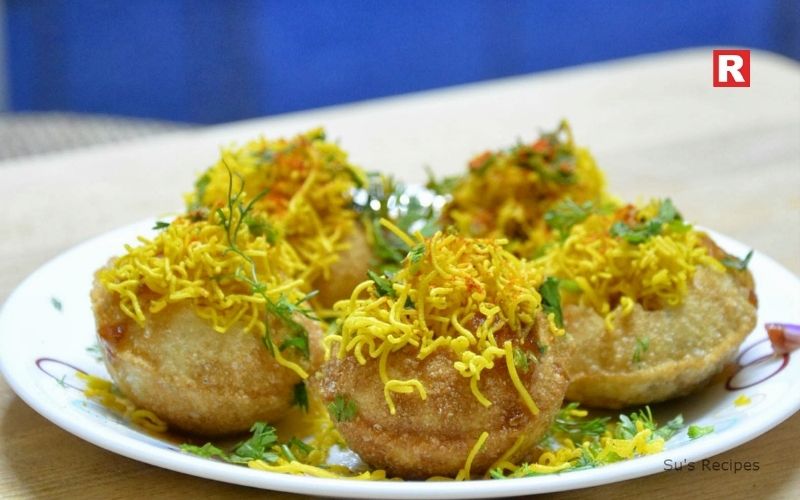
Again, a specialty of Mumbai. Sev Puri is like a flavor party: flat puris loaded with potatoes, onions, tomatoes, a hit of tamarind and mint chutneys, and a mountain of crispy sev. Every bite is a perfect storm: sweet, spicy, tangy, crunchy. You’ll find it everywhere in the city, from roadside stalls to fancy cafés, but the best ones are always at the classic street carts.
7. Raj Kachori

This is the chaat’s royal version. Raj Kachori is huge, golden, and packed with all the good stuff: potatoes, sprouts, chickpeas, curd, chutneys, spices, sev, sometimes even pomegranate seeds. Crunchy outside, creamy and zesty inside, it’s richer than most other chaats. People save it for festivals or special trips to chaat houses in Rajasthan and North India.
8. Samosa Chaat
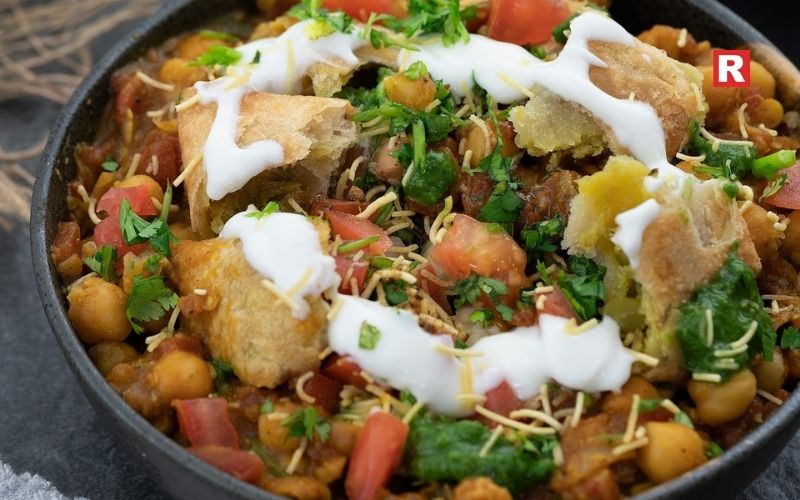
Samosa Chaat takes India’s iconic snack and turns it into a meal you can’t put down. Vendors crush fresh samosas, smother them with spicy chickpea curry, then top with curd, chutneys, onions, and coriander. The flaky pastry soaks up the spicy, sour gravy, and every bite is comfort food at its best. This is the perfect snack for rainy evenings. It is satisfying, filling, and totally addictive.
What's new: 20 Pasta Dishes You Must Try at Least Once
9. Katori Chaat / Tokri Chaat
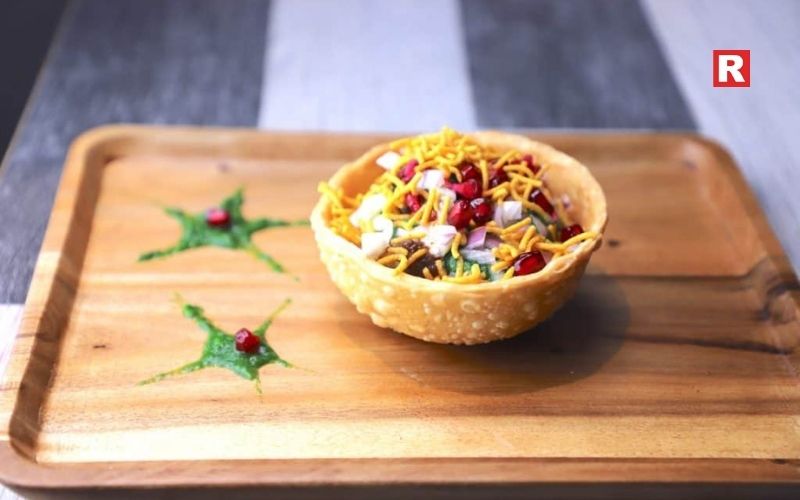
It is a specialty of Lucknow and Mumbai. Think of Katori Chaat (or Tokri Chaat) as chaat within an edible bowl. Instead of a regular plate, you get a crispy basket, deep-fried and made entirely from shredded potatoes. People fill these edible bowls with layers of spiced chickpeas, more potatoes, cool yogurt, bright chutneys, and a sprinkle of crunchy sev. It looks almost too good to eat, but trust me, you’ll want to devour every bit, basket and all. You can spot it at weddings and food festivals, especially around Lucknow and Mumbai. It’s a crowd-pleaser that’s as pretty as it is irresistible.
10. Chole Tikki / Ragda Pattice
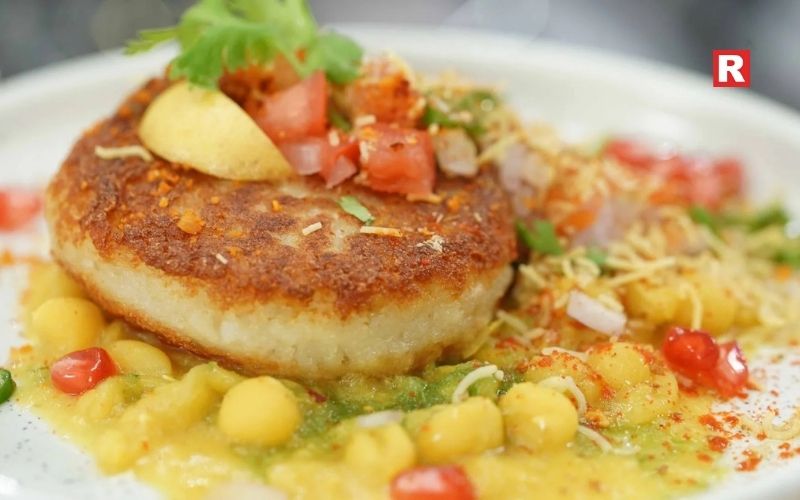
Chole Tikki and Ragda Pattice feel like cousins separated by geography but united by love for potatoes and chickpeas. Chole Tikki is from North India, and Ragda Pattice from Western India. Chole Tikki (from the North) is made with crispy potato patties, aloo tikkis, topped with spicy Punjabi chole, plus chutneys and raw onions for that extra kick.
In Mumbai, Ragda Pattice takes those potato patties and drowns them in a white peas curry (that’s the ragda), then finishes things off with chutneys and crunchy sev. Both versions hit that sweet spot: spicy, crunchy, warm, and comforting, especially when the monsoon’s in full swing and you’re craving something soulful from a street cart.
Check out: 10 Best Snacks without Onion and Garlic you can order today
Comparing Fast Food vs. Fine Dining: Which Is Right for Your Restaurant
Regional Highlights
The fun thing about chaat is that it is not just one dish. It has variants, and they are all different according to their place of origin.
Walk through Delhi or anywhere up North, and you’ll find chaats rich with yogurt, like Dahi Bhalla, Aloo Tikki, or Papdi Chaat. Mumbai, on the other hand, goes for tangy, drier chaats like Bhel Puri and Sev Puri, which are perfect for snacking as you rush to catch a train. Kolkata’s chaat is bolder, spicier, with puchkas (their version of pani puri) and a punch of mustard in the water. In Lucknow and Banaras, you get heartier, aromatic chaats like Matar Chaat and Tokri Chaat. Every city puts its own stamp on chaat, turning it into a reflection of local flavors and traditions.
Common Ingredients & Flavor Profile
What makes chaat so addictive? It’s all about the mixture of ingredients you are getting on one plate. While it is questionable whether adding ingredients of different flavor profiles can create something inedible. However, the mere existence of chaat proves this wrong. Chaat is everything at once. It is sweet, sour, and spicy, all at once. This is because chaat is made using layers of different flavors. And each ingredient complements the other. Giving us the result that is a treasure worth keeping in your stomach.
You get sweetness from dates or jaggery chutney, a sharp tang from tamarind or lemon, heat from chili and chaat masala, crunch from papdi or sev, and a creamy hit from thick yogurt. Every bite’s a wild ride: sweet, sour, spicy, crunchy, creamy, no wonder you can’t stop at just one plate.
Tips to Enjoy Chaat
- Eat it right after it’s made—wait too long, and you lose that perfect crunch.
- Trust the local street vendors. Nobody does chaat better.
- Spice is personal—don’t be shy to ask for more or less.
- Pair your chaat with jaljeera, lassi, or a cold masala soda to round out the experience.
Learn more: 10 Tibetan Dishes That Will Warm Your Soul
Enjoying The Flavors
Chaat is pure joy, no matter where you eat it, from the chaos of Chandni Chowk or the breeze of Mumbai’s beaches. It’s the soul of Indian street food. It is messy, colorful, and totally unforgettable. Just like the different cultures of India, which may be different but still complement each other. This is why chaat represents the country perfectly. Every serving is more than a snack; it’s a piece of India’s food story, a showcase of bold flavors and creativity.
So next time you’re craving something tangy, crunchy, and fun, skip the fancy spots. Head to a chaat stall, try one (or all) of these legendary dishes, and taste India, taking one mouthwatering bite at a time.

We all have those days when cooking feels like a task. You’re rushing to work, have back-to-back meetings, or are simply too tired to stand by the stove. That’s where fireless food comes to the rescue. Fireless dishes are smart, quick, and surprisingly delicious. You don’t need gas, pans, or complicated steps—just simple ingredients, a little creativity, and a few minutes of your time.
These dishes are perfect for students living in hostels, professionals looking for quick lunch ideas, or anyone trying to eat healthy without spending hours in the kitchen. From creamy yogurt bowls to crunchy salads, fireless recipes save time without compromising on taste or nutrition. They also promote mindful eating—helping you focus on freshness and balance rather than heavy cooking. Here are six easy and healthy fireless food dishes that you can prepare anywhere, anytime. Each recipe is designed to be wholesome, filling, and incredibly easy to make.
Why Choose Fireless Meals?
Fireless meals are not just convenient; they’re also a smart lifestyle choice. They suit busy schedules and small spaces while promoting healthy eating habits. Here’s why they work so well:
- Quick and Easy: Perfect for those short on time.
- Safe for All Ages: Kids can prepare them safely without fire or sharp tools.
- Healthy and Light: Most fireless dishes use fresh ingredients and minimal oil.
- Eco-Friendly: Saves fuel and reduces kitchen heat.
- Ideal for Travel and Office: Easy to carry and can be prepared anywhere.
Fireless food is about creating balanced meals with simple ingredients. It’s proof that healthy food doesn’t always need to be cooked—it just needs to be assembled thoughtfully.
Top 6 Fireless Food Dishes
1. Chilled Cucumber Yogurt Bowl
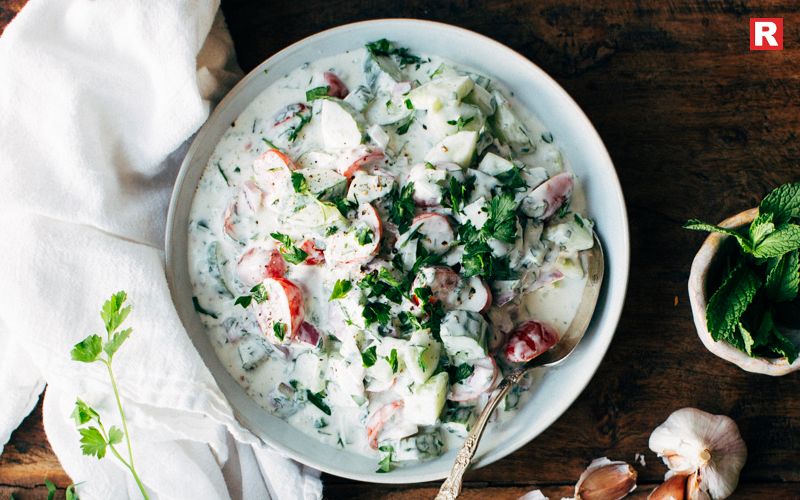
The chilled cucumber yogurt bowl is a simple and healthy dish. It is perfect for hot days when a light meal is needed. Fresh cucumber adds a cool and crisp texture. Yogurt makes the dish creamy and rich in protein. Mint leaves bring a fresh aroma and taste. A pinch of salt and roasted cumin powder enhances the flavor. It is quick to prepare and requires no cooking. This dish can be served as breakfast, lunch, or a snack. It is both refreshing and filling. The ingredients are easy to find and can be adjusted according to taste. The chilled cucumber yogurt bowl is a practical choice for anyone looking for a healthy, no-cook meal that is satisfying and light.
Ingredients:
- 1 cup thick yogurt (or Greek yogurt)
- 1 cucumber (grated or chopped)
- A handful of mint leaves
- Salt, pepper, and roasted cumin powder
How to Make: Mix yogurt, cucumber, and mint leaves in a bowl. Add a pinch of salt, pepper, and cumin. Stir well and serve chilled.
Why It’s Great: It’s hydrating, light, and rich in probiotics. Perfect for lunch or as a post-workout meal.
2. Classic Veggie Sandwich
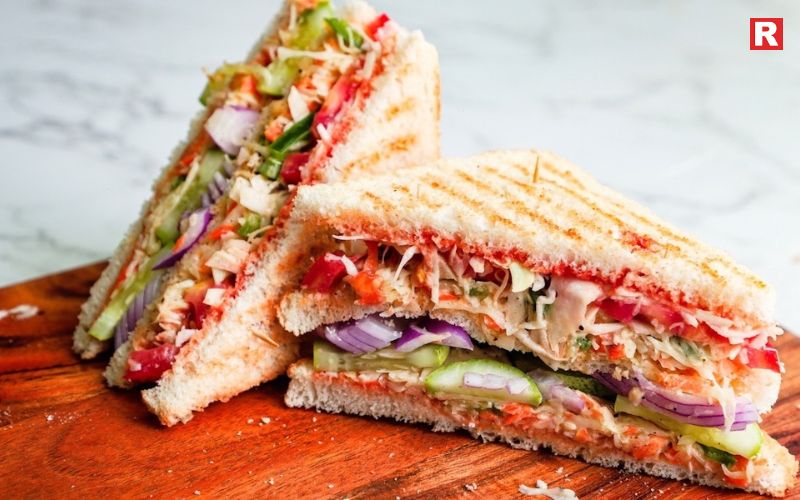
The classic veggie sandwich is a simple and satisfying meal. It is popular for its quick preparation and fresh taste. Slices of cucumber, tomato, onion, and lettuce make it colorful and crunchy. Cheese or a light spread adds creaminess and flavor. Bread can be whole wheat, multigrain, or white, depending on preference. The sandwich is easy to customize with different vegetables or sauces. It can be served as breakfast, lunch, or a snack. It requires no cooking and can be made in minutes. This dish is perfect for busy days or for packing in lunchboxes. The classic veggie sandwich is a healthy, convenient, and tasty option for anyone who wants a quick, light meal.
Ingredients:
- Whole wheat or multigrain bread slices
- Sliced cucumber, tomato, onion, and lettuce
- Cheese slices or a light spread (like hummus or mayo)
- Salt, pepper, and herbs
How to Make: Layer the vegetables between two slices of bread. Add seasoning and your favorite spread. Cut diagonally and serve fresh.
Why It’s Great: It’s filling, easy to carry, and ideal for breakfast or lunch. You can switch up the fillings for variety.
Read more: 8 Famous Vegetarian Dishes of Uttar Pradesh and Their Timeless Legacy
10 Awadhi Cuisine Classics You Must Try at Least Once
3. Sprout and Peanut Chaat
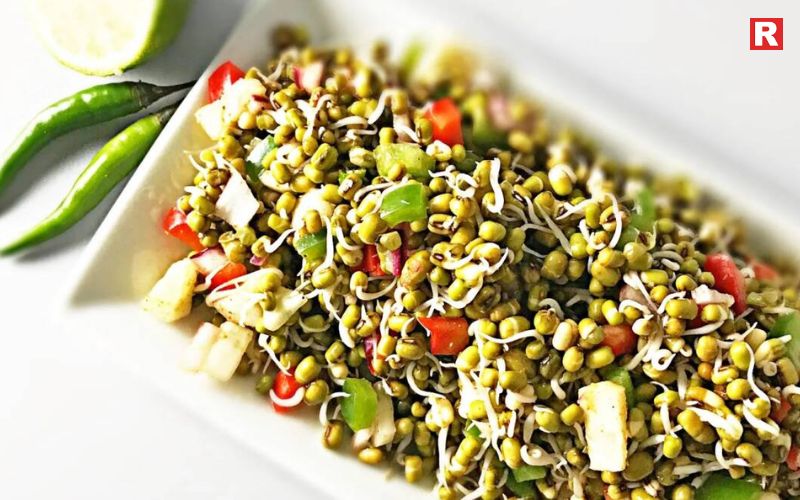
Sprout and peanut chaat is a popular Indian snack. It is healthy, filling, and easy to make. The dish combines protein-rich sprouts with crunchy roasted peanuts. Chopped onions, tomatoes, and coriander add freshness and color. A squeeze of lemon juice gives it a tangy flavor. A pinch of salt and chaat masala enhances the taste. Some people add boiled potato for extra texture. It can be served as a snack or a light meal. The ingredients are simple and easy to find. Sprout and peanut chaat is quick to prepare and requires no cooking. It is nutritious, flavorful, and perfect for anyone looking for a healthy, fireless dish that satisfies hunger.
Ingredients:
- 1 cup mixed sprouts (moong, moth beans)
- 1 small onion and tomato (finely chopped)
- 1 small boiled potato (optional)
- Roasted peanuts, coriander leaves, lemon juice, salt, and chaat masala
How to Make: Mix all ingredients in a bowl. Squeeze lemon juice and toss well. Serve immediately.
Why It’s Great: Sprouts are packed with nutrients, while peanuts add crunch and protein. It’s a perfect evening snack or light meal.
4. Overnight Oats with Fruits

Overnight oats with fruits is a simple and healthy breakfast. It is easy to prepare and saves time in the morning. Rolled oats are mixed with milk or almond milk. Chia seeds are added for extra nutrition. Honey or maple syrup can be used to sweeten the oats. Fresh fruits like banana, apple, or berries are added for flavor and natural sweetness. The mixture is kept in the refrigerator overnight. By morning, the oats are soft and ready to eat. This dish is filling and provides energy for the day. It is high in fiber and keeps one full for hours. Overnight oats with fruits is a convenient, no-cook breakfast for busy mornings.
Ingredients:
- ½ cup rolled oats
- 1 cup milk or almond milk
- 1 tablespoon chia seeds
- Honey or maple syrup
- Fresh fruits like banana, apple, or berries
How to Make: In a jar, mix oats, milk, chia seeds, and honey. Refrigerate overnight. Add fruits before eating.
Why It’s Great: It’s high in fiber, keeps you full for longer, and is perfect for busy mornings. You can customize it with nuts or dry fruits.
Know more: A Seafood Lover’s Delight: The Best Squid Dishes to Try
5. Hummus and Crackers Platter
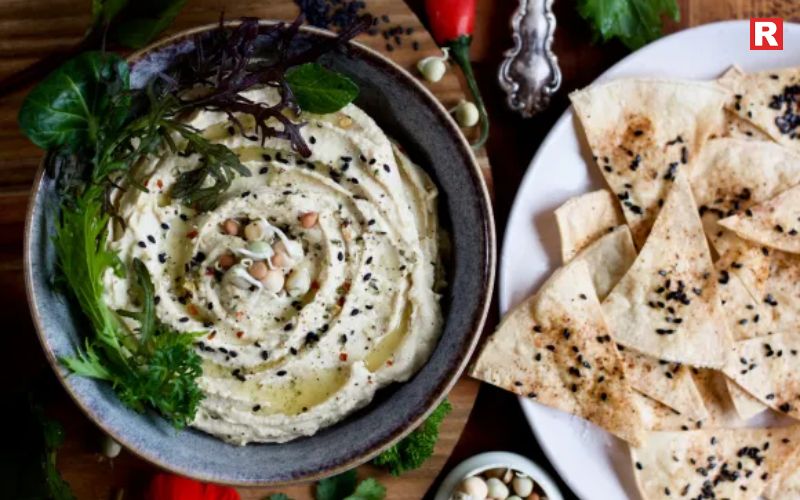
The hummus and crackers platter is a simple and healthy snack. It is inspired by Mediterranean cuisine. Smooth hummus is served with crunchy multigrain crackers. Fresh vegetables like carrot sticks, cucumber slices, and bell peppers are added for color and texture. The dish is quick to assemble and requires no cooking. It can be served as a snack, light lunch, or party appetizer. Hummus is rich in protein and fiber, making it filling and nutritious. The platter is easy to customize with different vegetables or herbs. It is suitable for both adults and children. The hummus and crackers platter is a convenient, tasty, and wholesome option for anyone looking for a healthy, fireless dish.
Ingredients:
- ½ cup hummus (store-bought or homemade)
- Multigrain crackers
- Sliced carrots, cucumber, and bell peppers
How to Make: Arrange hummus, crackers, and vegetables on a platter. Use the veggies or crackers as dips.
Why It’s Great: It’s rich in protein and fiber, and makes for a guilt-free snack. Great for midday hunger or party platters.
6. Paneer and Corn Salad
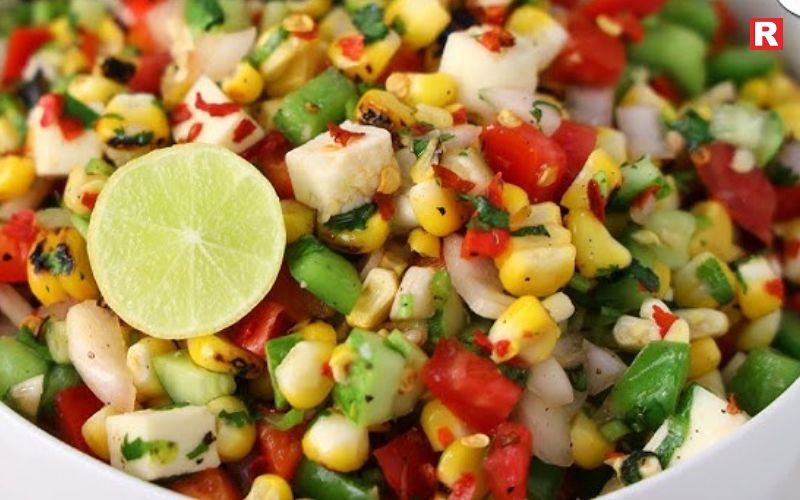
Paneer and corn salad is a simple and nutritious dish. It is rich in protein and easy to prepare. Cubes of paneer are mixed with boiled sweet corn for a soft and crunchy texture. Chopped onions, capsicum, and fresh coriander add color and flavor. A drizzle of olive oil and a squeeze of lemon juice enhances the taste. Salt and pepper are added to season the salad. It can be served as a light lunch, dinner, or snack. The ingredients are easy to find and require no cooking. Paneer and corn salad is filling, healthy, and refreshing. It is a perfect fireless dish for anyone looking for a quick and wholesome meal.
Ingredients:
- 1 cup diced paneer
- ½ cup boiled sweet corn
- Chopped onions, capsicum, and coriander
- Olive oil, lemon juice, salt, and pepper
How to Make: Mix paneer, corn, and vegetables in a bowl. Drizzle olive oil and lemon juice. Toss well and serve fresh.
Why It’s Great: Paneer provides protein while corn adds sweetness and texture. It’s light yet filling—a perfect lunch or dinner bowl.
Make Fireless Meals More Interesting
Fireless food doesn’t have to be repetitive. Here are some ways to make your meals exciting:
- Experiment with Dressings: Try yogurt-based, honey-mustard, or olive oil dressings.
- Add Texture: Use nuts, seeds, or roasted lentils for crunch.
- Use Seasonal Produce: Fresh fruits and vegetables enhance flavor and nutrition.
- Play with Presentation: Layer ingredients in jars or bowls for visual appeal.
- Prep Smart: Pre-chop veggies and store them in airtight containers to save time.
Small touches like these can make your no-cook meals both tasty and visually appealing.
Also check: A Seafood Lover’s Delight: The Best Squid Dishes to Try
Breakfast Rush to Midnight Snack – Why Bread Deserves a Spotlight This World Bread
21 Different Types of Indian Breads and Their Benefits
Final Thought!
Fireless dishes prove that great food doesn’t need a stove. Whether you’re a student, a working professional, or just someone who enjoys simple food, these no-cook recipes fit right into your schedule. They save time, reduce effort, and still bring flavor and freshness to your plate. From chilled yogurt bowls to wholesome salads, these six recipes are proof that quick meals can be nutritious and satisfying. Fireless cooking isn’t just a shortcut—it’s a smart, modern way to eat better, live lighter, and make mealtime more enjoyable.

Pasta is one of the world’s most beloved comfort foods. It is a symbol of Italy that has found a home in kitchens everywhere. From creamy Alfredo to hearty Bolognese, pasta dishes come in countless variations that celebrate different regions, ingredients, and cooking styles. Whether you prefer delicate angel hair tossed in olive oil or rich lasagna layered with cheese and sauce, each dish tells a story of texture, flavor, and tradition.
First founded in Italy, pasta is made all over the world in the present. Now, you’ll find it everywhere, from home kitchens to fancy restaurants, always finding new ways and recipes to surprise us. Part of pasta’s charm is how versatile it is. There are hundreds of shapes, endless options for sauces, and you can toss in just about anything you want: herbs, cheese, meat, veggies.
So, in this article, we will be discussing 20 iconic pasta dishes that will capture your heart with every bite you take. Some are simple, everyday recipes you can make at home, and others are dining masterpieces.
Read more: 7 Different Pasta Shapes and Their Uses
Classification by Pasta Type
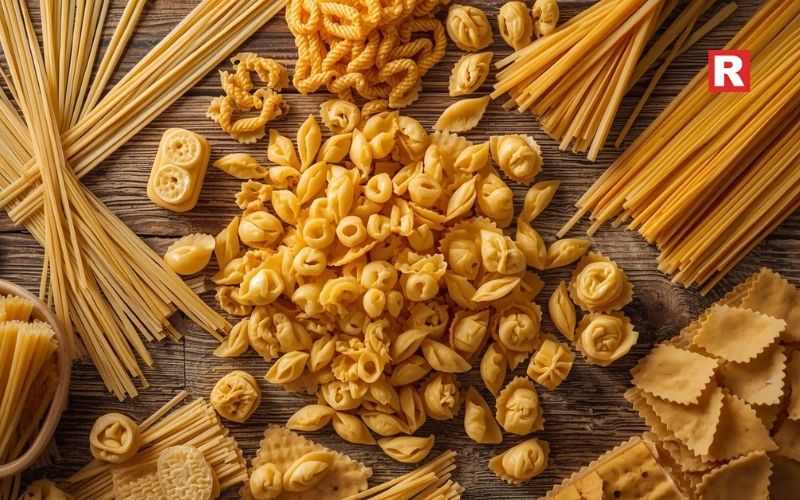
Long Pasta
Long shapes such as spaghetti, fettuccine, and linguine are well complemented by smooth sauces that dress every strand uniformly. They're commonly served in Italian favorites such as Carbonara and Alfredo, where sauce coats the noodles elegantly.
Short Pasta
Short pasta shapes such as penne, rigatoni, fusilli, and farfalle are great with chunky sauces, casseroles, and salads. Their ridges and tubes trap flavor, so each bite is satisfying and full.
Stuffed Pasta
Ravioli, tortellini, and agnolotti are filled with cheese, vegetables, or meat, and their small pouches of flavor explode in every bite. These are usually served with butter, sage, or tomato sauce.
Soup Pasta
Little pasta such as orzo, ditalini, and pastina are ideal for broths and soups, providing texture and substance without dominating the meal.
Sheet Pasta
Flat sheets such as lasagna or cannelloni are rolled or layered with fillings and sauces and then baked into satisfying, oven-browned goodness.
Know more: Lasagna Recipe – Easy, Traditional, and Authentic Italian Styles
20 Famous Pasta Dishes You Will Devour
1. Spaghetti Carbonara
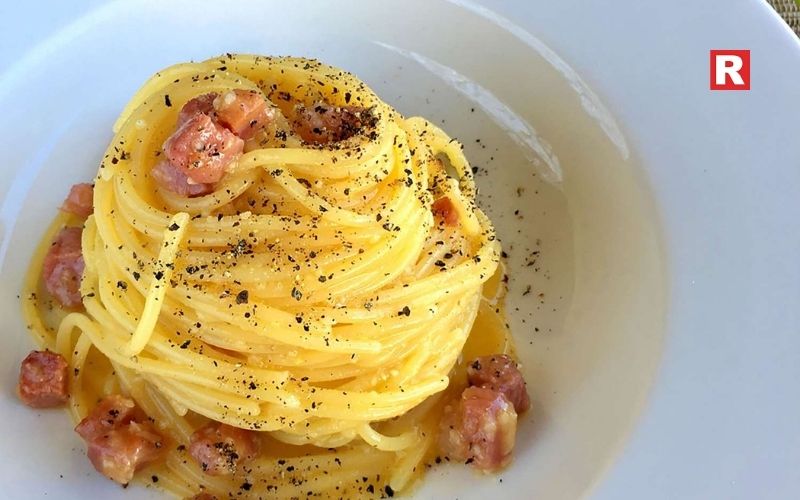
Spaghetti Carbonara is pure comfort to the soul. You only need a handful of ingredients: eggs, Pecorino Romano, pancetta or guanciale, and plenty of black pepper. The real magic is all in the technique. Tossing raw eggs with hot pasta gives you this rich, glossy sauce, and the best part, no cream is needed. Every bite hits you with salty pork, sharp cheese, and that peppery kick. It feels simple, but it’s pure luxury. Carbonara nails Italian minimalism: smooth, satisfying, and downright addictive.
2. Fettuccine Alfredo
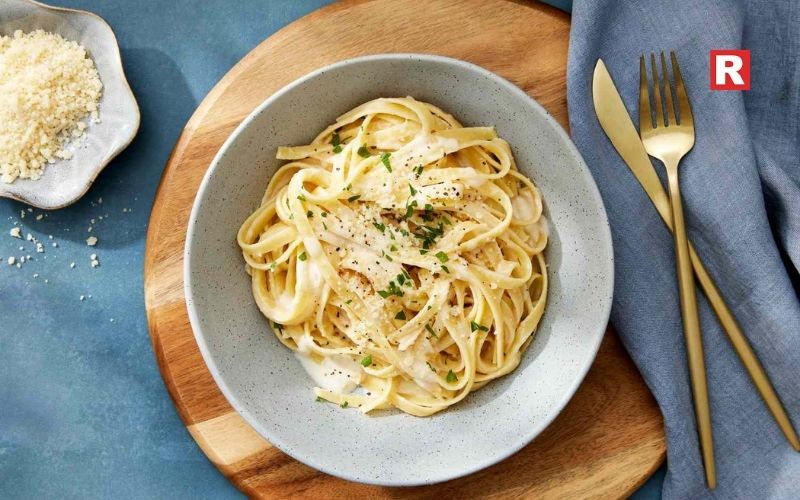
Alfredo started in Rome and then took over the world. Picture fresh fettuccine smothered in a rich sauce of butter, cream, and Parmesan. That texture? Silky and lush, it just melts in your mouth. Some people throw in chicken, mushrooms, or shrimp for a little extra punch. It’s everything you want from comfort food: simple, but also indulgent. Use real Parmigiano-Reggiano and fresh pasta, and the whole thing just clicks.
3. Penne Arrabbiata
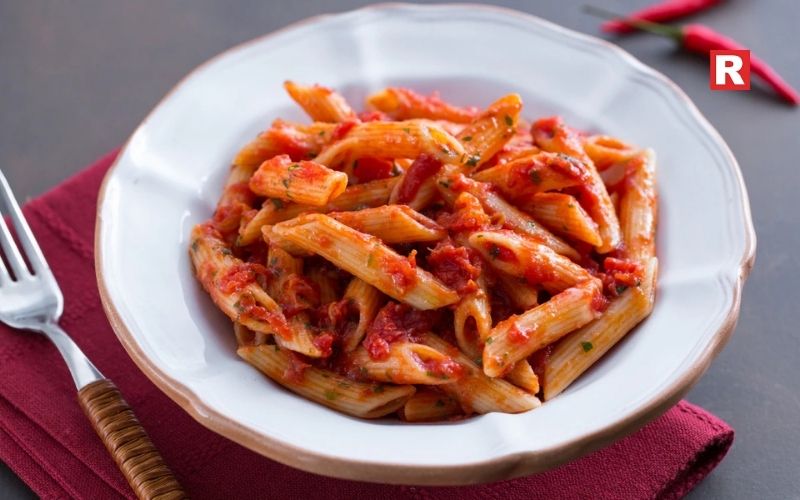
Penne Arrabbiata is your click if you love a little heat. “Arrabbiata” means “angry,” and this pasta lives up to the name, with a bold tomato sauce loaded with garlic, chili flakes, and olive oil. The chili lights things up, while the garlic brings depth and aroma. It’s fast, fiery, and absolutely packed with flavor. Grab some crusty bread and a sprinkle of parsley, and voila! You’ve got the perfect rustic dinner in no time.
4. Lasagna al Forno
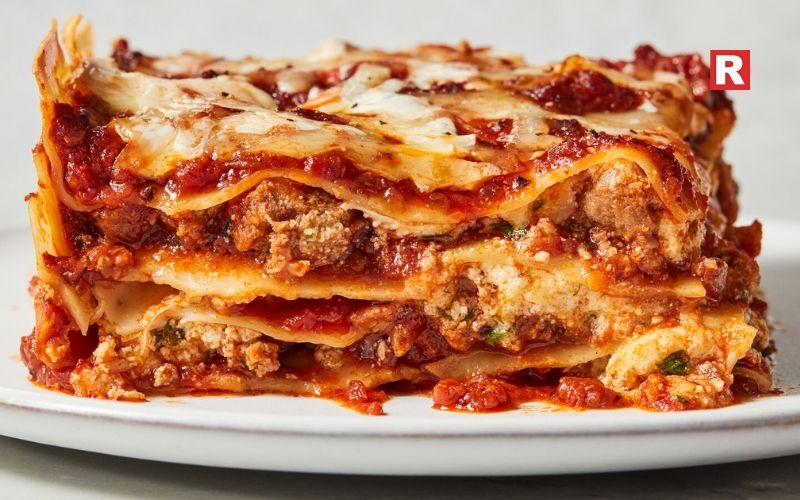
Lasagna al Forno is Italian comfort food at its best. There’s nothing rushed about it: layers of pasta, rich ragù, creamy béchamel, and plenty of cheese, all baked until golden and bubbling. You get soft pasta, hearty sauce, and sticky cheese in every bite. It’s the kind of dish families gather around, especially on big occasions. Nothing fancy, just old-school “slow food” that makes everyone happy.
5. Linguine alle Vongole
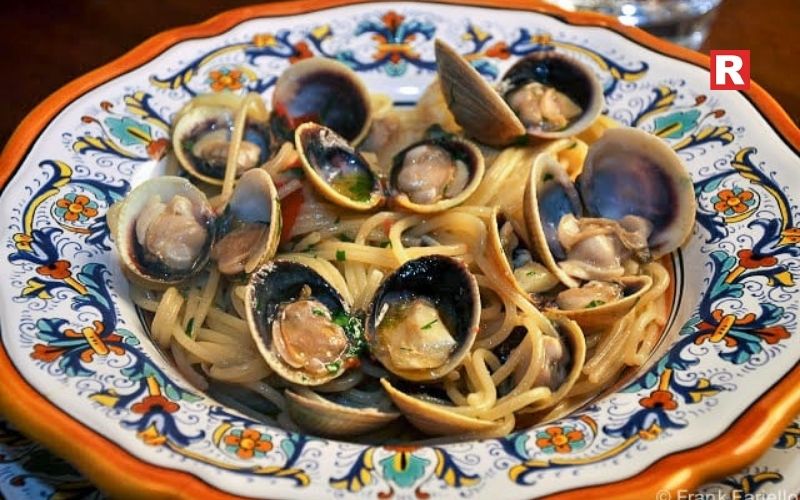
Linguine pairs up with fresh clams, simmered gently with white wine, garlic, olive oil, and parsley. The sauce is light but salty, with just a hint of chili. Every bite blends tender pasta with the subtle sweetness of the clams. It’s elegant, fragrant, and just begging for a glass of crisp white wine, especially on a warm evening.
What's new: It’s a ‘Cheesy’ Biz: How Italian Cuisine Has Grown in India
6. Ravioli di Ricotta e Spinaci
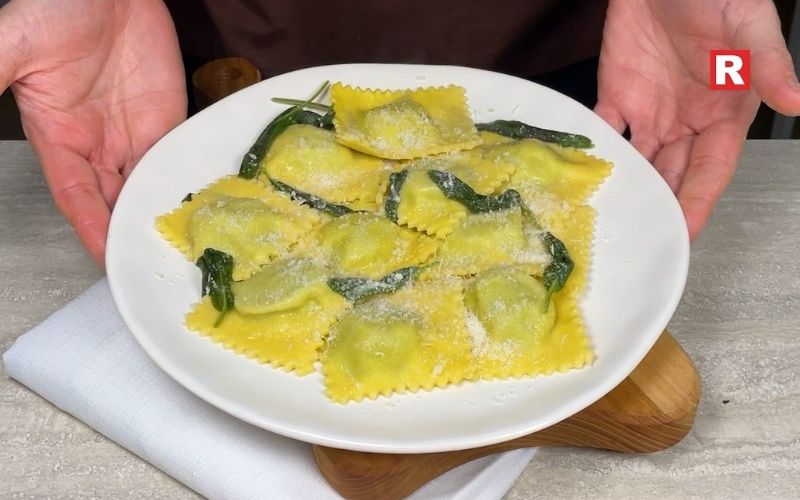
Ravioli di Ricotta e Spinaci is an Italian craft in every bite. Soft pasta pockets hold a creamy mix of ricotta, spinach, nutmeg, and Parmesan. Boil them gently, then serve with butter and sage or maybe a simple tomato sauce. The flavor is gentle: earthy spinach and sweet ricotta, balanced and smooth. It’s proof that Italian food can be both homely and a little bit fancy, all at once.
7. Spaghetti Bolognese
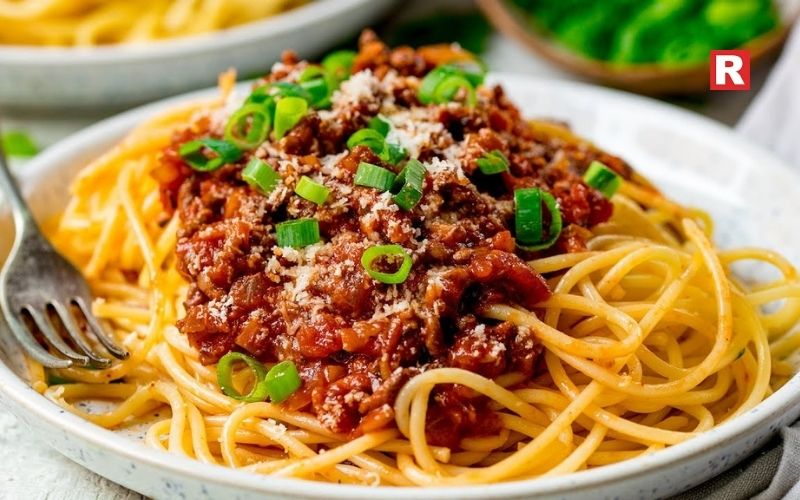
Spaghetti Bolognese might be the world’s best-known pasta dish. You get a deep, savory sauce: minced meat, tomatoes, onions, carrots, and red wine, cooked long and slow. Purists use tagliatelle, but spaghetti has become the star outside Italy. Slow cooking brings out those rich, layered flavors, and when you top it with Parmesan and fresh basil, it’s hard to beat.
8. Pesto Genovese
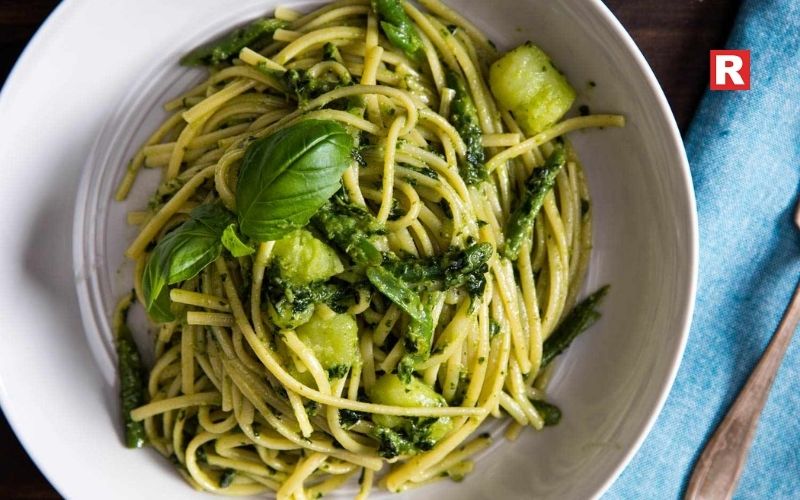
Pesto from Genoa screams fresh basil from its core. You crush it with garlic, pine nuts, Parmesan, and really good olive oil. Usually served with trofie or linguine, this sauce is bright, herby, and just a little nutty. Every bite is fresh and lively, which is a real palate cleanser compared to heavier sauces. Pesto works on pasta, but it’s also great on sandwiches or salads. It’s a burst of green that makes everything taste like summer.
9. Macaroni and Cheese

Mac and cheese is the ultimate comfort food. Elbow macaroni gets drenched in a creamy sauce, usually cheddar or Gruyère, then baked until golden and bubbling. That creamy and sticky texture with a crispy top is irresistible. You can keep it classic, or jazz it up with bacon, breadcrumbs, or even truffle oil. It’s one of those dishes everyone loves, no matter their age.
10. Tortellini in Brodo
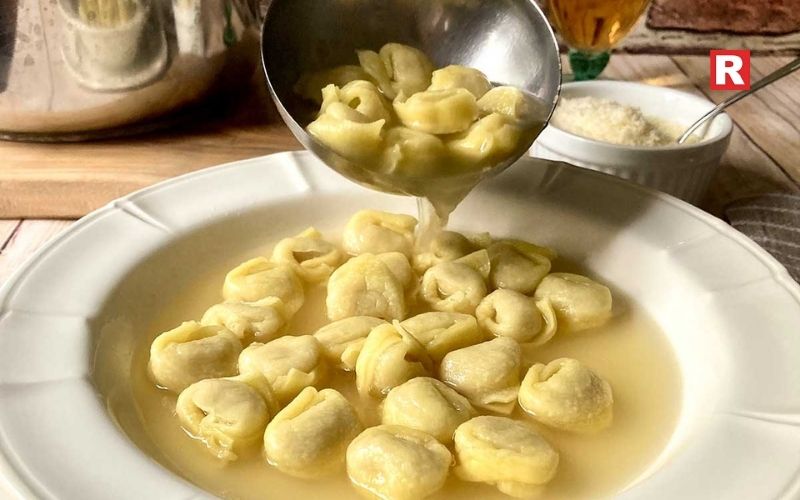
Originating from Emilia-Romagna, Tortellini in Brodo is pure winter warmth. Tiny pasta rings, stuffed with meat or cheese, swim in a clear, savory broth. The soup brings out the delicate flavors inside the tortellini. It’s simple and cozy, perfect for chilly nights. Each spoonful gives you comfort and a little taste of Italian tradition.
11. Penne alla Vodka
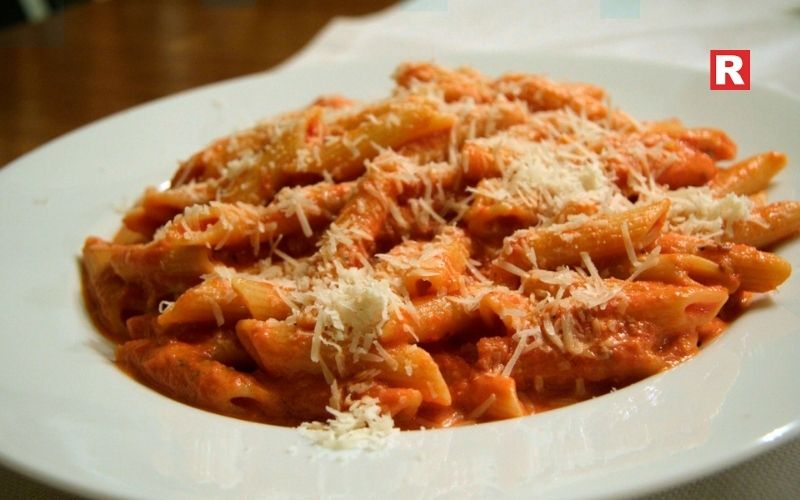
This is penne pasta coated in a creamy tomato sauce, with a splash of vodka and a pour of cream. The vodka does something magical to the tomatoes. It sharpens their flavor and ties everything together. The result? Tangy, rich, and honestly, just comforting.
12. Cacio e Pepe
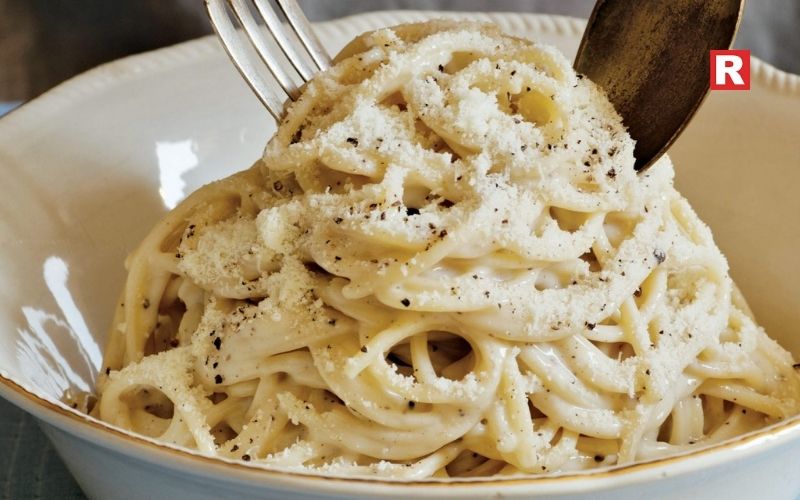
This is about as simple as pasta gets: spaghetti, Pecorino Romano, and black pepper. That’s it. But when you mix in some starchy pasta water, the cheese melts and turns into a creamy, peppery sauce. It’s proof that you don’t need much to make something delicious.
13. Orecchiette con Cime di Rapa
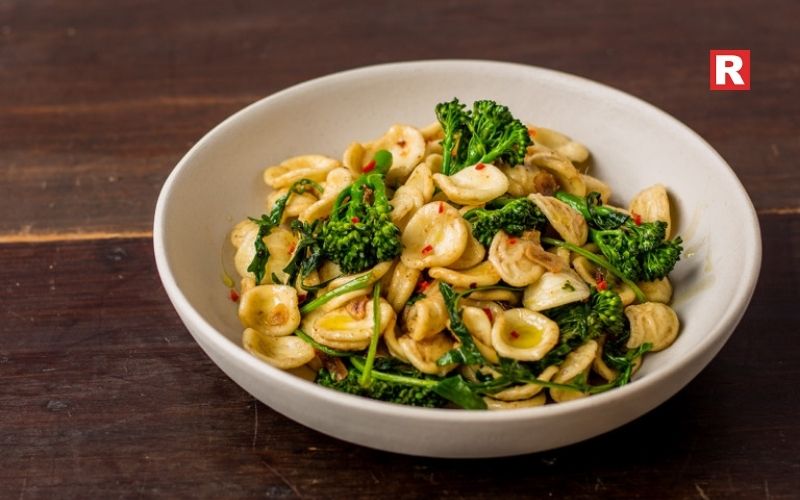
These “little ears” of pasta scoop up rough broccoli rabe, sautéed garlic, and a pinch of chili flakes. The whole thing tastes bold, a little bitter, and totally old-school. It’s the kind of dish that stays with you and your taste buds for a while.
14. Gnocchi al Pomodoro
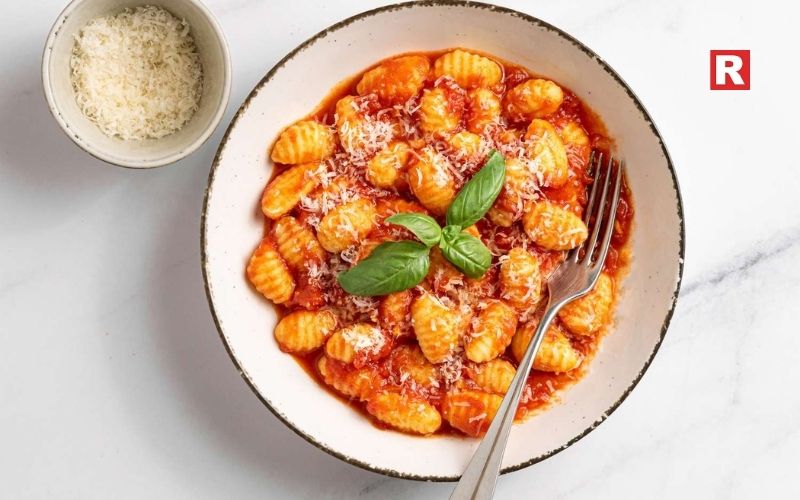
Gnocchi aren’t your typical noodles; they’re soft, pillowy dumplings made from potato. Pair them with a simple tomato sauce and some fresh basil, and you get a plate that’s tender and comforting. They pretty much melt as soon as you take a bite.
15. Tagliatelle al Ragù
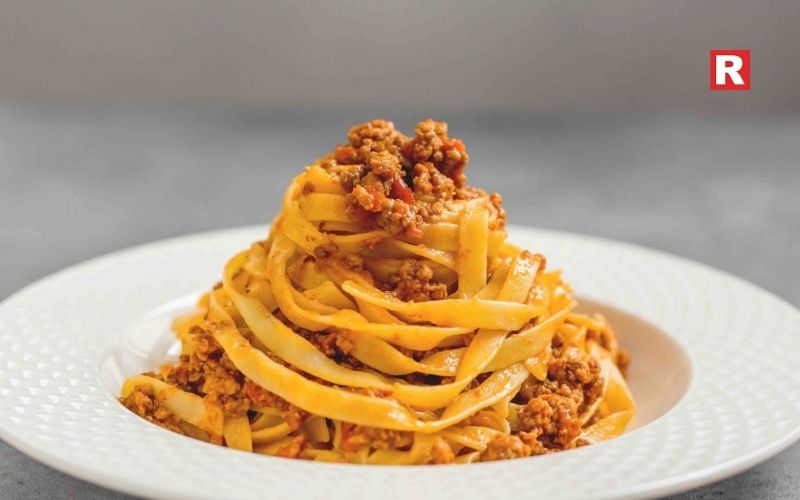
This dish is the pride of Bologna. Wide, flat tagliatelle smothered in slow-cooked meat sauce. The pasta grabs onto the ragù way better than spaghetti ever could, so every forkful is loaded with flavor and texture. It’s a classic for a reason.
16. Farfalle al Salmone
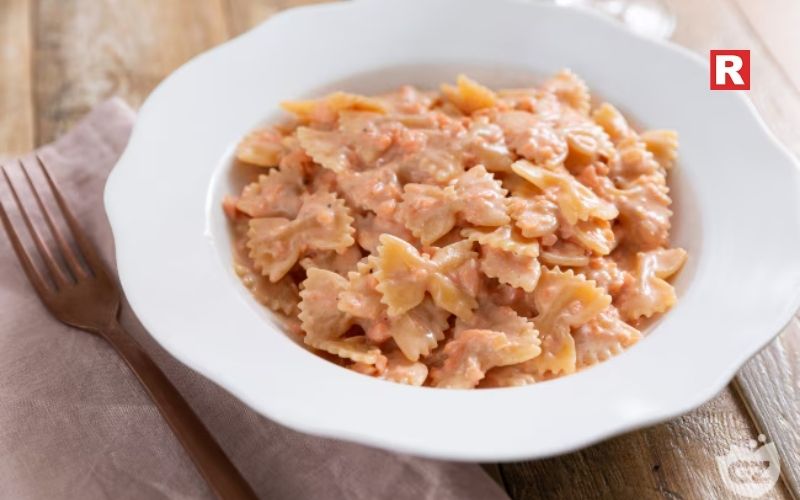
Bow-tie pasta meets smoked salmon, a splash of cream, and a hint of dill, which is a herb. The result feels rich but stays light, perfect for a dinner that’s a little fancy without trying too hard. Just bring out a bottle of white wine and you’re set.
17. Rigatoni alla Norma
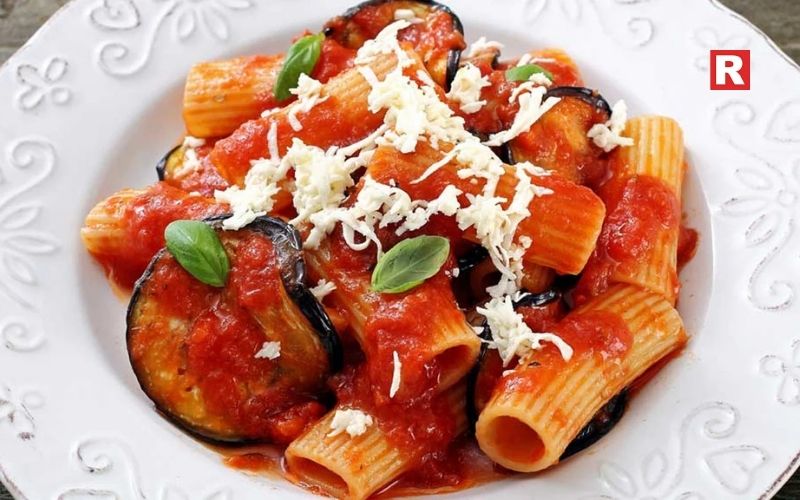
A Sicilian classic, rigatoni tossed with sautéed eggplant, tomato sauce, basil, and a sprinkle of ricotta salata is what makes Rigatoni alla Norma. It’s named after Bellini’s opera “Norma,” and it’s just as dramatic, full of flavor, and proud of its roots.
Check out: Best Whole Wheat Pasta Brands in India
Bruschetta Recipe: How to Make Authentic Italian Bruschetta at Home
18. Cannelloni al Forno

Big pasta tubes stuffed with ricotta and spinach, or sometimes meat, then baked in tomato and creamy béchamel sauce until golden and bubbling. It’s the kind of meal that feels special, maybe even a notch above lasagna when you pull it from the oven.
19. Seafood Spaghetti (Frutti di Mare)
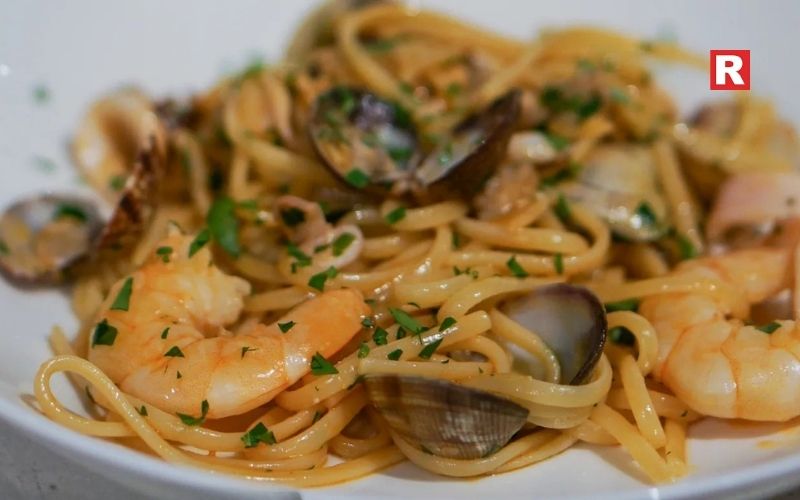
Imagine this: spaghetti tangled up with shrimp, mussels, calamari, and clams, all glistening with olive oil, garlic, and a splash of white wine. It’s light, briny, and the kind of dish seafood lovers chase down by the coast.
20. Pasta Primavera

This dish is not exactly Italian, but a mix of American-Italian. This dish makes the best of seasonal vegetables. Penne or fusilli tossed with fresh spring veggies, olive oil, and Parmesan just works perfectly with the veggies. It’s bright, healthy, and puts the season’s best on your plate. Every bite tastes like spring finally showed up.
Ingredients & Sauces
Pasta dishes are characterized by the union of sauce and noodles. Popular types of sauces are tomato-based, such as marinara and arrabbiata, cream-based, such as Alfredo or carbonara, oil-based like aglio e olio, and pesto types based on herbs or nuts. Additions of protein, such as chicken, prawns, pancetta, or mushrooms, enhance the dish, and finishing with cheese and herbs adds flavor and aroma.
Cooking & Serving Tips
- Cook pasta al dente for an ideal bite.
- Always season boiling water with plenty of salt.
- Save some pasta water to assist with binding the sauce.
- Pair shapes with sauces: smooth sauces with long pasta, chunky sauces with short pasta.
- Finish cooking the pasta in the sauce to incorporate a deeper flavor.
Nutritional Information
Most old-world pasta is carbohydrate-rich and contains moderate protein. Whole wheat and legume pastas contain more fiber and nutrients and are ideal for healthy eaters. Combining lean protein, vegetables, and olive oil turns pasta from rich to nutritious. Gluten-free options are also readily available using rice, corn, or chickpeas.
Learn more: How Italian Cuisine is Building Connectivity with Indian Food
Fun Facts & History
- There are over 350 shapes of pasta and over 1,300 names globally.
- Pasta probably did start in ancient Italy, not China, which is contrary to popular legend.
- Italians consume a whopping 23 kg of pasta per head per year!
- Every region in Italy has its special dish, from Pesto in Liguria to Ragù in Bologna.
The Wonders of Pasta
From rich Fettuccine Alfredo to hot Arrabbiata and country-style Tagliatelle al Ragù, pasta courses have limitless options for comfort food and creativity. Whether you are a home cook or a traveling foodie, familiarity with the range of pasta varieties enables you to match sauces and ingredients ideally. Each mouthful, layered, rolled, or twirled, is a testament to Italian artistry crossing centuries and international influence.

For seafood lovers, few dishes can match the unique taste and texture of squid. Known as calamari in many parts of the world, squid is a versatile ingredient that appears in coastal kitchens across continents. From the sizzling streets of Bangkok to the sun-soaked coasts of Italy, squid dishes are celebrated for their tender yet chewy texture and their ability to absorb bold flavors. Cooking squid requires skill, but the reward is a dish that is both flavorful and satisfying.
Squid is more than just a culinary delight. It carries cultural significance in many regions. In Japan, it is called Ika and often grilled or served raw. In Kerala, India, squid is known as Kanava and is cooked with rich local spices. Across Europe, calamari is fried or served in pasta dishes, showcasing the ingredient’s versatility. In this article, we explore some of the best squid dishes around the world that every seafood lover must try.
The Global Love for Squid
Squid has been part of human diets for centuries. It is popular in coastal regions because it is easy to catch and cook. The texture of squid is unique—tender when cooked correctly, yet slightly firm to bite. Its mild flavor allows it to pair well with diverse spices and sauces. Squid is also healthy, being low in fat and rich in protein. These qualities make it a favorite ingredient for both street food vendors and fine-dining chefs. From Europe to Asia, squid is a staple that reflects the culinary traditions of the region.
The Best Squid Dishes to Try
Here are some of the top squid dishes that stand out for their taste, preparation, and cultural significance. Each dish offers a unique experience, and trying them can take you on a global culinary journey.
1. Kanava Roast (Kerala, India)

Kanava Roast is a traditional squid dish from Kerala. Fresh squid is cooked in coconut oil with curry leaves, mustard seeds, and a mix of local spices. The dish is semi-dry, slightly crispy, and very flavorful. It pairs perfectly with steamed rice or Kerala parathas. The spices bring out the natural taste of the squid without overpowering it. Kanava Roast is a favorite among seafood lovers in Kerala. It reflects the coastal state’s rich culinary heritage. The preparation is simple, but the flavors are bold and aromatic. People often serve it as a main course during family meals or festive occasions. It is considered one of the best Indian squid dishes for those who enjoy spicy seafood.
2. Goan Squid Peri Peri (Goa, India)
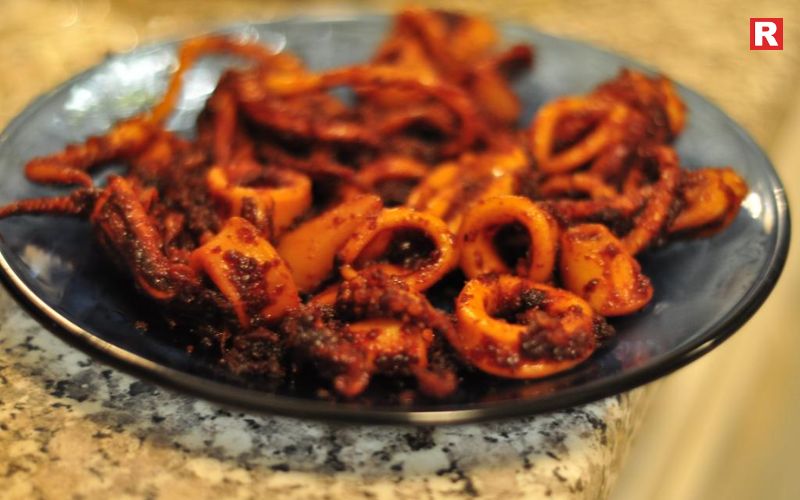
Goan Squid Peri Peri is a spicy seafood dish with Portuguese influence. Squid is marinated in a red chili masala and then grilled or pan-fried. The marinade gives it a tangy and fiery taste. It is usually served as an appetizer or a main course. This dish highlights Goa’s mix of local seafood and European cooking styles. The squid remains tender inside while the exterior has a slight char from grilling. Goan Squid Peri Peri is popular in coastal Goan restaurants and seafood shacks. It is loved by both locals and tourists. The dish is simple yet flavorful, making it a must-try for seafood lovers. It represents the essence of Goan cuisine: spicy, tangy, and full of coastal flavors.
Read more: 8 Famous Street Foods of Agra You Can’t Miss
8 Famous Vegetarian Dishes of Uttar Pradesh and Their Timeless Legacy
3. Grilled Squid with Garlic Butter (Thailand)
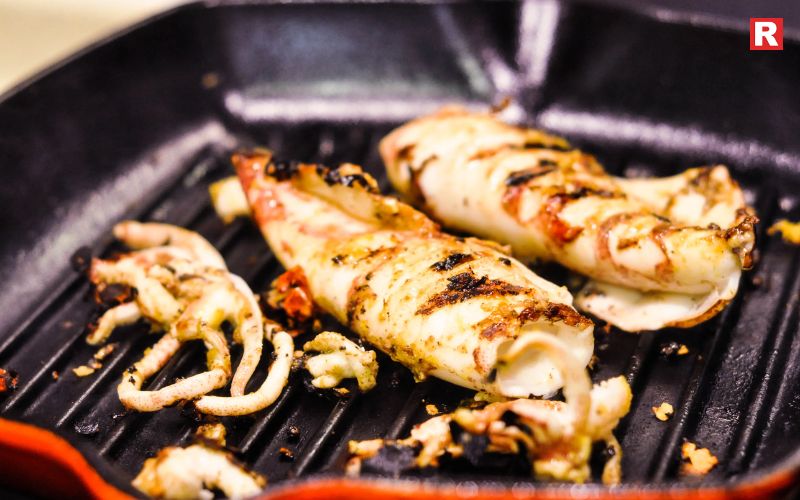
Grilled Squid with Garlic Butter is a famous Thai street food dish. Fresh squid is brushed with a spicy garlic butter mixture. It is then grilled over an open flame until lightly charred. The grilling gives the squid a smoky aroma. The garlic butter adds flavor and mild spice. This dish is often sold on Thai beaches and street food stalls. It is popular with both locals and tourists. The squid remains tender inside while slightly crispy outside. It is served hot and eaten as a snack or appetizer. Grilled Squid with Garlic Butter captures the essence of Thai cuisine—simple, fresh, and full of taste. Seafood lovers enjoy it for its bold yet balanced flavor.
4. Stuffed Squid (Spain and Philippines)
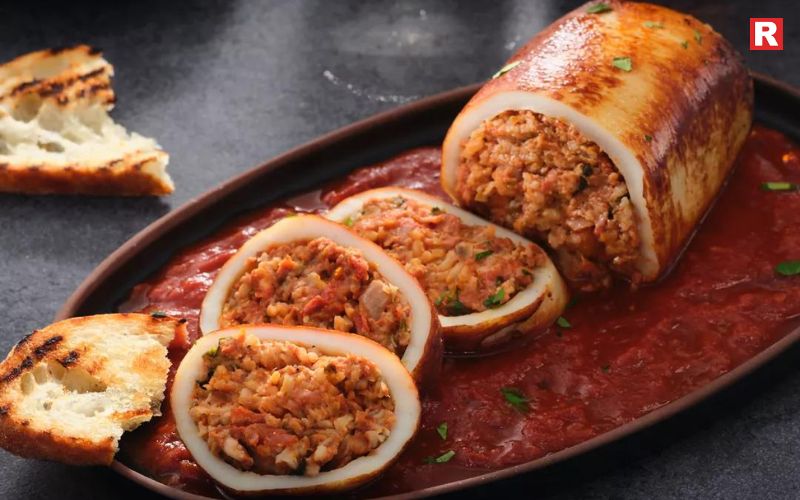
Stuffed Squid is a versatile seafood dish found in Spain and the Philippines. In Spain, squid is filled with minced meat, herbs, and sometimes rice. It is then baked or simmered in tomato sauce. In the Philippines, squid is stuffed with vegetables, herbs, or small seafood pieces. The stuffing adds flavor and richness to the tender squid. This makes it a filling and satisfying dish. Stuffed Squid is served as a main course in coastal restaurants. It is loved for its mix of textures and tastes. Seafood enthusiasts often call it one of the best squid dishes to try. The dish combines the ocean’s natural flavors with local spices and cooking techniques.
Know more: 10 Awadhi Cuisine Classics You Must Try at Least Once
5. Japanese Ika Yaki (Japan)

Ika Yaki is a traditional Japanese squid dish. Whole squid is chargrilled over hot coals. It is brushed with soy sauce and mirin while cooking. This simple preparation brings out the squid’s natural flavor. Ika Yaki is often sold at Japanese festivals and street markets. It can be eaten as a snack or light meal. A squeeze of fresh lemon or a dash of soy sauce adds extra taste. The squid is tender inside and slightly crisp outside. It is a favorite among seafood lovers and travelers in Japan. Ika Yaki is a perfect example of authentic Japanese seafood cooking. Its smoky flavor and minimal seasoning make it one of the top squid dishes to try.
6. Korean Ojingeo Bokkeum (Korea)
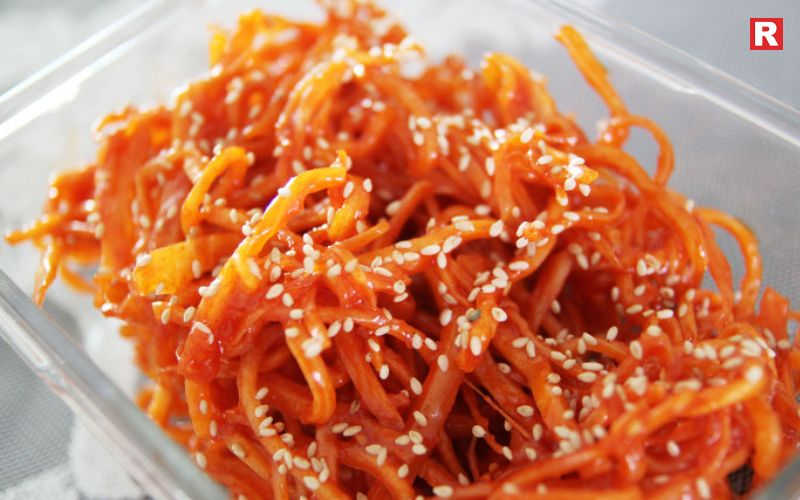
Ojingeo Bokkeum is a famous Korean squid dish. Fresh squid is cut into rings and stir-fried with gochujang, a spicy Korean chili paste. Garlic, onions, and vegetables like carrots and bell peppers are added for flavor and crunch. The dish is slightly sweet, spicy, and chewy, giving a unique taste experience. It is usually served with steamed rice, making it a complete meal. Ojingeo Bokkeum is popular in Korean homes and street food stalls. The bold flavors reflect Korea’s love for spicy and tangy food. Seafood lovers enjoy this dish for its balanced taste and vibrant colors. It is one of the best squid dishes to try for people exploring Korean cuisine. The combination of chili paste and tender squid makes it unforgettable.
7. Calamari Fritti (Italy)
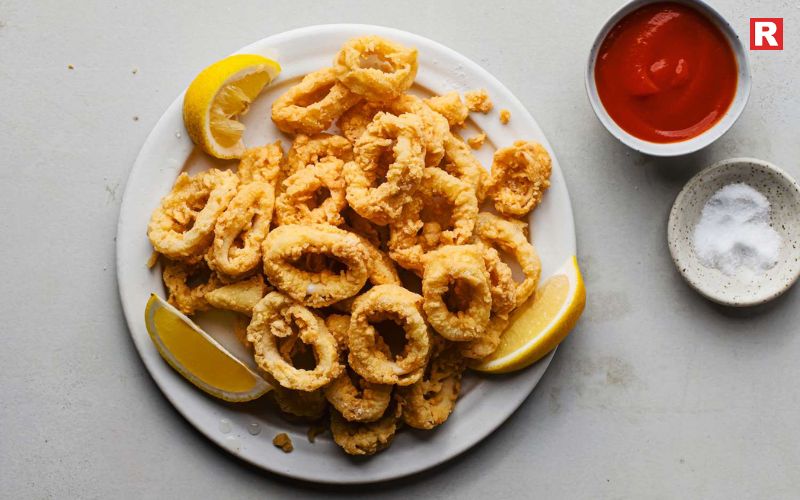
Calamari Fritti is one of the most popular Italian squid dishes. It features golden, crispy rings of squid that are lightly battered and deep-fried. The frying process makes the exterior crunchy while keeping the inside tender and soft. It is often served with lemon wedges and aioli. The lemon adds freshness, and the aioli adds a creamy, garlicky flavor. Calamari Fritti is a favorite starter in Italian restaurants. It is commonly paired with a chilled white wine, enhancing the overall dining experience. The dish is simple yet full of flavor. Seafood lovers often enjoy it as an appetizer before a main meal. Its crispy texture and fresh taste make it one of the best squid dishes to try. People looking for authentic Italian seafood dishes often start with Calamari Fritti.
Also check: Pani Puri Has Different Names in Different Indian States—Know Them All
8. Squid Ink Pasta (Italy)

Squid Ink Pasta is a unique Italian seafood dish. The pasta is black because it is made with squid ink. This gives it a rich, briny flavor. The squid ink adds depth to the pasta, making it taste of the ocean. Fresh squid is usually added to the dish. Garlic and olive oil enhance the flavor. Squid Ink Pasta is visually impressive with its dark color and elegant presentation. It is a popular choice in Italian seafood restaurants. The dish combines soft pasta, tender squid, and a subtle salty taste from the ink. It is a must-try for seafood lovers and people who enjoy gourmet dishes. Squid Ink Pasta is also healthy, being high in protein and low in fat. It represents authentic Italian seafood cooking.
9. Squid Ceviche (Peru)
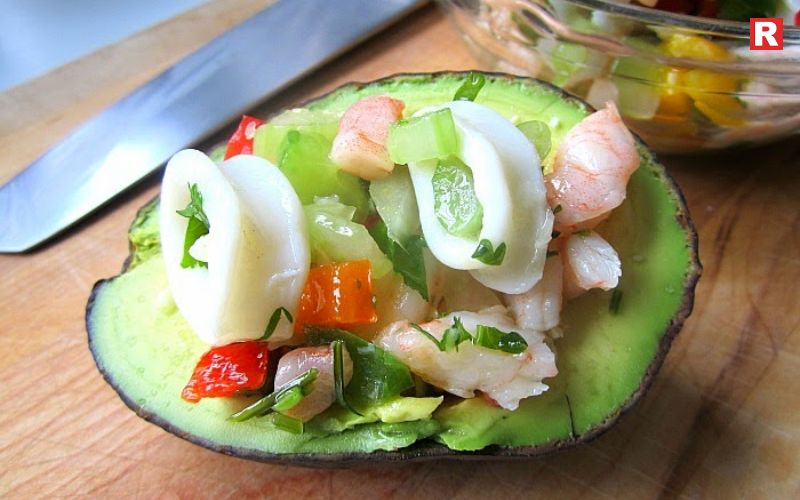
Squid Ceviche is a refreshing seafood dish from Peru. Fresh squid is sliced thinly and marinated in lime juice. The acidity of the lime “cooks” the squid naturally. Onions, chili, and coriander are added for flavor and freshness. The dish is light, tangy, and full of taste. Squid Ceviche is usually served cold as a starter in coastal Peruvian restaurants. It is perfect for hot weather or summer meals. The balance of citrus and spice enhances the squid’s natural flavor. Seafood lovers enjoy it for its clean taste and refreshing texture. Squid Ceviche is considered one of the best Peruvian squid dishes to try. Its simplicity and bright flavors make it a favorite among tourists and locals alike.
10. Squid Tempura (Japan)
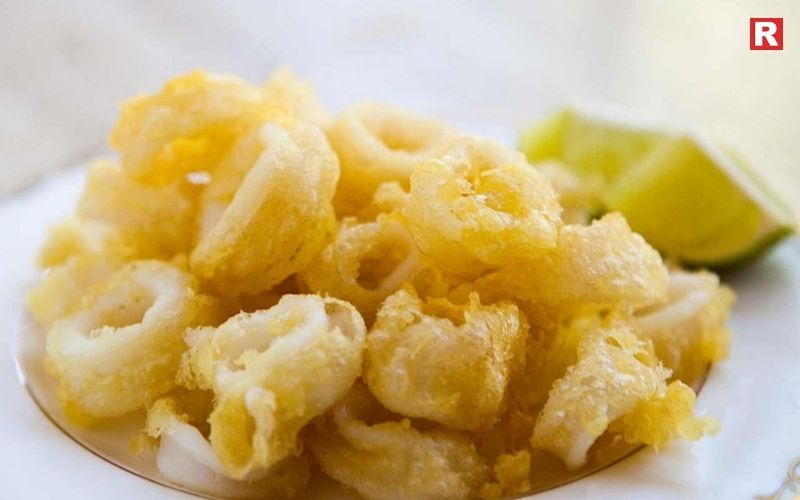
Squid Tempura is a popular Japanese seafood dish. Fresh squid pieces are coated in a light batter and deep-fried until golden and crispy. The exterior is crunchy, while the squid inside remains tender. It is often served with soy sauce or a dipping sauce. Squid Tempura is enjoyed in Japanese restaurants and during traditional meals. The dish is simple but elegant, highlighting the squid’s natural flavor. Seafood lovers appreciate its texture contrast and delicate taste. Squid Tempura can be served as a snack, appetizer, or part of a main meal. It is considered one of the best Japanese squid dishes. The combination of crispy batter and soft squid makes it a favorite among locals and travelers alike.
How to Cook Squid Perfectly
Cooking squid requires care. The general rule is simple: cook it very fast or very slow. Quick frying or grilling keeps the squid tender, while slow cooking in stews or sauces makes it soft. Overcooking turns squid rubbery and tough. Fresh squid should smell like the sea, not fishy. Popular cooking methods include grilling, frying, steaming, and simmering. Pairing squid with citrus, garlic, herbs, or chili enhances its natural flavors.
Check more: Top 5 States With the Spiciest Food in India
A Bite of Banaras: 8 Iconic Street Foods You Can’t Miss in Varanasi
10 Famous Non-Vegetarian Dishes of Lucknow That Define Royal Awadhi Cuisine
A Sea Treat!
Squid is more than just seafood—it is an ingredient that unites cultures and cuisines. Its versatility allows it to be transformed into fried, grilled, stuffed, or saucy dishes. From the spicy Kanava Roast in Kerala to the elegant Squid Ink Pasta in Italy, squid dishes offer a rich culinary journey for the adventurous foodie. Whether you enjoy bold spices or subtle flavors, squid has something to offer everyone. Exploring these dishes can be a delightful way to taste the world’s oceans and celebrate the artistry of seafood cuisine.
For seafood lovers, trying these squid dishes is more than a meal—it is an experience. The next time you see calamari or fresh squid on a menu, consider stepping out of your comfort zone and tasting one of these iconic recipes. The ocean truly knows how to delight your taste buds.

Agra, the city of the Taj Mahal, is famous not just for its monuments but also for its delicious street food. The city’s streets are full of smells and colours. Every corner has snacks that are spicy, sweet, or crunchy. Agra’s food shows its Mughal history and local traditions. Tourists and locals both enjoy walking through the crowded markets to taste these dishes. Areas like Sadar Bazaar, Chaat Gali, and Raja Ki Mandi are famous for their food. The aroma of fried snacks and sweet syrup fills the air. Street food here is not just a meal. It is a way to feel the city and its culture. Each dish tells a story of Agra’s past.
The food is simple but full of flavour. Visitors can try crispy Bedai with potato curry, soft and sweet Petha, or spicy Dalmoth. Chaats, kachoris, and jalebis are also popular. For dessert, Rabri Falooda gives a royal taste of the city. Agra’s street food is loved for its taste and tradition. It connects people to the city. Every bite reflects history, culture, and the spirit of Agra. For anyone visiting, tasting the local street food is a must.
Find 8 Famous Street Foods of Agra
1. Bedai and Aloo Sabzi – Agra’s Breakfast of Champions
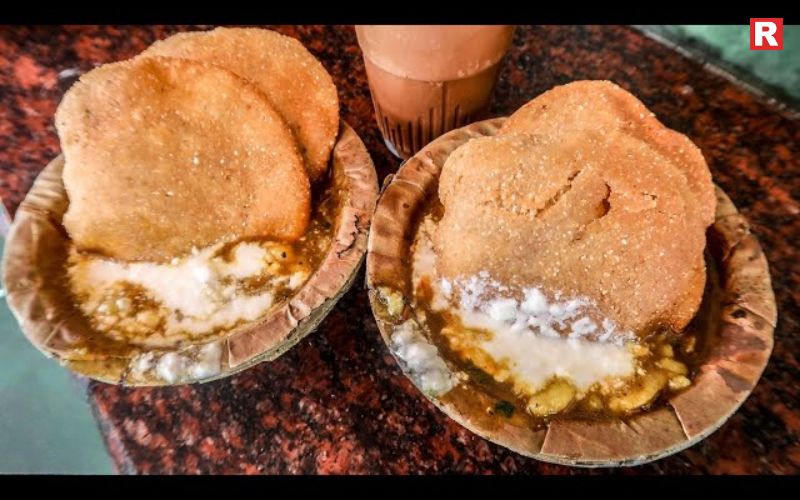
A visit to Agra is incomplete without trying Bedai. It is a deep-fried, soft bread served with spicy potato curry. Bedai is usually paired with sweet jalebi, making it a perfect balance of sweet and spicy. Many locals start their day with this hearty breakfast. Popular spots to try Bedai include Deviram Sweets and Bhagat Halwai. The crispy texture of the bread combined with the rich, spiced potato curry is a flavour that stays with you. The combination is simple but represents Agra’s street food culture perfectly.
Read more: 8 Famous Vegetarian Dishes of Uttar Pradesh and Their Timeless Legacy
10 Awadhi Cuisine Classics You Must Try at Least Once
2. Petha – The Pride of Agra
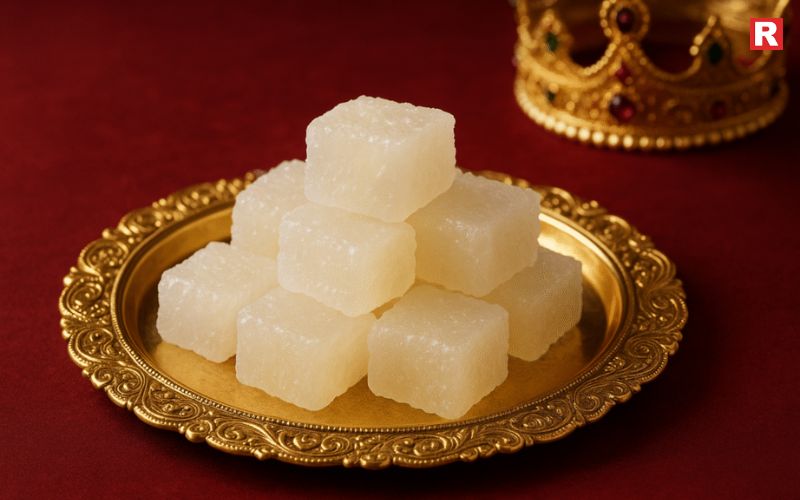
Agra’s most famous sweet, Petha, is made from ash gourd. It comes in many varieties, including dry, kesar, and paan-flavoured. Petha is translucent, soft, and melts in your mouth. Its popularity goes back centuries and is a must-buy souvenir for tourists. Panchi Petha is one of the most well-known shops to try authentic Petha. Eating Petha gives you a taste of Agra’s royal Mughal heritage, and it is a sweet that locals and tourists both cherish.
3. Dalmoth – The Perfect Crunchy Snack
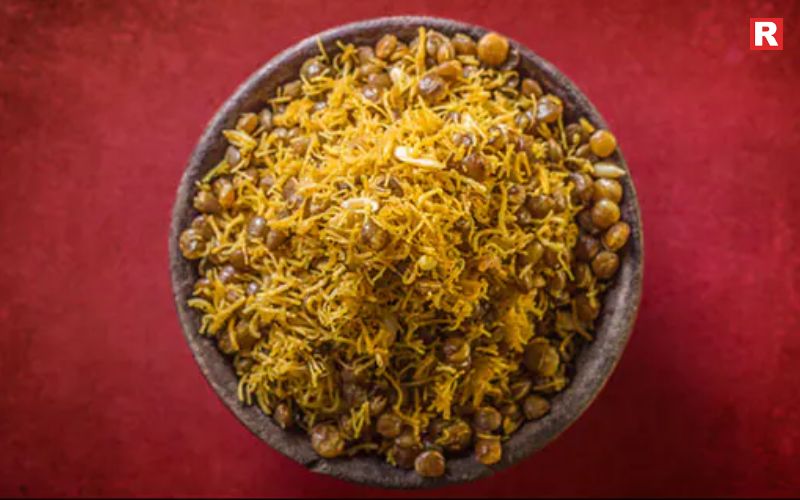
Dalmoth is a spicy, crunchy snack mix made with lentils, nuts, and special spices. It is perfect for munching anytime — with tea in the evening or while walking through the crowded markets. The snack is tangy, salty, and addictive. Agra Famous Dalmoth Bhandar is a place where you can taste Dalmoth in its authentic form. It represents the snack culture of Agra and is perfect for travellers who love something light but flavourful.
Know more: 10 Famous Non-Vegetarian Dishes of Uttar Pradesh: A Journey Through Flavour
4. Bhalla Chaat – A Tangy Delight from Chaat Gali
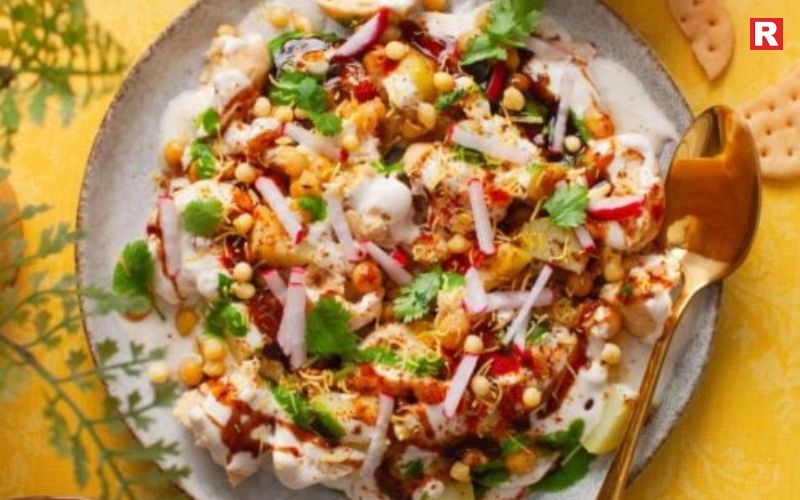
Agra is famous for its chaats, and Bhalla Chaat is a top favourite. It is made with soft lentil dumplings, mashed potatoes, sweet and tangy chutneys, and fresh curd. The combination of flavours is intense, tangy, and refreshing. Chaat Gali in Sadar Bazaar is where locals head for the best Bhalla Chaat. It is a must-try for anyone exploring Agra’s street food scene. The dish is light yet flavourful, making it perfect for a quick snack while sightseeing.
5. Jalebi – Sweet Swirls of Happiness
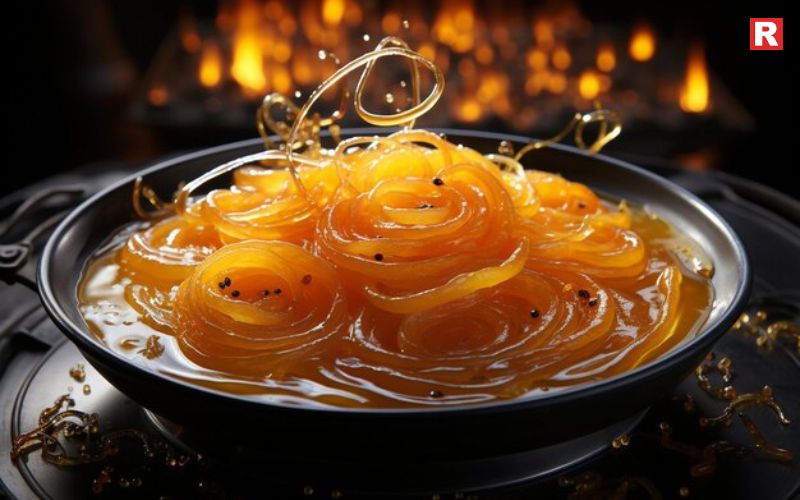
Agra’s jalebi is crispy, syrupy, and golden. It is best eaten hot and fresh. Many people enjoy it early in the morning with a glass of milk or as an evening treat. The texture is crispy outside and soft inside, making it irresistible. Deviram Sweets is known for serving some of the best jalebis in the city. Eating jalebi in Agra is not just about sweetness; it is about experiencing a traditional dessert loved by generations.
6. Kachori Sabzi – Spicy and Satisfying
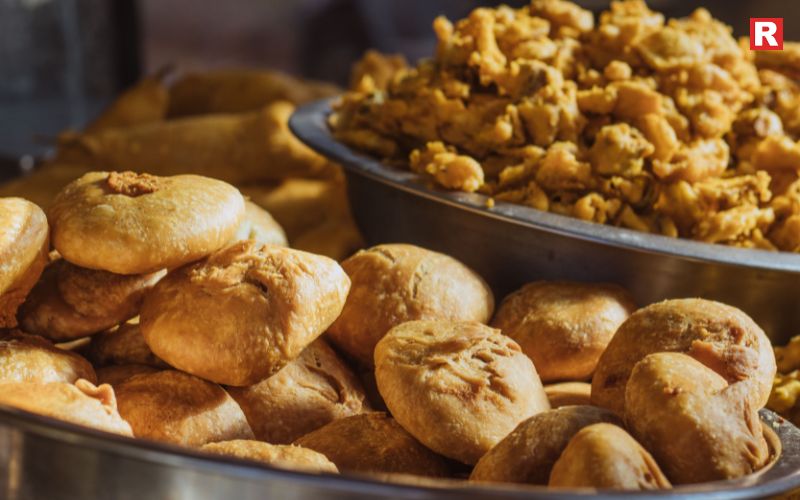
Kachoris in Agra are spicy, deep-fried pastries filled with lentils or masala. They are usually served with tangy potato curry. Kachori Sabzi is different from Bedai but equally popular, especially for breakfast or evening snacks. Agra Chat House is one of the best places to try this dish. The kachori’s crispy shell and spicy filling perfectly match the soft, flavorful curry. It is a snack that is simple yet represents the city’s street food heritage.
Also check: 10 Famous Non-Vegetarian Dishes of Lucknow That Define Royal Awadhi Cuisine
7. Mughlai Paratha – A Taste of Royal Agra
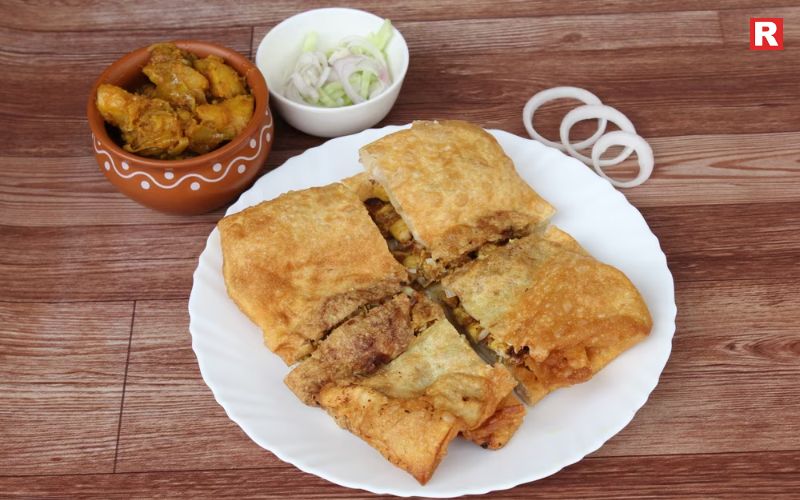
Agra’s streets also offer Mughlai Paratha, a dish influenced by royal Mughal cuisine. This paratha is stuffed with spiced minced meat, eggs, and onions. It is rich, filling, and perfect for meat lovers. Mama Chicken Mama Franky House in Sadar Bazaar is famous for serving this dish. Mughlai Paratha gives you a taste of the royal kitchens and reflects Agra’s historical significance. Each bite is rich, spicy, and deeply satisfying.
8. Rabri Falooda – A Royal Dessert to End Your Food Trail
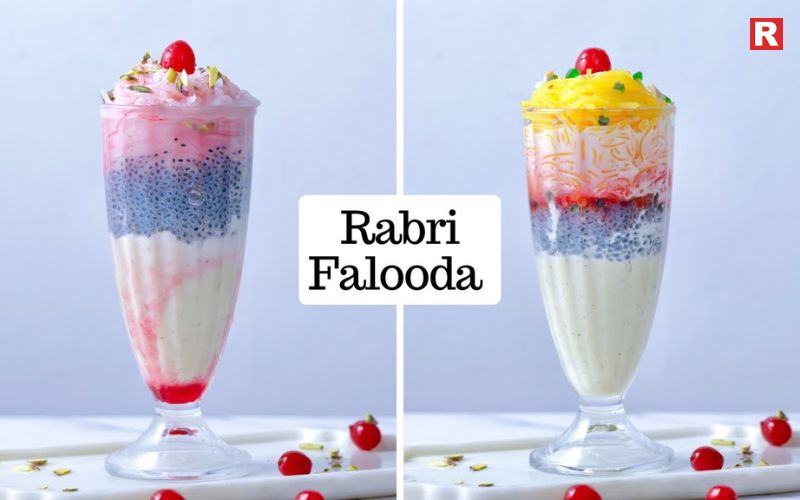
No street food journey in Agra is complete without Rabri Falooda. Thick rabri topped with chilled falooda, nuts, and syrup is a perfect way to finish a meal. It is refreshing, sweet, and indulgent. Sadar Bazaar and the Ram Babu Paranthe Wale area are famous for serving the best Rabri Falooda. It is a dessert that combines texture, taste, and presentation, offering a royal culinary experience in the streets of Agra.
Where to Find the Best Street Food in Agra
The best street foods are concentrated in areas like:
- Sadar Bazaar – Popular for Bedai, Chaat, and Jalebi.
- Chaat Gali – Famous for Bhalla Chaat and Kachori Sabzi.
- Raja Ki Mandi – Known for Mughlai Paratha and Dalmoth.
- MG Road – Offers a variety of sweets and snacks including Petha and Rabri Falooda.
These areas are always buzzing with locals and tourists alike. Walking through them gives a full taste of Agra’s food culture.
Check more: Pani Puri Has Different Names in Different Indian States—Know Them All
5 Cities That Serve the Best Non-Vegetarian Street Food
Top 5 States With the Spiciest Food in India
From The City of Shah Jahan
Agra’s street food scene is a perfect blend of tradition, flavour, and history. Each dish, from crispy Bedai to sweet Petha, tells a story of the city’s rich heritage. Walking through Agra’s bustling streets, tasting its diverse foods, is an experience that goes beyond sightseeing. It is about connecting with the city through its flavours. On your next visit to Agra, don’t just admire the Taj Mahal. Explore the streets, follow the aroma of freshly fried snacks, and discover the tastes that locals have cherished for generations. Agra is not just a city of monuments — it is a city of food, culture, and unforgettable culinary experiences.

Odisha, located on India’s eastern coast, is a land of rich culture, heritage, and history. But beyond its temples and festivals, it hides a culinary treasure that many food lovers have yet to explore. Odisha’s cuisine is simple yet soulful. Every dish is a reflection of tradition, local produce, and careful cooking. The food here is not about heavy spices or elaborate presentations. Instead, it focuses on natural flavors, freshness, and harmony.
Odia meals are deeply tied to the rhythm of life. They draw inspiration from the local coast, forests, and farmlands. Coastal regions offer fresh seafood, while inland areas celebrate vegetables, lentils, and rice. One cannot talk about Odisha cuisine without mentioning the Jagannath Temple in Puri. The temple’s kitchen, known for cooking Mahaprasad, has been feeding devotees for centuries. These dishes are vegetarian, simple, yet full of flavor. Here, food is not just nourishment. It is a way to connect with community and tradition. Simplicity is the essence of Odisha cuisine. Spices are used sparingly, with mustard oil, panch phoron, turmeric, and cumin defining most dishes. Fresh vegetables, lentils, rice, and seafood are staples. Coconut, jaggery, and curd are often added for richness and balance. Meals are designed to satisfy the palate without overwhelming it. This combination of simplicity and care creates dishes that are both comforting and unforgettable.
Why Odisha Cuisine Deserves More Recognition
Despite its uniqueness, Odisha cuisine is often overshadowed by neighbouring cuisines like Bengal or Andhra Pradesh. However, it offers a perfect balance of nutrition, taste, and cultural richness. Every dish is prepared with care, using seasonal ingredients and minimal spices. It is a cuisine where less is truly more — simple methods produce deeply satisfying flavors. Whether it is the tang of Pakhala, the sweetness of Kanika, or the spice of Macha Besara, each dish tells a story. Odisha cuisine is a journey of culture, tradition, and mindful cooking that every food lover should explore.
Discover 6 Odisha Cuisines for Soulful Flavour
1. Dalma: The Soulful Lentil Curry
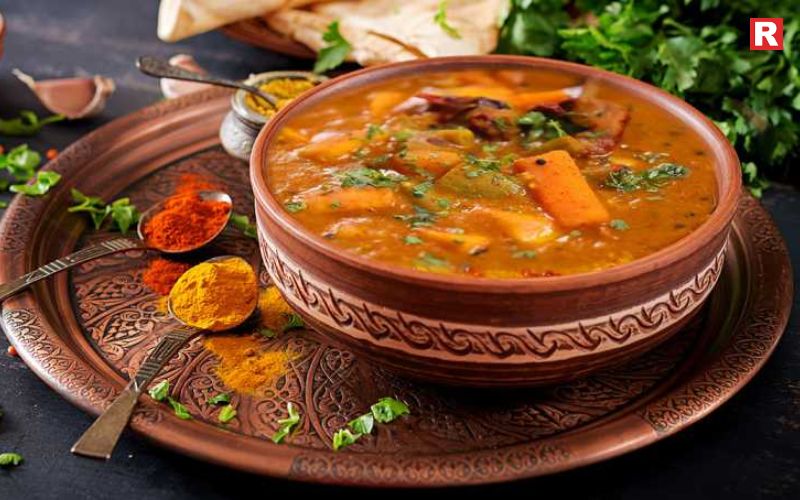
Dalma is one of Odisha’s most iconic dishes. Made with split lentils and seasonal vegetables, it is cooked slowly with mustard oil, ginger, garlic, and a touch of cumin. The result is a curry that is hearty, wholesome, and comforting. Dalma is traditionally offered at temples, including the Jagannath Temple, making it a dish with spiritual significance. It is often served with plain rice or roti. What makes Dalma unique is its balance of flavors. The vegetables retain their texture, and the lentils add depth without overpowering the dish. Dalma is a perfect example of how Odisha cuisine celebrates natural flavors with simple ingredients.
Read more: 8 Famous Vegetarian Dishes of Uttar Pradesh and Their Timeless Legacy
10 Awadhi Cuisine Classics You Must Try at Least Once
2. Pakhala Bhata: Odisha’s Summer Comfort Food
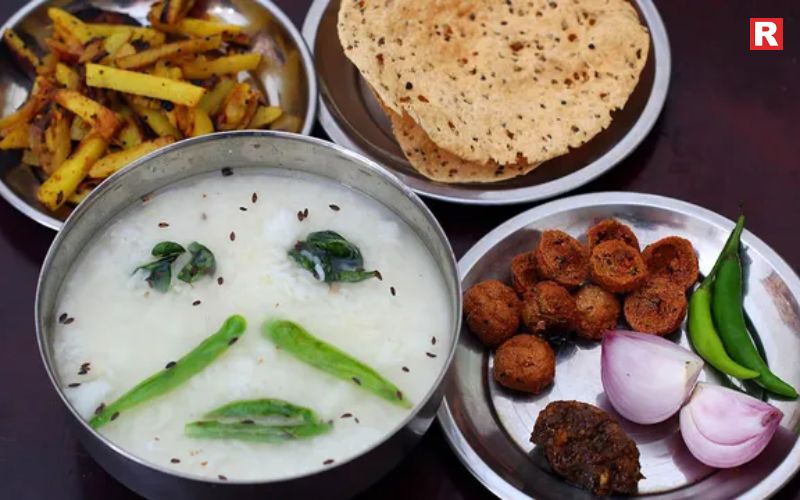
Pakhala Bhata is fermented rice soaked in water. Served cold with fried vegetables, green chilies, and sometimes fish, it is Odisha’s ultimate summer dish. The fermentation process not only gives it a tangy taste but also helps in digestion and cooling the body. Pakhala is deeply rooted in Odia culture. Families often enjoy it for breakfast or lunch during the scorching summers. It is a humble dish, yet full of character. Pair it with a side of badi chura (crushed lentil dumplings) or fried fish for a truly authentic Odia experience. This dish shows how simple ingredients, when handled thoughtfully, create a memorable taste.
3. Chhena Poda: The Sweet Delight
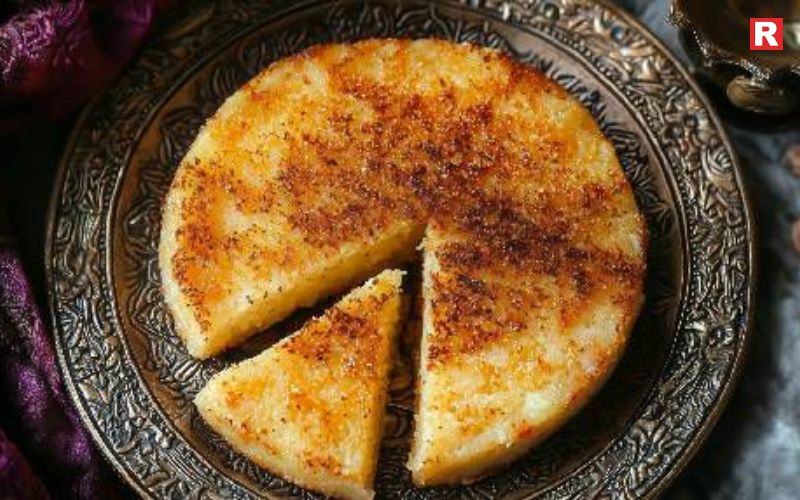
Odisha is famous for its desserts, and Chhena Poda is the crown jewel. The name literally means “roasted cheese.” Made from fresh chhena (a type of Indian cottage cheese), sugar, and cardamom, it is baked until golden brown. The result is a dessert with a caramelized crust and soft, melt-in-your-mouth interior. Chhena Poda is often served during festivals and special occasions. Unlike overly sweet desserts, it is light, flavorful, and subtly spiced. Every bite tells a story of traditional cooking methods passed down through generations. This dessert is an example of how Odisha combines simplicity with culinary creativity.
Know more: 10 Different Types of South Indian Rice Dishes
4. Macha Besara: The Mustard Fish Curry
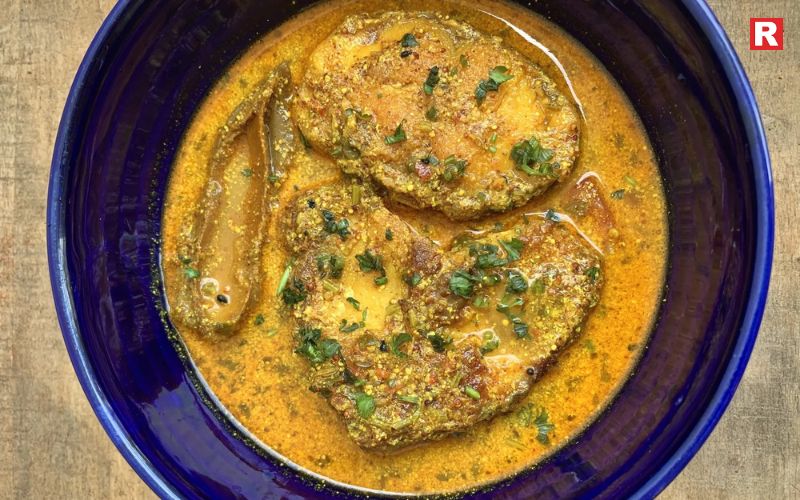
For seafood lovers, Macha Besara is a must-try. This traditional fish curry is made using mustard paste, turmeric, and mustard oil. The mustard gives it a pungent, aromatic flavor that perfectly complements the freshness of river or sea fish. Macha Besara is a coastal favourite, commonly prepared at home and during festivals. It is served with steamed rice, making it a wholesome and satisfying meal. The combination of mustard and fish is a hallmark of Odisha’s coastal cuisine. It demonstrates how local ingredients and simple techniques create dishes with intense flavors and cultural significance.
5. Kanika: Fragrant Sweet Rice
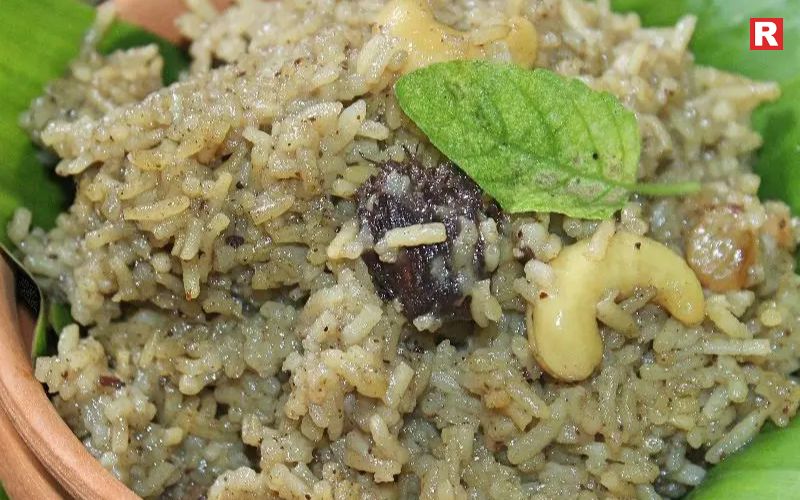
Kanika is a sweet rice dish with a delicate aroma and flavor. It is made with rice, ghee, raisins, cashews, and sometimes saffron. Traditionally, it is offered as Mahaprasad at the Jagannath Temple in Puri. Kanika is not overly sweet. Instead, it is fragrant, lightly spiced, and comforting. It is served during special occasions, festivals, and rituals. The dish reflects Odisha’s love for balanced flavors and wholesome ingredients. With each spoonful, you experience the subtle richness and cultural depth of Odia cuisine. Kanika is proof that Odisha cuisine can be simple yet indulgent, respecting tradition while delighting the palate.
Also check: A Bite of Banaras: 8 Iconic Street Foods You Can’t Miss in Varanasi
6. Khicede: The Sacred Khichdi
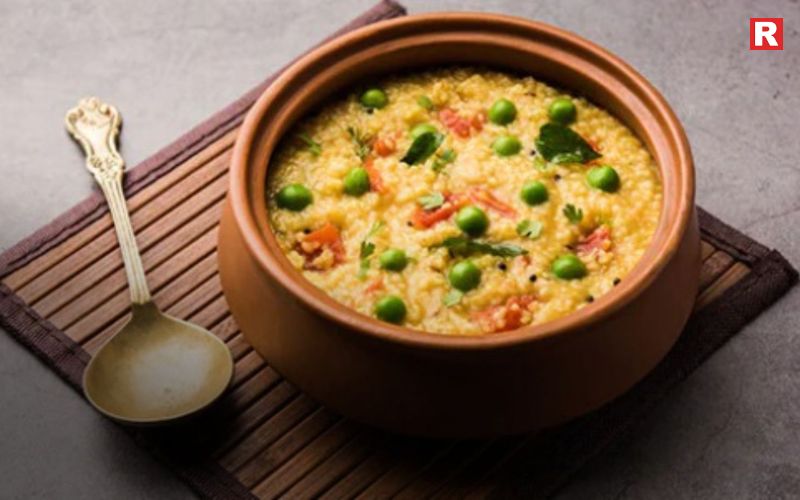
Khicede, or Khichdi, is the sacred dish of Lord Jagannath. Made with rice, moong dal, and ghee, it is cooked to perfection in the temple kitchen. Khicede symbolizes purity and devotion. It is soft, light, and nourishing, making it suitable for all ages. Though plain in appearance, the flavor comes from the careful cooking and the ghee’s richness. Khicede is a reminder that Odisha cuisine values simplicity and spirituality. Eating it is not just about taste; it is an experience of connection with faith, history, and culture.
The Role of Temple Food & Mahaprasad
Temples in Odisha, especially the Jagannath Temple in Puri, play a central role in shaping the cuisine. Mahaprasad is prepared using traditional earthen pots and wood-fired stoves. It is more than a meal; it is a spiritual experience. Food is cooked in large quantities, and the aroma fills the temple complex, drawing devotees and visitors alike. Mahaprasad is served to the community in a thali, symbolizing equality and devotion. Temple food showcases Odisha’s dedication to clean, simple, and nutritious meals, reflecting the region’s philosophy that food is sacred.
Check more: Manju K. Tilla Explores the Flavours of Delhi’s Tibetan Street Food Scene
10 Famous Non-Vegetarian Dishes of Uttar Pradesh: A Journey Through Flavour
Pani Puri Has Different Names in Different Indian States—Know Them All
A Soulful Treat!
Odisha cuisine is a true reflection of the state’s culture and traditions. Every dish tells a story of devotion, community, and local life. Simple meals like Dalma, made with lentils and vegetables, show how everyday food can be rich in flavor. Sacred dishes like Khicede, offered at the Jagannath Temple, carry centuries of history. Odisha’s food is never complicated. It uses fresh ingredients and natural flavors to create meals that are wholesome and satisfying. Temple food and traditional recipes highlight the state’s respect for purity and balance. From sweet Kanika to spicy Macha Besara, each dish offers a taste of Odisha’s heritage. Trying this cuisine is more than eating. It is an experience of local life, customs, and care in cooking. For anyone exploring authentic Indian food, Odisha provides a journey of simple, soulful flavors that stay long after the meal ends.

Rice is the heart of Korean meals. It is more than just food. It brings families together and is a symbol of comfort. In Korea, rice appears in almost every meal. It is served plain, mixed with vegetables, or cooked with meat. Korean rice dishes vary in flavour and style. Some are spicy, while others are mild. Some are soft and comforting, while others are crunchy and rich in texture. Each dish has its own story. Each has a special place in Korean culture.
Bibimbap, a bowl of rice with vegetables and spicy sauce, is one of the most famous dishes. Kimchi fried rice is a simple meal made with leftovers but is full of flavour. Gimbap is a rice roll that is easy to carry and often enjoyed as a snack. Juk, a rice porridge, is soft and easy to digest, often eaten for breakfast or when someone is unwell. Other rice dishes include bulgogi fried rice, soybean sprout rice, and five-grain rice. Each dish shows the diversity of Korean cuisine. They combine nutrition, taste, and tradition. Rice is at the centre of it all, connecting meals, people, and culture.
Find 10 Authentic Korean Rice Dishes
1. Bibimbap– The Ultimate Korean Comfort Bowl

Bibimbap is one of Korea’s most famous dishes. The name means “mixed rice,” and that’s exactly what it is — a colourful bowl of rice topped with vegetables, egg, and sometimes meat. It is then mixed with a spoonful of spicy gochujang (Korean red chilli paste). Each bite is a perfect blend of textures — crunchy vegetables, soft rice, and rich sauce. Regional variations like Jeonju Bibimbap are especially loved for their use of sesame oil and seasoned beef. Bibimbap isn’t just a meal; it’s a celebration of balance and harmony in every spoonful.
2. Kimchi Bokkeumbap– Spicy Kimchi Fried Rice
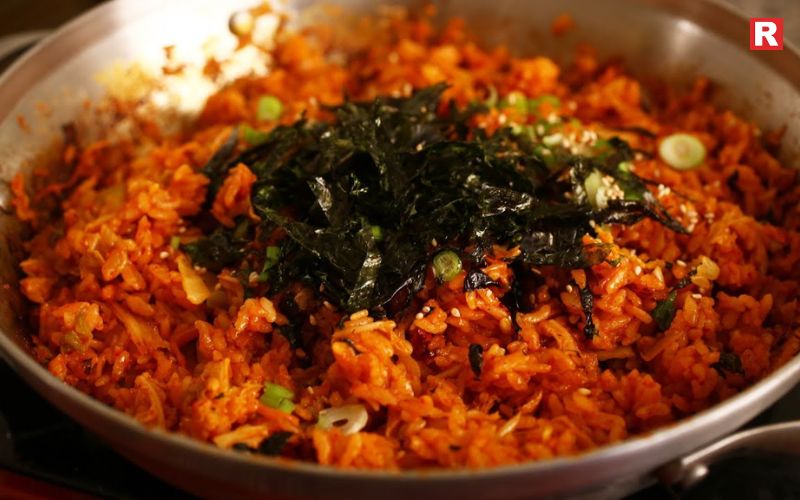
If you ask any Korean what they cook with leftover rice, the answer will be Kimchi Bokkeumbap. This dish turns day-old rice and fermented kimchi into a flavour-packed comfort meal. The spicy, tangy kimchi gives it a smoky depth when stir-fried with butter or sesame oil. It’s often topped with a fried egg or cheese for extra richness. Quick, easy, and satisfying — this is the go-to meal for students and home cooks across Korea.
Read more: 8 Famous Vegetarian Dishes of Uttar Pradesh and Their Timeless Legacy
3. Gimbap– Korea’s Answer to Sushi
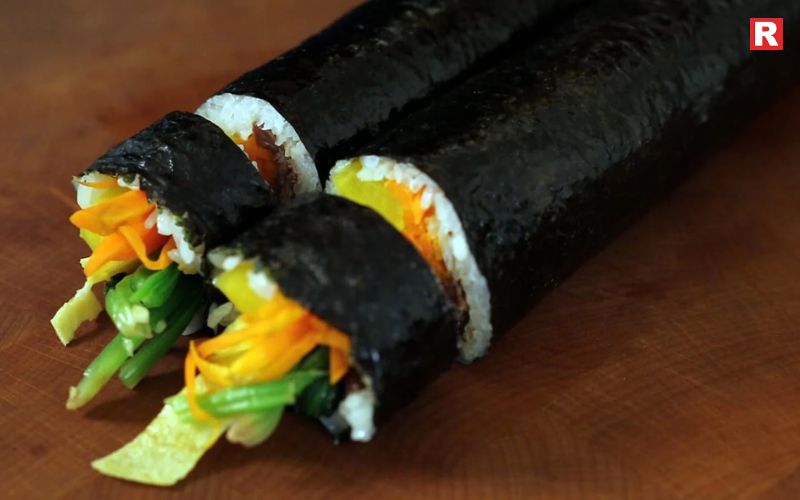
Gimbap looks like sushi but has its own unique identity. Cooked rice is seasoned with sesame oil and rolled in seaweed along with vegetables, egg, and meat or tuna. Unlike Japanese sushi, gimbap doesn’t use raw fish or vinegar. Instead, it’s all about savoury, balanced flavours. It’s the ultimate picnic and travel food in Korea — portable, filling, and bursting with colour. Every family has its own version of gimbap, making it a personal favourite across generations.
4. Juk– Korean Rice Porridge
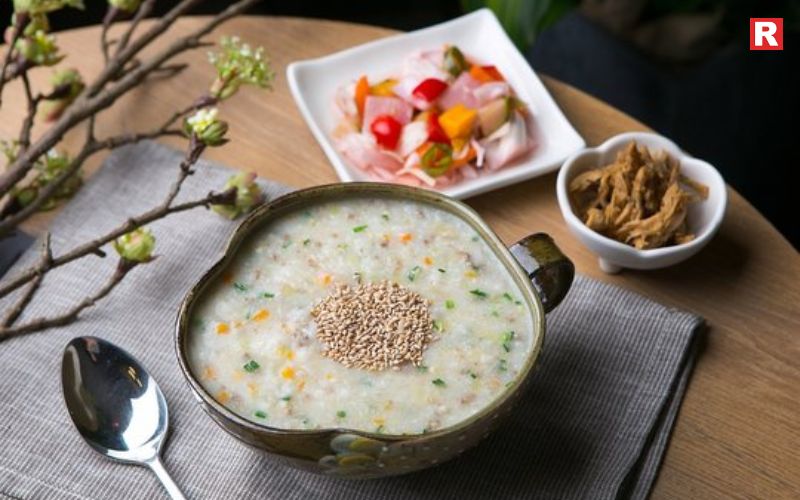
Juk is a gentle and comforting rice porridge that Koreans often eat for breakfast or when feeling unwell. The rice is simmered slowly until it becomes soft and smooth. There are many varieties, like Abalone Juk, made with fresh abalone, or Pumpkin Juk, known for its mild sweetness and golden colour. It’s light on the stomach but deeply nourishing, often served to children, elders, or patients recovering from illness.
Know more: A Bite of Banaras: 8 Iconic Street Foods You Can’t Miss in Varanasi
10 Authentic French Cuisine Dishes You Must Try
5. Dolsot Bibimbap – Stone Pot Rice Bowl
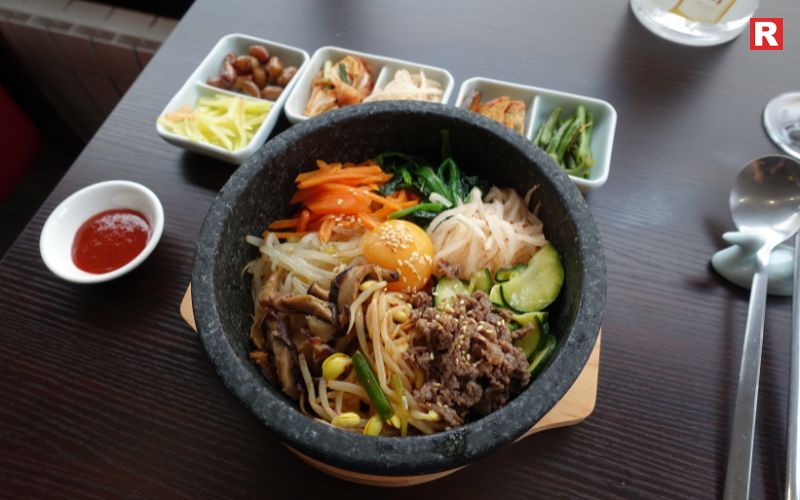
Dolsot Bibimbap is a sizzling version of the classic bibimbap served in a hot stone bowl. The heat creates a crispy rice crust at the bottom, known as nurungji, which adds a delicious crunch. When you mix it, the ingredients sizzle, filling the air with irresistible aromas. It’s a popular winter meal that warms you from the inside out. The combination of hot stone, soft rice, and spicy gochujang makes this dish unforgettable.
6. Samgyetang Bap– Chicken and Rice Ginseng Soup
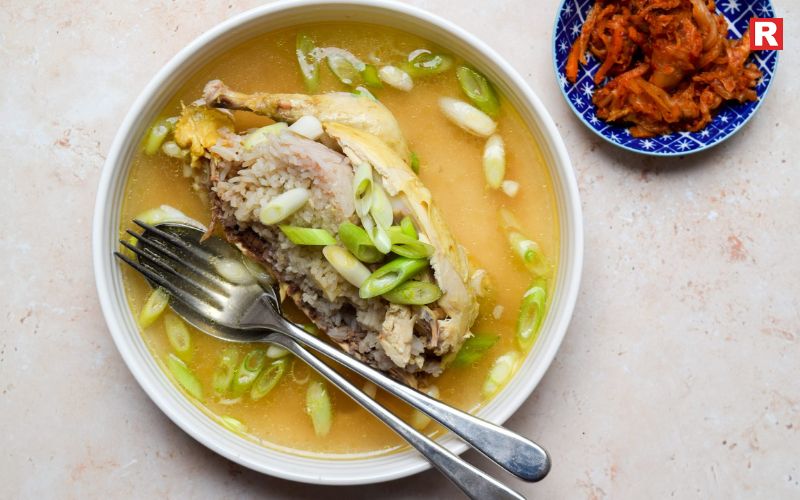
Samgyetang is a traditional summer dish often enjoyed for its healing properties. It features a whole young chicken stuffed with glutinous rice, garlic, ginseng, and jujube, simmered for hours until tender. The result is a rich, aromatic soup believed to restore energy and improve stamina during hot months. The soft rice absorbs the flavours of the herbs and chicken, turning it into a warm, nourishing meal that Koreans have cherished for centuries.
Also check: 10 Awadhi Cuisine Classics You Must Try at Least Once
7. Kongnamul Bap – Soybean Sprout Rice
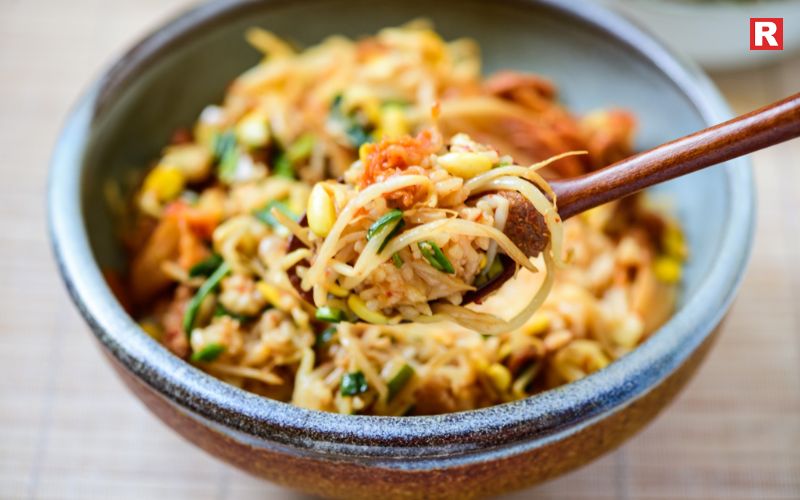
Simple yet flavourful, Kongnamul Bap is made by steaming rice together with soybean sprouts. The sprouts give a nutty, crunchy texture that pairs beautifully with a drizzle of sesame oil and spicy gochujang sauce. It’s often served with kimchi and soup, making it a wholesome, protein-rich meal. This dish is especially popular among health-conscious eaters who love its light and refreshing taste.
8. Ogokbap– Five-Grain Rice

Ogokbap, or five-grain rice, holds deep cultural significance in Korea. Traditionally eaten during the Jeongwol Daeboreum festival, this dish symbolises health and prosperity. It’s made with a mix of white rice, barley, millet, beans, and red beans. The result is a chewy, earthy blend that’s both nutritious and satisfying. Each grain represents abundance and is a reminder of Korea’s agricultural roots.
9. Bulgogi Bokkeum Bap– Beef Fried Rice
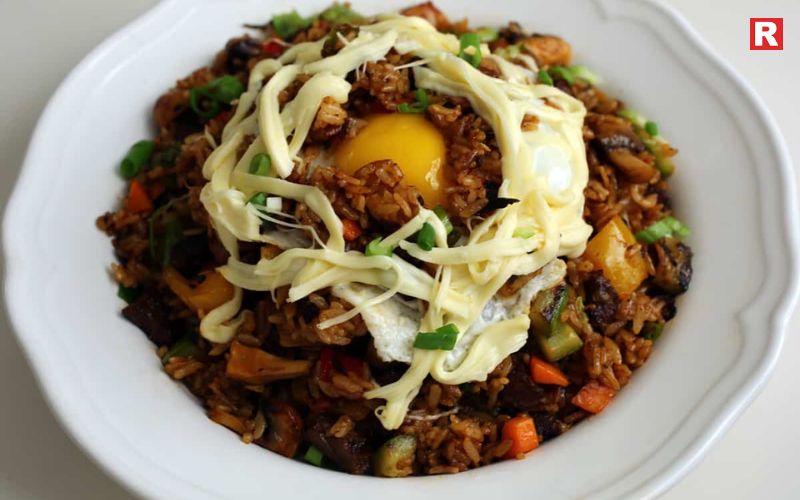
Bulgogi Bokkeum Bap combines Korea’s famous marinated beef (bulgogi) with fried rice for a flavourful twist. The sweet and savoury beef blends perfectly with fluffy rice and vegetables, often topped with a fried egg and sesame seeds. This dish is a modern favourite in Korean cafes and home kitchens. It’s hearty, delicious, and ideal for anyone who loves bold flavours without too much spice.
10. Nurungji– Crispy Rice Crust

Nurungji is the crunchy layer of rice that forms at the bottom of a pot after cooking. Instead of discarding it, Koreans treasure it as a snack or a light meal. It can be enjoyed as-is for its toasty flavour or soaked in hot water to make Sungnyung, a mild rice tea. Nurungji reflects the Korean spirit of resourcefulness — turning even leftovers into something comforting and special.
Why Rice is Central to Korean Cuisine
In Korea, the word bap means both “rice” and “meal,” showing just how essential it is to everyday life. Every meal is built around rice, with side dishes known as banchan completing the table. Rice is more than nutrition — it represents togetherness. Sharing rice is an act of love, and offering a bowl of warm rice to someone is a sign of respect and care.
Korean rice dishes are balanced and nutritious. They often include vegetables, lean proteins, and fermented ingredients like kimchi, which are rich in probiotics. Multi-grain rice like Ogokbap provides fibre and minerals, while lighter dishes like Juk are easy to digest. Most Korean meals use minimal oil and focus on natural flavours, making them both healthy and satisfying.
Different regions in Korea have their own rice specialities. Jeonju is famous for its bibimbap, Gyeongju for its sweet rice cakes, and Busan for seafood rice dishes. These regional variations add depth and diversity to Korea’s food culture, ensuring every meal tells a different story.
Check more: Power-Packed Mornings: 8 Protein-Rich Vegetarian Indian Breakfast Ideas
How to Store Opened Wine—Keep the Magic Alive Beyond the First Pour
The World’s 31 Tastiest Potato Recipes You Must Try Once in Your Life
Final Thought
Rice defines Korean cuisine — it’s the base, the bond, and the soul of every meal. It brings families together and is a key part of festivals and daily life. Rice is not just food; it carries culture and tradition. Korean rice dishes are varied and full of flavour. Bibimbap is colourful and mixed with vegetables, egg, and spicy sauce. Juk is soft and warm, often eaten for comfort or breakfast. Kimchi fried rice is simple but full of taste, while gimbap is a portable roll enjoyed as a snack. Other dishes like bulgogi fried rice, soybean sprout rice, and five-grain rice show the creativity and health focus of Korean cooking. Each dish has its own story and brings unique textures and flavours to the table. Together, these rice dishes reflect Korea’s history, culture, and love for food. They offer a real taste of the country, grain by grain, in every meal.

Delhi is a city that lives and breathes diversity. From Chandni Chowk’s spicy chaat to the aromatic kebabs of Nizamuddin, every corner tells a story through food. But tucked away on the northern edge of the city lies a pocket of serenity and culture—Majnu-ka-Tilla, often called Little Tibet. Here, the air carries the aroma of steamed momos, butter tea, and soulful soups. Manju K. Tilla steps into this world to explore the flavours, traditions, and warmth of Delhi’s Tibetan street food scene.
Majnu-ka-Tilla, located near the North Campus of Delhi University, was established in the 1960s as a Tibetan refugee settlement. Over the decades, it has grown into a lively cultural hub that offers not just food but a glimpse into Tibetan life and spirituality. Every shopfront offers something comforting, something distinctly Tibetan, yet warmly familiar to Delhi’s food-loving crowd.
Signature Tibetan Street Foods You Can’t Miss
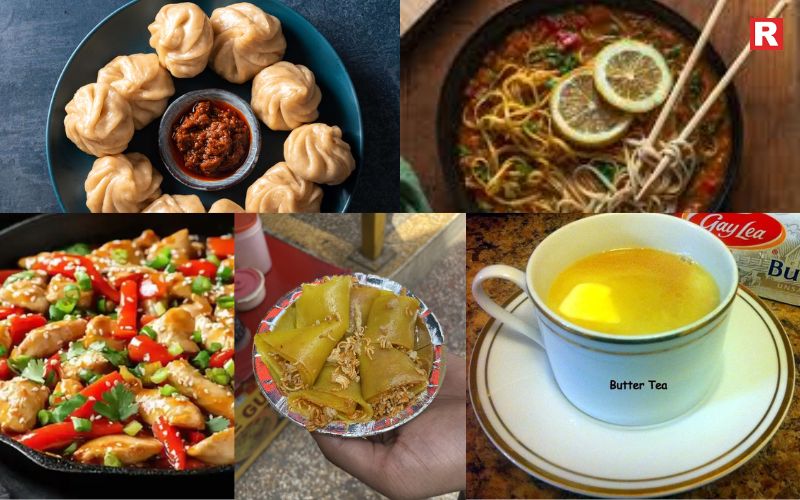
The Tibetan food trail in Delhi is a sensory experience — simple yet deeply satisfying.
- Momos are the heart of Tibetan street food. Steamed, fried, or pan-tossed, these dumplings are filled with minced chicken, pork, paneer, or vegetables, and served with fiery red chili sauce. In Majnu-ka-Tilla, every vendor has a secret recipe for the filling and the dipping sauce. Some are soft and juicy; others have a perfect crisp edge.
- Thukpa, a hearty noodle soup that’s both comforting and flavorful. Warm, aromatic, and often served with meat or vegetables, it’s a dish that feels like a hug on a winter evening. The rich broth, seasoned with garlic and spices, carries the essence of the Himalayas.
- Shapta, a spicy stir-fried meat dish tossed with chilies, onions, and soy. Served with tingmo (soft steamed bread), it’s bold and addictive — perfect for those who love spice with substance.
- Laphing, a street snack that has gained huge popularity among Delhi’s youth. Made from mung bean noodles and chili oil, this cold and spicy dish bursts with flavor. It’s refreshing, spicy, and incredibly fun to eat.
- Butter Tea, also known as Po Cha. made with tea leaves, yak butter, and salt. This drink surprises most first-time tasters. The flavor is rich and earthy—an acquired taste that reflects Tibet’s cold climate and high altitudes. For locals, it’s not just a beverage but a part of daily life.
Read more: 8 Famous Vegetarian Dishes of Uttar Pradesh and Their Timeless Legacy
A Bite of Banaras: 8 Iconic Street Foods You Can’t Miss in Varanasi
Hidden Gems and Must-Visit Spots
Majnu-ka-Tilla is filled with hidden culinary gems that capture the spirit of Tibet.
- Ama Café is one of the most popular spots. With its cozy wooden interiors, warm lighting, and fresh bakery items, it offers the perfect mix of Tibetan simplicity and modern comfort. Their pancakes, momos, and Himalayan coffee are crowd favorites.
- Dolma House serves home-style Tibetan food that feels comforting and authentic. Their thukpa and shapta are especially loved by regulars. The food is simple but full of soul — cooked just like in a Tibetan home kitchen.
- Rigo Restaurant is a must-visit. It’s known for its wide menu, which includes authentic dishes like phing sha (glass noodles with meat) and thenthuk (hand-pulled noodle soup). The restaurant has been serving locals and travelers for years, and its consistency keeps people coming back.
- Lhasa Restaurant, where the atmosphere is casual and welcoming. Their fried momos and chicken thukpa have a loyal fan base. Manju notes that every meal here feels like a journey—not just through taste, but through culture.
Know more: 5 Cities That Serve the Best Non-Vegetarian Street Food
The Cultural Essence Behind the Cuisine
Tibetan food carries the soul of the mountains. It’s shaped by geography, climate, and tradition. Ingredients like barley, noodles, yak butter, and meat are staples because they provide warmth and energy in cold regions. But beyond ingredients, the cuisine reflects a way of life rooted in balance and mindfulness.
The act of sharing food, drinking butter tea, or kneading dough for momos is done with care and patience. Even in the busy lanes of Delhi, this cultural essence remains intact. Every café, every stall, carries a part of Tibet’s story — a reminder of home for those who left it behind, and a window into another world for those discovering it.
A Journey Worth Taking
Tibetan street food is more than a culinary experience — it holds the kindness of the vendors, the laughter of college students sharing plates of momos, and the aroma of butter tea, all blending into something special. Despite the chaos of Delhi, Majnu-ka-Tilla holds a calm rhythm. It’s a place where flavors, faith, and friendship come together. The food may be simple, but it leaves a deep impression—one that lingers long after the last bite.
Delhi’s Tibetan street food scene is a vibrant celebration of culture and comfort. It offers warmth in every sip of thukpa and joy in every bite of momo. For those who want to experience more than just taste — who want to connect with stories, people, and heritage—Majnu-ka-Tilla is the place to be. As Manju K. Tilla’s journey shows, exploring food is not just about satisfying hunger; it’s about discovering humanity in every flavor. And in this little corner of Delhi, Tibet truly comes alive—one delicious dish at a time.
Also read: 10 Awadhi Cuisine Classics You Must Try at Least Once
Pani Puri Has Different Names in Different Indian States—Know Them All
10 Famous Non-Vegetarian Dishes of Uttar Pradesh: A Journey Through Flavour

Varanasi is one of the world’s oldest living cities. Known for its deep spiritual roots, it is also a paradise for those who love food. The city’s narrow lanes are always alive with sound and aroma. Pans sizzle with oil, spices roast in the air, and people gather at small stalls for their morning meals. Food in Varanasi is more than just taste. It reflects the spirit of the city—simple, soulful, and full of tradition. Each dish tells a story of culture and faith. From the famous kachori sabzi to the sweet malaiyo served only in winter, every bite feels like a piece of history.
Locals begin their day early, often visiting the ghats for prayers before heading to their favourite food stalls. Vendors, many of whom have been cooking for generations, prepare food with pride and patience. Visitors soon realise that eating in Varanasi is not just a meal—it’s an experience. It is about sharing space, stories, and smiles over plates of fresh, hot food. In every corner of this ancient city, food binds people together and celebrates life in its purest form.
Why Street Food is the Heartbeat of Varanasi
Street food in Varanasi is more than just snacks; it’s a way of life. Locals gather around stalls not only to eat but also to share stories, laughter, and daily news. Every corner has a different aroma, and every vendor has a tale that adds flavour to the city’s culture.
Here, food connects everyone—pilgrims, students, shopkeepers, and tourists alike. It reflects the city’s diversity and its ability to turn simple ingredients into something memorable.
8 Iconic Street Foods of Varanasi
1. Kachori Sabzi – The Breakfast of Banaras
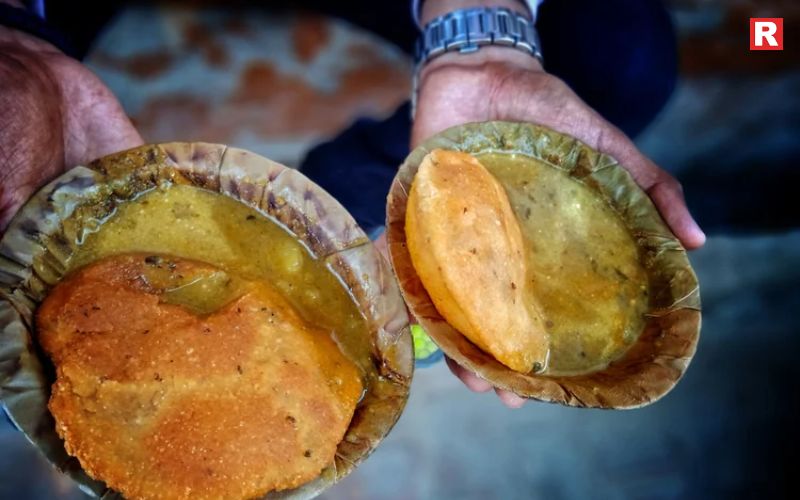
No morning in Varanasi begins without a plate of hot kachoris and spicy sabzi. The aroma of these crisp, golden kachoris being fried in ghee fills the streets as early as sunrise. Stuffed with either lentils or peas, they are served with a tangy, spicy potato curry that wakes up every sense. The first bite offers a perfect crunch followed by a burst of masala. Locals usually enjoy it with a side of jalebi for a complete breakfast. The best places to try this iconic dish are Ram Bhandar in Thatheri Bazaar and Madhur Milan near Godowlia Chowk. A morning walk along the ghats followed by a plate of kachori sabzi is the real Banaras experience—simple, soulful, and satisfying.
2. Tamatar Chaat – A Spicy Twist You Won’t Find Elsewhere
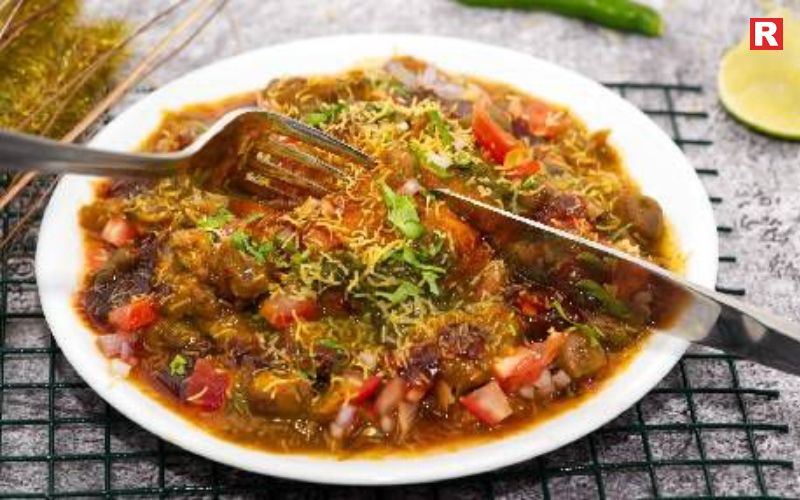
Varanasi’s tamatar chaat is unlike any other chaat in India. It’s tangy, buttery, and spicy, made by mashing boiled tomatoes with green chilies, spices, and a dollop of ghee. The result is a rich and slightly smoky dish that warms your palate and leaves you craving more. It’s usually served in small earthen bowls, topped with crunchy sev and a squeeze of lemon. Locals swear by Deena Chaat Bhandar on Dashashwamedh Road, where this dish has been perfected over generations. Tamatar chaat perfectly captures the city’s bold personality—fiery, flavorful, and full of surprises.
Read more: 8 Famous Vegetarian Dishes of Uttar Pradesh and Their Timeless Legacy
5 Cities That Serve the Best Non-Vegetarian Street Food
3. Baati Chokha – A Taste of Bhojpuri Pride

Baati chokha represents the rustic side of Varanasi’s food culture. It’s a dish that celebrates the earthy flavours of Bihar and eastern Uttar Pradesh. The baati, or wheat dough ball, is roasted until golden and crisp. It’s then served with chokha—a smoky mash of potatoes, tomatoes, and brinjals mixed with mustard oil and local spices. Traditionally cooked over coal or cow-dung cakes, the dish has a charred aroma that adds depth to its taste. Baati chokha is both hearty and wholesome, often enjoyed by workers and travellers alike. For an authentic experience, try it at Baati Chokha Restaurant on Assi Ghat Road, where the preparation still follows traditional methods.
4. Chena Dahi Vada – Soft, Sweet, and Refreshing

A lighter and sweeter version of the traditional dahi vada, Varanasi’s chena dahi vada is made with fresh cottage cheese balls soaked in chilled, sweetened curd. It’s topped with masala, tamarind chutney, and a sprinkle of roasted cumin. The dish has a smooth, melt-in-the-mouth texture that offers instant relief after spicy food. It’s perfect for afternoons when the city’s heat rises and you want something cooling. You can find this treat near Kashi Vishwanath Gali and Godowlia Chowk, where vendors serve it fresh with a smile.
5. Lassi – Creamy, Thick, and Served in Kulhad

If there’s one drink that defines Varanasi’s hospitality, it’s lassi. Served in a clay cup or kulhad, Varanasi lassi is rich, creamy, and often topped with a thick layer of malai and a spoon of rabri. You’ll find both sweet and flavoured versions—rose, mango, or saffron being the most loved. The Blue Lassi Shop near Manikarnika Ghat has become legendary for its range of flavours and its welcoming vibe. Sipping lassi here while watching the city’s hustle is an experience that connects you deeply with Banaras.
Know more: 10 Famous Non-Vegetarian Dishes of Lucknow That Define Royal Awadhi Cuisine
6. Malaiyo – The Winter Cloud Dessert of Varanasi
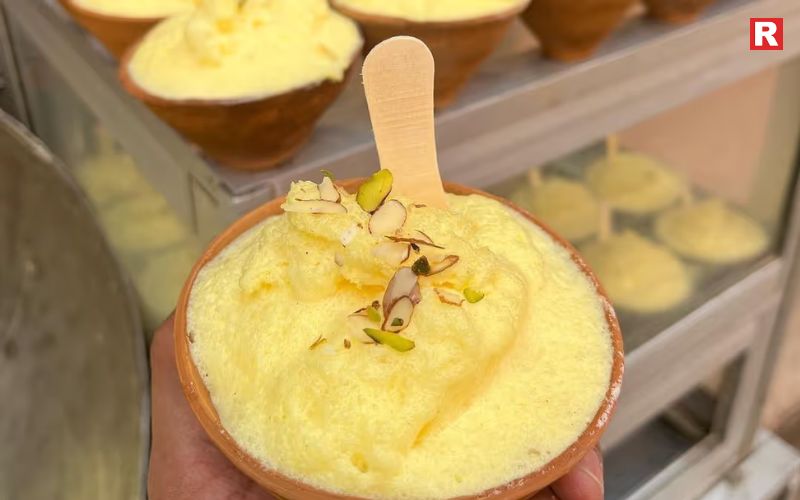
Malaiyo is not just a dessert—it’s magic. Made only during the winter months, this delicacy is crafted from milk foam, saffron, and nuts. The milk is left overnight to collect dew, which helps it turn airy and light. The result is a cloud-like dessert served in kulhads, available only in the early morning hours. You’ll find the best malaiyo in the lanes of Chowk and Vishwanath Gali. Locals wake up early just to savour this melt-in-the-mouth creation before it disappears by noon. It’s delicate, seasonal, and represents the poetic soul of the city—simple yet unforgettable.
7. Dahi Golgappe – Crunchy Meets Creamy

Varanasi adds its own creative twist to the classic golgappa. Instead of the usual spicy water, the puris are filled with sweet curd, tamarind chutney, and chaat masala. The contrast between the crisp shell and the smooth filling creates a unique taste that’s both tangy and sweet. You’ll find these mouth-watering golgappes at Kashi Chaat Bhandar in Godowlia. Locals often end their evening walks with a few plates of this crowd-favourite snack. It’s light, refreshing, and perfect for those who love experimenting with flavours.
Also check: 10 Authentic French Cuisine Dishes You Must Try
8. Banarasi Paan – The Perfect Sweet Ending
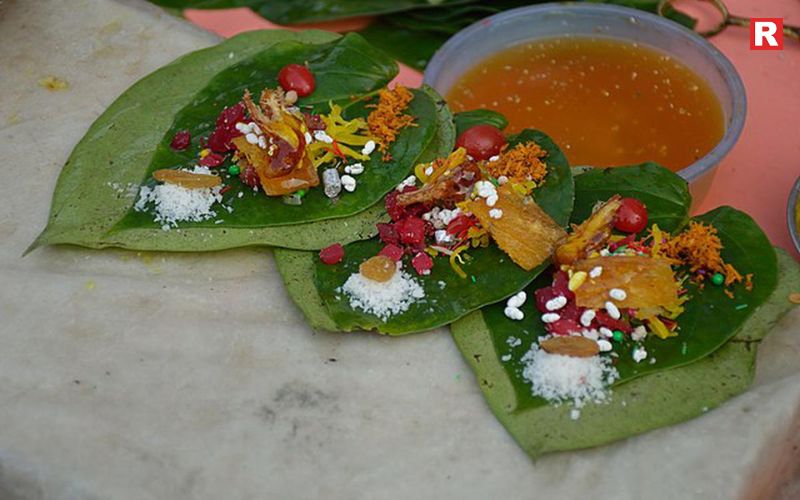
No food journey in Varanasi is complete without paan. It’s more than just a mouth freshener—it’s a symbol of the city’s culture and warmth. The Banarasi paan is made with betel leaf, gulkand, fennel seeds, and a secret mix of ingredients that vary from shop to shop. Chewing paan after a meal is a local tradition that has been followed for centuries. It’s also offered to guests as a gesture of respect. You can find the most authentic ones at Keshav Tambul Bhandar or small paan stalls near Dashashwamedh Ghat. The paan, with its sweetness and freshness, leaves a lingering taste of Banaras long after you’ve left.
Best Time to Explore Varanasi’s Street Food Scene
Mornings are ideal for kachori sabzi, malaiyo, and lassi. Evenings bring the city alive with chaat, golgappas, and paan. Winters are special because that’s when you can taste seasonal treats like malaiyo at its best.
The key is to explore the city on foot. Walk through the crowded lanes, talk to the vendors, and taste everything in small portions. Each lane offers something new, and the experience only gets better as you go deeper into the city’s heart.
Check more: 10 Famous Non-Vegetarian Dishes of Uttar Pradesh: A Journey Through Flavour
10 Awadhi Cuisine Classics You Must Try at Least Once
Top 5 States With the Spiciest Food in India
A Walk Through the Taste
Varanasi’s street food captures the essence of its people—warm, vibrant, and full of soul. Every bite tells a story of devotion, tradition, and timeless charm. From the crisp kachoris of Ram Bhandar to the delicate malaiyo in winter mornings, the city’s flavours are unforgettable.
To truly experience Varanasi, you must do more than visit its ghats or temples—you must eat like a local. Taste the streets, feel the culture, and let every flavour remind you why Banaras is not just a city, but an experience of a lifetime.

Chhath Puja is an ancient Vedic festival dedicated to the Sun God, celebrated primarily in Bihar and Eastern Uttar Pradesh. This four-day festival is marked by rigorous rituals, fasting, and the preparation of traditional dishes that follow strict dietary principles. The cuisine associated with Chhath Puja is distinctive for its adherence to sattvic cooking methods, which exclude onion, garlic, and emphasize natural ingredients. This year, Chhath Puja will start from October 25 to October 28.
The prasad (offerings) and festive meals prepared during Chhath Puja reflect the region's culinary heritage and religious traditions. These dishes use simple ingredients like wheat flour, rice flour, jaggery, ghee, and seasonal vegetables, prepared with minimal spices to maintain purity. Below are ten essential dishes that define the gastronomic aspect of this celebration.
Best Dishes to Try on Chhath Puja in 2025
1. Thekua
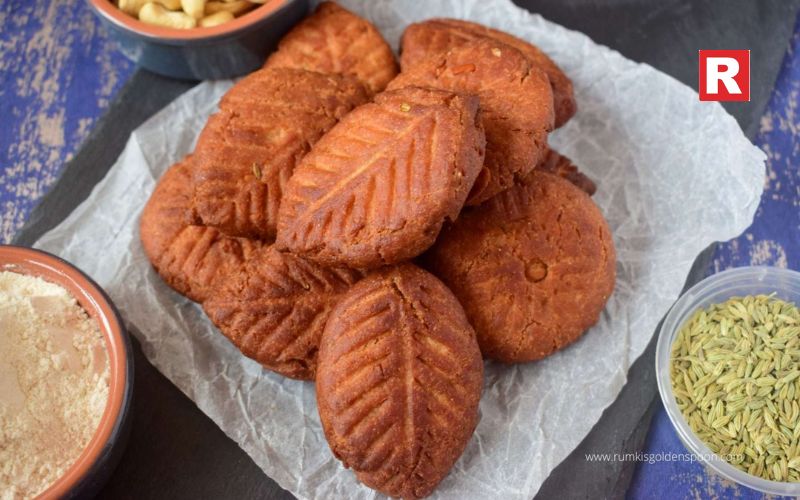
Thekua is the primary prasad of Chhath Puja, made from wheat flour, jaggery, grated coconut, and ghee. The dough is shaped into decorative patterns and deep-fried until golden-brown and crispy. Due to the preservative properties of jaggery and ghee, Thekua remains fresh for several weeks without refrigeration. It is distributed among family, neighbors, and devotees as a symbol of blessings and community sharing.
2. Rasiyaw (Gud Ki Kheer)
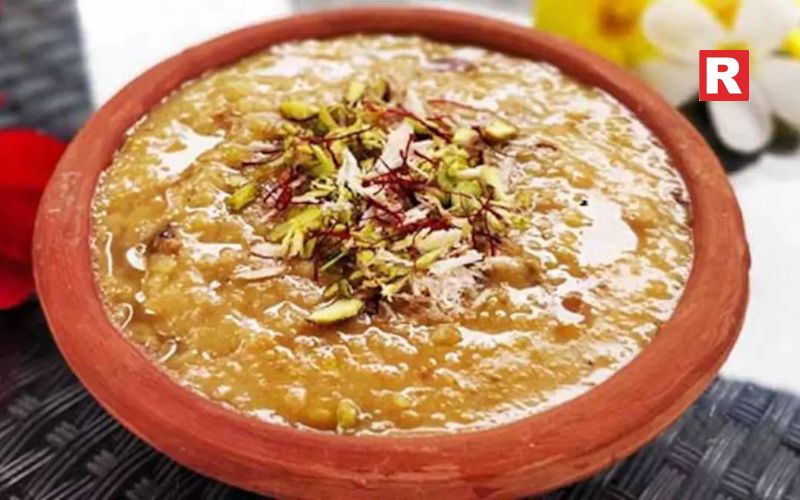
Rasiyaw is a traditional rice pudding prepared with rice, milk, and jaggery instead of refined sugar. The jaggery imparts a distinctive caramel color and earthy sweetness to the dish. It is typically offered during the evening rituals of Chhath Puja. The slow-cooking process allows the rice to absorb the jaggery-infused milk, creating a creamy texture with enhanced nutritional value from the minerals present in jaggery.
3. Chawal Ke Ladoo

These are sweet balls made from roasted rice flour, jaggery, and ghee. The rice flour is dry-roasted until aromatic, then combined with melted jaggery and ghee while warm, and shaped into spherical forms. Chawal Ke Ladoo represent the simplicity and wholesomeness that characterize Chhath Puja cuisine. They are easy to prepare in large quantities and serve as an ideal prasad for distribution.
4. Khajuria
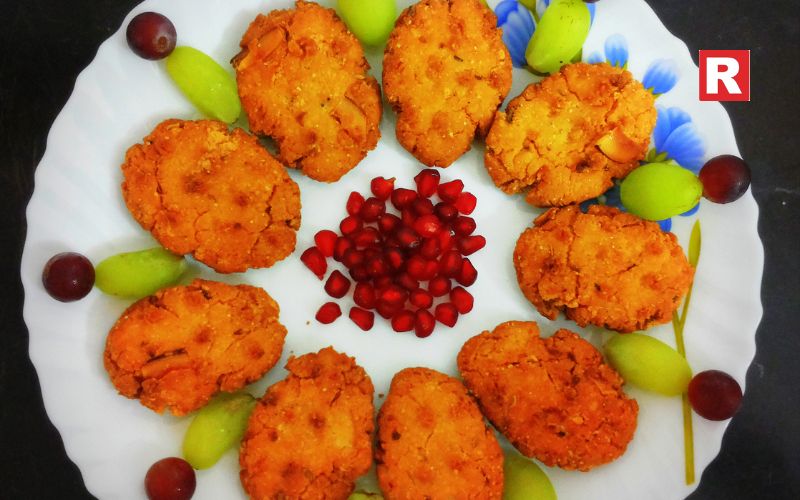
Khajuria is a deep-fried sweet prepared from rice flour, jaggery, and ghee. The batter consistency and oil temperature are crucial for achieving its characteristic crispy exterior and soft interior. The name derives from "khajur" (dates), though the dish contains no dates. Khajuria requires precision in preparation and is considered a delicacy that demonstrates culinary skill within traditional Bihari cooking.
5. Kaddu Bhaat
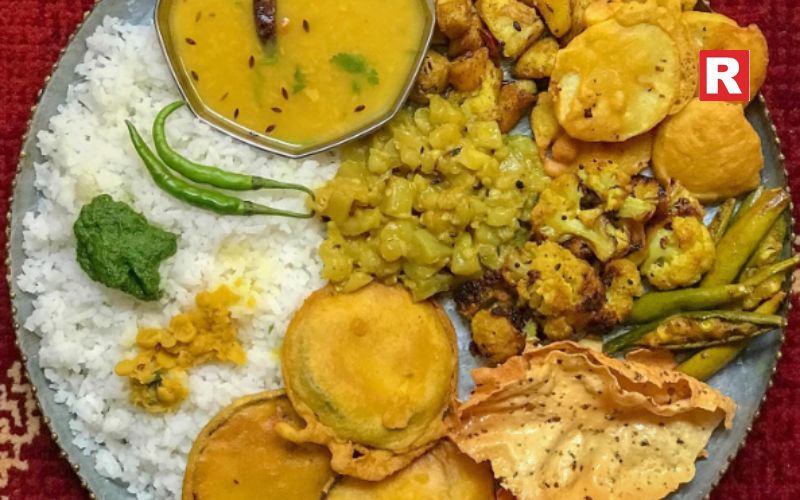
Kaddu Bhaat consists of pumpkin curry served with plain rice. The pumpkin is cooked with cumin, ginger, and turmeric, without onion or garlic, following sattvic principles. This mildly spiced dish is traditionally consumed after the morning arghya (offering to the sun). The natural sweetness of pumpkin complements the simplicity of steamed rice, making it a light yet nourishing meal after fasting.
6. Chana Ghugni
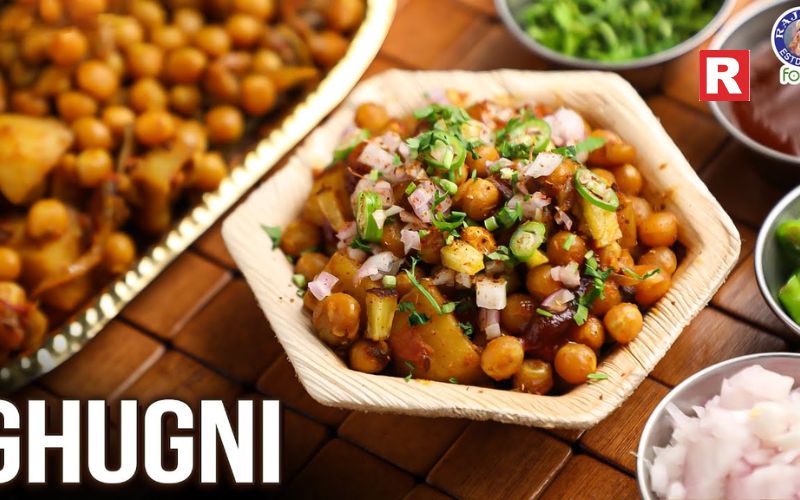
Chana Ghugni is prepared using black chickpeas that are soaked overnight and then cooked with minimal spices including cumin, ginger, and green chilies. This protein-rich dish has a rustic quality and is often paired with puris or rice. The preparation method preserves the texture of the chickpeas while allowing them to absorb the flavors of the spices used in the cooking process.
7. Aloo Ki Sabzi
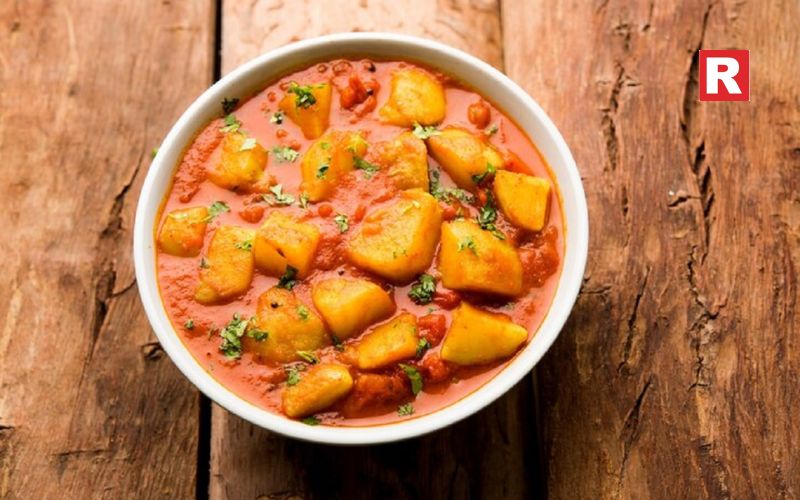
This potato curry is prepared without onion and garlic, using only cumin, ginger, and basic spices. The potatoes are cut into chunks and cooked in a light gravy. Aloo Ki Sabzi is a staple accompaniment during Chhath Puja, typically served with puris. Its simplicity and ease of preparation make it a practical choice for feeding large gatherings during the festival.
8. Tikri (Rice Roti)
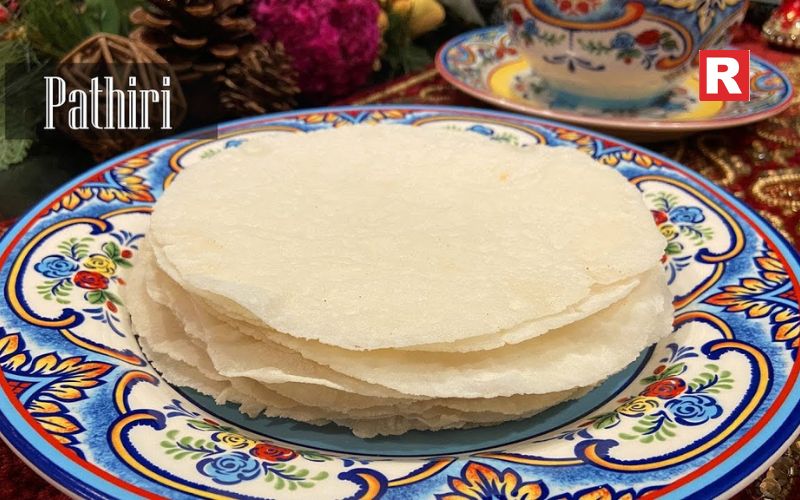
Tikri is a flatbread made from rice flour, offering a gluten-free alternative to wheat-based rotis. The dough has a softer consistency than regular roti dough and is rolled thicker. Tikri can be served with either sweet accompaniments like ghee and jaggery or with savory curries. The edges typically become crispy while the center remains soft during the cooking process.
9. Ratauli
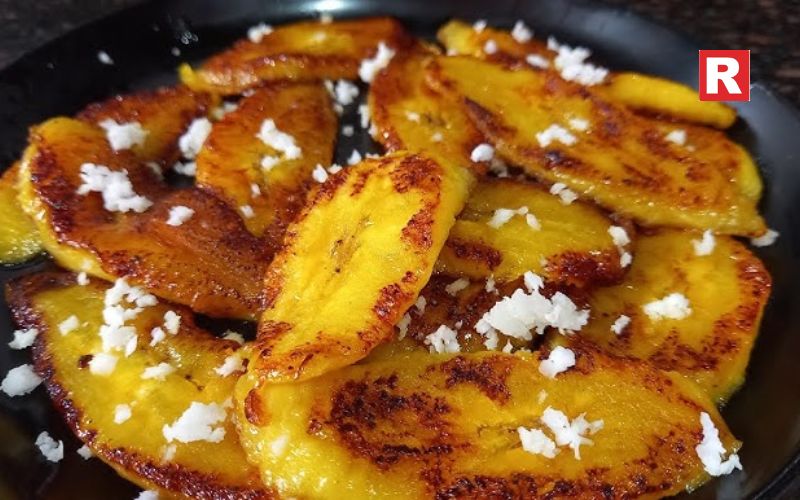
Ratauli is made from ripe bananas cooked with jaggery, ghee, and cardamom. The cooking process breaks down the bananas into a soft, pudding-like consistency. The cardamom adds fragrance while the jaggery caramelizes with the natural sugars in the banana. The dish has a texture between pudding and preserve, and is served in small portions due to its richness.
10. Malpua
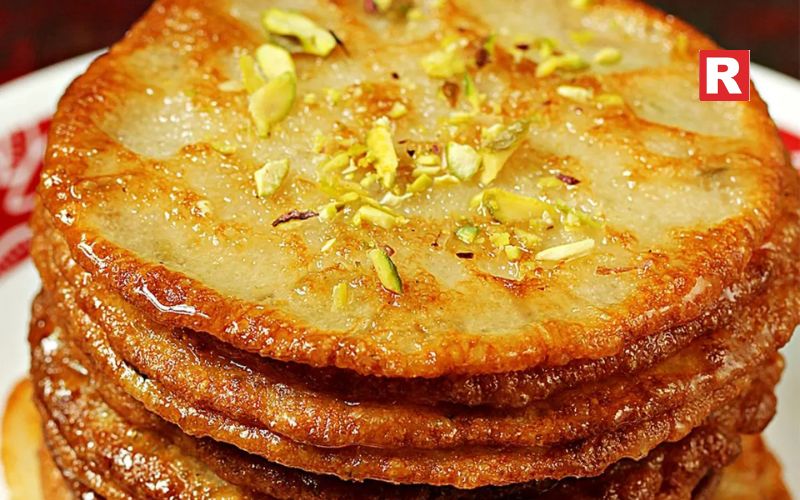
Malpua are pancake-like fritters made from flour and milk batter, deep-fried in ghee and soaked in sugar syrup. The cooking technique creates a crispy exterior while maintaining a soft interior. Malpua are commonly prepared during various Indian festivals but hold special significance during Chhath Puja as a celebratory sweet. Some regional variations include fennel seeds in the batter for additional flavor.
Chhath Puja 2025: Culinary Principles
Chhath Puja cuisine follows sattvic dietary principles, which emphasize:
- Purity of ingredients: Use of natural sweeteners, whole grains, and pure ghee
- Minimal processing: Simple cooking techniques that preserve nutritional value
- Seasonal and local produce: Ingredients traditionally available in Bihar and Eastern Uttar Pradesh
- Absence of tamasic foods: No onion, garlic, or ingredients considered to increase lethargy
- Cleanliness in preparation: Strict hygiene standards as food is meant for religious offering
These principles align with the spiritual aspect of the festival and reflect ancient Indian dietary wisdom that connects food with mental and physical well-being.
Chhath Puja Cultural Significance
The preparation and sharing of Chhath Puja dishes serve multiple purposes beyond nutrition. They maintain cultural continuity by preserving traditional recipes across generations. The practice of distributing prasad strengthens community bonds and social cohesion. The adherence to specific ingredients and methods demonstrates religious devotion and discipline. For many families, especially those from Bihar living elsewhere, preparing these dishes maintains a connection to their regional and cultural identity.
Conclusion
Traditional Chhath Puja dishes represent a unique culinary tradition that combines religious devotion with regional gastronomy. The emphasis on pure ingredients, simple preparation methods, and natural flavors distinguishes this cuisine from other festival foods. These ten dishes form the core of Chhath Puja celebrations, each carrying specific cultural and religious significance. Understanding and preparing these traditional foods offers insight into the rich cultural heritage of Bihar and the enduring traditions associated with sun worship in Indian culture.
Frequently Asked Questions
Q1: Why is no onion and no garlic used in Chhath Puja food?
Chhath Puja follows sattvic cooking principles where onion and garlic are avoided as they are considered tamasic and rajasic foods that create lethargy or restlessness, conflicting with the festival's devotional nature.
Q2: Can I make Thekua in advance? How long does it stay fresh?
Yes, Thekua can be stored for 2-3 weeks in an airtight container due to the natural preservative properties of jaggery and ghee.
Q3: Is jaggery really healthier than sugar? What's the difference?
Jaggery is unrefined and retains minerals like iron and has a lower glycemic index than refined sugar, making it a more nutritious sweetener option.
Q4: I'm not from Bihar—can I still make and enjoy these dishes?
Yes, these dishes can be prepared and enjoyed by anyone interested in regional Indian cuisine, as the ingredients are widely available.
Q5: What's the best dish to start with if I've never tried Chhath Puja food?
Thekua is recommended for beginners as it's the most iconic dish and has a familiar cookie-like format that appeals to most palates.
Q6: Can these dishes be made without ghee for a vegan version?
Coconut oil can substitute ghee in some recipes, though this creates a non-traditional fusion version rather than authentic Chhath Puja prasad.

French cuisine is known for its elegance, precision, and rich flavors. It is not just food—it is culture, tradition, and art. Each dish tells a story about the region it comes from. From the rustic kitchens of Burgundy to the sunlit coasts of Provence, French dishes have inspired chefs worldwide. Even in India, fine-dining restaurants bring authentic French flavors to the table, offering a taste of Europe without leaving the country.
Whether you are a seasoned foodie or just exploring international flavors, these ten French dishes are essential for every food lover. They showcase France’s love for fresh ingredients, careful cooking, and balanced flavors.
Find 10 French Cuisine Dishes You Must Try
1. Coq au Vin (Chicken in Red Wine Sauce)
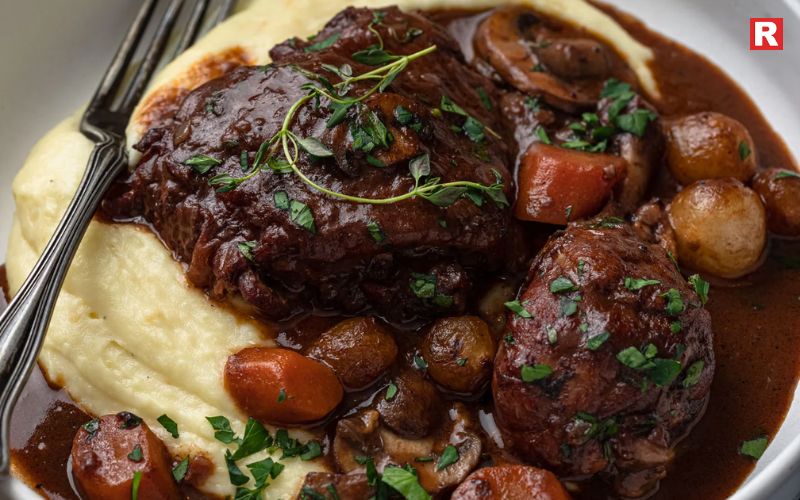
Coq au Vin is one of the most loved French dishes, known for its rich and rustic taste. Originating from the Burgundy region, it features chicken slow-cooked in red wine along with mushrooms, onions, garlic, and herbs. The slow simmering process infuses the meat with deep, complex flavors, making it tender and aromatic. This dish represents the heart of traditional French cooking — warm, hearty, and comforting. In India, several fine-dining French restaurants in Mumbai and Delhi serve Coq au Vin in its classic form, giving diners an authentic taste of rural France. Often paired with mashed potatoes or fresh baguettes, it is a perfect example of how simple ingredients can create magic when cooked with patience. Coq au Vin remains a must-try for those exploring authentic French cuisine in India.
2. Boeuf Bourguignon (Beef Stew in Red Wine)
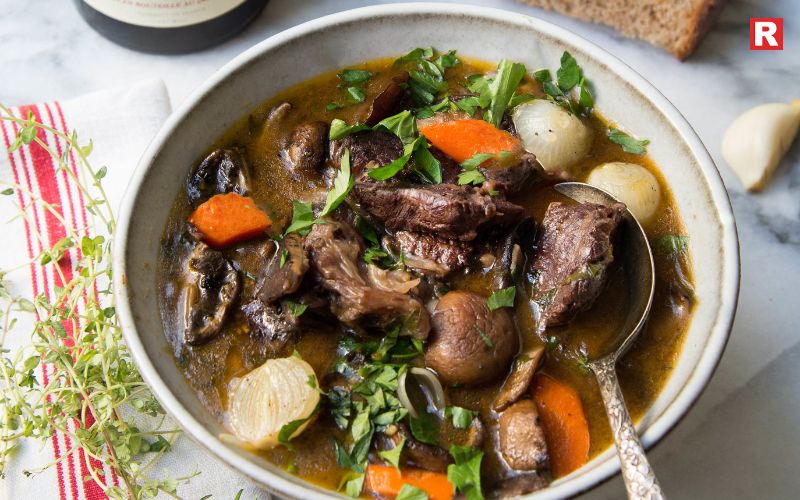
Boeuf Bourguignon is a traditional French beef stew that defines comfort food. It originates from Burgundy, a region famous for its wine and culinary heritage. The dish is made by slowly braising beef in red wine along with onions, carrots, and mushrooms. This process gives the beef a melt-in-the-mouth texture and a rich, deep flavor. Made famous by culinary legend Julia Child, Boeuf Bourguignon remains a global favorite for its simplicity and elegance. The hearty nature of this dish makes it perfect for cool evenings or festive dinners. In India, French fine-dining restaurants often recreate this classic with imported wine and premium cuts of meat. Its rich aroma and silky sauce showcase the beauty of traditional French food and why France is celebrated as a culinary capital.
Read more: 5 Main Types of French Wine You Must Know
A Guide to Different Breads and Their Nutritional Value
3. Ratatouille (Vegetable Stew from Provence)
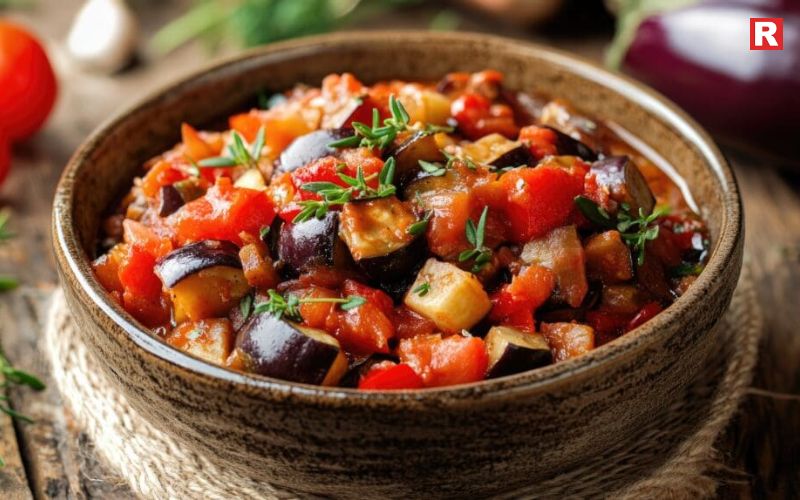
Ratatouille is a colorful vegetable stew from Provence, known for its freshness and simplicity. It is made using eggplant, zucchini, tomatoes, bell peppers, and herbs, cooked together until tender and flavorful. The dish celebrates the essence of French countryside cooking — fresh, light, and full of natural taste. It’s a great option for vegetarians and those looking for healthy yet delicious meals. The vibrant colors and Mediterranean aroma make Ratatouille stand out on any table. In India, French cafés and fine-dining restaurants serve it as a side or main dish. The slow-cooked vegetables retain their texture and taste, offering a balance of comfort and nutrition. Ratatouille perfectly represents authentic French cuisine — simple ingredients transformed into something special through passion and care.
4. Quiche Lorraine (Savory Tart)

Quiche Lorraine is a popular French tart that combines buttery pastry with a rich, creamy filling. Originating from the Lorraine region, it is made with eggs, cream, and bacon, baked to golden perfection. The smooth filling and crisp crust make it a favorite among those who enjoy subtle yet satisfying flavors. It is often served warm for brunch or cold as a light lunch, paired with salad or soup. In India, many continental cafés and French bakeries offer Quiche Lorraine as part of their all-day menus. It reflects the balance that French cooking is known for — elegance and comfort in one dish. Perfect for those who appreciate delicate textures and mild flavors, Quiche Lorraine remains a timeless French food classic that never goes out of style.
5. Soupe à l’Oignon (French Onion Soup)
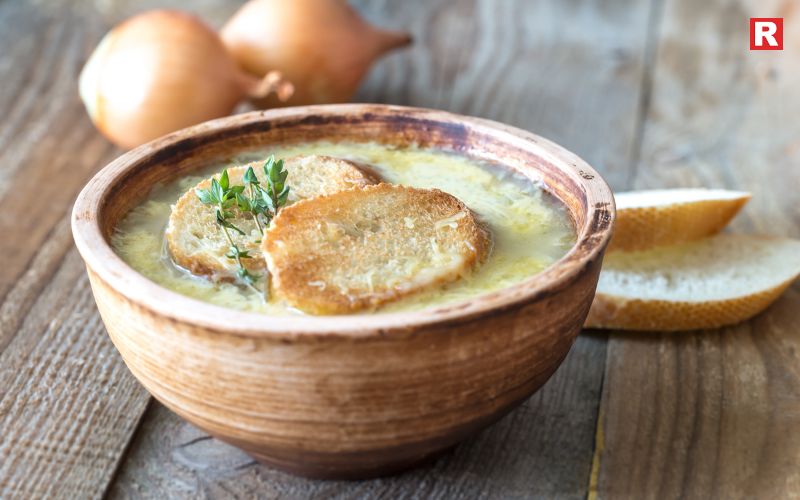
Soupe à l’Oignon, or French Onion Soup, is one of France’s most iconic comfort dishes. It is made by slowly caramelizing onions in butter and then simmering them in a flavorful beef broth. The soup is topped with a slice of toasted baguette and melted cheese, creating a blend of rich texture and deep flavor. It’s both sweet and savory, making it ideal for winter nights or cozy dinners. The golden crust of cheese adds warmth and heartiness to every spoonful. In India, several French restaurants in Delhi and Bangalore serve this traditional soup with authentic recipes. Soupe à l’Oignon perfectly captures the soul of classic French cuisine — simple ingredients turned into something extraordinary through technique and time. It is a dish that comforts and delights in every bite.
Know more: 8 Famous Vegetarian Dishes of Uttar Pradesh and Their Timeless Legacy
6. Duck Confit (Confit de Canard)
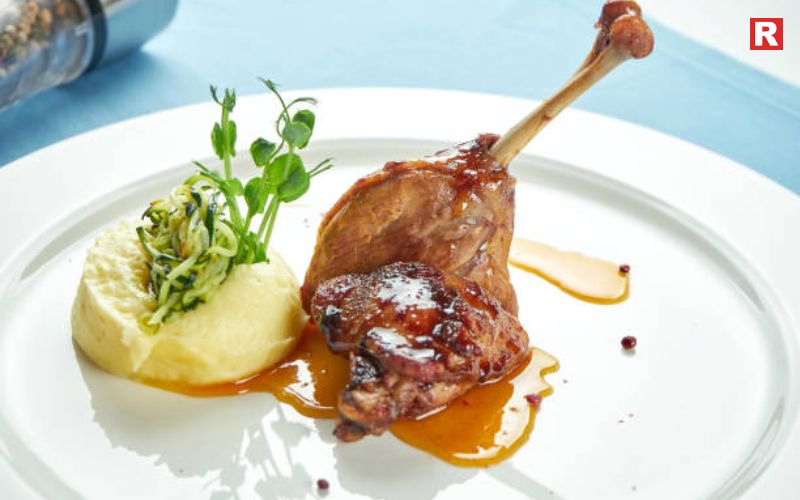
Duck Confit is one of the most celebrated dishes in traditional French cuisine. Originating from Gascony in southwest France, this delicacy is made by slow-cooking duck legs in their own fat. The method ensures the meat becomes tender while the outer skin turns perfectly crispy. This slow-cooking process reflects the precision and patience that define French cooking. Duck Confit is rich, flavorful, and deeply satisfying, making it a true indulgence for non-vegetarian food lovers. In India, it is served at fine-dining French restaurants that value authentic preparation and taste. The dish is often paired with roasted potatoes or sautéed greens, allowing the rich flavors to shine. Duck Confit stands as a fine example of authentic French food in India, loved for its texture, depth, and unforgettable taste.
7. Croissant & Pain au Chocolat (French Pastries)

Croissants and Pain au Chocolat are the heart of French breakfast culture. These flaky pastries are made from layers of buttery dough, baked to golden perfection. The Croissant offers a light, airy texture, while Pain au Chocolat hides a smooth chocolate filling inside. Both are loved for their simple yet luxurious taste. In India, French patisseries and bakeries in cities like Mumbai, Delhi, and Bengaluru serve freshly baked versions daily. They are often enjoyed with a cup of coffee or tea, adding a touch of French elegance to everyday mornings. Their crisp exterior and soft, buttery layers make them irresistible. These pastries represent the artistry of classic French baking — where every bite feels indulgent yet comforting. Whether in Paris or India, Croissants and Pain au Chocolat remain timeless favorites among pastry lovers.
8. Bouillabaisse (Seafood Stew from Marseille)
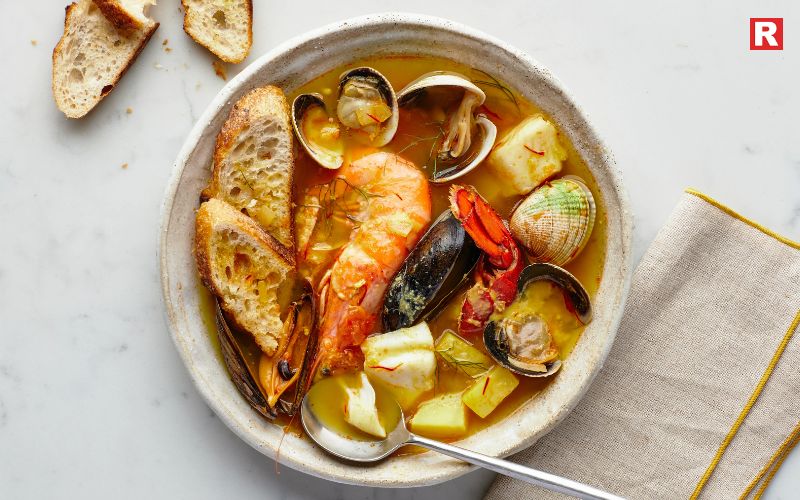
Bouillabaisse is a traditional seafood stew from Marseille, a port city in southern France. This flavorful dish combines fish, shellfish, saffron, garlic, and herbs to create a rich, aromatic broth. Originally made by fishermen using the day’s catch, Bouillabaisse reflects the spirit of coastal French cuisine. It is hearty, fragrant, and layered with complex flavors. The saffron gives it a golden hue and a subtle sweetness, while the seafood adds depth and freshness. In India, seafood lovers find Bouillabaisse fascinating as it offers a European interpretation of spice and flavor. Fine-dining French restaurants occasionally feature this dish for those who enjoy authentic French flavors with a seaside twist. Bouillabaisse stands out as one of the best French seafood dishes, combining tradition, taste, and craftsmanship in every spoonful.
Also check: 5 Cities That Serve the Best Non-Vegetarian Street Food
9. Crème Brûlée (Caramelized Custard Dessert)
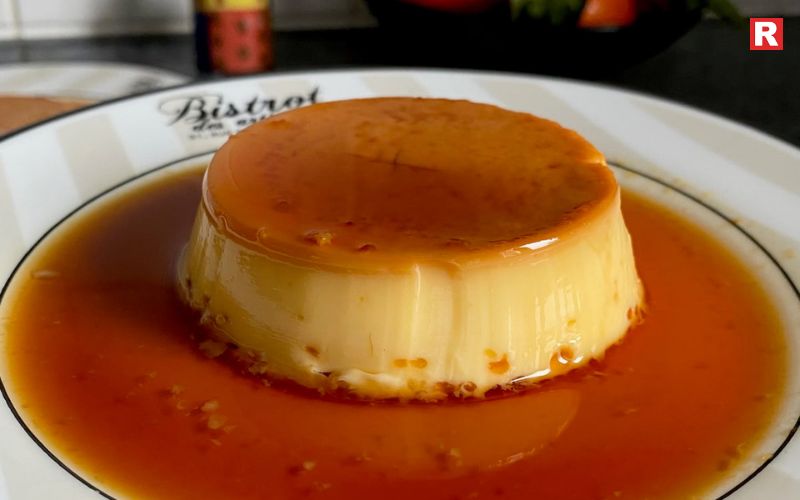
Crème Brûlée is one of the most elegant desserts in French cuisine. It features a creamy vanilla custard topped with a thin, crisp layer of caramelized sugar. The contrast between the crunchy top and smooth custard below makes it unforgettable. This dessert is loved worldwide for its simple ingredients and refined flavor. In India, Crème Brûlée is often found on menus at French and European fine-dining restaurants. Its golden caramel crust is made using a kitchen torch, giving it that perfect crack when tapped with a spoon. The dessert is light, sweet, and comforting, making it a perfect end to any meal. Known for its sophistication and balance, Crème Brûlée reflects the essence of traditional French desserts — timeless, rich, and beautifully crafted.
10. Tarte Tatin (Upside-Down Caramelized Apple Tart)

Tarte Tatin is a beloved French dessert that celebrates simplicity and flavor. It is an upside-down tart made with caramelized apples baked under a buttery pastry. When flipped after baking, it reveals glossy, golden apples coated in caramel. The dish was created by accident in the 19th century by the Tatin sisters, but quickly became a classic in French cuisine. Each slice offers a balance of sweetness, tartness, and crisp texture. In India, Tarte Tatin is served at select French bakeries and dessert cafés, especially during festive seasons. It pairs beautifully with whipped cream or vanilla ice cream. The dessert captures the creativity and warmth of authentic French baking, reminding diners that perfection often comes from simple mistakes turned delicious. Tarte Tatin remains a comforting favorite among dessert lovers worldwide.
The Art of French Cooking
French cooking is not just about recipes. It is about techniques like sauce-making, slow-cooking, and plating. Culinary schools like Le Cordon Bleu have trained chefs worldwide. These skills influence chefs in India and beyond, ensuring authentic French flavors.
Where to Try Authentic French Cuisine in India
Even in India, you can enjoy authentic French flavors. Some notable options are:
- Le Cirque, New Delhi – Classic French dishes served elegantly.
- The Table, Mumbai – French-inspired contemporary cuisine.
- Chez Panisse, Goa – Fresh seafood and French cooking techniques.
- L’Opéra Patisserie – Croissants, Tarte Tatin, and other French pastries.
These restaurants bring a slice of France to Indian diners.
Check more: How to Store Opened Wine—Keep the Magic Alive Beyond the First Pour
10 Awadhi Cuisine Classics You Must Try at Least Once
7 Types of Whiskies Everyone Should Try Once
French Bite!
French cuisine is known for its elegance and attention to detail. Each dish, from Coq au Vin to Crème Brûlée, carries a legacy of tradition and artistry. The French believe that food should please both the eyes and the palate. Every bite reflects balance, flavor, and passion. The use of wine, herbs, butter, and fresh produce gives each recipe a distinct charm.
For Indian diners, tasting French food is like discovering a new culture through flavor. Many fine-dining restaurants and cafés in India now serve authentic French dishes, offering a true Parisian experience. From buttery croissants for breakfast to a warm bowl of French Onion Soup at dinner, each dish offers comfort and sophistication. French cuisine is not just about taste—it is about slowing down, savoring, and celebrating food as an art form that connects people across continents.

Uttar Pradesh stands as one of India’s richest culinary destinations. Known as the land of Nawabs and poets, it carries a history that lives through its food. Every dish tells a story of royalty, patience, and craftsmanship. The state’s non-vegetarian cuisine reflects centuries of Mughal and Awadhi influence, where food was treated as an art form. Lucknow, its capital, is known for kebabs that melt in the mouth and biryanis that smell of saffron and ghee. Rampur offers spicy mutton curries with a bold, rustic touch. Moradabad brings biryani to the streets, where flavours speak of simplicity and heart. Across Uttar Pradesh, from Kanpur to Varanasi, every region adds its own twist to meat dishes.
The cooking here is slow, detailed, and filled with layers of flavour. Whole spices, tender meat, and age-old techniques create food that comforts and excites in equal measure. For meat lovers, Uttar Pradesh is more than a destination—it is a journey through royal kitchens, bustling markets, and homes that still cook with love and tradition.
A Taste of History and Heritage
The evolution of non-vegetarian cuisine in Uttar Pradesh is deeply tied to its royal past. During the rule of the Mughals and Nawabs, chefs experimented with new ingredients, spices, and cooking styles. They developed the dum pukht technique, mastered meat tenderization, and created dishes that were rich but balanced. Over time, these royal recipes blended with local tastes, giving rise to a diverse culinary identity that defines the state today.
From the luxurious tables of Lucknow to the smoky stalls of Kanpur, UP’s food culture celebrates craftsmanship, patience, and tradition. Every dish tells a story — of emperors, chefs, and communities who have kept these recipes alive for centuries.
Discover 10 famous non-vegetarian dishes of Uttar Pradesh
1. Galouti Kebab – Lucknow’s Royal Melt-in-the-Mouth Classic
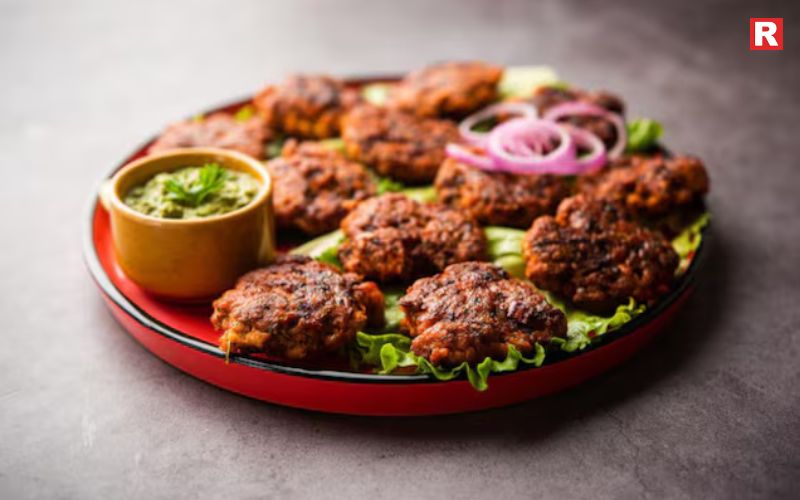
Galouti Kebab is the true pride of Lucknow. This dish was created in the 18th century for Nawab Asaf-ud-Daula, who loved kebabs but could no longer chew meat due to old age. His royal chefs crafted a kebab so soft that it would melt in the mouth. Minced meat is mixed with more than 30 spices and tenderized with raw papaya to achieve that perfect texture. It’s served with ulte tawe ka paratha, and together they create a taste of pure Nawabi luxury. Even today, Galouti Kebab remains one of the most loved delicacies in Awadhi cuisine.
2. Tunday Kababi – The Legacy of Lucknow’s Street Food
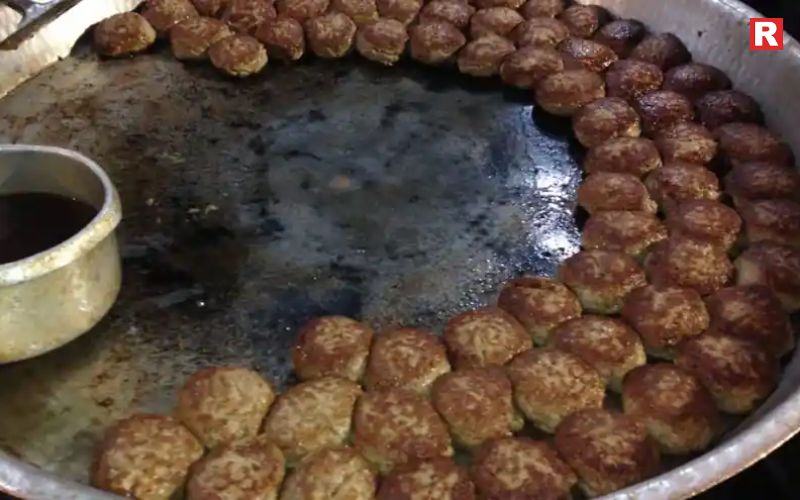
You can’t talk about Uttar Pradesh’s non-vegetarian food without mentioning Tunday Kababi. Located in the bustling lanes of Aminabad, this 100-year-old eatery serves the most iconic kebabs in the country. The recipe is said to include over 150 spices, passed down through generations. Each bite is packed with rich aroma, smoky texture, and heritage. Tunday Kababi is more than just a restaurant — it’s an institution that defines Lucknow’s culinary identity.
Read more: 8 Famous Vegetarian Dishes of Uttar Pradesh and Their Timeless Legacy
10 Famous Non-Vegetarian Dishes of Lucknow That Define Royal Awadhi Cuisine
3. Kakori Kebab – Soft, Smoky, and Refined
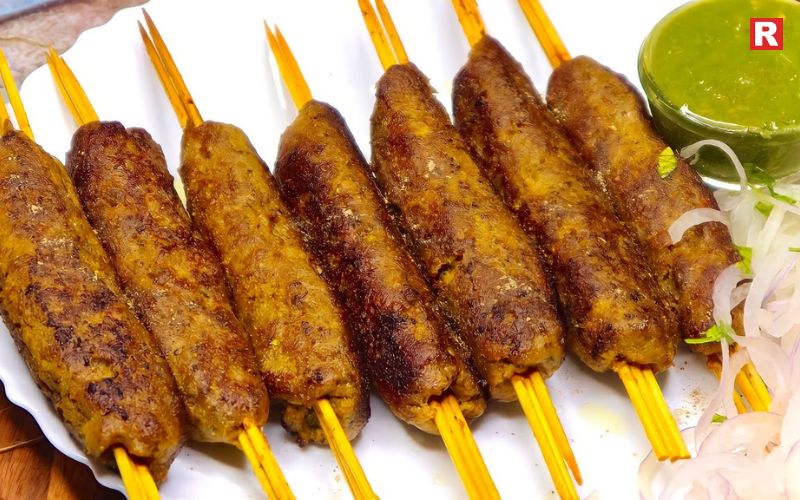
Kakori Kebab was born out of a Nawab’s embarrassment. During the British era, a nobleman in Kakori wanted to serve his guests kebabs, but they found them too coarse. His royal chefs refined the recipe by mincing the meat extra fine and marinating it with aromatic spices, saffron, and rose water. The result was a delicate, smooth kebab that became famous across India. Served hot off the grill, Kakori Kebabs still carry that touch of royal sophistication.
4. Mutton Korma – The Mughal Royalty on a Plate
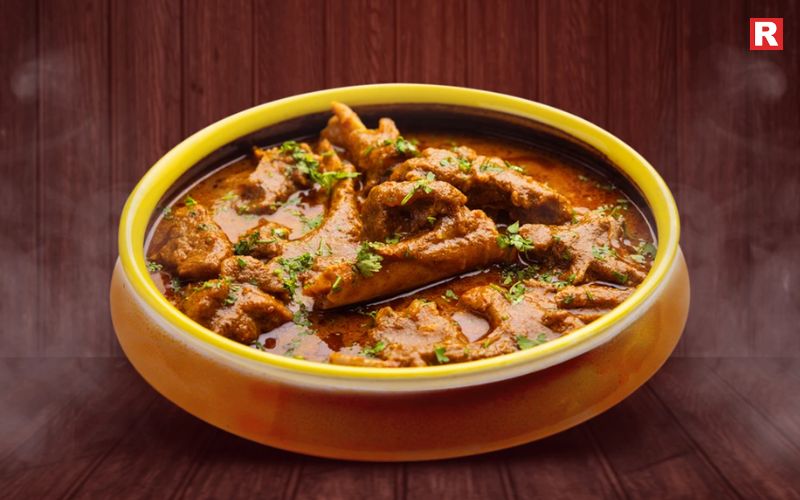
Mutton Korma is one of the oldest Mughal-inspired dishes from Uttar Pradesh. It combines tender pieces of mutton with yogurt, fried onions, and rich spices like cardamom, cloves, and cinnamon. The slow-cooking technique allows the flavours to blend beautifully, creating a thick, aromatic gravy. Traditionally cooked during royal feasts and weddings, this dish is a true representation of Mughal luxury. Today, it’s a Sunday favourite in many UP households, often paired with naan or steamed rice.
5. Nihari – The Breakfast of Kings
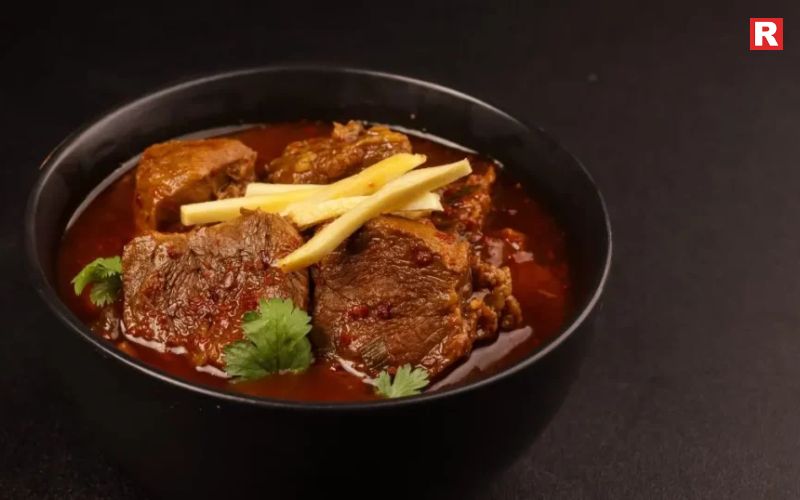
Nihari is not just a dish; it’s a tradition. Originating in Lucknow, it was once served to Nawabs after early morning prayers. The dish is slow-cooked overnight with meat, bone marrow, and spices, resulting in a rich, flavorful stew. The long hours of cooking make the meat incredibly soft, and the broth is thick with layers of flavour. Served with hot khameeri roti, Nihari is a breakfast that truly defines royal indulgence.
Know more: 5 Cities That Serve the Best Non-Vegetarian Street Food
6. Awadhi Biryani – The Crown Jewel of Lucknow

Awadhi Biryani stands apart from other biryanis in India. While the Hyderabadi version is spicy, Awadhi Biryani is known for its subtle aroma and refined taste. The dum pukht method — where marinated meat and rice are slow-cooked together in a sealed pot — infuses every grain with rich flavour. Saffron, rose water, and fried onions add depth and fragrance. The result is a royal dish that captures the elegance of Lucknowi cuisine.
7. Rampuri Mutton Curry – The Forgotten Royal Gem
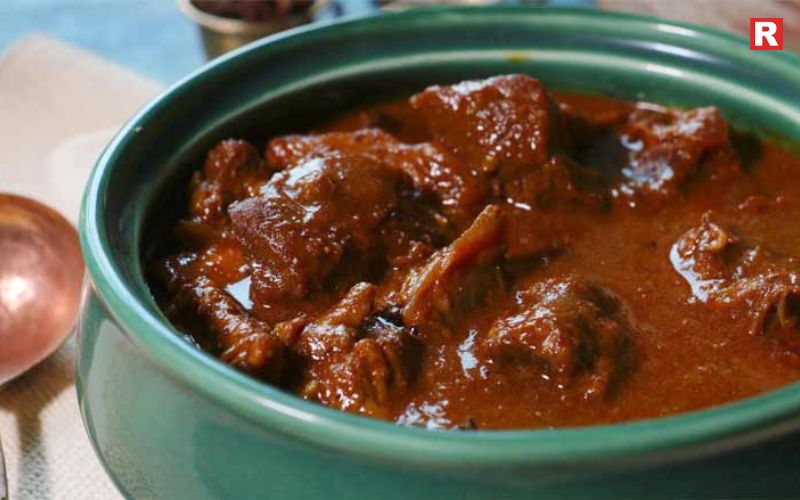
Rampur, once a princely state, had its own distinct royal kitchen. Rampuri Mutton Curry is a dish that combines the richness of Mughal cooking with local flavours. It uses roasted spices, dry fruits, and browned onions to create a smoky, spicy, and slightly nutty gravy. The balance of flavours is what makes it special — not too heavy, yet deeply satisfying. This dish is a reminder of Rampur’s hidden culinary heritage, which deserves much more attention today.
8. Moradabadi Biryani – The Street-Style Favourite
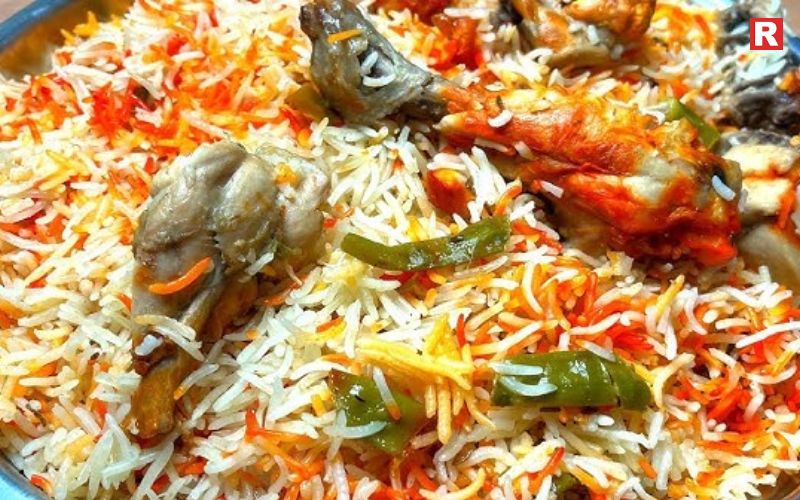
While Lucknow’s biryani speaks of royal elegance, Moradabadi Biryani is loved for its rustic simplicity. It’s spicier, tangier, and cooked with fewer ingredients — yet every bite bursts with flavour. Street vendors often serve it with sliced onions, mint chutney, and lemon juice. It’s a perfect example of how everyday food can become legendary when prepared with passion. Moradabad’s version is proof that biryani doesn’t always need royal roots to win hearts.
9. Murgh Musallam – The Whole Chicken Wonder
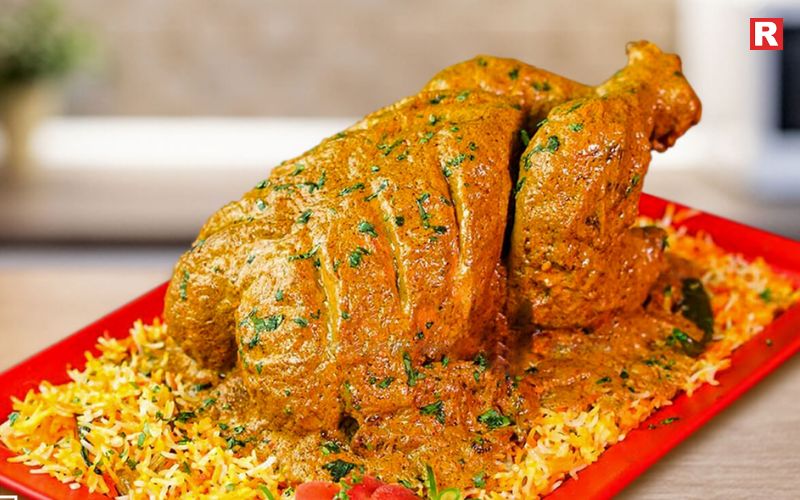
Murgh Musallam is another royal dish that once graced Mughal feasts. It’s made using a whole chicken marinated in yogurt, saffron, and ground nuts, then stuffed with eggs or spiced mince. The bird is slow-cooked until tender, absorbing all the flavours of the rich gravy. Served with rice or parathas, it’s an indulgent meal that speaks of grandeur. The dish was once a symbol of hospitality and is still cooked during festive occasions in many parts of UP.
Also check: Pani Puri Has Different Names in Different Indian States—Know Them All
World’s Tastiest Wraps: A Global Tour of Flavours
5 Tasty Dishes from Bihar You Must Try
10. Keema Kaleji – The Spicy Everyday Favourite

Keema Kaleji is a dish that reflects the everyday non-vegetarian culture of Uttar Pradesh. Found in small dhabas and local homes alike, it’s made with minced meat and liver cooked in a spicy, thick gravy. The bold use of ginger, garlic, and garam masala gives it a deep, rustic flavour. It’s best enjoyed with tandoori roti or pav. This dish shows how UP’s food balances comfort and intensity, making even simple ingredients taste extraordinary.
Where to Experience These Dishes
- Lucknow: Visit Tunday Kababi, Idris Biryani, and Rahim’s Nihari for authentic Awadhi flavours.
- Rampur: Try traditional mutton curries made with dry fruits and smoky spices.
- Varanasi: Explore street kebabs alongside the famous chaats.
- Kanpur and Agra: Known for spicy Keema and robust Korma preparations.
Why UP’s Non-Veg Cuisine Stands Apart
Uttar Pradesh’s non-vegetarian food is not about overpowering spice; it’s about balance and depth. The use of slow-cooking techniques, fragrant whole spices, and carefully layered flavours makes each dish a masterpiece. Whether you prefer the royal touch of Lucknow or the homely charm of a roadside dhaba, UP offers something for every palate.
Tasty Treat!
Uttar Pradesh’s non-vegetarian cuisine captures the essence of time, tradition, and taste. It reflects the state’s royal legacy and its love for food that goes beyond the ordinary. Every dish, from a kebab to a biryani, carries a story — of Nawabs, local cooks, and family recipes passed down through generations. The flavours are rich but balanced, the aromas deep yet comforting. Across cities like Lucknow, Rampur, and Moradabad, food is more than sustenance — it is culture. Each meal celebrates the art of slow cooking and the mastery of spices. The dishes connect the old with the new, where every bite reminds one of the state’s glorious past and its thriving food heritage. For anyone who enjoys regional flavours, Uttar Pradesh offers a taste of history served on a plate — simple, soulful, and unforgettable.

Lucknow, the City of Nawabs, is not just a destination—it’s an experience. Known for its royal etiquette, stunning architecture, and soulful poetry, the city also holds a special place in India’s culinary history. Lucknow’s non-vegetarian dishes are a legacy of the Awadhi cuisine, shaped by Mughal influences and perfected by generations of skilled cooks in royal kitchens. Each dish tells a story of tradition, patience, and passion.
Awadhi food is known for its dum pukht style of slow cooking, delicate use of spices, and melt-in-the-mouth textures. Whether it’s the soft Galouti Kebab or the rich Mutton Korma, every bite transports you to the grandeur of the Nawabi era. Here are ten iconic non-vegetarian dishes from Lucknow that capture its royal essence.
Discover 10 Famous Non-Vegetarian Dishes of Lucknow
1. Galouti Kebab – The Melt-in-the-Mouth Marvel

The story of the Galouti Kebab goes back to the 17th century when a toothless Nawab of Lucknow wanted to enjoy meat but could no longer chew it. His royal chefs, known as khansamas, crafted a soft kebab made from finely minced meat, papaya, and more than 100 spices. The result was a kebab so tender that it melts in your mouth effortlessly. Today, Galouti Kebabs are served with ulte tawe ka paratha and onion rings. The dish remains a favorite among food lovers for its silky texture and aromatic flavor. You can still find the most authentic version at Tunday Kababi, a name that has become synonymous with Lucknow’s food identity.
2. Tunday Kababi – A Legacy on a Plate

It’s impossible to talk about Lucknow’s non-vegetarian food without mentioning Tunday Kababi. This iconic eatery was established by Haji Murad Ali, who had only one arm—hence the name “Tunday.” His secret recipe includes over 150 spices, and the kebabs are grilled to perfection on a flat pan. Locals and tourists alike queue up every day to taste this culinary wonder. Soft, spicy, and dripping with flavor, Tunday Kababi is more than food—it’s a piece of history served on a plate.
Read more: 8 Famous Vegetarian Dishes of Uttar Pradesh and Their Timeless Legacy
5 Cities That Serve the Best Non-Vegetarian Street Food
3. Kakori Kebab – The Royal Grilled Delight

Originating from the town of Kakori, this kebab was created for British officers who found the traditional Seekh Kebabs too coarse. The chefs replaced rough meat with finely minced lamb and added raw papaya to tenderize it. The result was a smoother, silkier version that came to be known as the Kakori Kebab. Cooked over charcoal and lightly brushed with butter, this kebab is a royal treat that continues to impress with its smoky aroma and rich texture.
4. Seekh Kebab – The Charred Perfection
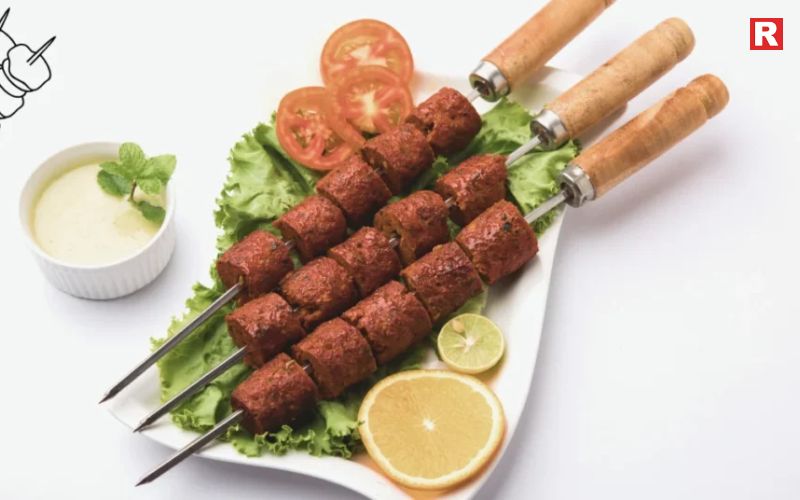
Seekh Kebabs are one of the oldest and simplest Awadhi dishes. Minced meat is mixed with spices, shaped around metal skewers, and grilled over open coal. The smoky flavor, combined with butter and lemon juice, makes it irresistible. Served hot with mint chutney and onions, Seekh Kebabs are a staple in Lucknow’s food festivals and evening gatherings. The simplicity of its preparation is what makes it timeless.
5. Boti Kebab – A Fiery Treat for Meat Lovers

For those who love a smoky and spicy kick, the Boti Kebab is a must-try. It is made with chunks of marinated mutton roasted over open flames until tender and juicy. The spices, yogurt, and charred edges create a perfect balance of heat and flavor. This kebab is often served as a starter in Lucknow’s traditional feasts and pairs beautifully with roomali roti or naan.
Know more: 10 Awadhi Cuisine Classics You Must Try at Least Once
6. Nihari – The Breakfast of Nawabs
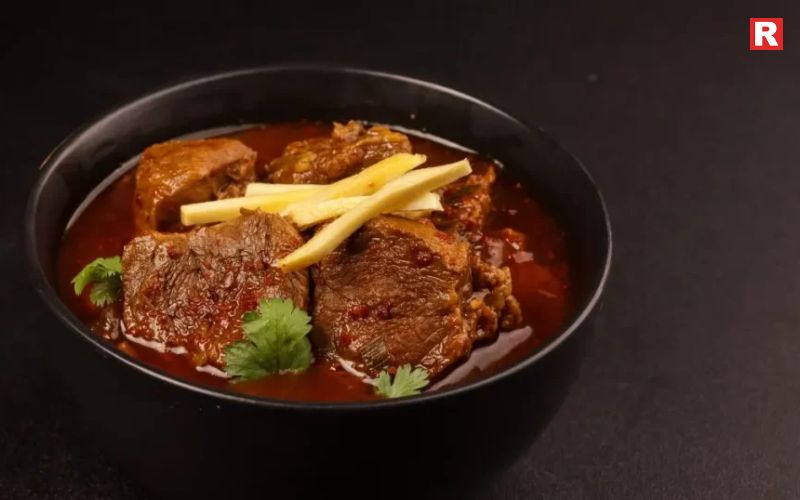
Nihari is one of Lucknow’s most celebrated dishes, traditionally cooked overnight and eaten early in the morning. The name “Nihari” comes from the Arabic word nahar, meaning “day,” as it was often served after morning prayers. This rich stew of slow-cooked mutton shanks, flavored with aromatic spices and ghee, is best enjoyed with khameeri roti. Back in the day, it was the royal breakfast of the Nawabs, but today, it’s comfort food for every Lucknowite. Rahim’s Nihari, located near Akbari Gate, is one of the oldest and most famous spots to try this dish.
7. Mutton Korma – The Creamy Royal Curry
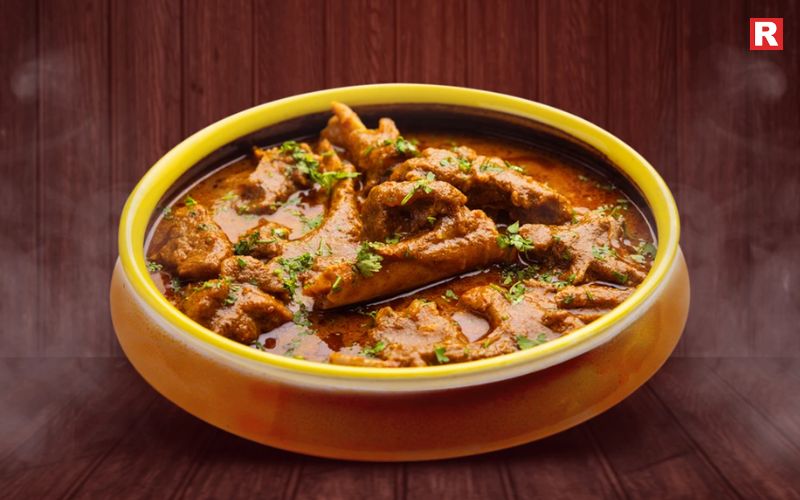
Mutton Korma is another gem from Lucknow’s royal kitchens. It’s made with tender mutton pieces simmered in a thick gravy of yogurt, fried onions, cashew paste, and saffron. The dish strikes a perfect balance between richness and subtle spice. The slow-cooking method allows every flavor to seep into the meat, giving it a deep, aromatic taste. Mutton Korma is not just food—it’s an experience that showcases the finesse of Awadhi cuisine.
Also check: Top 5 States With the Spiciest Food in India
8. Chicken Awadhi Biryani – The Fragrant Feast
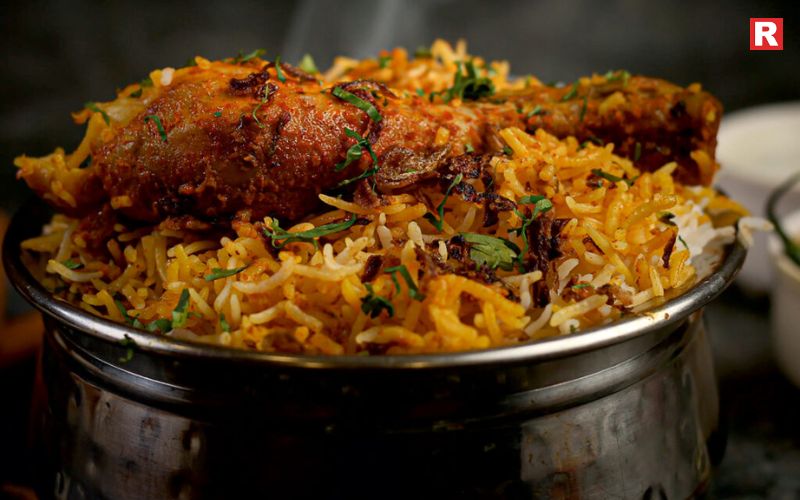
Lucknow’s biryani is different from the Hyderabadi version. Here, the rice and meat are cooked separately and then layered together in a sealed pot using the dum technique. The flavors of saffron, kewra, and rose water infuse the entire dish with a delicate fragrance. The Chicken Awadhi Biryani stands out for its subtlety. It’s not too spicy, yet every grain of rice is rich in aroma. Served with raita or salad, it’s a dish that defines royal comfort.
9. Pasanda – The Nawabi Indulgence
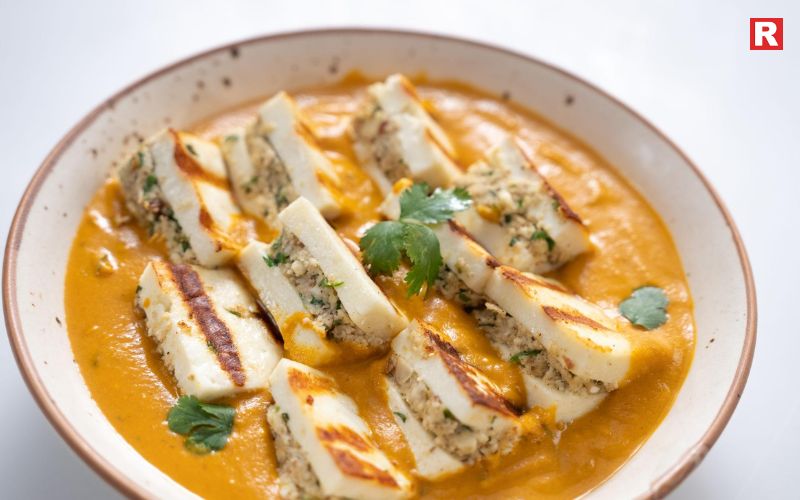
Pasanda was a favorite at royal banquets. The word “Pasanda” comes from the Urdu word pasand, meaning “favorite.” It is made using thin slices of mutton that are marinated and cooked in a creamy gravy of almonds, yogurt, and mild spices. This dish is luxurious, with a nutty flavor and smooth texture that reflect the refinement of Lucknow’s culinary traditions. Pasanda is usually paired with naan or sheermal for a complete royal meal.
10. Shami Kebab – The Timeless Favorite
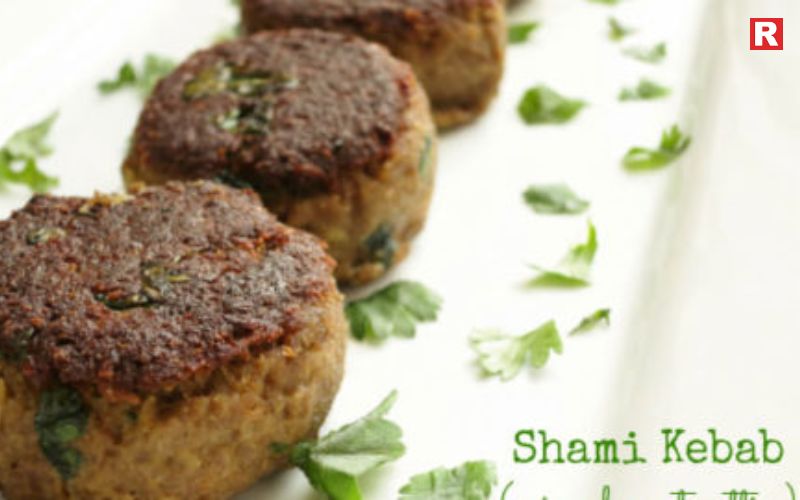
Simple yet flavorful, Shami Kebabs are made with minced meat, chana dal, and a mix of aromatic spices. The mixture is shaped into small patties and shallow-fried until golden brown. Crispy on the outside and soft on the inside, Shami Kebabs are a staple during Eid celebrations and family gatherings. They are often served with mint chutney or added to biryanis for an extra layer of flavor.
The Essence of Awadhi Cuisine
The secret behind Lucknow’s legendary dishes lies in the dum pukht cooking technique. This method involves slow-cooking food in a sealed pot over a low flame, allowing the ingredients to cook in their own juices. It preserves the aroma, taste, and texture, resulting in dishes that are rich and layered.
Awadhi cuisine also stands out for its use of saffron, rose water, and dried fruits. The balance of flavors—never too spicy, never too bland—is what makes it unique and royal.
Check more: 6 Unexpected Benefits of Eating Jackfruit (Kathal) – Nature’s Spiky Surprise!
Top 7 Regional Indian Thali Platters That Showcase Culinary Diversity
7 Chinese Dishes That Can Be a Healthy Option for Your Diet
Where to Try These Dishes in Lucknow
To truly experience Lucknow’s non-vegetarian delights, visit these iconic spots:
- Tunday Kababi, Aminabad: For authentic Galouti Kebabs.
- Rahim’s Nihari, Chowk: For the original Nihari experience.
- Dastarkhwan, Hazratganj: For Mutton Korma and Pasanda.
- Royal Café, Hazratganj: For modern takes on traditional Awadhi dishes.
About Lucknow’s Non-Veg Cuisine
- “Galouti” literally means “soft,” describing the texture of the kebab.
- Nihari was once cooked overnight and served to Nawabs after their morning prayers.
- Kakori Kebabs were first served to British guests during colonial times.
- Tunday Kababi’s spice blend remains a family secret passed down through generations.
Essence Of Royalty!
Lucknow’s non-vegetarian food is a treasure of India’s culinary history. It is not just about eating; it is about experiencing tradition. The city’s dishes are a mix of Mughal influence and Nawabi refinement. Each meal is prepared with care, using slow-cooking methods and aromatic spices. Galouti Kebab, soft and flavorful, melts in the mouth. Mutton Korma is rich and creamy, full of nuts and spices. Nihari, slow-cooked overnight, was once a royal breakfast. Chicken Awadhi Biryani, layered with fragrant rice and tender meat, shows the skill of Awadhi chefs. Pasanda and Shami Kebab are simple yet full of flavor. These dishes tell stories of the city’s past. They carry the taste of royalty and the warmth of tradition. For anyone who wants to understand Lucknow, the food is the best place to start. It brings history, culture, and flavor together on a single plate.

If there’s one thing that defines Mumbai as much as its skyline and sea breeze, it’s the aroma of food wafting through its lanes. The city’s street food is not just about quick bites — it’s a reflection of migration, resilience, and innovation.
A Historical Taste of Mumbai’s Street Food Culture
The story of Mumbai’s street food began in the mid-19th century, when textile mills drew thousands of workers from Maharashtra and Gujarat. These labourers needed affordable, filling meals they could eat during short breaks — and that’s how Mumbai’s street food revolution began. Vendors set up outside mills, stations, and ferry points, selling pav-based snacks, farsan, and spicy curries that soon became iconic.
Over time, migrants brought their own flavours — Gujarati farsan, South Indian dosas, Maharashtrian misal, and Koli seafood — creating an unmatched food mosaic. By the 1980s, Khau Gallis (food streets) like Ghatkopar, Mohammed Ali Road, and Girgaum Chowpatty had become cultural landmarks.
Today, from officegoers to celebrities, everyone in Mumbai unites over one thing — street food that speaks the city’s language: fast, flavourful, and full of life.
10 Best Street Foods of Mumbai
1. Vada Pav

Invented in 1966 outside Dadar Station by Ashok Vaidya, who ran a small tea stall, the Vada Pav was created as a quick, affordable meal for mill workers rushing to catch trains. The spicy potato vada tucked inside a pav with green chutney and dry garlic powder soon became an icon.
If you want to taste the most legendary version, head to Anand Stall near Mithibai College, Graduate Vada Pav at Byculla, or Ashok Vada Pav at Dadar — all serving hundreds of customers a day.
2. Pav Bhaji
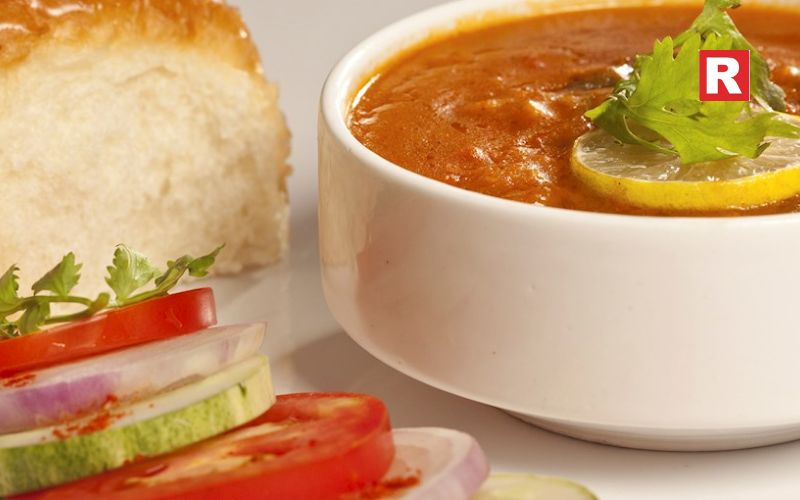
Back in the 1850s, textile workers finishing late shifts needed quick meals. Vendors mashed leftover vegetables on large tawas and served them with buttered pav — and thus, Pav Bhaji was born. What started as worker food evolved into the city’s favourite midnight feast.
The best versions still sizzle at Sardar Pav Bhaji in Tardeo, Canon Pav Bhaji near CST, and the countless stalls along Chowpatty Beach, where the butter melts faster than the waves roll in.
3. Batata Vada
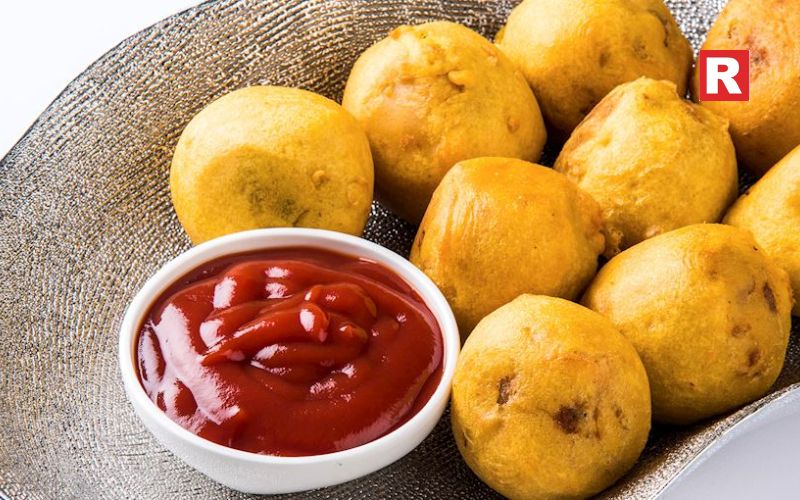
When the British introduced potatoes to India, Maharashtrian households turned them into spicy fritters — the Batata Vada. Over time, it became the perfect rainy-day companion for Mumbaikars. Crisp on the outside, soft inside, it’s often eaten with chutney or tucked into pav — a snack that perfectly captures the city’s love for spice and simplicity.
To experience its best form, stop by Aaram Vada Pav opposite CST or Prakash Uphar Kendra in Dadar, where locals swear by their golden, freshly fried vadas.
4. Misal Pav
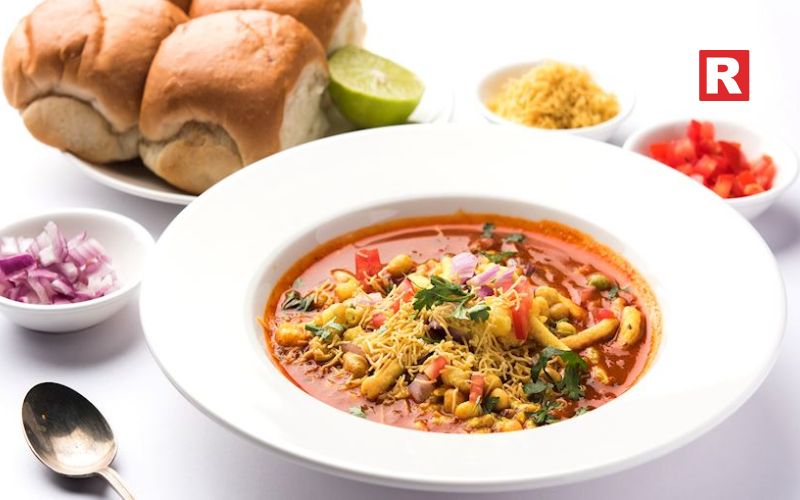
Originally from Pune and Kolhapur, Misal Pav found a new identity on Mumbai’s streets in the 1960s. Street vendors adapted it for city tastes — spicier, tangier, and loaded with farsan. The combination of sprouted moth beans curry, chopped onions, lemon, and soft pav creates a fiery, flavour-packed breakfast that wakes you up faster than coffee.
Try Aaswad in Dadar, which even won a world award for its Misal, or Mamledar Misal in Thane for that authentic Kolhapuri kick.
5. Sabudana Vada
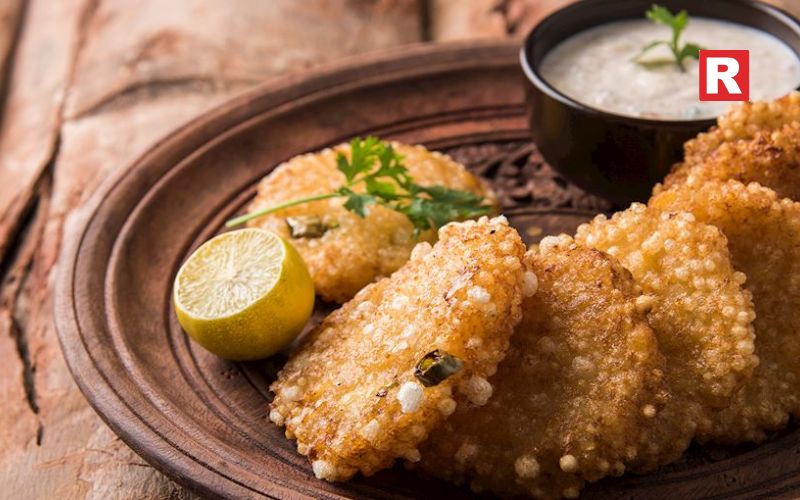
Traditionally prepared during fasting days, Sabudana Vada slowly made its way to temple fairs and office corners in the 1970s. The mix of tapioca pearls, mashed potatoes, and peanuts is deep-fried till golden, giving it that crunchy outside and soft, nutty centre. Light yet satisfying, it’s one of Mumbai’s most beloved vegetarian bites.
You’ll find the best ones at Prakash Shakahari Upahaar Kendra in Dadar and Mama Kane’s Swatchha Upahar Gruha near Dadar Station, both serving authentic Maharashtrian flavours for decades.
6. Ragda Pattice
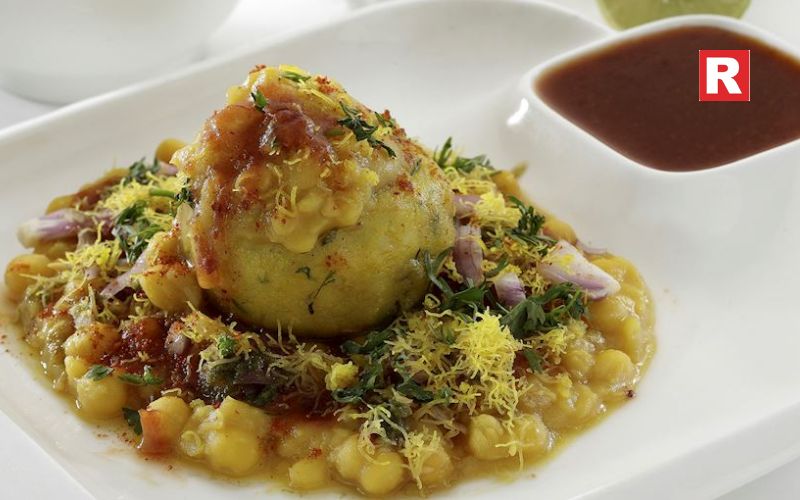
A happy marriage between North Indian aloo tikki and Mumbai’s ragda (white pea curry), Ragda Pattice reflects the city’s flair for fusion. Vendors top potato patties with spicy ragda, tangy tamarind chutney, and crunchy sev. Found in every Khau Galli from Ghatkopar to Crawford Market, it’s sweet, spicy, and completely addictive.
For a true Mumbai-style Ragda Pattice, try Elco Pani Puri Centre in Bandra or the buzzing Princess Street chaat corners that have fed generations of snack-seekers.
7. Dahi Puri
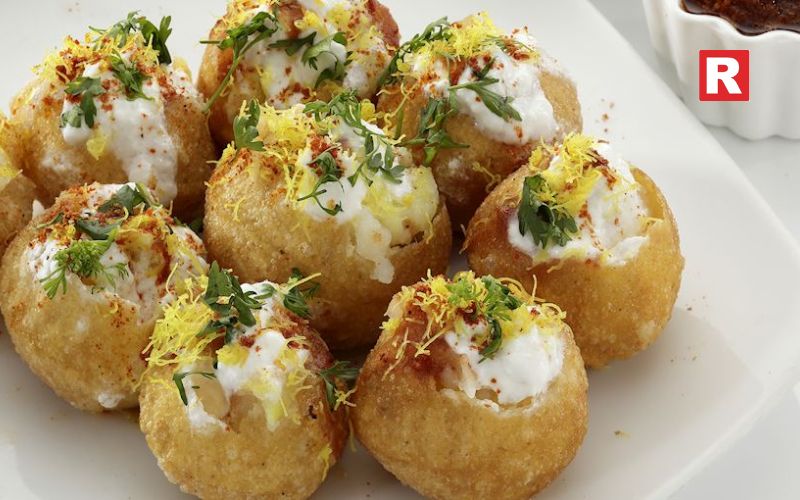
Evolving from the larger pani puri, Dahi Puri became a favourite in the 1970s when vendors at Bandra’s Elco Arcade discovered that adding curd and chutneys made a creamy, balanced snack for humid weather. Each puri bursts with flavour — a mix of spice, sweetness, and tang that sums up Mumbai’s chaos and charm in a single bite.
The city’s most famous Dahi Puri still comes from Elco Pani Puri Centre, with long queues every evening, or the smaller stalls near Ghatkopar Khau Galli for a local twist.
8. Bhelpuri
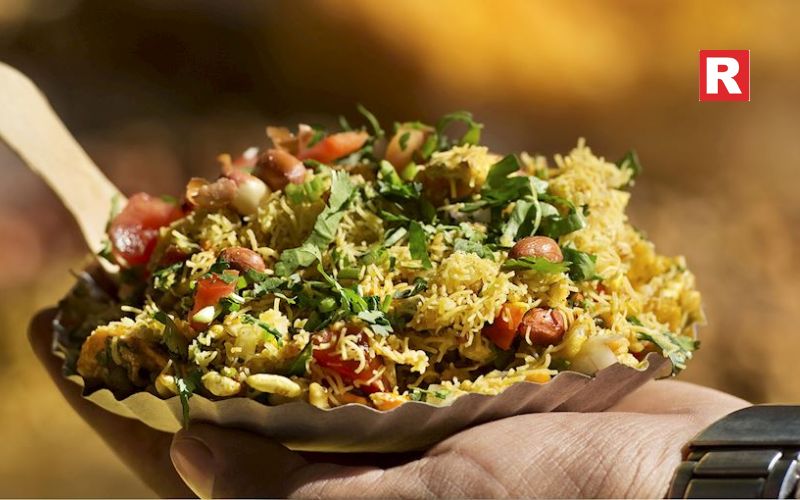
Bhelpuri was born on Juhu Beach in the 1940s when Gujarati traders mixed puffed rice with chutneys for a quick seaside bite. Light, crunchy, and refreshing, it became synonymous with Mumbai evenings by the sea. Every vendor has a secret chutney ratio, but the thrill lies in watching it tossed live against the sound of crashing waves.
Grab your cone of bhel from Sharmajee’s and Badshah’s Bhelpuri stalls at Juhu Beach, or try the Chowpatty vendors who’ve turned this snack into an emotion.
9. Bombay Sandwich
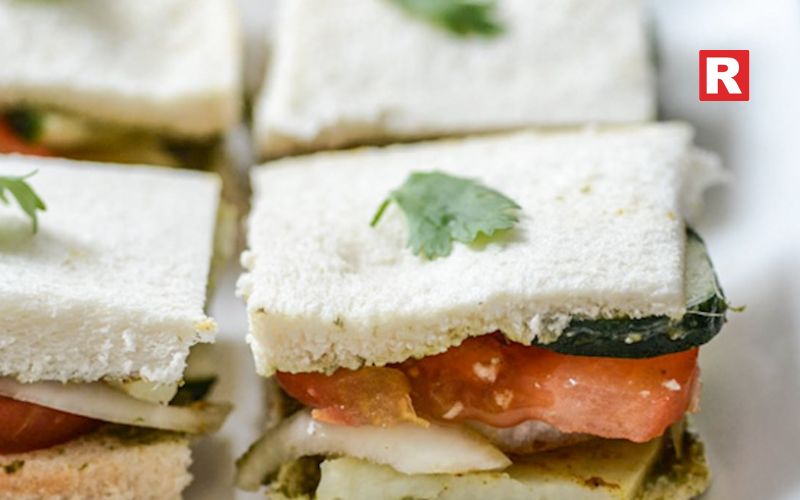
The Bombay Sandwich started in the 1960s near Grant Road Station, where a vendor began layering vegetables and chutney between slices of white bread for hungry commuters. Over time, it evolved into a must-try Mumbai classic — stacked with potato, beetroot, cucumber, tomato, and mint chutney, then grilled till crisp. It’s quick, hearty, and made for the city that never slows down.
The go-to places: Sandwizzaa in Churchgate, Raju Sandwich near HR College, and Sukh Sagar at Chowpatty, where this layered treat is toasted to perfection.
10. Prawn Koliwada
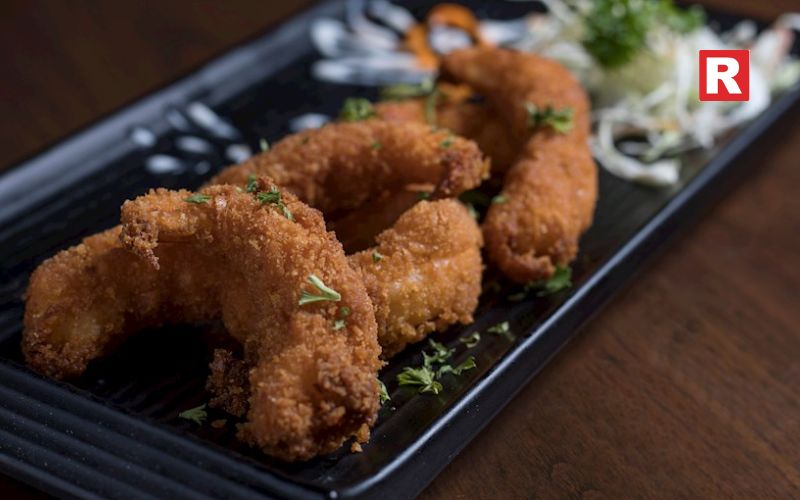
Created by the Koli fishing community in Sion-Koliwada during the 1950s, Prawn Koliwada came from the need to preserve seafood longer. Marinating prawns in a fiery red masala before frying kept them fresh and flavourful. Today, it’s one of Mumbai’s most famous seafood snacks — crisp, spicy, and best enjoyed with a squeeze of lime or a sip of solkadhi.
For the most authentic taste, visit Gomantak Boarding House in Dadar, Gajalee in Vile Parle, or the old Sion Koliwada eateries that still serve this dish the way the Kolis intended.
Mumbai’s Food Scene: A Living Story
Every dish tells the story of a city built on dreams, diversity, and drive. From the mill workers of the past to the midnight foodies of today, Mumbai’s street food continues to bind its people. It’s not fine dining — it’s heart dining. And in every pav, puri, and patty, you can still taste the spirit of Mumbai.

The Mughal emperors were known for their love for food. Their kitchens were filled with the aroma of saffron, rose water, and roasted spices. The food they enjoyed blended Persian, Turkish, and Indian influences, resulting in what we now call Mughlai cuisine. Every dish was made to please the senses — rich, aromatic, and beautifully plated. Today, Mughal dishes are a popular choice for weddings because they represent abundance and tradition. From creamy gravies to fragrant rice and soft breads, each dish tells a story of the empire that changed the way India eats.
Weddings in India are not just about rituals—they are about grandeur, celebration, and feasting. When it comes to creating a wedding menu that speaks of luxury and culture, Mughal cuisine tops the list. With its rich flavors, royal ingredients, and centuries-old heritage, Mughal food brings a regal touch to every plate. If your wedding feast deserves a royal makeover, these timeless dishes are just what you need.
Read more: 10 Awadhi Cuisine Classics You Must Try at Least Once
8 Famous Vegetarian Dishes of Uttar Pradesh and Their Timeless Legacy
The Essence of Mughal Cuisine
Mughal cuisine is known for its slow-cooked preparations, layered flavors, and luxurious ingredients like saffron, nuts, and dried fruits. The dishes are often rich in ghee and spices but balanced with yogurt and herbs for smoothness. Gold or silver leaf was sometimes used to decorate the food, showing wealth and hospitality.
These dishes are not just meals—they are experiences. They bring people together, spark conversations, and make celebrations truly memorable. That’s what makes Mughal food perfect for weddings.
10 Mughal Cuisine Dishes Perfect for Wedding Menus
1. Murgh Musallam – The Crown of Royal Feasts

Murgh Musallam stands as one of the grandest dishes from the Mughal period. It features a whole chicken marinated in yogurt, saffron, and a mix of rich spices. The chicken is stuffed with boiled eggs, slow-cooked to perfection, and then garnished with golden almonds and sweet raisins. The dish’s aroma and presentation make it a centerpiece for any royal feast. It is believed that Emperor Muhammad Bin Tughlaq enjoyed Murgh Musallam long before it became a Mughal favorite. Later, it became a staple in royal kitchens, served at lavish banquets to showcase wealth and generosity. The name “Musallam” means “whole,” symbolizing wholeness and celebration. Its golden hue, creamy gravy, and tender texture make it a perfect addition to wedding menus, representing abundance, prosperity, and the grandeur of royal hospitality that still charms every guest.
- Why it’s perfect for weddings: It looks grand on the table and symbolizes abundance and prosperity.
- Fun fact: The dish was a favorite of Emperor Muhammad Bin Tughlaq before it became popular in Mughal royal kitchens.
2. Nihari – Slow-Cooked Perfection
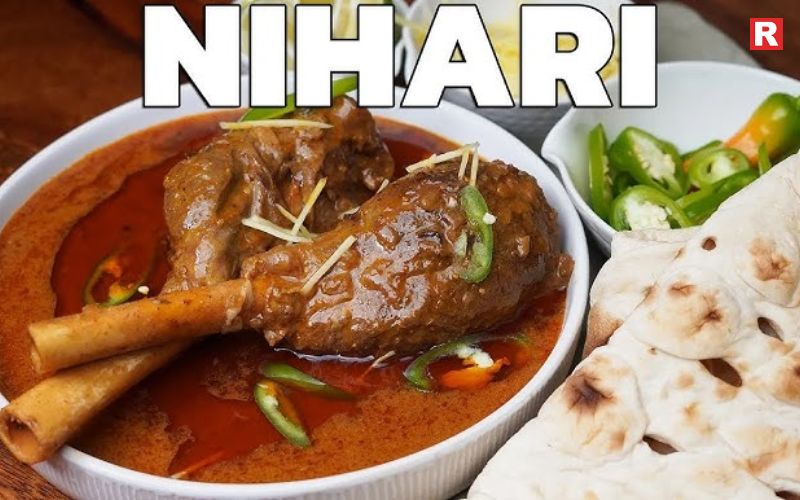
Nihari is a slow-cooked stew that traces its roots to the royal kitchens of Old Delhi and Lucknow. Traditionally prepared overnight, it features tender pieces of mutton or beef simmered with bone marrow and a rich blend of spices. The dish cooks for hours until the gravy turns silky and aromatic. It was first served to Mughal nobles after morning prayers, providing warmth and energy. The name “Nihari” comes from the Arabic word Nahar, meaning “morning.” Over time, it became a comfort dish across North India and Pakistan. Its depth of flavor comes from slow cooking and carefully balanced spices like cardamom, cinnamon, and nutmeg. Today, Nihari holds a place of honor on wedding menus, especially in winter. It reflects luxury, patience, and royal culinary artistry, offering guests a taste of history and a sense of pure indulgence.
Why it’s perfect for weddings: It offers comforting warmth and luxurious flavor, ideal for winter weddings.
Know more: Top Must-Try Bengali Cuisine Dishes: A Feast for the Soul
3. Biryani – The Jewel of Every Feast
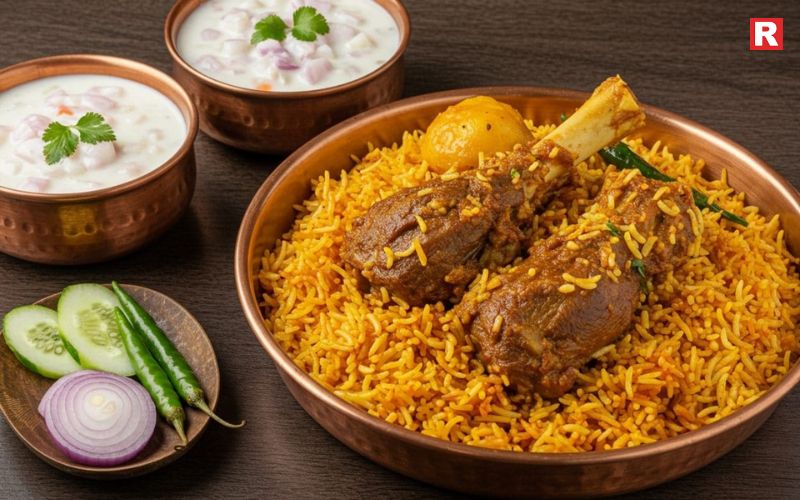
No wedding is complete without biryani. Whether it’s Lucknowi (Awadhi) or Hyderabadi, biryani represents the soul of Mughal cuisine. Fragrant basmati rice is layered with spiced meat, saffron, and fried onions, then slow-cooked under dum (steam). It combines long-grain basmati rice with marinated meat, saffron, fried onions, and fragrant spices. The dish is layered and sealed, then cooked slowly using the dum method, allowing the flavors to blend beautifully. Originating in the royal kitchens of Persia, biryani traveled to India with the Mughals and evolved into several regional varieties like Lucknowi and Hyderabadi. It was often served at royal banquets and festive occasions as a symbol of grandeur. Each spoonful offers a perfect balance of aroma, texture, and flavor. The word “biryani” comes from the Persian term birian, meaning “fried before cooking.” Even today, no Indian wedding is complete without this dish. Its rich flavor, golden color, and regal appeal make it the true jewel of every wedding feast.
- Why it’s perfect for weddings: It’s flavorful, filling, and universally loved.
- Fun fact: The word biryani comes from the Persian word birian, meaning “fried before cooking.”
4. Shahi Paneer – Royal Treat for Vegetarians
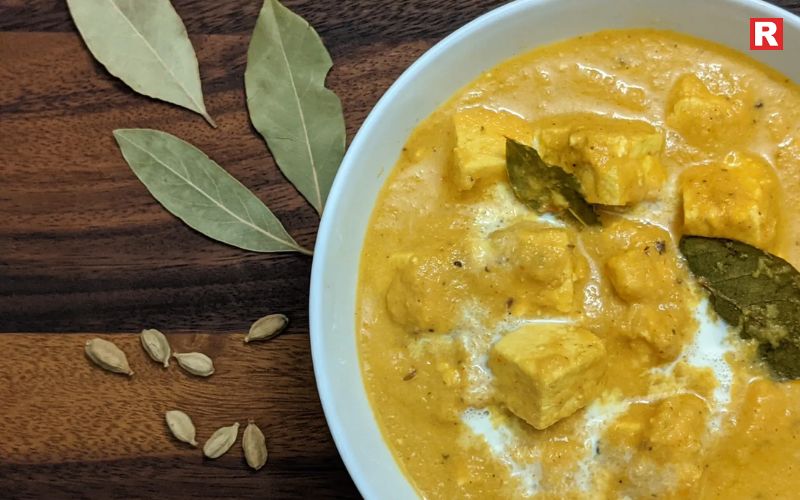
Shahi Paneer, which translates to “royal cottage cheese,” is a dish born in the Mughal courts. It was created as a luxurious vegetarian option for royal banquets. The dish features soft cubes of paneer cooked in a creamy sauce made with cashews, saffron, cardamom, and milk. The result is a mildly sweet and fragrant curry that pairs beautifully with naan or pulao. The word “Shahi” means “royal,” reflecting its origin in the kitchens of kings. This dish was favored for its elegance, smooth texture, and balance of spice and richness. Shahi Paneer became popular among nobles who followed vegetarian diets but desired royal flavors. Its golden color and delicate aroma still capture attention at weddings today. Served in silver bowls and topped with saffron strands, it adds both color and class to every celebration.
Why it’s perfect for weddings: It adds richness and balance to the menu while pleasing vegetarian guests.
5. Galouti Kebab – The Melt-in-Mouth Legend
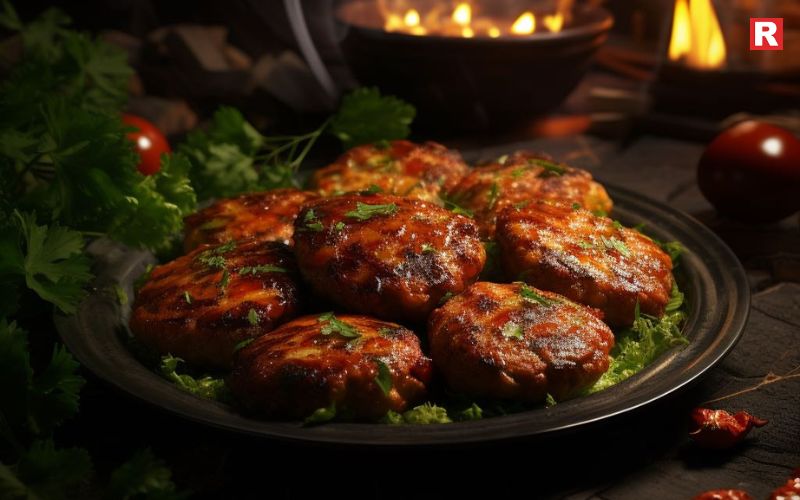
The story of the Galouti Kebab goes back to the Nawabs of Lucknow. Legend says it was created for a toothless Nawab who still wanted to enjoy kebabs. Made with finely minced meat, papaya paste, and a blend of 100 spices, the kebabs melt in the mouth instantly. The story behind it is fascinating. It was created for a Nawab of Lucknow who lost his teeth but still wanted to enjoy kebabs. The kebabs are pan-fried on a griddle until soft, fragrant, and golden brown. “Galouti” means “soft,” perfectly describing its texture. The dish represents the skill and creativity of Mughal cooks, who could turn a simple desire into a culinary legend. Today, Galouti Kebabs are a popular starter at weddings, often served on mini parathas or skewers. Their aroma, softness, and flavor make them an unforgettable royal experience for every guest.
Why it’s perfect for weddings: It’s bite-sized, flavorful, and elegant—perfect for starters or cocktail evenings.
6. Mutton Korma – The Royal Gravy
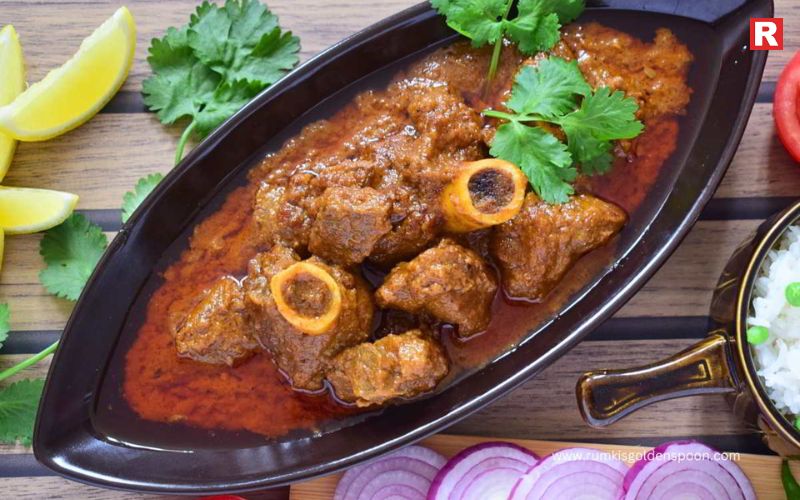
Mutton Korma is a classic Mughal dish that showcases the richness of royal cooking. It features tender pieces of mutton slow-cooked in a silky gravy made from yogurt, ground nuts, and aromatic spices. The dish is known for its deep golden color and balanced flavors of spice, sweetness, and creaminess. Korma originated in the royal kitchens of the Mughal emperors, where slow braising, known as qormah, was used to retain flavor and tenderness. It was often served at grand banquets and celebrations. The fragrance of cardamom, cloves, and ghee fills the air as it simmers. Mutton Korma pairs perfectly with naan, sheermal, or rice, making it a centerpiece for royal feasts. Its rich taste and velvety texture reflect the grandeur of the Mughal era, making it an ideal choice for wedding menus even today.
- Why it’s perfect for weddings: It’s rich, flavorful, and pairs beautifully with naan or sheermal.
- Fun fact: “Korma” comes from the Urdu word “qormah,” meaning “to braise.”
7. Rogan Josh – Fragrant and Fiery
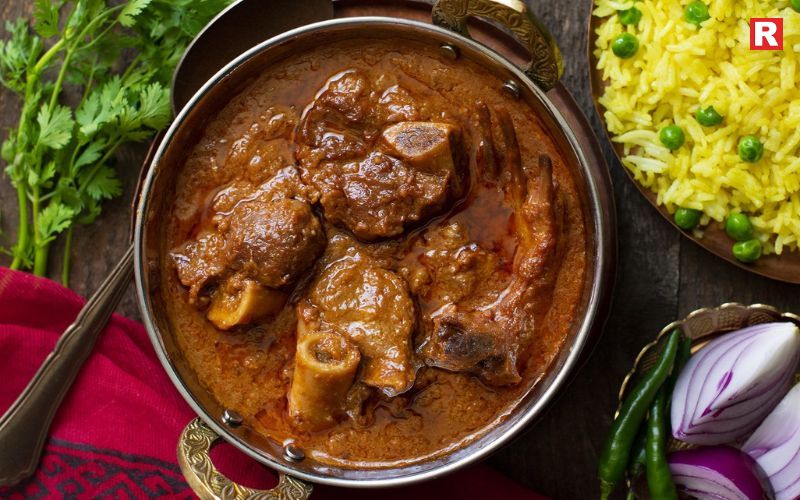
Rogan Josh is a dish that beautifully combines Kashmiri tradition with Mughal influence. It is made from tender lamb pieces simmered in a vibrant red curry prepared with Kashmiri chilies, yogurt, and aromatic spices. Despite its deep red hue, the dish is not overly spicy but rich and flavorful. The word “Rogan” means “oil,” and “Josh” means “heat” or “passion,” describing its bold appearance and taste. This dish traveled from Persia to India through Mughal conquests and later became a signature part of Kashmiri cuisine. Its deep color and aroma come from slow cooking, which allows every spice to blend perfectly. In Mughal times, it was served during royal feasts as a sign of luxury and warmth. Today, Rogan Josh adds a touch of color and depth to wedding menus, delighting spice lovers everywhere.
Why it’s perfect for weddings: It adds depth and color to the menu while pleasing spice lovers.
Also check: 5 Tasty Dishes from Bihar You Must Try
8. Sheermal and Naan-e-Khatai – The Royal Breads

Sheermal and Naan-e-Khatai are two classic Mughal breads that reflect the sophistication of royal dining. Sheermal is a mildly sweet saffron-flavored bread brushed with ghee, made with milk and flour, and baked until golden. It originated in the royal kitchens of Lucknow and Hyderabad and was often served with rich gravies like korma or nihari. Naan-e-Khatai, on the other hand, is a soft, crumbly bread or biscuit with Persian roots. It was introduced to India by Mughal bakers and became a popular treat in royal households. The word “Khatai” means “biscuit,” and it melts beautifully in the mouth. Together, these breads balance sweetness and texture, complementing both savory and sweet dishes. At weddings, they add authenticity, elegance, and warmth to the dining experience, completing the royal spread just as they did centuries ago.
Why it’s perfect for weddings: They add variety and authenticity to the meal, blending sweetness and warmth.
9. Zarda – Sweet Saffron Rice
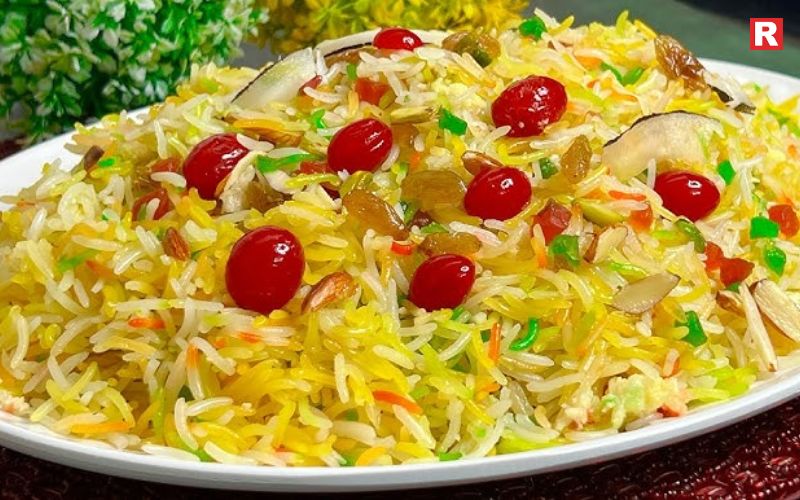
Zarda is a traditional Mughal dessert that brings a burst of color and sweetness to every feast. Made with fragrant basmati rice, saffron, sugar, and ghee, it is cooked until golden and then garnished with almonds, pistachios, and dried fruits. The dish gets its name from the Persian word zard, meaning “yellow.” It was a favorite among Mughal royals, often served during celebrations and weddings. The use of saffron and rose water gives Zarda its distinctive aroma and luxurious feel. In royal times, it symbolized wealth, happiness, and good fortune. The bright yellow color represents joy, making it perfect for festive occasions. Even today, Zarda remains a staple at grand weddings, where its sweet flavor and glistening appearance bring the perfect balance to the rich and spicy dishes that precede it.
Why it’s perfect for weddings: It symbolizes happiness, prosperity, and the golden moments of life.
10. Shahi Tukda – A Grand Sweet Ending

Shahi Tukda is a royal dessert that captures the essence of Mughal indulgence. Made with fried pieces of bread soaked in sugar syrup and topped with thick, creamy rabri, it offers a perfect blend of sweetness and texture. The dessert is garnished with saffron, rose petals, and chopped nuts, making it a visual and sensory delight. It is believed to have originated in the royal kitchens of Hyderabad, where chefs created it to use leftover bread in the most luxurious way possible. The term “Shahi” means “royal,” while “Tukda” means “piece,” truly fitting its character. Served chilled or warm, it melts in the mouth with every bite. At weddings, Shahi Tukda serves as a grand finale — a dish that leaves guests enchanted with its richness, creaminess, and timeless royal charm.
- Why it’s perfect for weddings: It ends the meal on a royal note and leaves guests craving for more.
- Fun fact: The dish is believed to have originated in Hyderabad’s royal kitchens.
Why Mughal Dishes Belong on Every Wedding Menu
Mughal dishes represent the idea of celebration, love, and togetherness. Their rich gravies, delicate spices, and luxurious textures make them a favorite at Indian weddings. They suit all kinds of themes—be it traditional, royal, or modern fusion.
These dishes are not just delicious; they also reflect heritage and craftsmanship. Every bite tells a story of emperors, royal chefs, and centuries-old traditions. Including Mughal food in your wedding menu adds authenticity and warmth that guests will remember long after the event.
Check more: 10 Famous Dishes from Nepal You Must Try
5 Cities That Serve the Best Non-Vegetarian Street Food
Top 7 Regional Indian Thali Platters That Showcase Culinary Diversity
Tips for Including Mughal Cuisine in Weddings
- Mix it up: Include both vegetarian and non-vegetarian dishes for balance.
- Hire skilled chefs: Look for caterers experienced in Mughlai cooking techniques like dum (steam) and tandoor.
- Focus on presentation: Use traditional brassware or silver platters to enhance the royal feel.
- Add live counters: Kebabs or biryani served hot from a live counter bring a lively experience.
- Use royal garnishes: Top dishes with saffron strands, rose petals, almonds, and silver leaf for authenticity.
Taste the Royalty!
From the grandeur of Murgh Musallam to the sweetness of Shahi Tukda, every Mughal dish brings history and flavor to life. These recipes have stood the test of time, transforming from royal feasts to modern celebrations.
If you want your wedding menu to be memorable, let it reflect royalty, warmth, and culture. After all, nothing says celebration quite like a Mughal feast—where every dish tells a story of legacy, love, and luxury.

When one thinks of Indian cuisine, they tend to think of rich curries and aromatic biryanis. But if you visit the hilly landscape of Northeast India, you'll find an entirely different culinary world in Nagaland. It's not just food. It is an experience that integrates you with the land and the tribal culture.
Naga cuisine tastes unpretentious and earthy. There are no heavy creams or elaborate spice combinations here. Instead, the sorcery derives from smoking, fermenting, and doing as much as possible with what the forest gives you. Imagine wood-smoked meats that have dried for days, fermented soybeans with a punchy umami kick, and chilies so fiery they'll make your eyes water (in the best possible sense).
Read more: Best Dishes in North East Indian Cuisine
What Makes Naga Cuisine So Unique
Naga food is simple in preparation but incredibly rich in flavor. Unlike most Indian dishes, it uses very little oil and no complex spice mixes. The magic lies in smoking, fermenting, and boiling, which give Naga dishes their signature character.
Common ingredients include:
- Bamboo shoot – tangy and aromatic, used fresh or fermented.
- Axone (fermented soybean) – adds deep umami flavor to many curries.
- Smoked meat – pork, beef, or fish dried over wood fires for days.
- King chili (Raja Mircha or Bhut Jolokia) – among the hottest chilies in the world.
- Wild greens and herbs – locally foraged for freshness and health benefits.
These are the elements that together make Naga cuisine one of the most authentic and adventurous food traditions in India.
1. Smoked Pork with Bamboo Shoot – The Heart of Naga Cuisine

Smoked pork with bamboo shoots is a dish that best represents Nagaland. To give the pork a rich, rustic scent, it is first smoked over a wood fire for a few days. Then, using bamboo shoots, it is simmered to achieve the ideal balance of tang and smokiness. Each tribe has its own version of this recipe; some add dried chilies or axone, while others make it spicier. This dish, regardless of the different preparation method, embraces the essence of Naga cooking, which is flavorful, slow, and natural.
Where to try it: At the food stalls during the Hornbill Festival or in traditional homes in Kohima.
2. Axone Curry – A Fermented Delight

Axone (“akhuni”) is fermented soybean, which is strong, acidic, and purely unique.
The outsiders can find the aroma to be a little intense. But for locals, this aroma is a sign of comfort. Often cooked with pork, beef, or vegetables, it gives a flavor that is similar to miso or fermented soybean. The fermentation process not only enhances the taste but also boosts nutrition and gut health. This dish is the perfect example of how Nagaland embraces fermentation to preserve food and flavor in its cool, mountainous climate.
Pro tip: Pair it with plain rice or sticky rice to balance the flavor intensity.
Know more: A Close Look at Goa's Diverse Cuisine
3. Galho – Nagaland’s Soul-Soothing Comfort Food
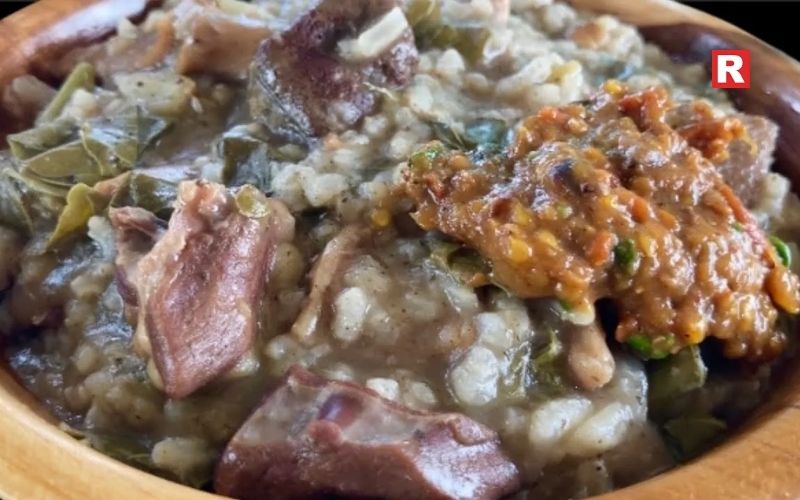
Think of Galho as Nagaland’s version of khichdi. It is a simple one-pot meal of rice, vegetables, and sometimes meat. But don't let its simplicity deceive you, it's filling, healthy, and incredibly satisfying.
The best versions add flavor with axone or smoked pork. Galho is a real comfort food that is often eaten on chilly evenings or after exhausting workdays.
Why it’s special: Galho highlights the Naga philosophy, which focuses on utilizing a few ingredients, maximizing flavor, and having a great regard for regional produce.
4. Hinkejvu – A Taste of Everyday Nagaland
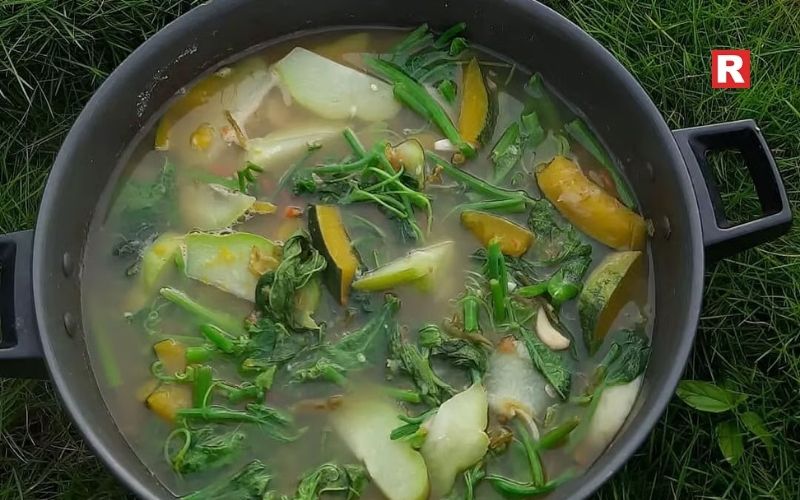
Naga cuisine is known for its meat dishes, but it also has softer, more vegetarian options. One such dish is Hinkejvu. It is made with beans, mustard leaves, colocasia, and occasionally garlic or ginger.
It’s often served as a side dish, but its subtle, clean taste makes it essential to a balanced Naga meal. It reflects the community’s closeness to nature and preference for unprocessed, natural foods.
Best for: Health-conscious travelers or anyone new to Naga cuisine.
5. Naga-Style Fish with Bamboo Shoot
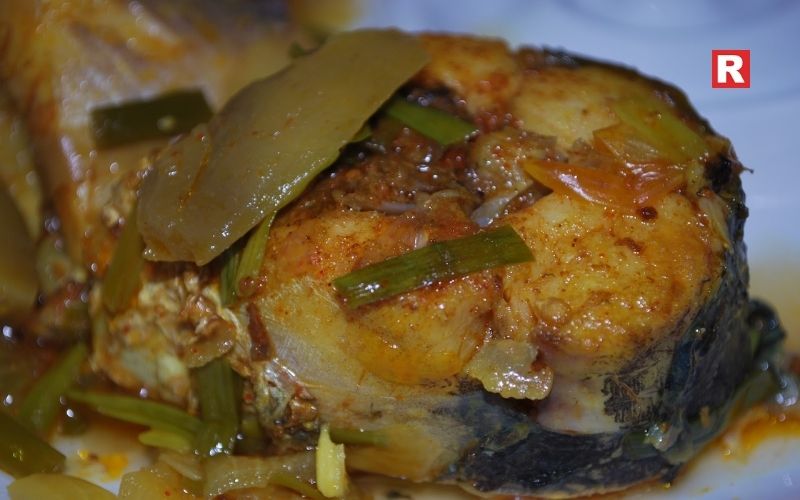
Fresh river fish is another Naga favorite, usually cooked with bamboo shoots for tang and aroma. The fish is either steamed or boiled, keeping the flavors clean and delicate.
The dish strikes a perfect harmony: the light sweetness of fish with the sharp bite of bamboo. It’s often enjoyed with sticky rice and chili chutney for an authentic experience.
Must-try in: Mokokchung or villages near rivers where the fish is freshly caught.
6. Snail Curry – A True Tribal Delicacy
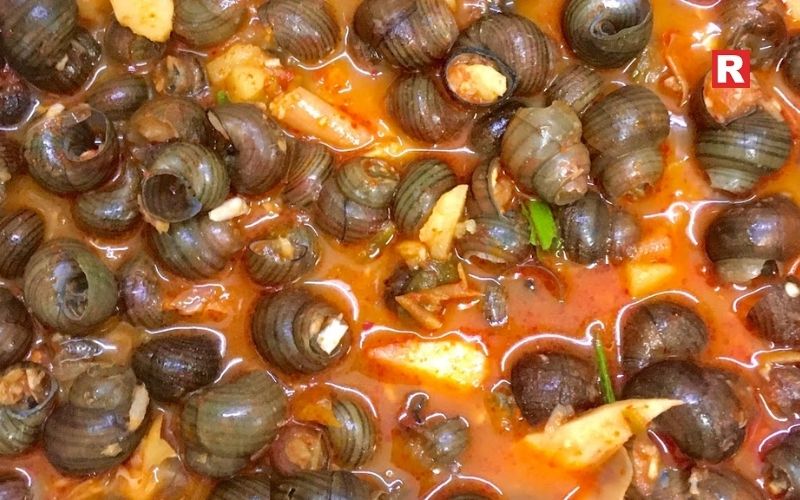
Yes, snails! In Nagaland, snails are considered a delicacy and are often cooked with axone or local herbs. The chewy texture and rich, earthy flavor make it a dish for adventurous eaters.
It’s usually prepared during festivals or gatherings, showing how Naga cuisine makes creative use of everything nature provides.
Tip: Try it at traditional tribal kitchens during the Hornbill Festival. It’s an experience you won’t forget.
7. Smoked Beef with Fermented Bamboo
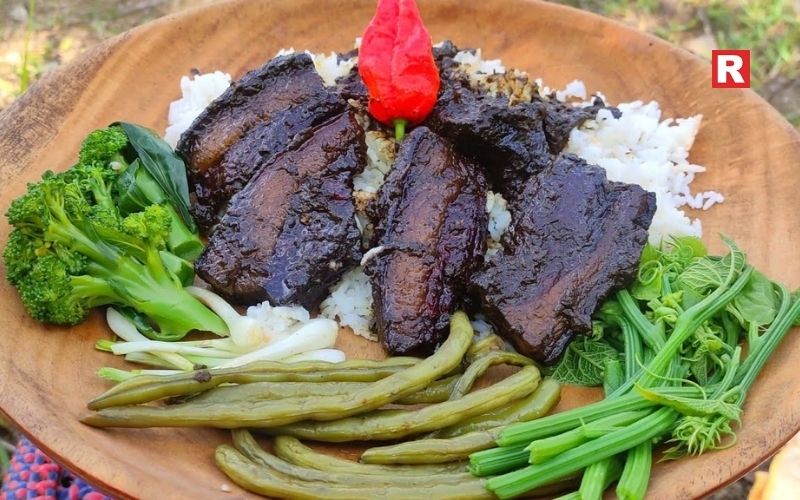
For lovers of bold flavors, smoked beef cooked with fermented bamboo is a dream. The beef is slow-smoked for days until it’s perfectly preserved, then boiled with fermented bamboo shoots to create a tangy, umami-rich stew.
It’s intensely flavorful and pairs beautifully with sticky rice or steamed vegetables.
Flavor note: Smoky, earthy, and slightly sour. It is a true explosion of taste that defines Nagaland.
What's new: 10 Dishes You Should Definitely Try When You Visit Pondicherry
8. Dried River Fish Chutney – Small but Mighty
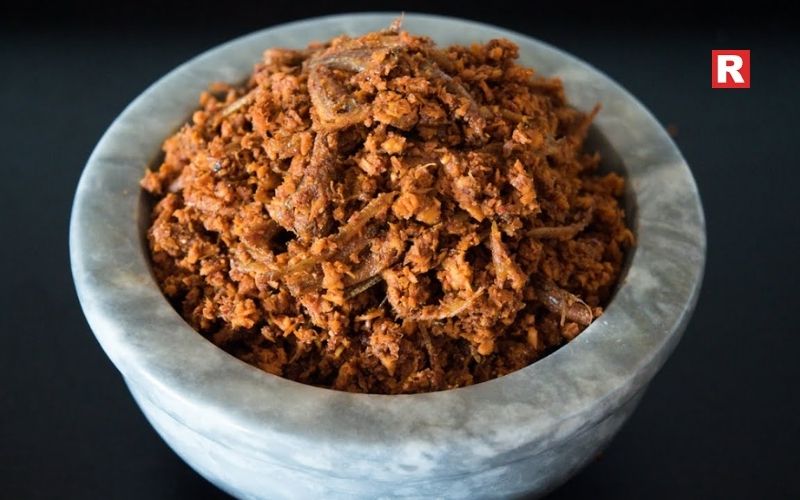
One of Nagaland’s simplest yet most powerful dishes is dried river fish chutney. Dried fish is ground with chilies, ginger, and fermented bamboo or tomato to create a spicy, umami-packed paste.
It’s eaten as a side dish or condiment, and just a spoonful can elevate an entire meal. The chutney’s deep aroma is a perfect match for rice-based meals.
Best enjoyed with: Galho or plain sticky rice.
9. Raja Mircha Chutney – The Fiery King of Chilies
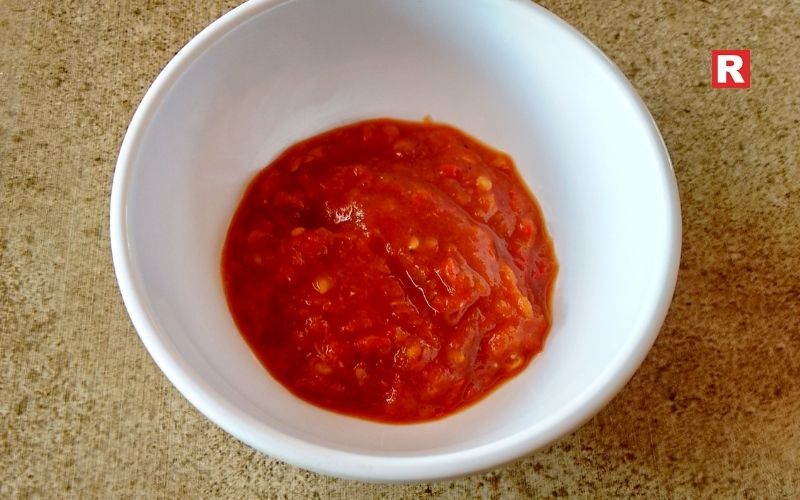
Nagaland is home to one of the world’s hottest chilies: Raja Mircha (Bhut Jolokia). And locals turn it into a simple yet explosive chutney made with garlic, salt, and tomatoes.
Just a tiny dab adds instant heat and flavor to any dish. It’s not for the faint-hearted, but it’s a must-try if you want to experience the real fire of Naga cuisine.
Warning: Handle with care: this chili can be over 200 times hotter than jalapeños!
10. Sticky Rice and Zutho – The Traditional Pairing

No Naga meal is complete without sticky rice, often paired with Zutho, a local fermented rice beer. Sticky rice is slightly sweet and chewy, making it the perfect companion to smoky meats and spicy curries.
Zutho, on the other hand, has a mild tang and smooth texture, which is enjoyed during festivals and family gatherings. Together, they embody Nagaland’s warm, communal food culture.
Check out: 10 Iconic Dishes from Kashmir That Will Give You a Flavor of Paradise
Top Must-Try Bengali Cuisine Dishes: A Feast for the Soul
The Art of Fermentation and Smoke in Naga Cooking
Two techniques define Naga cuisine: fermentation and smoking.
- Fermentation enhances flavor, preserves food naturally, and improves digestion.
- Smoking gives meat its distinct taste and allows it to last for months in the humid hills.
These methods reflect both necessity and creativity, a way to make the most of available resources while crafting unforgettable flavors.
Where to Experience Authentic Naga Food
If you want to taste real Naga flavors, skip commercial restaurants and eat where locals do:
- Kohima – Try traditional homestays or cafes serving local thalis.
- Dimapur – Explore street stalls for pork and chili chutneys.
- Hornbill Festival (December) – The ultimate showcase of Naga food, with stalls from all 16 tribes offering authentic dishes.
- Many homestays also offer cooking sessions where you can learn to make these dishes the traditional way.
Tips for First-Time Eaters
- Expect smoky, earthy, and strong flavors. They’re part of the charm.
- Most dishes are naturally gluten-free and protein-rich.
- Balance fiery chutneys with mild rice dishes like Galho.
- If you’re sensitive to spice, ask for dishes made without Raja Mircha.
- Always eat with locals if you can. They’ll guide you to the most authentic experiences.
Learn more: 10 Famous Dishes from Nepal You Must Try
Conclusion: Savoring the True Essence of Nagaland
For first-time travelers, try having an open mind. The seasonings can be more potent and smokier than you are accustomed to, and the spices can be intense. But that's the fun. Counterbalance spicy meals with plain rice, and don't hesitate to dine with locals. As they can lead you to the best authentic experiences.
At its core, Naga cuisine tells a story of its people: tough, innovative, and passionately attached to their soil. From the initial bite of smoked pork to the final gulp of Zutho, you are not merely eating, you're living a life that has been wonderfully faithful to its origins.

Potatoes are one of the most loved and versatile foods in the world. From being mashed, baked, or fried, this simple vegetable fits perfectly into every cuisine. It has travelled from South America to every corner of the globe, finding a place in both everyday meals and festive spreads. In India, potatoes turn into spicy chaats and crispy samosas. In France, they become creamy gratins. Belgium celebrates them as golden fries, while Peru enjoys them in colourful traditional dishes. Each country adds its own touch, proving that potatoes can be comforting, elegant, and creative at the same time.
What makes potatoes special is their ability to adapt. They absorb flavours beautifully, pair with almost anything, and turn even the simplest meal into something satisfying. Whether served in a fine restaurant or a small home kitchen, they always bring warmth and joy to the table. This list of the world’s 31 tastiest potato recipes celebrates that spirit—simple, hearty, and full of flavor — showing how one humble ingredient connects so many cultures through taste.
Read more: World’s Tastiest Wraps: A Global Tour of Flavours
8 Famous Vegetarian Dishes of Uttar Pradesh and Their Timeless Legacy
The Global Love for Potatoes
The story of the potato begins in South America, where it was first cultivated by the Inca people nearly 7,000 years ago. Over time, it spread through Europe, Asia, and Africa, becoming a staple in countless cuisines. Today, more than 4,000 varieties exist, and potatoes are grown in nearly every country on Earth.
Interestingly, potatoes were also the first vegetable grown in space by NASA — proving they’re truly out of this world.
Asia’s Potato Delights
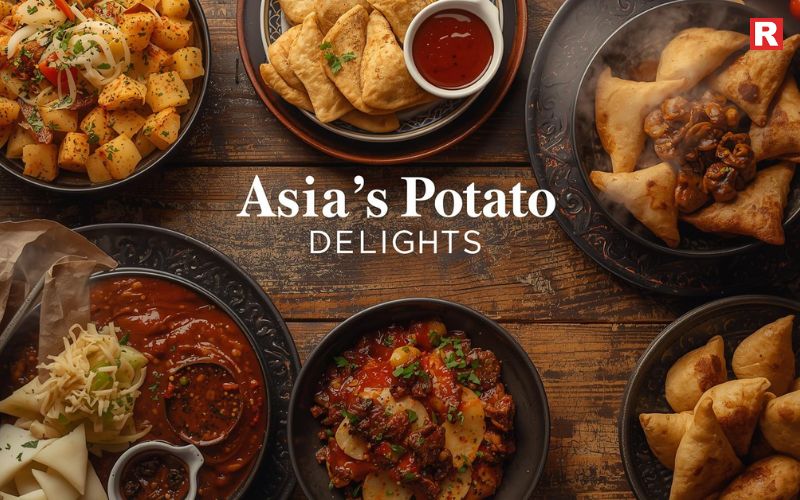
1. Aloo Chaat (India): A spicy, tangy, and crunchy street food made with fried potato cubes, chutneys, and spices. You’ll find it in almost every corner of Delhi and Mumbai. It’s a quick snack that perfectly captures India’s love for flavor.
2. Gamja Jeon (South Korea): These are Korean-style potato pancakes — crispy outside and soft inside. Served with soy dipping sauce, they make a simple yet satisfying side dish.
3. Nikujaga (Japan): A comforting Japanese stew made from sliced beef, potatoes, onions, and soy sauce. It’s sweet, savory, and perfect for a cozy dinner.
4. Batata Harra (Lebanon): Meaning “spicy potatoes,” this Lebanese dish mixes fried potatoes with garlic, coriander, chili, and lemon juice. It’s full of zest and flavor.
5. Samosa (India): A deep-fried pastry filled with spiced potatoes, peas, and herbs. Crispy, golden, and bursting with warmth, samosas are India’s favorite snack.
Europe’s Comforting Classics

6. Patatas Bravas (Spain): Crispy potatoes topped with a spicy tomato sauce — a popular Spanish tapas dish that pairs beautifully with a glass of wine.
7. Pommes Frites (Belgium): Belgium’s pride — double-fried golden fries that are extra crisp and often served with mayonnaise. Many believe true French fries actually come from Belgium.
8. Shepherd’s Pie (UK): A classic British comfort dish made with minced meat and vegetables topped with mashed potatoes, baked until golden.
9. Kartoffelsalat (Germany): A creamy German potato salad, often served with sausages or schnitzel. Some versions use vinegar and bacon for extra flavor.
10. Gratin Dauphinois (France): Thinly sliced potatoes baked slowly with cream, milk, and garlic. The result is rich, creamy, and irresistibly delicious.
11. Pierogi (Poland): Soft dumplings stuffed with mashed potatoes, cheese, or onions. Served with butter or sour cream, they’re a Polish comfort food classic.
12. Colcannon (Ireland): Mashed potatoes blended with cabbage or kale, butter, and cream. This Irish favorite is often eaten during the colder months.
13. Rösti (Switzerland): A Swiss-style potato cake made from grated potatoes, pan-fried until crisp. Often eaten for breakfast or as a side dish.
14. Tortilla Española (Spain): Spain’s beloved potato omelette made with eggs, onions, and potatoes. It’s hearty, simple, and delicious hot or cold.
Know more: 5 Cities That Serve the Best Non-Vegetarian Street Food
North America’s Potato Favorites
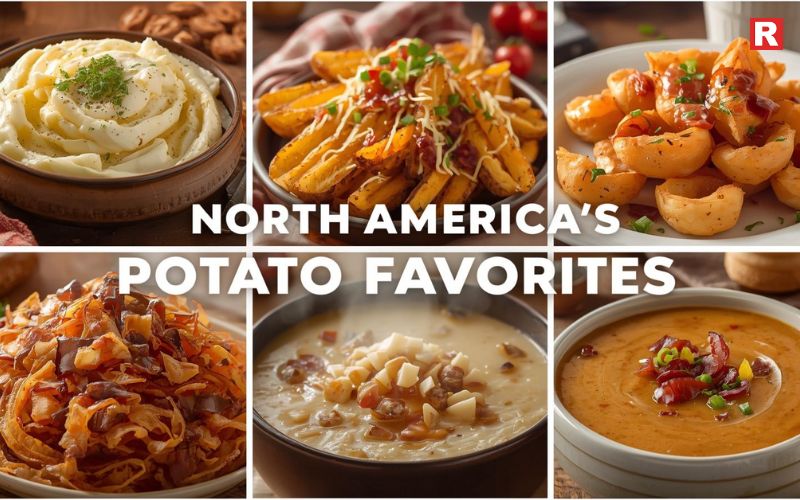
15. Mashed Potatoes (USA): A classic American side dish for Thanksgiving and family dinners. Made with butter, cream, and salt, it’s smooth and comforting.
16. Loaded Potato Skins (USA): Crispy baked potato skins filled with cheese, bacon, and sour cream. A hit at parties and game nights.
17. Poutine (Canada): Canada’s most famous dish — crispy fries covered in cheese curds and hot gravy. A true comfort food indulgence.
18. Hash Browns (USA): A breakfast staple — grated potatoes fried until golden brown. Perfect with eggs and toast.
19. Potato Soup (USA): Creamy potato soup cooked with leeks, onions, and bacon. It’s hearty and perfect for chilly evenings.
South America’s Potato Heritage
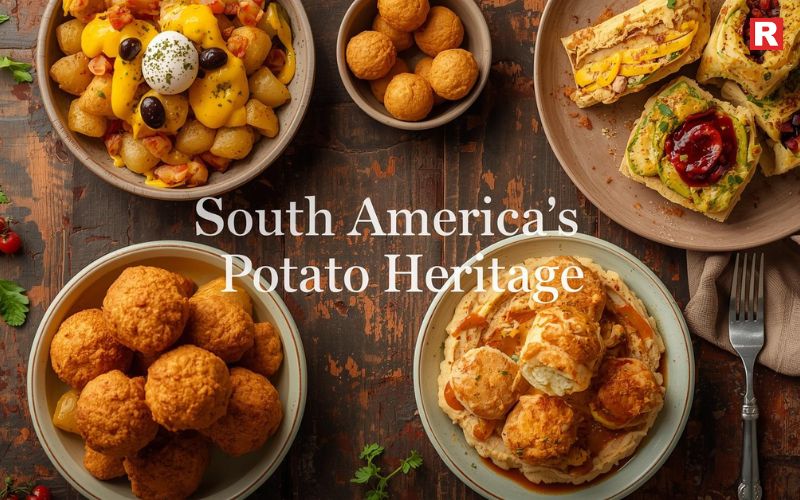
20. Papas a la Huancaína (Peru): Boiled potatoes topped with a spicy cheese sauce made from yellow chilies. It’s served cold and beautifully bright in color.
21. Causa Rellena (Peru): A Peruvian layered dish made with mashed potatoes, avocado, and chicken. Refreshing, tangy, and visually stunning.
22. Papa Rellena (Chile): Mashed potatoes stuffed with seasoned meat, shaped into balls, and fried golden. Crispy outside, soft inside — pure comfort.
Africa & Middle East Potato Wonders

23. Potato Tagine (Morocco): A slow-cooked Moroccan stew combining potatoes, olives, and spices. The flavors are deep, earthy, and aromatic.
24. Potato Curry (Kenya): A coconut-based curry filled with soft potatoes and fragrant spices. It’s warm, flavorful, and pairs beautifully with chapati.
25. Batata Wedges (Egypt): Street-style spiced potato wedges, crispy on the outside and soft inside. Often served with garlic dip or ketchup.
Also read: 10 Awadhi Cuisine Classics You Must Try at Least Once
Oceania’s Potato Staples
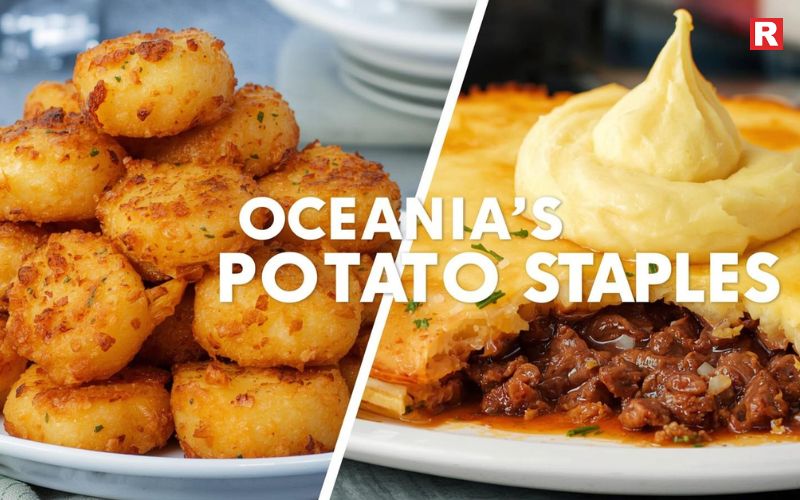
26. Potato Scallops (Australia): Thin slices of potato dipped in batter and deep-fried — a favorite at fish and chip shops. Light, crispy, and nostalgic.
27. Mashed Potato Pie (New Zealand): A classic New Zealand meat pie topped with creamy mashed potatoes. Comforting and filling for a cold day.
Global Fusion & Modern Potato Dishes
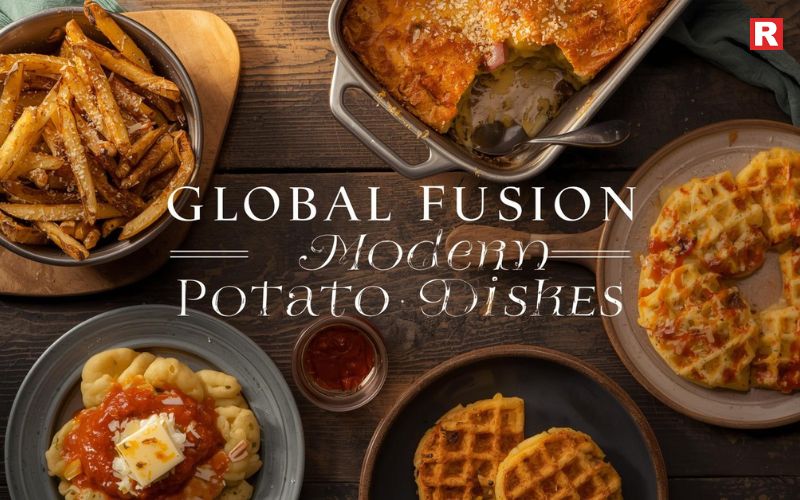
28. Truffle Fries (Global): A gourmet version of fries tossed in truffle oil and parmesan. Elegant and aromatic, served in many fine-dining restaurants.
29. Cheesy Potato Bake: A baked casserole of thinly sliced potatoes layered with cheese and cream. Perfect for family dinners or celebrations.
30. Potato Gnocchi (Italy): Soft Italian dumplings made from potatoes and flour, served with butter or tomato sauce. Light and melt-in-your-mouth good.
31. Potato Waffles (Global): Crispy waffle-shaped potatoes, often enjoyed for breakfast. A creative and fun twist on traditional fries.
Check more: 7 Types of Whiskies Everyone Should Try Once
10 Fastest-Growing Alcohol Brands in India’s HoReCa Sector
Why Potatoes Are Loved Worldwide
Potatoes are loved for their versatility and ability to adapt to any cuisine. They can be spicy, creamy, crispy, or soft — and they always bring comfort. Whether in a fine restaurant or a roadside stall, potatoes feel familiar everywhere. They are also affordable, rich in nutrients, and can turn the simplest meal into something memorable.
Fun Potato Facts
- There are more than 4,000 types of potatoes in the world.
- India and China are the largest potato producers globally.
- Belgium has a museum dedicated to French fries.
- The Inca civilization in Peru was the first to grow potatoes.
- Potatoes contain more potassium than bananas.
Smashed It, Eat It!
From spicy Indian chaats to creamy French gratins, potatoes show how one simple ingredient can bring the world together. Every recipe carries a piece of culture, a touch of tradition, and a story of comfort. In every corner of the globe, people have found their own way to make potatoes special—fried, mashed, baked, or roasted. They fit into every meal and every mood. A plate of crispy fries or a bowl of warm potato soup can feel like home, no matter where one is. That is the beauty of this humble vegetable—it connects hearts through flavor. They remind us that good food doesn’t need to be complicated. Sometimes, the simplest ingredients, cooked with care, create the most unforgettable and comforting flavors that stay with us forever.

Morning hustle is real, but that shouldn’t stop you from having a power-packed breakfast. Have you ever wondered who has been your companion when you were running late to work or sneaking in a midnight snack? It was bread. Easy to grab, loaded with fiber, and made to fuel your mornings, bread has been a reliable partner for generations. On this World Bread Day, it’s time to appreciate the humble loaf that has made our lives easier and our meals wholesome. From breakfast to late-night cravings, bread continues to bring convenience, nourishment, and joy to everyday meals.
Read more: 21 Different Types of Indian Breads and Their Benefits
A Guide to Different Breads and Their Nutritional Value
Quick and Versatile
In today’s fast-paced world, a quick and satisfying meal is not just a convenience; it’s a necessity. Bread is the ultimate savior for busy mornings and hectic schedules. Whether it’s a classic avocado toast for breakfast, a grilled vegetable sandwich for lunch, or a peanut butter and banana sandwich for an afternoon snack, bread allows you to prepare a delicious meal in minutes.
In India, where mornings are often a rush for working moms, students, and professionals alike, bread fits perfectly into the routine. A slice of Harvest Gold multigrain bread or Modern Atta bread can be the base for breakfast, lunch, or even a quick dinner. From preparing school lunchboxes to late-night office snacks, bread ensures a fulfilling meal without consuming too much time. Bread’s versatility extends beyond the type of meals. It works with both sweet and savory preparations, allowing creativity and personalization. It is a food that adapts to your schedule and mood, making it an essential part of modern life.
Pairs With Everything

Bread is a social food. It doesn’t play favorites. It pairs effortlessly with eggs, vegetables, curries, spreads, and even chai. You can enjoy a simple buttered slice, or get creative with a gourmet spread of hummus, olives, and cucumbers. Bread can also complement traditional Indian meals. Soft pav pairs beautifully with spicy bhaji, while a simple sandwich can be served alongside a hot bowl of soup for dinner.
The adaptability of bread makes it ideal for the whole family. Kids enjoy peanut butter and jam sandwiches, while adults can experiment with sandwiches loaded with vegetables, cheese, or chicken. It allows home cooks to create nutritious and quick meals without spending hours in the kitchen. Bread’s ability to suit multiple tastes and moods makes it one of the most convenient food choices today.
Nutritious and Filling
Bread is not just convenient; it is nutritious. It is packed with carbohydrates that provide energy to keep you active throughout the day. Whole grain bread, like Modern Atta bread, is a source of fiber that keeps you full for longer. For example, a chicken and vegetable sandwich made with whole wheat bread is not only wholesome but also keeps you energized without feeling heavy.
In Indian households, bread often acts as a base for healthy meals. Whole wheat or multigrain slices can be combined with eggs, vegetables, or lean protein to create balanced meals for breakfast, lunch, or dinner. Bread supports a healthy lifestyle while saving time in meal preparation, making it a practical choice for busy individuals.
Know more: 10 Awadhi Cuisine Classics You Must Try at Least Once
Kid-Friendly and Family-Approved
Bread is a favorite among children, making it a lifesaver for parents. From cheese and tomato sandwiches for school lunches to vegetable-stuffed cutlets for after-school snacks, bread is versatile and easy to prepare. Families can enjoy quick meals that are both tasty and nutritious.
For homemakers, bread simplifies meal planning. It provides the flexibility to prepare different dishes using the same ingredient. It also helps reduce the stress of deciding what to cook every day. Kids enjoy the taste, and adults appreciate the convenience, making bread an indispensable ingredient in Indian kitchens.
Helps Maintain Routine Without Compromise

For working women and busy professionals, skipping breakfast is common. Bread helps maintain a healthy routine even when life gets hectic. A quick egg salad sandwich in the morning or a vegetable-loaded grilled sandwich for lunch ensures that you do not compromise on nutrition.
Bread supports a balanced lifestyle. It is quick to prepare, nutritious, and satisfying. It allows you to eat well, even when juggling multiple responsibilities. This dependability makes bread not just a food item but a lifestyle companion for millions.
Bread Across India
India has a rich bread culture. From soft pav in Mumbai to stuffed kulchas in Punjab and traditional roti in North India, bread is integral to Indian meals. Cafes and restaurants are also embracing global bread trends. You can now find sourdough, focaccia, croissants, and artisanal bread alongside Indian favorites. This blend of tradition and modernity makes bread an exciting ingredient for all types of meals.
Bakers are also exploring health-conscious options. Whole grain, multigrain, and gluten-free breads are becoming more popular in urban areas. Local bakeries often use traditional fermentation methods, bringing authentic taste and texture to modern consumers.
Also check: World’s Tastiest Wraps: A Global Tour of Flavours
Quick Veg Biryani Recipe: Flavorful, Fast, and Fuss-Free
Fun Facts About Bread
- Bread has been a part of human diets for over 14,000 years.
- The word “companion” comes from Latin com (together) + panis (bread).
- India’s bread market is valued at over ₹50 billion and is growing steadily.
- Bread can adapt to multiple cuisines and meals, making it a truly global food.
From Breakfast to Midnight Snack
Bread truly shines across all meals. In the morning, it fuels your body and mind. At lunch, it becomes a wholesome sandwich or wrap. At dinner, it can be served with soups, curries, or as garlic bread. Even late at night, it makes for a quick and satisfying snack.
Its versatility ensures that you never have to compromise on taste, nutrition, or convenience. Bread brings people together. It is shared across tables, passed around in lunchboxes, or enjoyed in solitude as a comforting snack. On World Bread Day, it is worth celebrating this humble yet essential food that has stood the test of time.
Conclusion
Bread is more than just food. It is a companion that has supported busy mornings, family meals, and midnight cravings for generations. With its versatility, convenience, and nutritional value, bread makes life easier, healthier, and more enjoyable.
This World Bread Day, take a moment to appreciate the humble loaf that has nourished generations. From traditional Indian pav to artisanal sourdough, from a quick breakfast to a late-night snack, bread continues to deserve the spotlight. It’s time to celebrate the food that never goes out of style, keeps us full, and brings joy to our everyday meals.

Bengali cuisine is more than food. It is a blend of culture, emotion, and deep family traditions. Every dish tells a story passed down through generations. From simple home-cooked meals to grand festive feasts, Bengal’s food reflects its people’s warmth and creativity. Known for its delicate balance of flavors, Bengali cooking uses spices not for heat but for harmony. Mustard oil, poppy seeds, and fresh herbs bring out the region’s natural taste. Rice and fish are at the heart of most meals, showing Bengal’s bond with its rivers and fertile lands.
The cuisine also celebrates sweetness like no other. Desserts such as Mishti Doi, Rasgulla, and Sandesh have become famous across India and beyond. Bengali food connects people. It turns a simple lunch into a moment of comfort and togetherness. From a bowl of Macher Jhol on a rainy afternoon to Kosha Mangsho during Sunday gatherings, each meal has meaning. Bengali cuisine is a soulful journey—one that blends history, love, and the timeless joy of sharing food.
Read more: 8 Famous Vegetarian Dishes of Uttar Pradesh and Their Timeless Legacy
Seafood: 5 Crab Dishes You Must Try
A Taste of Bengal’s Culinary Heritage
Bengal, a region blessed by rivers like the Ganga and the Padma, has a long-standing relationship with food. The land’s fertile plains and abundant water bodies make rice and fish the cornerstones of Bengali meals. The cuisine beautifully blends local produce with timeless techniques.
In most Bengali homes, meals are more than daily nourishment—they are rituals. Sundays often mean Kosha Mangsho (spicy mutton curry), festivals are incomplete without Payesh (rice pudding), and family gatherings end with Mishti Doi (sweet yogurt). Each dish reflects the warmth and creativity of Bengal’s people.
The influence of festivals like Durga Puja can also be seen in the food culture. The bhog, offered to Goddess Durga, is a divine mix of vegetarian dishes made without onion or garlic, yet bursting with flavor. Food here is not just eaten—it’s celebrated.
10 Must-Try Bengali Dishes
Here’s a list of the most iconic Bengali dishes you must try at least once in your life. Each has a distinct taste and story behind it.
1. Shorshe Ilish (Hilsa Fish in Mustard Gravy)
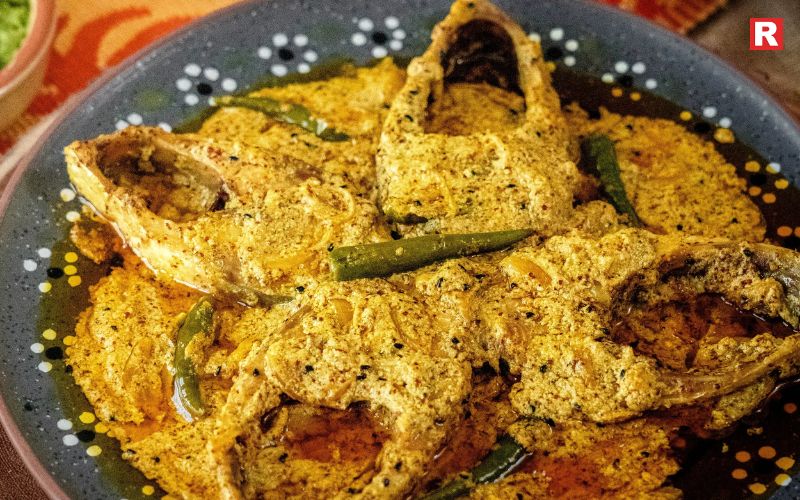
Considered the crown jewel of Bengali cuisine, Ilish maach or Hilsa fish is a delicacy enjoyed across Bengal. Cooked in a mustard-based gravy, Shorshe Ilish combines the sharpness of mustard with the natural richness of the fish. Usually served with steamed rice, this dish defines Bengal’s love for fish.
2. Kosha Mangsho (Slow-Cooked Mutton Curry)

No Bengali Sunday is complete without Kosha Mangsho. The word “kosha” means slow-cooked, which is the secret behind its deep flavor. Marinated mutton is cooked for hours with onions, garlic, ginger, and aromatic spices until it turns tender and rich. It pairs perfectly with Luchi or Basanti Pulao.
3. Chingri Malai Curry (Prawns in Coconut Milk)
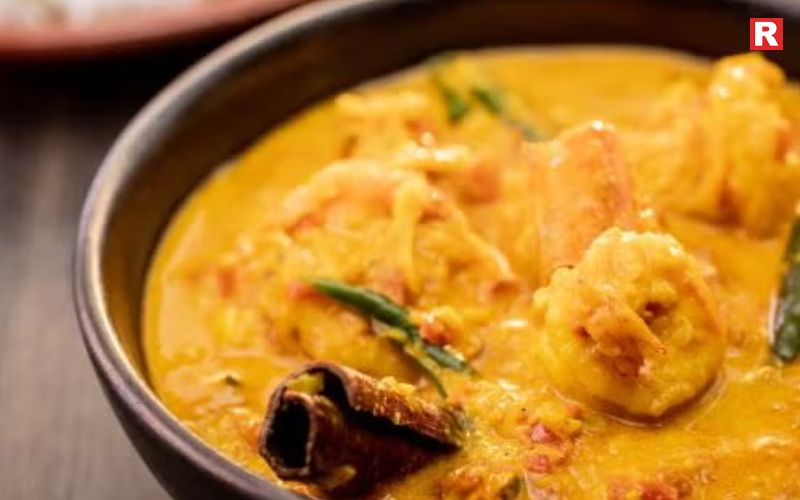
A royal favorite, this creamy prawn curry blends the sweetness of coconut milk with mild spices. It’s a dish that captures the coastal essence of Bengal. The balance between richness and subtlety makes Chingri Malai Curry a crowd-pleaser at every festive table.
Know more: 5 Cities That Serve the Best Non-Vegetarian Street Food
4. Aloo Posto (Potatoes in Poppy Seed Paste)

Simple yet flavorful, Aloo Posto is a household staple. Made with poppy seed paste and green chilies, this vegetarian delight is often eaten with plain white rice and a squeeze of lemon. It represents the minimalistic beauty of Bengali food—humble ingredients, extraordinary flavor.
5. Luchi and Cholar Dal
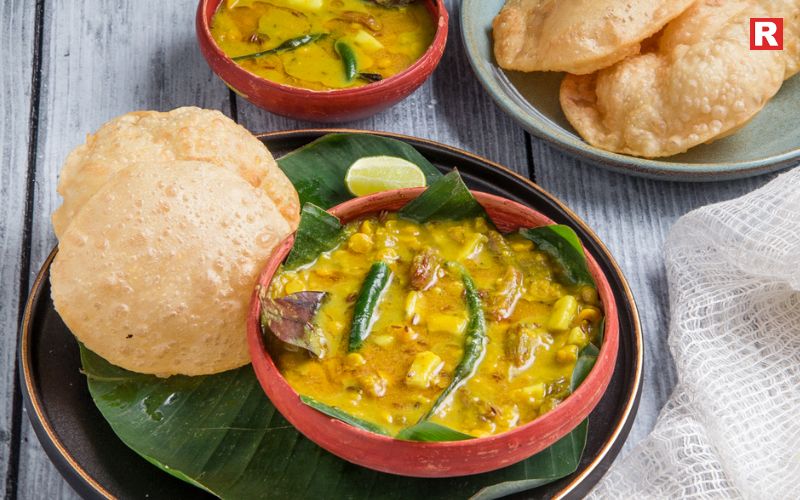
This classic combination of fluffy deep-fried bread (Luchi) and mildly sweet Bengal gram dal (Cholar Dal) is comfort food at its best. The dal is cooked with coconut bits and a hint of cardamom, giving it a festive touch. It’s a favorite during special breakfasts or Durga Puja mornings.
6. Beguni (Fried Eggplant Slices)
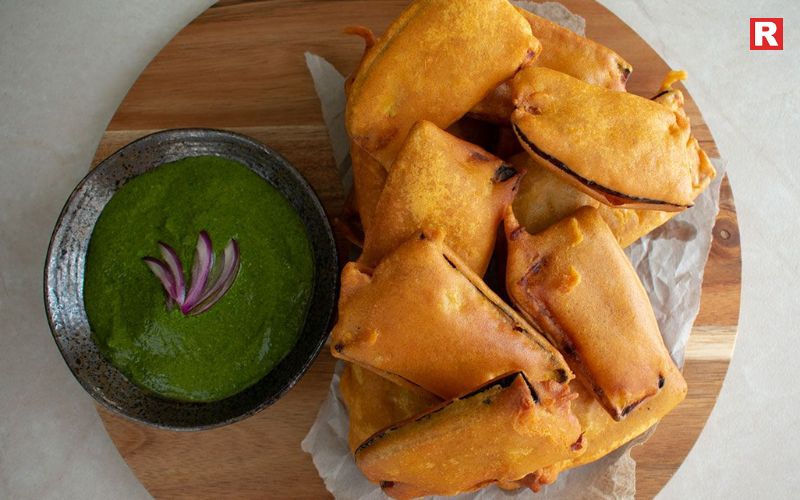
A beloved evening snack, Beguni is thinly sliced eggplant dipped in gram flour batter and fried until golden. Crispy on the outside and soft inside, it’s best enjoyed with puffed rice (Muri) and a cup of tea, especially on rainy days.
7. Bhetki Paturi (Fish Wrapped in Banana Leaf)

A true example of Bengal’s culinary artistry, Bhetki Paturi involves marinating fish with mustard, coconut, and green chilies, then wrapping it in banana leaves and steaming it. The leaf imparts a unique aroma, making this dish both healthy and flavorful.
Also check: Pani Puri Has Different Names in Different Indian States—Know Them All
8. Macher Jhol (Everyday Fish Curry)

For Bengalis, Macher Jhol is comfort food. Made with fresh fish, potatoes, and a light mix of turmeric, cumin, and coriander, it’s a part of daily life. Every household has its own version, reflecting the cook’s personal touch.
9. Mishti Doi (Sweet Yogurt)
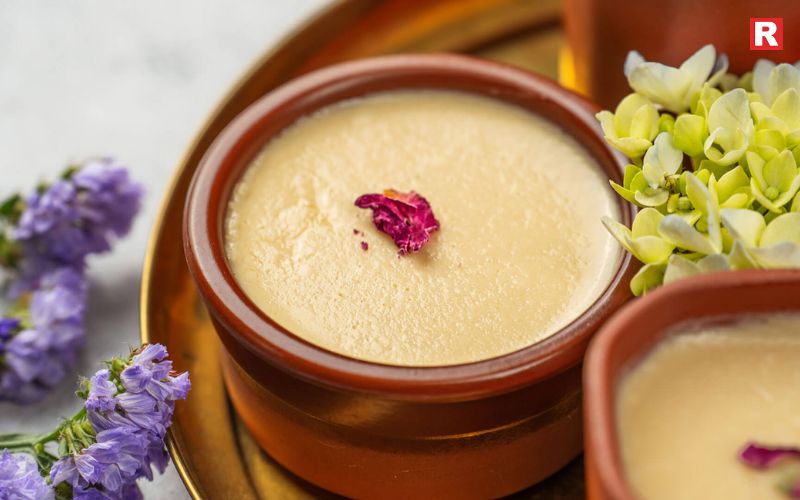
No Bengali meal feels complete without Mishti Doi. Made by fermenting thick milk with caramelized sugar, it has a rich, creamy texture and mild sweetness. Served chilled, it’s the perfect ending to a hearty meal.
10. Rasgulla and Sandesh
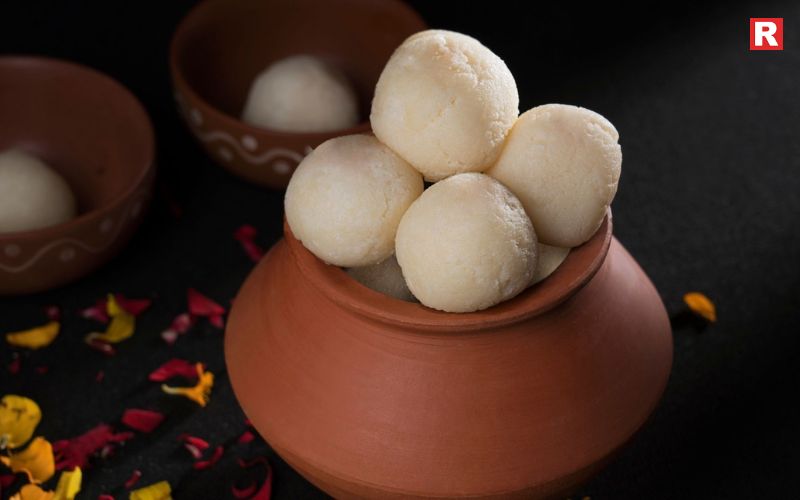
These two sweets define Bengal’s love for desserts. Rasgulla is soft, spongy, and soaked in syrup, while Sandesh is drier, made from fresh chhena and sugar. Both are timeless classics that have made Bengal famous across the world.
The Bengali Thali – A Complete Experience
A Bengali thali is a culinary journey in itself. It represents the perfect blend of taste, texture, and tradition. Typically, it starts with rice and lentils, followed by vegetables, fish or meat curries, chutneys, and ends with sweets. Each thali tells a story of Bengal’s agricultural abundance and cultural pride. It’s not just a meal—it’s a carefully curated experience that connects the diner with the land’s heritage. Food festivals, pop-ups, and home chefs are also bringing Bengal’s traditional dishes to younger audiences. From fine-dining experiences to comfort bowls delivered home, Bengali food is evolving beautifully without losing its authenticity.
Check more: World’s Tastiest Wraps: A Global Tour of Flavours
5 Tasty Dishes from Bihar You Must Try
Best Street Food Spots in Delhi That Define Its Flavours
Taste of Bengal!
Bengali cuisine tells a story—of the people who made it, the festivals that inspired it, and the families who shared it. From the soft, sweet Rasgulla to the rich and spicy Kosha Mangsho, and the comforting Macher Jhol, each meal carries the warmth and soul of Bengal. The flavors are simple yet memorable, made with love and care. Bengali food brings people together and creates lasting memories. It is enjoyed at home, in festivals, and at gatherings. For anyone seeking a taste of tradition and depth, Bengali cuisine is a journey of flavors that leaves a lasting impression. It is more than a meal—it is an experience.

Bihar is one of India’s oldest cultural regions, known for its warmth, simplicity, and deep-rooted heritage. Its cuisine beautifully mirrors the state’s soul — humble, flavourful, and full of heart. Each dish from Bihar carries a story of tradition, family, and the land it comes from. The food here is shaped by the rhythms of rural life. Locally grown grains, seasonal vegetables, and home-ground spices form the base of most recipes. The use of mustard oil, sattu, and jaggery gives Bihari dishes their distinct character.
Meals in Bihar are often a shared experience, reflecting a strong sense of community. From festive feasts to daily meals, food is a way of bringing people together. Even the simplest dishes, like Litti Chokha or Sattu Paratha, are prepared with care and tradition. For those who love exploring Indian regional cuisines, Bihari food offers a unique blend of taste and culture. It is not just about eating; it is about celebrating heritage, togetherness, and the simple joy of wholesome cooking. These five authentic dishes from Bihar truly capture the heart of India’s eastern kitchen.
Read more: 8 Famous Vegetarian Dishes of Uttar Pradesh and Their Timeless Legacy
5 Cities That Serve the Best Non-Vegetarian Street Food
Find the Taste of Bihar
Here’s a look at five tasty dishes from Bihar that truly capture the heart of India’s eastern flavours.
1. Litti Chokha – The Soul of Bihar
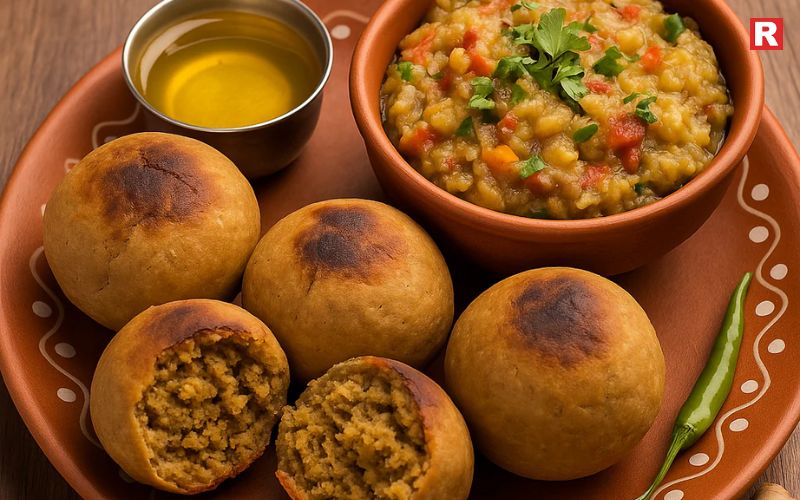
No dish represents Bihar better than Litti Chokha. It is the symbol of Bihari cuisine—simple, earthy, and delicious. Litti is made from wheat dough stuffed with sattu (roasted gram flour) mixed with mustard oil, garlic, lemon juice, and spices. Traditionally, it is roasted over cow dung cakes or charcoal, giving it a smoky, rustic flavour that no modern oven can replicate.
The chokha served with it is a mixture of mashed roasted eggplant, tomatoes, and boiled potatoes. The ingredients are combined with mustard oil, green chilies, and coriander leaves. This pairing is a perfect balance of smoky, tangy, and spicy flavours. It was once a humble meal of farmers and travelers because it is nutritious and long-lasting. Today, it is served in street stalls, restaurants, and even international food festivals. In many ways, Litti Chokha connects Bihar’s history, tradition, and pride in one plate.
2. Thekua – The Sweet Snack of Festivities
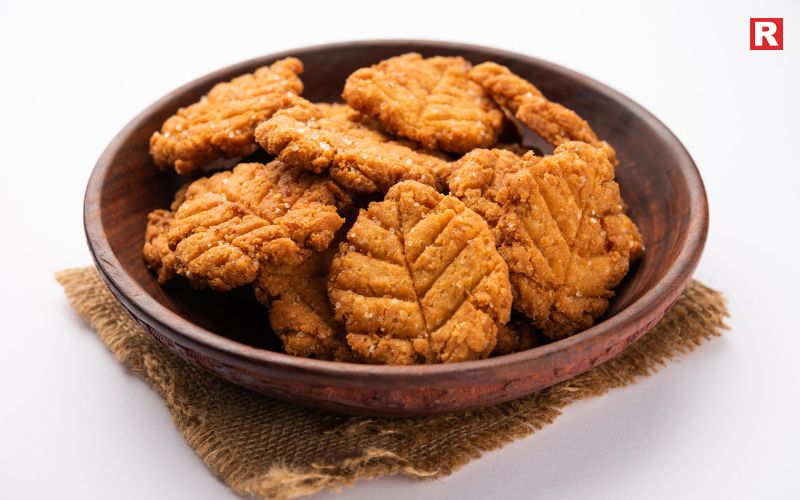
If you have ever been in Bihar during Chhath Puja, you will know that Thekua is more than just a snack—it’s a symbol of devotion. This sweet, crisp treat is made with wheat flour, jaggery (or sugar), ghee, and cardamom. The dough is shaped into small discs and deep-fried until golden brown.
Thekua has a rich, caramelized taste and a crunchy texture that makes it addictive. What makes it truly unique is its shelf life; it can stay fresh for days without preservatives, which is why it’s also a popular travel snack. During Chhath Puja, devotees offer Thekua to the Sun God as a sacred prasad. Every household has its own recipe, passed down through generations. Its deep cultural connection, combined with its comforting sweetness, makes it one of Bihar’s most beloved traditional sweets.
Know more: Best Street Food Spots in Delhi That Define Its Flavours
3. Sattu Paratha – The Protein Powerhouse

- Sattu Paratha is the pride of Bihar’s breakfast table. It is both healthy and satisfying, made from sattu — roasted gram flour that is high in protein and fiber. The stuffing includes sattu mixed with garlic, onions, green chilies, ajwain, mustard oil, and salt. The mixture is wrapped in a thin wheat dough and cooked on a tawa with ghee or oil.
The result is a soft, flavourful paratha with a spicy and nutty filling. It’s usually served with curd, pickle, or chutney. Many people in Bihar prefer it with a drizzle of ghee and a glass of buttermilk for a wholesome meal.
What makes Sattu Paratha so popular is its nutrition and simplicity. It keeps you full for hours, making it perfect for farmers, laborers, and anyone looking for a high-energy meal. In recent years, sattu has gained national popularity as a “superfood,” and this paratha remains one of the best ways to enjoy it.
4. Khaja – The Royal Dessert
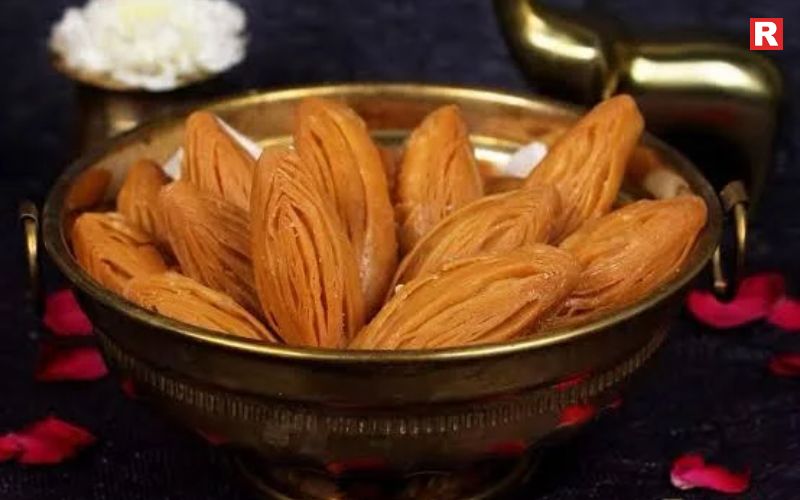
Bihar’s love for sweets is evident in Khaja, a flaky, layered dessert that traces its origins to ancient times. It is said to have been served in the court of Magadha, one of India’s oldest kingdoms. The most famous version comes from Silao, a town near Nalanda, which has received a Geographical Indication (GI) tag for its Silao Khaja.
Made from refined flour, ghee, and sugar syrup, Khaja has a crisp, layered texture similar to baklava. The dough is rolled out into thin layers, folded repeatedly, and deep-fried until golden. It is then dipped in sugar syrup, giving it a glossy finish. This royal dessert is a common sight at weddings, festivals, and fairs across Bihar. Its light, melt-in-the-mouth sweetness makes it a perfect treat after a spicy meal. Khaja is proof that Bihar’s dessert traditions are as rich as its history.
Also check: 8 Famous Street Foods from Hyderabad You Can’t Miss
5. Dal Pitha – Bihar’s Dumpling Delight
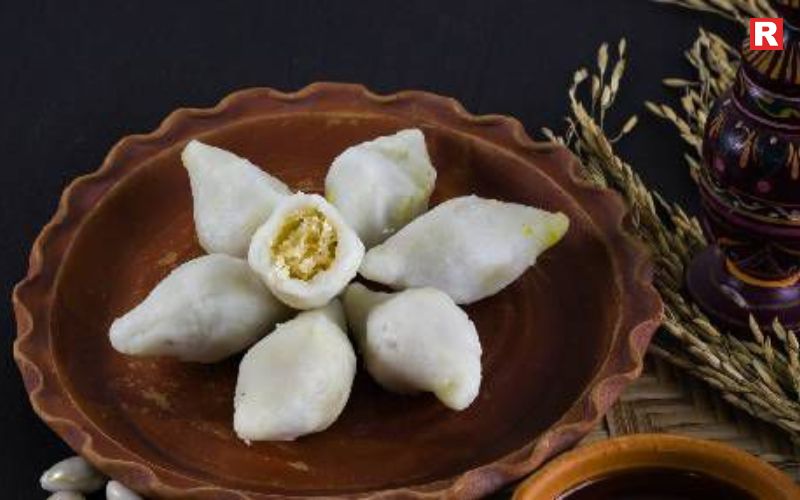
Dal Pitha is often described as the “Bihari version of momos,” but it has a distinct identity of its own. These are steamed rice flour dumplings filled with spicy lentil paste, usually made of chana dal (split Bengal gram). The filling is seasoned with garlic, ginger, cumin, and mustard oil, giving it a strong, aromatic flavour. Once filled, the pithas are shaped into small half-moons and steamed. Some versions are lightly pan-fried for extra texture. They are usually served with chutney or ghee.
Dal Pitha is a common dish during festivals and fasting periods because it is light, filling, and nutritious. It reflects Bihar’s love for simple ingredients and healthy cooking. This dish also shows the state’s creativity — turning basic rice and lentils into something elegant and comforting.
What Makes Bihari Cuisine Unique
Bihari cuisine stands out for its balance of taste, nutrition, and authenticity. The use of local ingredients like sattu, mustard oil, jaggery, and rice gives every dish a distinct regional flavour. The cooking style focuses on traditional methods such as roasting, steaming, and slow-cooking, which enhance the natural taste of ingredients.
Unlike many cuisines that rely heavily on spices, Bihari dishes use spices thoughtfully. The result is food that feels rustic yet refined. Another unique feature is the balance between vegetarian and non-vegetarian options — from Litti Chokha to Champaran Meat, Bihar’s food has something for everyone. Most importantly, Bihari food is rooted in sustainability. The dishes use seasonal ingredients, are easy to store, and require minimal waste — a culinary philosophy that fits perfectly with today’s global trend toward mindful eating.
Check more: 10 Awadhi Cuisine Classics You Must Try at Least Once
Top 7 Regional Indian Thali Platters That Showcase Culinary Diversity
7 Chinese Dishes That Can Be a Healthy Option for Your Diet
Bihar’s Food Culture and Festive Connection
In Bihar, food is deeply linked with festivals and traditions. Every celebration has its signature dishes — Thekua for Chhath Puja, Kheer during Raksha Bandhan, and Dal Pitha during Makar Sankranti. These foods carry stories of devotion, family, and seasonal change.
Cooking in Bihar is also a community affair. Families gather to prepare festive meals, sharing laughter and memories. The recipes are passed from mothers to daughters, keeping the state’s culinary heritage alive. Even today, many Bihari families living outside the state recreate these dishes during festivals, keeping their roots connected to home through food.
Conclusion
Bihar’s food is an experience of culture, history, and heart. From the smoky Litti Chokha to the flaky Khaja, every bite tells a story of tradition and love. What makes Bihari cuisine truly special is its honesty—simple ingredients transformed into unforgettable flavours.
If you ever get the chance, try these five dishes in their authentic form. Whether it’s a roadside stall in Patna or a homemade meal during Chhath Puja, Bihar’s cuisine promises warmth, comfort, and a deep sense of belonging. So, the next time you think of regional Indian food, don’t miss Bihar—a state where every meal celebrates simplicity, culture, and taste.

If you are a thrill-seeker and keep eyeing that sleek, black, intimidating package of spicy, hot chips for your next challenge, then take a step back for now. We know how much the chip brand that promises to be the "World’s Hottest Chip", Jolochip, is trending. Maybe you saw a friend’s hysterical reaction on TikTok, or maybe you just genuinely love heat. Whatever your reason, if you're seriously thinking about taking the JOLOChip Challenge, stop scrolling right now. This isn't your grandma’s hot sauce; this is a genuine, edible act of war against your own digestive system.
Before you go all viral video hero, you need to ditch the hype and face the facts. This single chip is less of a snack and more of a chemical weapon disguised as a corn product. We’re going to cover the 10 essential, life-saving (okay, maybe just stomach-saving) things you need locked in your brain before that chili-coated corn touches your tongue.
Read more: Fast Food: 7 Most Fiery Street Foods in India
1. First and Foremost, They're Not Made from Potatoes

You are not eating a potato chip. You are eating a very small piece of corn that has been absolutely slathered in the concentrated oil of the three most evil peppers on the planet. Forget the usual jalapeño or tabasco heat; we are talking about the "Big Three" of terror:
- The Carolina Reaper: The ruling heavyweight champion of heat. It brings a fruity, sweet flavor right before it decides your mouth must be burned to ash.
- Trinidad Scorpion Pepper: This one has a nasty, creeping heat. It hangs back for a second, then stings with the intensity its name promises.
- The Ghost Pepper (Bhut Jolokia): The original viral superstar. The hottest pepper in India. It guarantees the burn lingers. It makes it so that the heat just won’t quit.
The takeaway? These peppers are loaded with capsaicin, which is an oil, not a water-soluble flavor. That’s why your body treats it like a literal fire.
2. That Signature Crunch is LOUD
We need to have a serious talk about the sound these chips make. The crunch of a Jolo Chip isn't a gentle whisper; it's a full-blown declaration of war against silence. It’s a deep, resonant, incredibly satisfying CRUNCH that echoes. This is not a snack for a stealthy midnight kitchen raid or a quiet movie theater.
It’s an auditory experience as much as a culinary one. You have to commit to the crunch. But for many, that loud, shattering sound is a huge part of the addictive satisfaction.
Know more: 10 Best Snacks without Onion and Garlic you can order today
3. The Flavors Don't Play It Safe
Jolochip is not for the timid palate. They don't give "hints" of flavor. They do full-on, in-your-face, powder-coating-every-single-ridge flavor explosions. The seasoning clings to the chips with a determination that is rarely seen.
Take their famous Spicy Sriracha. After eating a chip, you won’t just experience a mild tingle. There will be a genuine, slow-building heat that starts tangy and garlicky and then settles into a warm, persistent glow at the back of your throat. It’s the real deal. Their Magic Masala is like the masala chip you know, but with a PHD in complexity—it’s sharper, more aromatic, and has more layers.
The flip side of this boldness is that you will almost certainly end up with a technicolor fingerprint dusting of seasoning on your fingers. It’s part of the ritual. You eat the chips, you lick your fingers. It’s a package deal.
4. Let's Talk About the Price
Alright, here’s the part that might give you pause. A bag of Jolochip costs significantly more than your standard bag of Lays or Uncle Chipps. There’s no sugarcoating it.
So, what are you actually paying for? You're paying for the "premium" positioning. The corn base, the intense and likely more expensive seasoning blends, the slick packaging and marketing, only then it all adds up. You’re not just buying a snack; you’re buying into an experience, a brand, and the feeling of eating something that is “artistic" in itself. Whether that’s worth the extra rupees is a very personal decision. For a daily snack? Maybe not. For a special treat? Absolutely.
What's new: 10 Iconic Dishes from Kashmir That Will Give You a Flavor of Paradise
5. The "Healthier" Question is Complicated
This is a big misunderstanding. Jolochip often get lumped into the "healthy snacking" category. It’s crucial to read between the lines.
On the one hand, they are gluten-free, which is a massive win for anyone with celiac disease or gluten sensitivity. The corn base is also often perceived as being lighter or better than the potato.
But here’s the reality check: Jolochip are still a deep-fried snack. Yes, they are fried. They contain a notable amount of fat, sodium, and calories. Calling them a "health food" would be a stretch. They are a potentially better alternative within the junk food universe, but they are not a green salad in a bag. Always, always flip the pack over and glance at the nutrition facts. Be an informed snacker!
6 . The Packaging is Part of the Experience
Let’s take a look at the packaging for a second. It is not like any ordinary potato chip brand. You don't just tear it open mindlessly. The packaging feels deliberate - the matte finish, the bold colors, the clean fonts. It's designed to look good on your shelf and in your social media photos. There's a certain pleasure in holding the packet, in the way it opens. It makes the act of snacking feel a bit more intentional and special compared to grabbing a standard, glossy chip bag. The brand has put serious thought into how this product would feel in your hands, not just how it would taste.
Check out: Beyond Toast: 10 Deliciously Easy Bread-Based Snacks
5 Restaurant Partnership Ideas to Expand Your Business
7. They Are Dangerously Addictive
Consider this your official warning: Jolochip are highly addictive. There’s a scientific reason for this. The powerful crunch provides a ton of sensory feedback that our brains interpret as satisfying. Combine that with the intense, umami-rich flavors that keep your taste buds on high alert, and you have a recipe for "just one more chip."
Before you know it, you’re staring at the bottom of an empty bag, wondering where all the chips went and why your fingers are stained red. The combination of texture and flavor creates a loop that’s very hard to break. You’ve been warned!
8. Finding Them is Half the Battle
You won’t typically find Jolochip at your neighborhood kirana store next to the Haldiram’s and Pepsi. They have a more curated distribution.
Your best bets are:
- The fancy supermarkets: Think Food Hall, Nature's Basket, Le Marche, or the gourmet aisle of a Supermarket.
- Online delivery apps: Bigbasket, Blinkit, and Swiggy Instamart have them.
- Direct from the source: You can buy boxes directly from their website or other online snack retailers.
The hunt makes finding them feel like a small victory, which somehow makes them taste even better.
9. The Crucial Safety Warning: Who Should NEVER Eat It
This is perhaps the single most important point. The manufacturer and medical professionals issue strict warnings against certain individuals attempting the JOLOChip challenge.
DO NOT consume the JOLOChip if you:
- Are Pregnant or Nursing: The stress and reaction can be severe.
- Have Pre-existing Medical Conditions: Especially heart, respiratory (asthma), gastrointestinal (GERD, IBS, ulcers), or other serious health issues. The intense heat of the chip can trigger chest pain, trouble breathing, and severe esophageal or intestinal discomfort.
- Are Allergic to Spices, Peppers, or Capsaicin: An allergic reaction combined with the extreme irritant can be life-threatening.
- Are Under 18 Years of Age: Due to the physical risk, many retailers and manufacturers prohibit the sale of the product to minors.
Always consult a doctor if you are unsure. This is not a product to take lightly.
10. They Represent a New Era of Indian Snacking
Finally, to truly "get" Jolochip, you have to see them as part of a bigger picture. They are a major item of India's growing number of domestic, direct-to-consumer brands. They represent a consumer who could even be you, who cares about branding, design, unique experiences, and a story behind their products.
They proved that a homegrown brand could stand toe-to-toe with the global fast-food giants by offering something different and building a community around it. When you buy a bag of Jolo, you're not just eating chips; you're participating in a small shift in the market. You're voting for flavor and creativity.
Learn more: 5 Tasty Dishes from Bihar You Must Try
The Final Verdict: Are They For You?
So, after all that, should you try Jolochip? This all depends on your conditions. Are you 18+, do you have any allergy or not, or can you even handle the heat? But go in with the right expectations. Don’t think of them as a potato chip replacement. Think of them as a completely different category of snack. Embrace the loud crunch, the bold flavors, and the quirky textures. Buy a single pack of Spicy Sriracha first and see how you feel.
They might just become your new favorite indulgence. Or, you might decide they’re not your thing. But one thing’s for sure: you won’t be bored. And in the world of snacking, that’s a rare and wonderful thing.

Biryani is one of India’s most loved dishes. Its aroma, flavors, and colorful presentation make it a favorite for festivals, family dinners, and special occasions. But let’s be honest — traditional biryani takes hours. Washing rice, marinating vegetables, preparing masalas, and layering everything for the perfect “dum” can be overwhelming, especially on busy days. That’s why we are sharing a quick veg biryani recipe that brings all the taste of traditional biryani in less than 40 minutes.
This recipe is perfect for beginners, working professionals, and anyone craving a wholesome, flavorful meal without spending hours in the kitchen. It uses simple, everyday ingredients and a few smart cooking tricks.
Read more: 8 Famous Vegetarian Dishes of Uttar Pradesh and Their Timeless Legacy
10 Awadhi Cuisine Classics You Must Try at Least Once
Ingredients You’ll Need
For this quick veg biryani, you only need a handful of vegetables and spices. Here’s what you’ll need:
Vegetables:
- 1 cup carrot, diced
- ½ cup beans, chopped
- ½ cup peas
- 1 capsicum, chopped
- 1 medium potato (optional), diced
Rice:
1.5 cups basmati rice (soaked for 15–20 minutes)
Spices & Aromatics:
- 1 large onion, thinly sliced
- 1 tomato, chopped
- 1-inch ginger, grated
- 3–4 garlic cloves, crushed
- 2–3 green chilies, slit
- ½ tsp turmeric powder
- 1 tsp red chili powder
- 1 tsp garam masala
- 1 tsp biryani masala
- ½ tsp cumin seeds
- 2–3 bay leaves
- 2–3 cloves, 1 small cinnamon stick
- Salt to taste
Other Ingredients:
- 3 tbsp cooking oil or ghee
- Fresh coriander leaves for garnish
- Fresh mint leaves for garnish
- Cashews or fried onions (optional, for topping)
Step-by-Step Cooking Instructions
Follow these steps to make your quick veg biryani. Each step is designed to save time while keeping flavors intact.
Step 1: Prepare the Rice
- Wash and soak basmati rice for 15–20 minutes.
- Boil water with a pinch of salt and a few drops of oil.
- Add soaked rice and cook until 70% done. Drain and set aside.
Step 2: Sauté the Aromatics
- Heat 2 tbsp oil or ghee in a deep pan.
- Add cumin seeds, bay leaves, cloves, and cinnamon. Fry for a few seconds.
- Add sliced onions, grated ginger, and crushed garlic. Sauté until golden brown.
- Add green chilies and chopped tomatoes. Cook for 2–3 minutes until soft.
Step 3: Cook the Vegetables
- Add carrots, beans, peas, capsicum, and potatoes (if using).
- Sprinkle turmeric, red chili powder, and salt.
- Stir well and cook for 5–6 minutes. The vegetables should be slightly tender but not mushy.
Step 4: Layer the Biryani
- In the same pan, reduce heat to low.
- Spread half of the partially cooked rice over the vegetables.
- Sprinkle garam masala and biryani masala evenly.
- Add the remaining rice on top.
- Drizzle a teaspoon of ghee for extra aroma.
Know more: 7 Healthy Chicken Dishes to Maintain Your Diet
Step 5: Dum Cooking (Optional but Recommended)
- Cover the pan with a tight lid.
- Let it cook on low heat for 8–10 minutes. This step allows the flavors to blend.
- If short on time, you can skip dum and still enjoy a flavorful biryani.
Step 6: Garnish and Serve
- Open the lid carefully.
- Gently fluff the rice with a fork.
- Garnish with fresh coriander, mint leaves, and optional fried onions or cashews.
- Serve hot with raita, pickle, or a simple salad.
Tips for Maximum Flavor in Minimal Time
Even if you are short on time, these tips will give your quick veg biryani a restaurant-like taste:
- Use Basmati Rice: Its long grains and aroma elevate the biryani instantly.
- Pre-made Spice Mixes: Keep a ready-to-use biryani masala in your pantry for fast cooking.
- Add a Touch of Ghee: A teaspoon of ghee at the end enhances aroma and richness.
- Cook Vegetables Separately: If you like very soft vegetables, pre-cook them before layering.
- Layer Carefully: Even layering helps distribute spices and flavors evenly.
- Optional Nuts: Cashews or fried onions add a subtle crunch and make it visually appealing.
Why You’ll Love This Quick Veg Biryani
- Fast and Easy: Ready in under 40 minutes. Perfect for weekday dinners.
- Flavorful: Every bite is aromatic and well-spiced.
- Customizable: Use any vegetables you have at home.
- Healthy: Packed with vegetables and minimal oil.
- Kid-Friendly: Mildly spiced but aromatic enough for adults.
This recipe is perfect if you want comfort food without the long wait. The aroma of spices and ghee, combined with soft rice and tender vegetables, makes it a wholesome meal for family and friends.
Also check: Seafood: 5 Crab Dishes You Must Try
11 State Bhawan Canteens in Delhi to Enjoy Authentic Flavors of Indian Cuisine
7 Famous Vegetarian Dishes of Madhya Pradesh You Must Try
Serving Suggestions
- Pair with cool cucumber raita or tomato-onion salad.
- Add a side of pickle for extra tanginess.
- Leftovers can be stored in the refrigerator for 1–2 days. Reheat gently on the stove or microwave.
Quick Variations to Try
- Paneer Veg Biryani: Add cubes of paneer while cooking vegetables.
- Mixed Nut Biryani: Add cashews, almonds, or raisins for a festive touch.
- Spicy Version: Add extra green chilies or red chili powder for a kick.
- One-Pot Biryani: Cook rice and vegetables in the same pan to save time and dishes.
Final Thoughts
This quick veg biryani recipe proves you don’t need hours to enjoy authentic Indian flavors. It’s a perfect combination of taste, aroma, and ease. Whether it’s a busy weekday or a weekend craving, this biryani will satisfy your hunger and impress your family.
Give it a try and see how a few smart tricks can create a delicious, wholesome meal in under 40 minutes. Once you master this quick recipe, you can experiment with spices, vegetables, and garnishes to make it truly your own. Biryani is more than food; it’s comfort, aroma, and a celebration on a plate. And now, with this recipe, it’s also fast, easy, and ready whenever you crave it.
Copyright © 2009 - 2025 Restaurant India.







